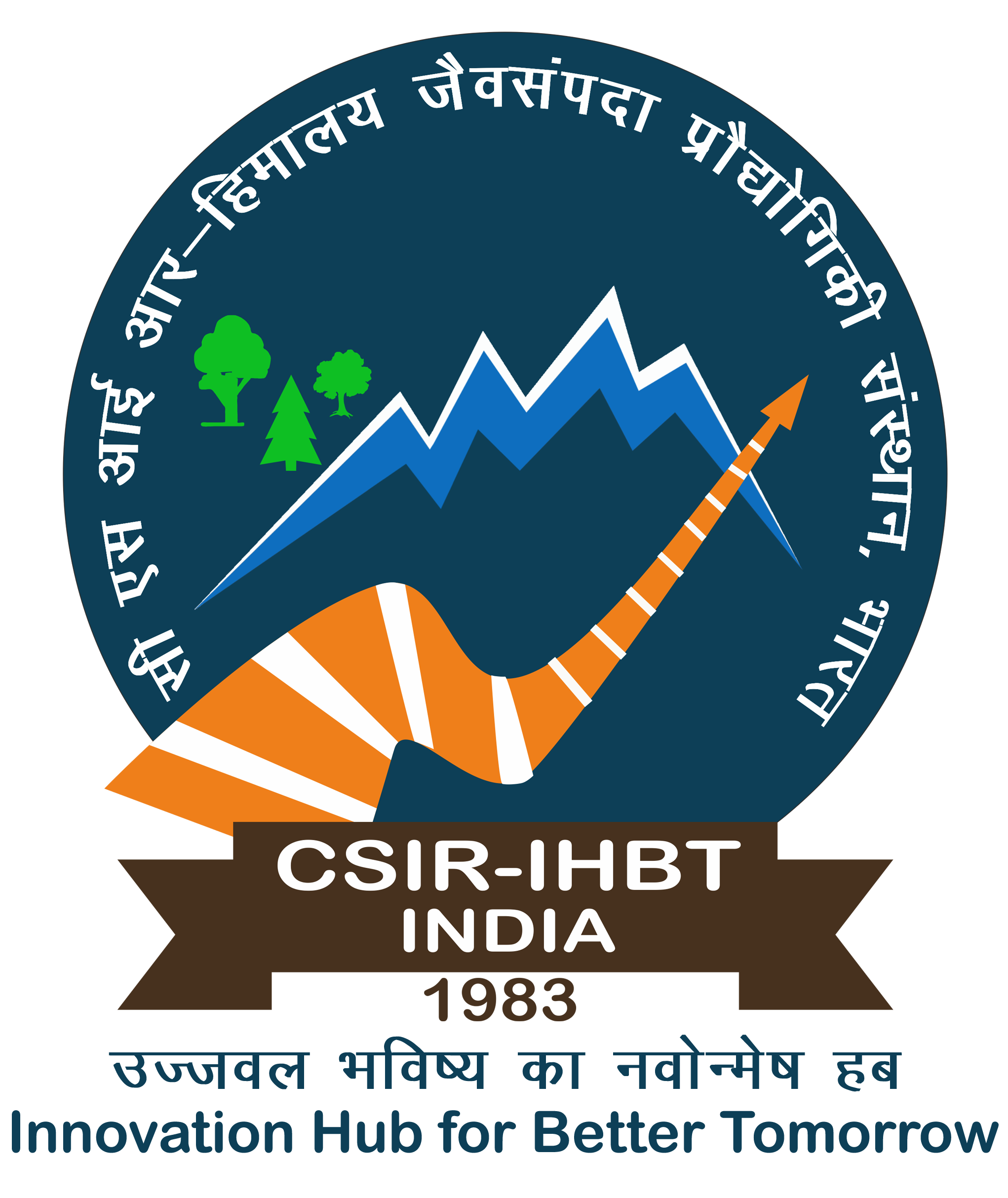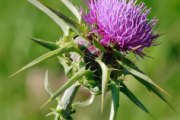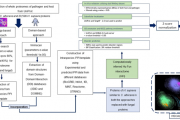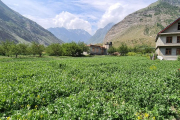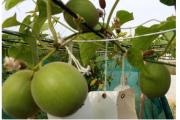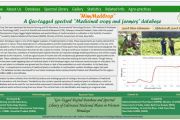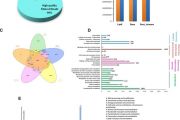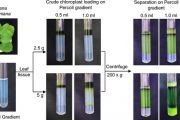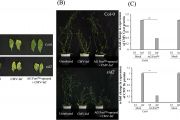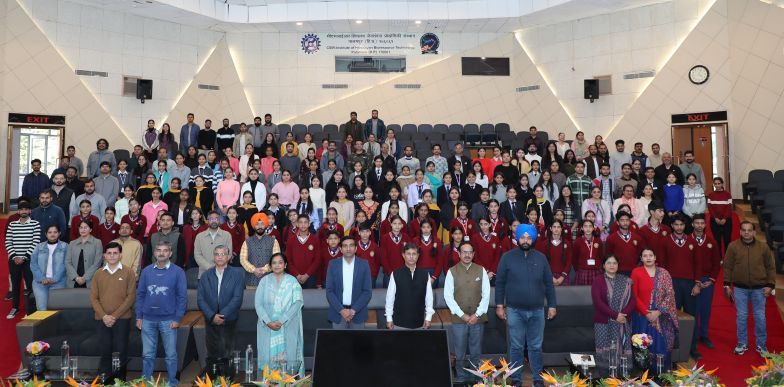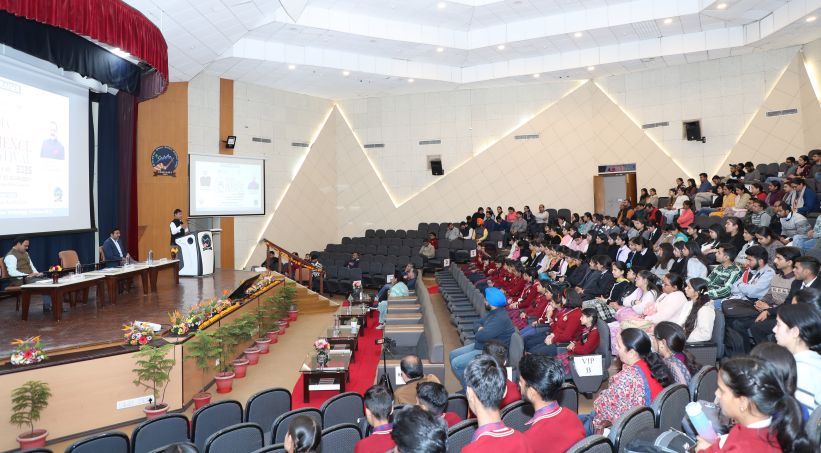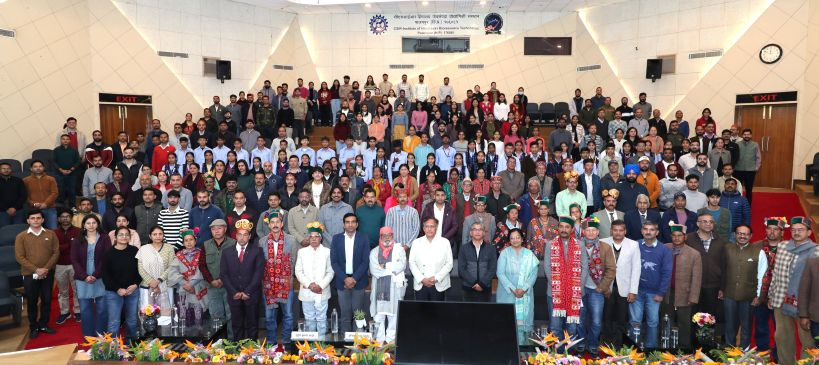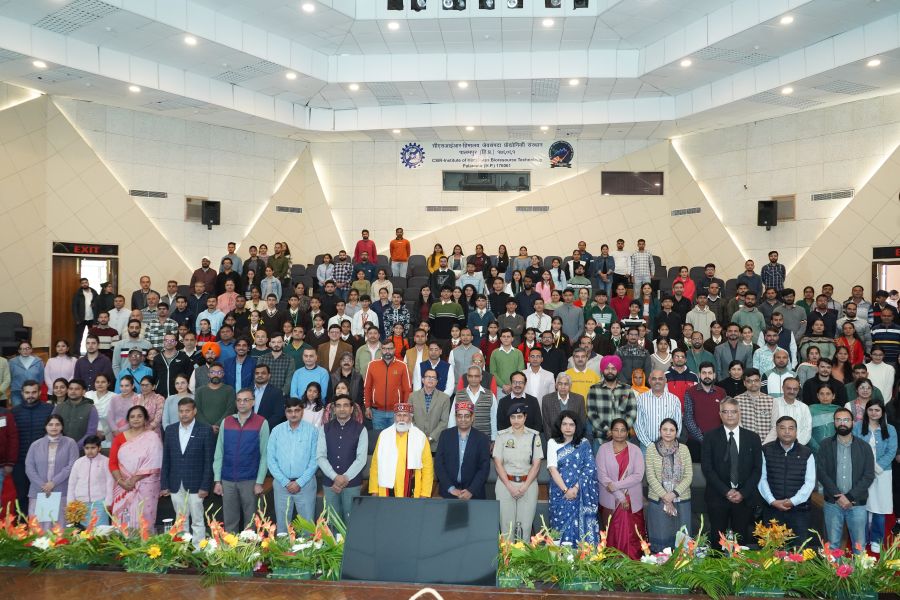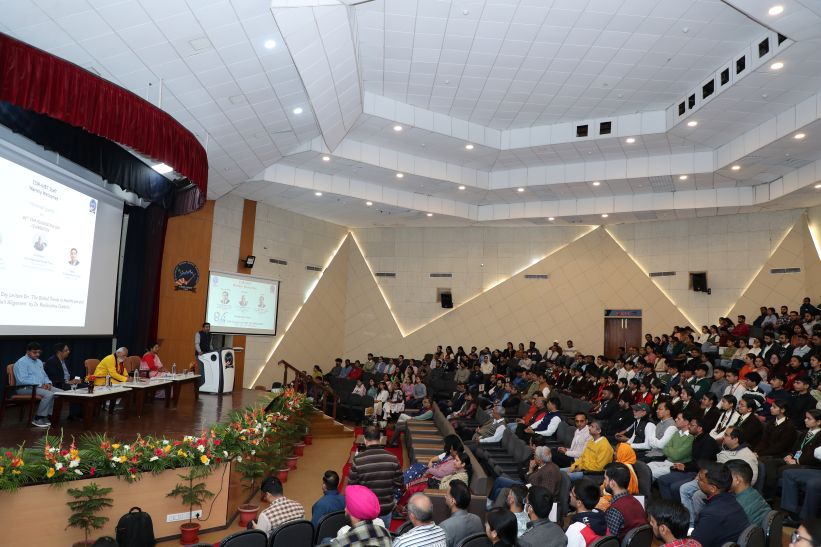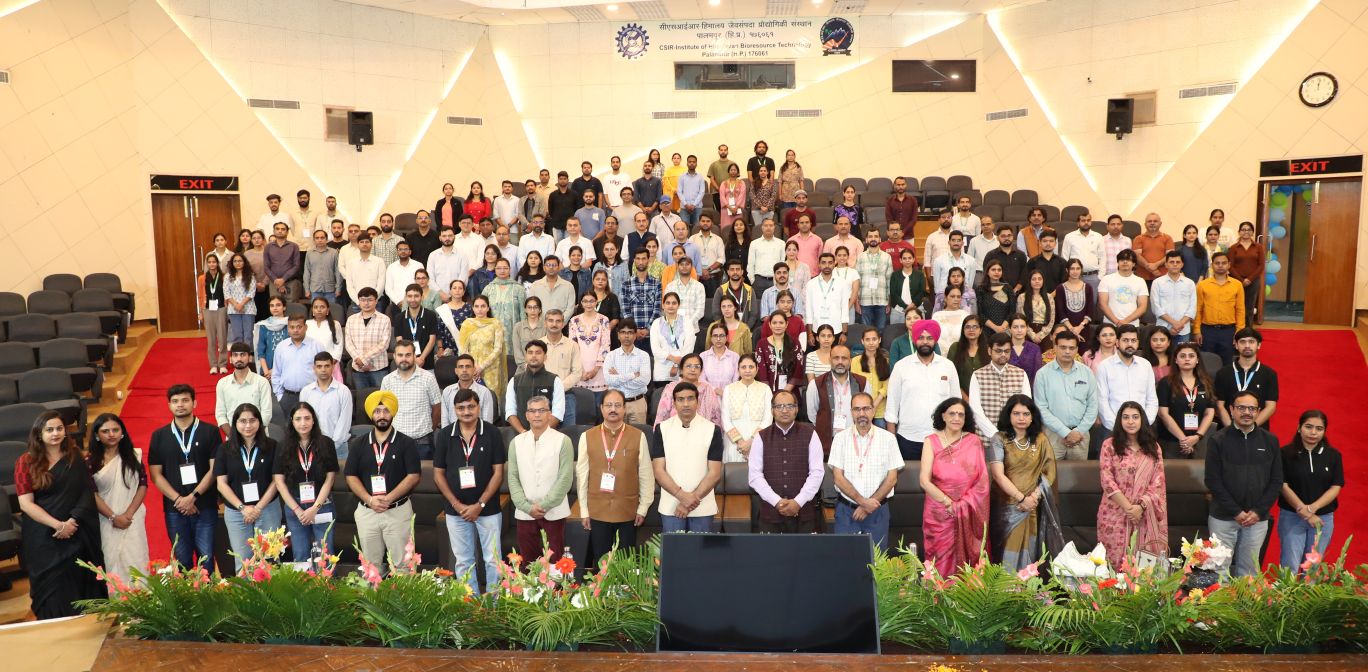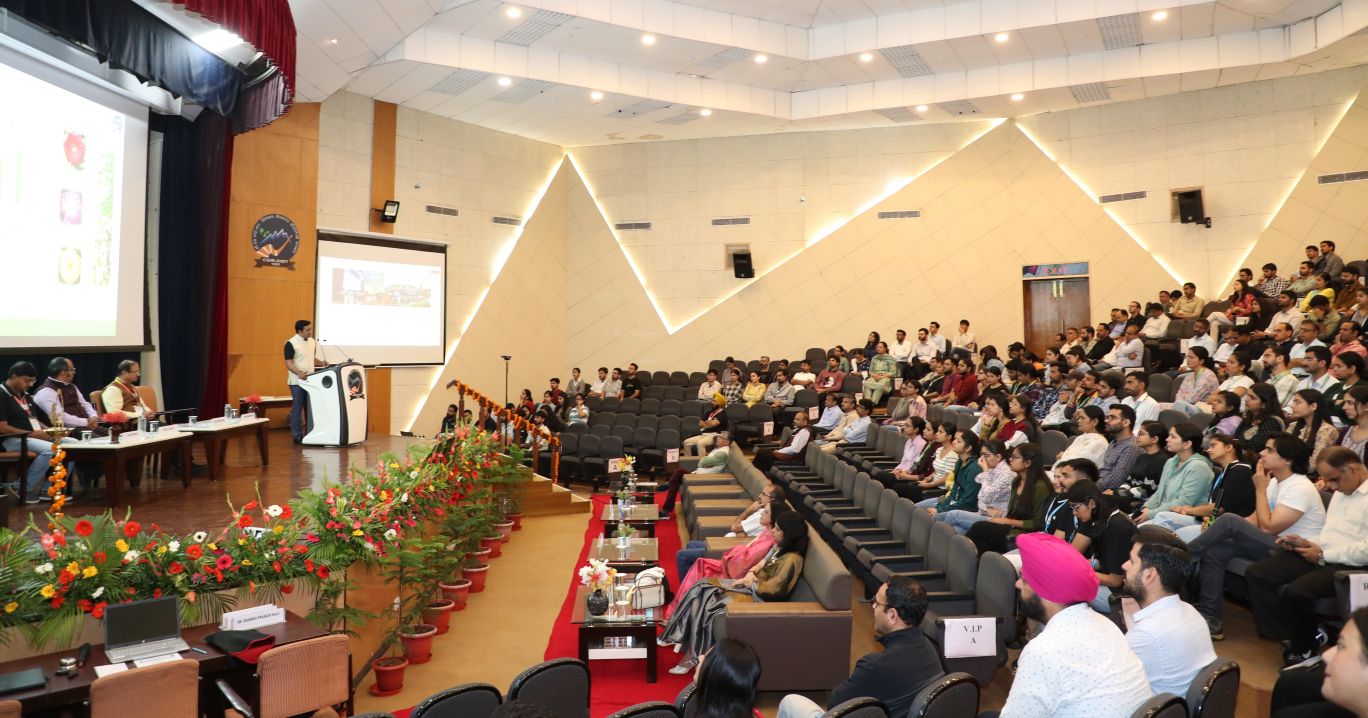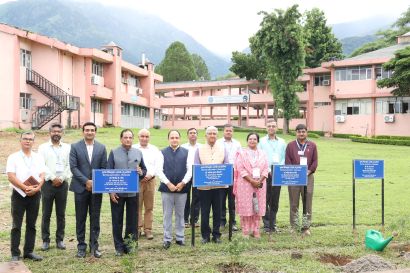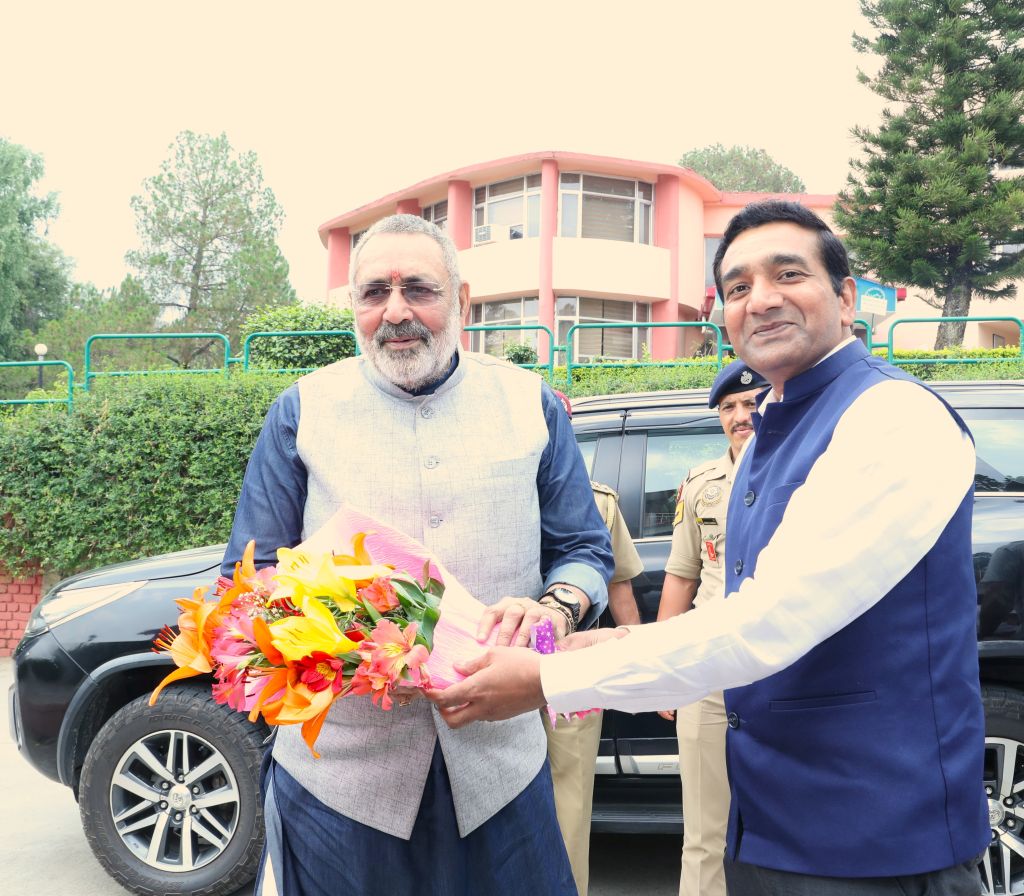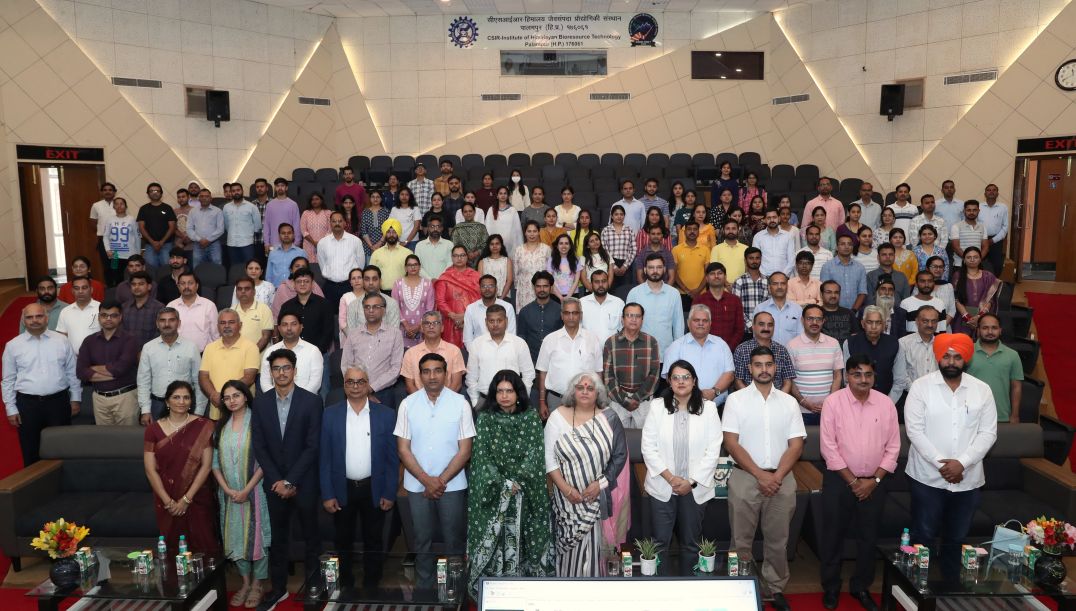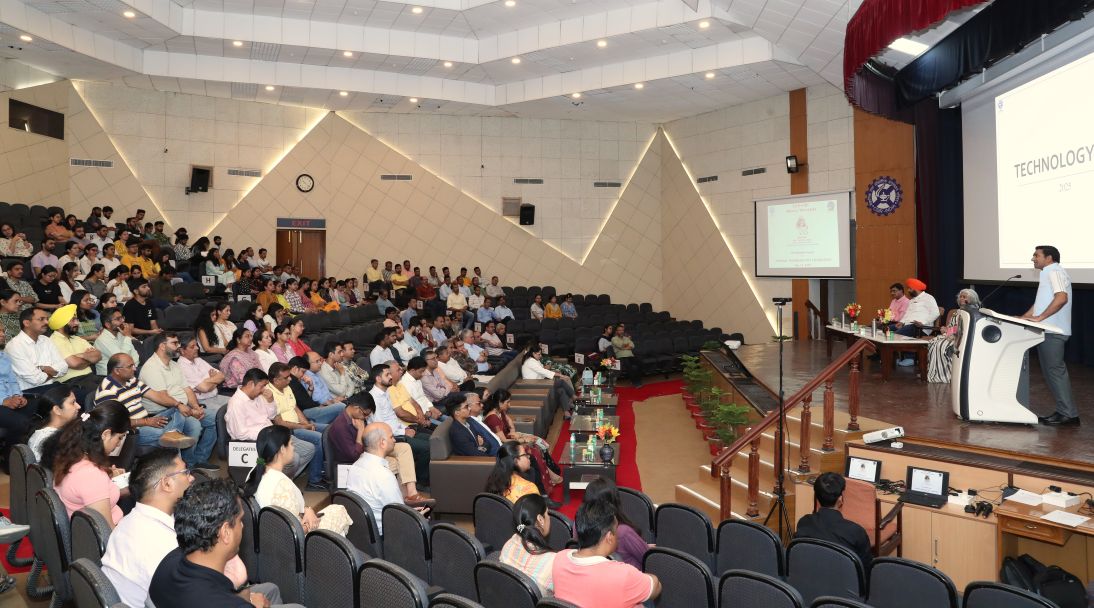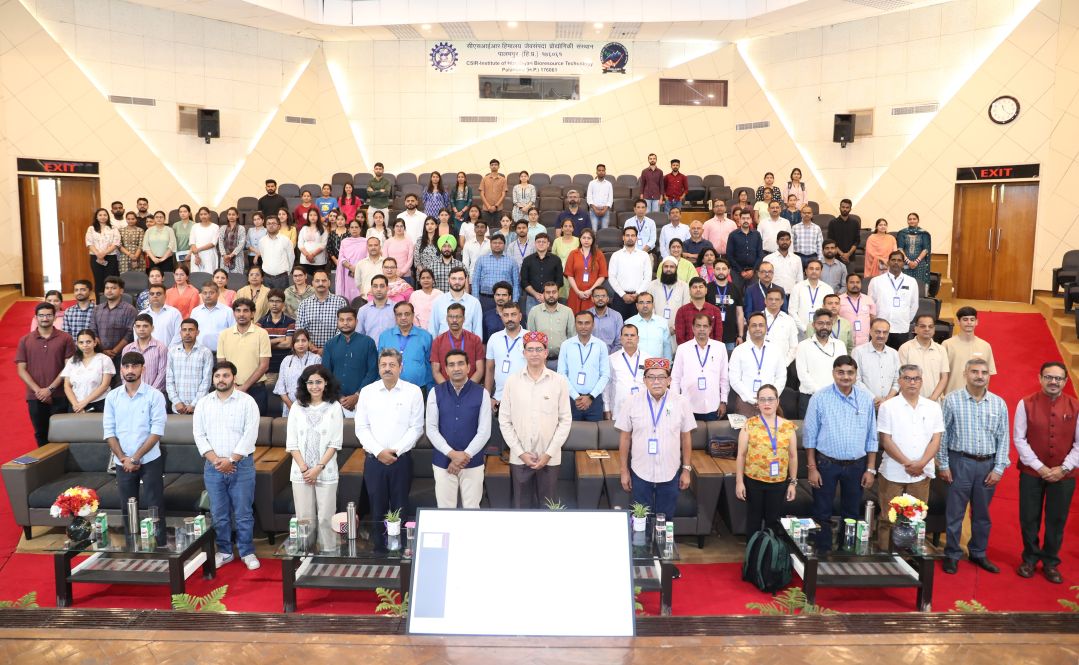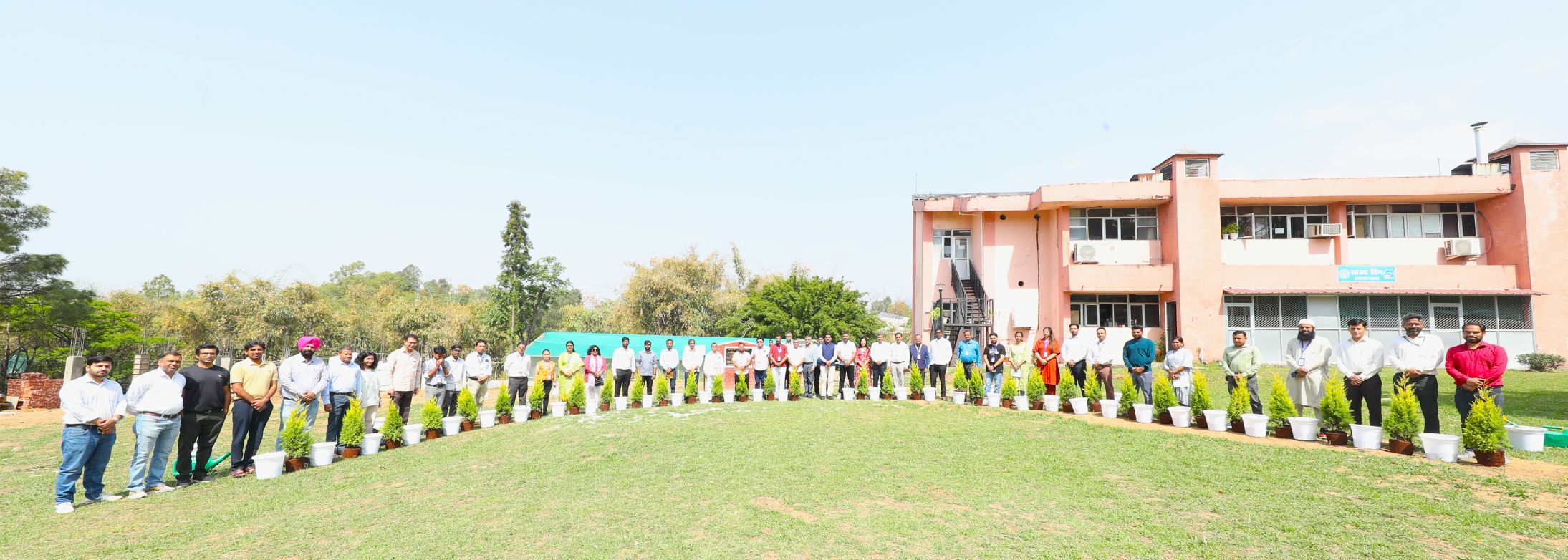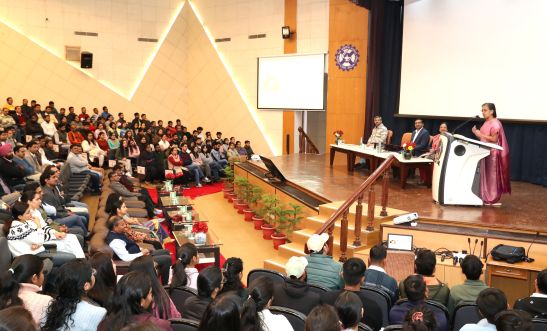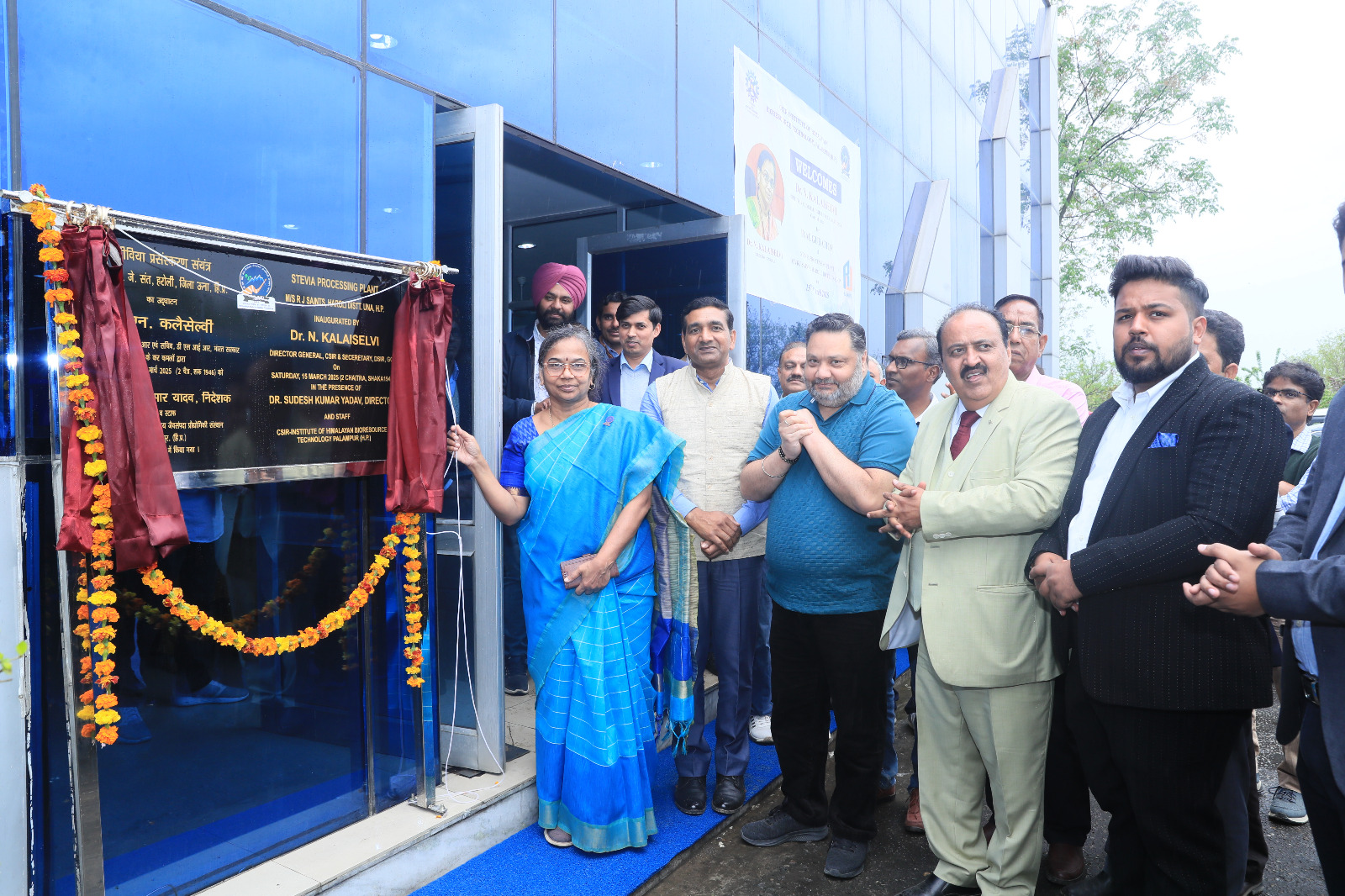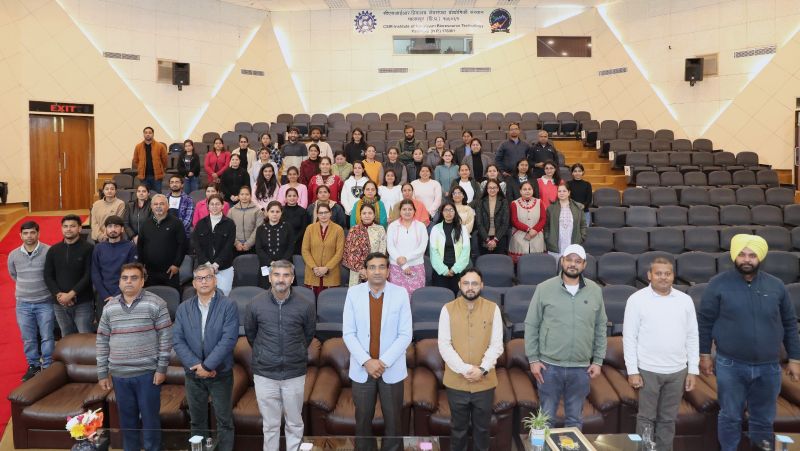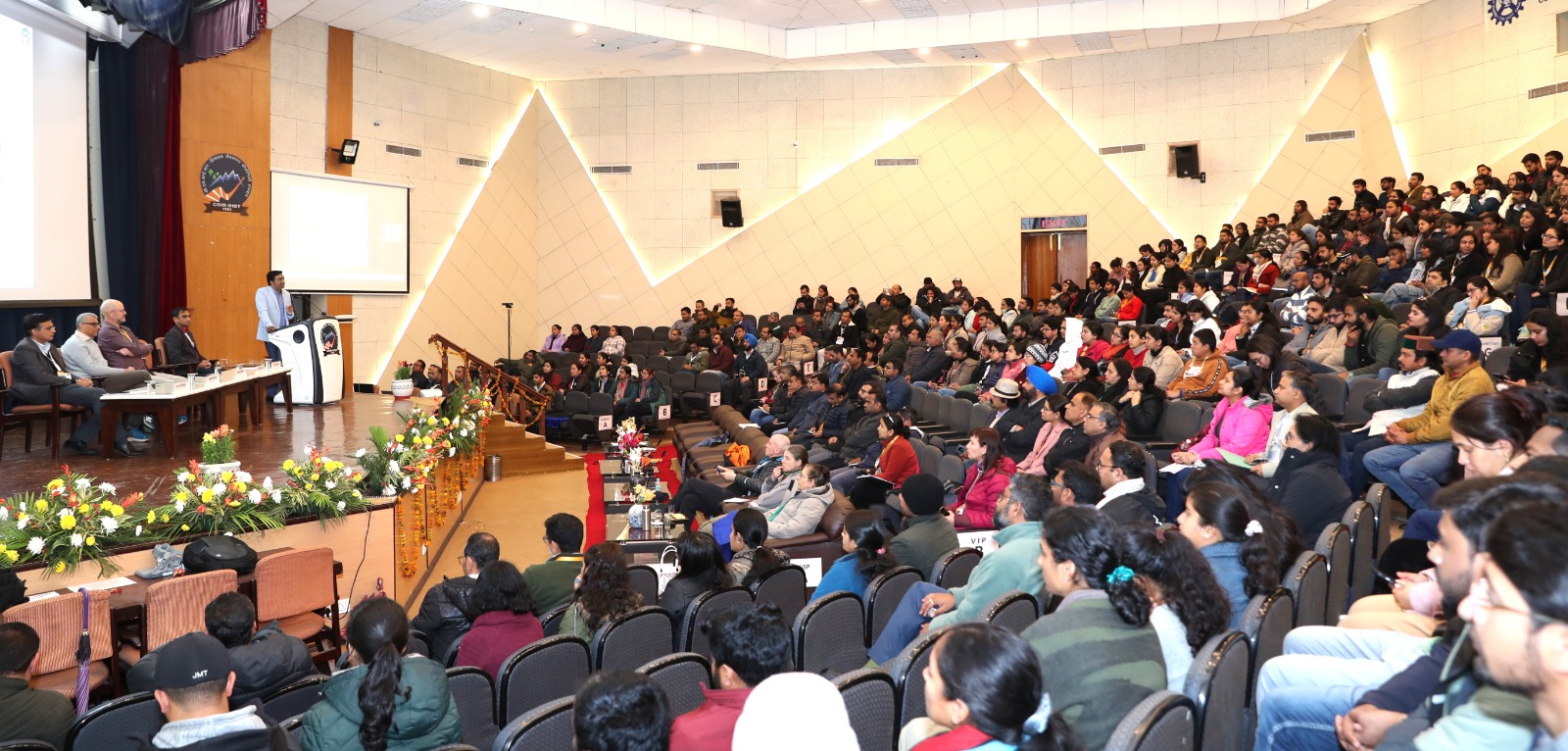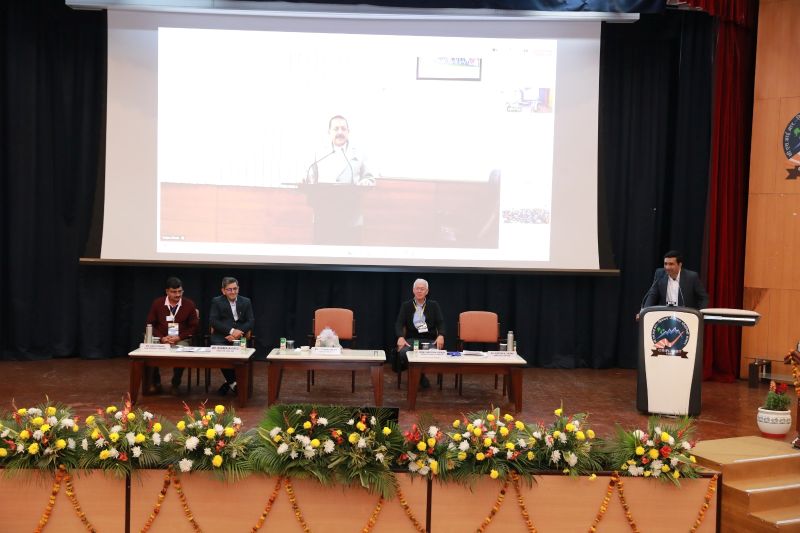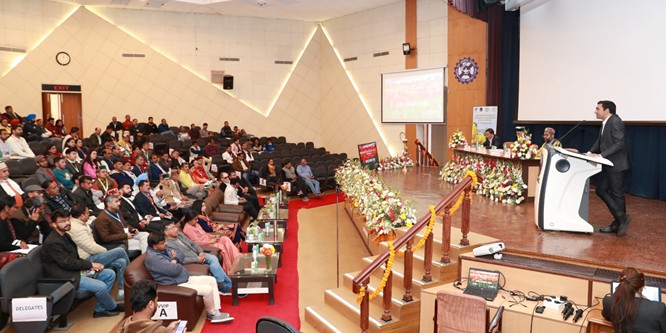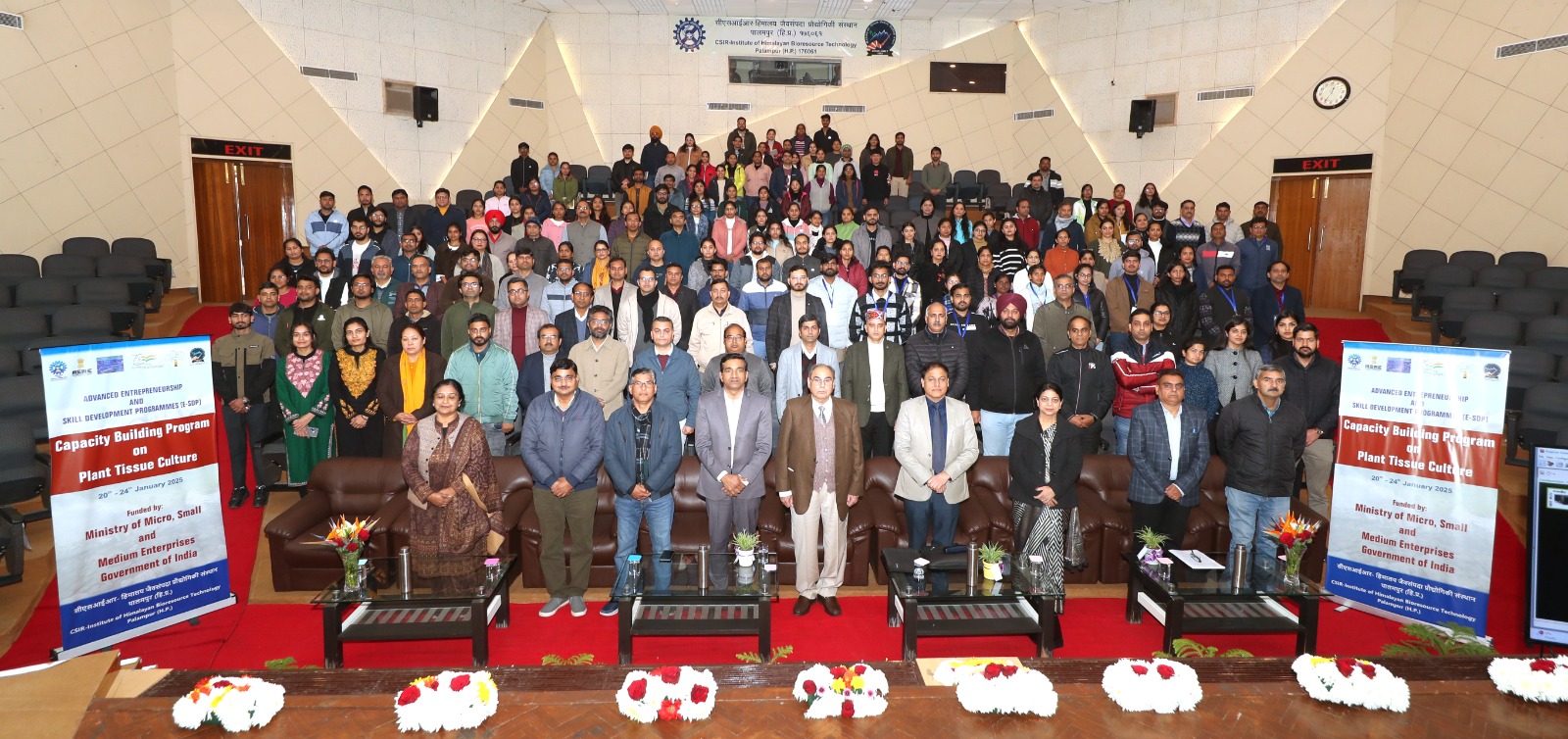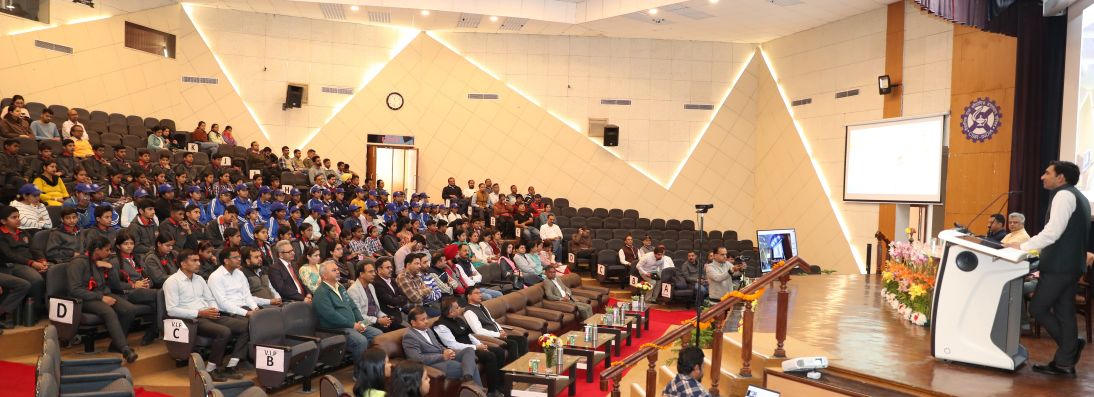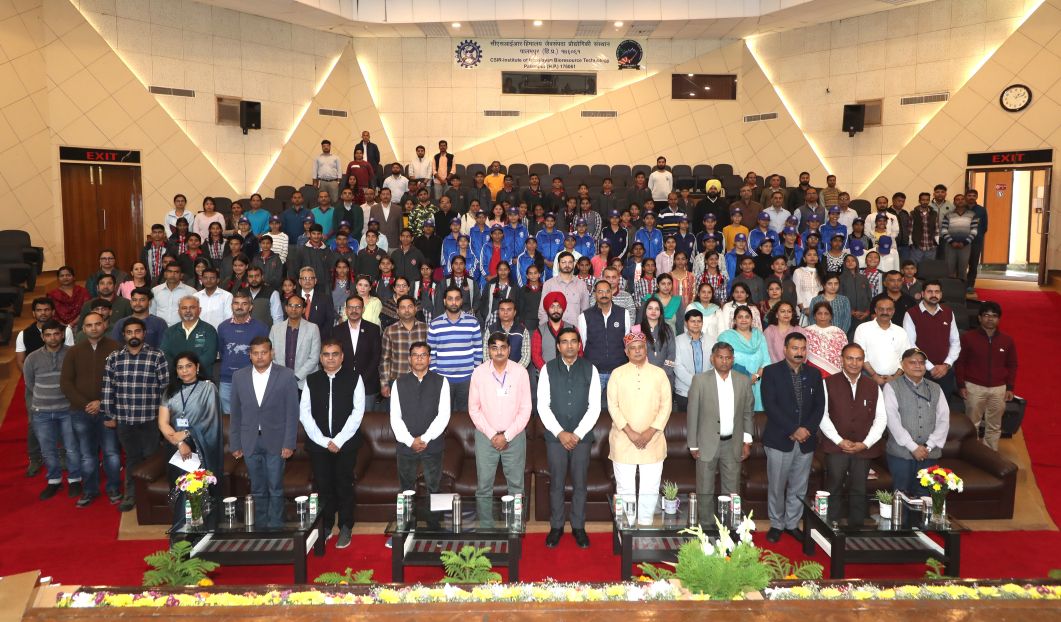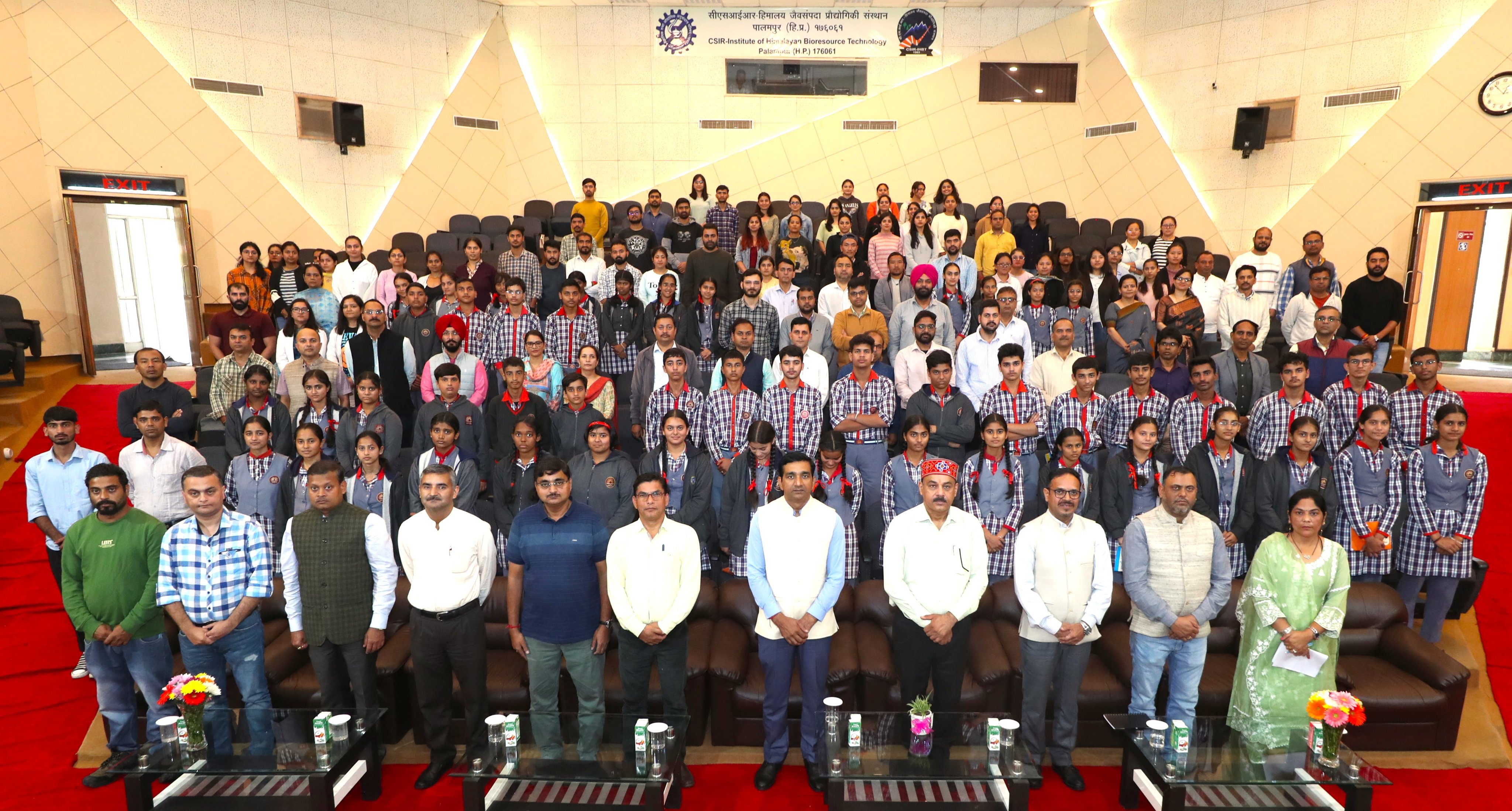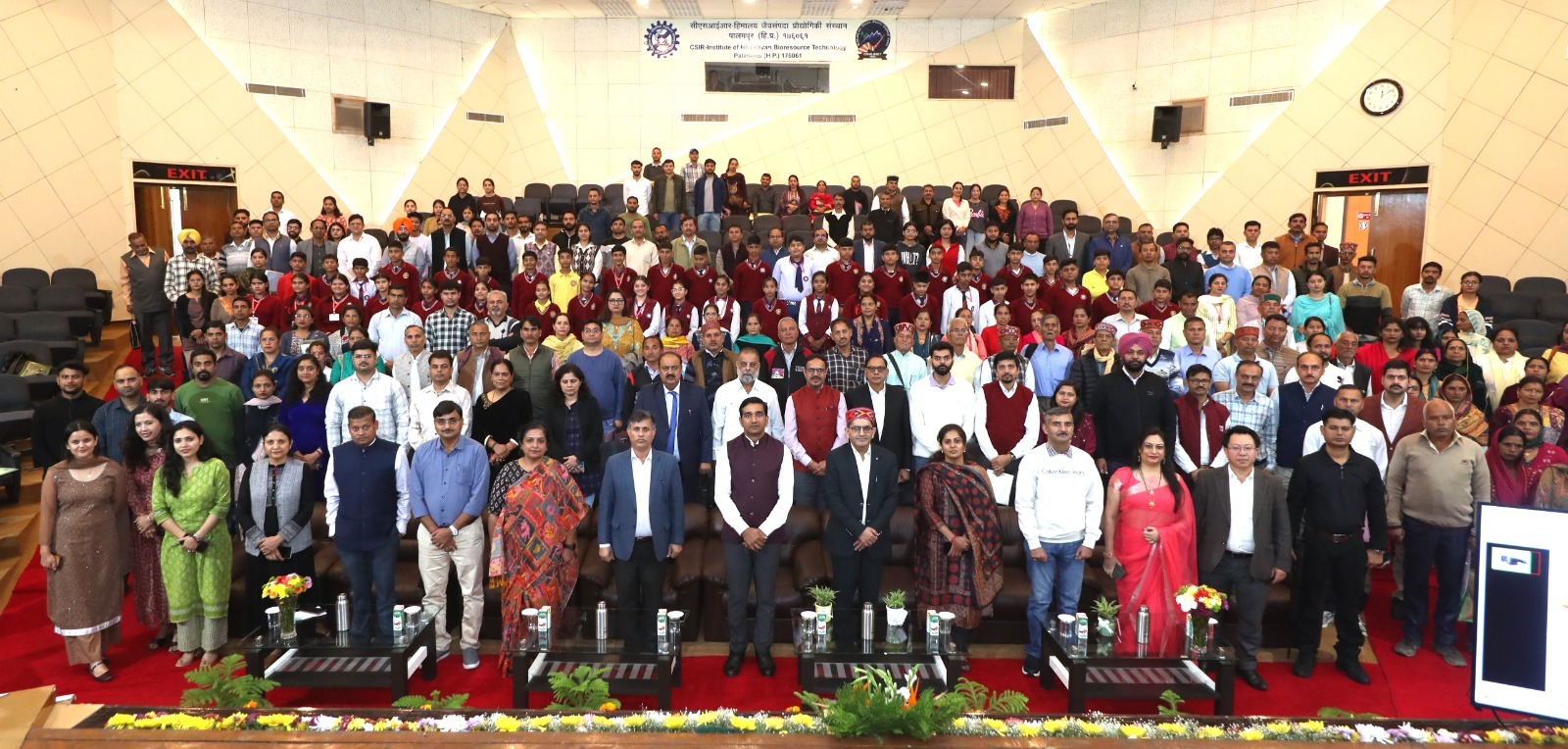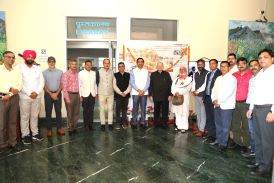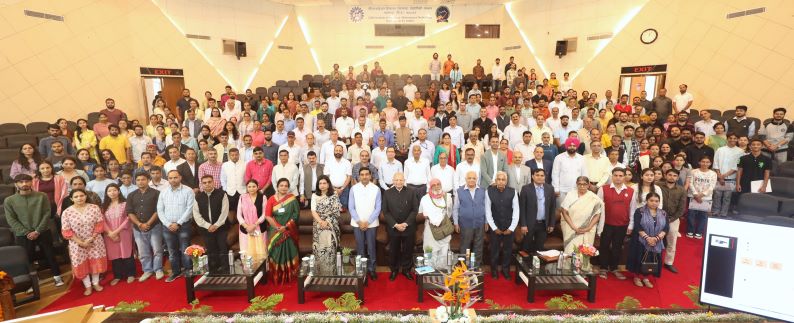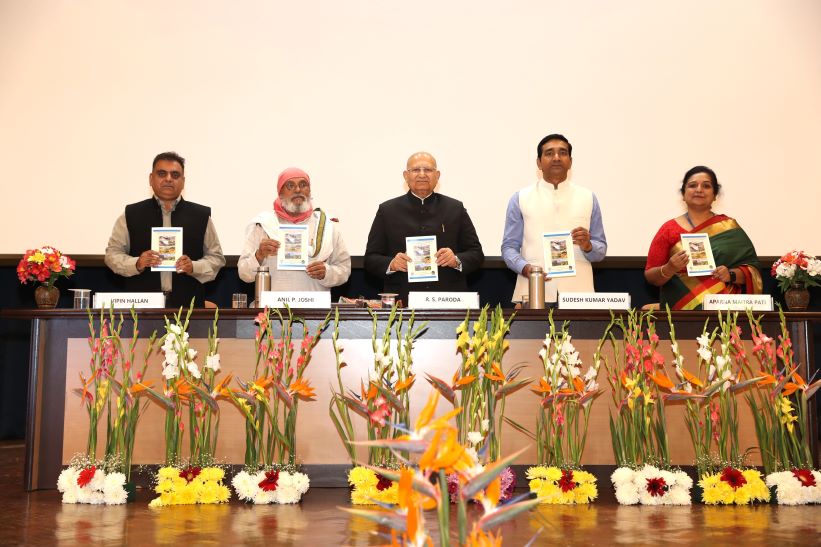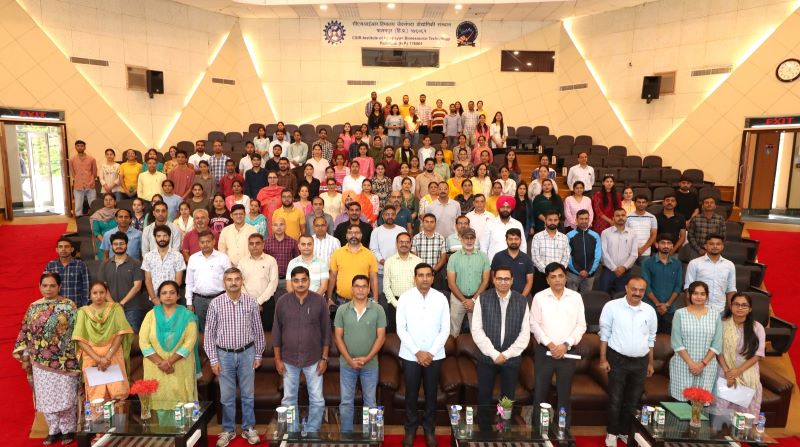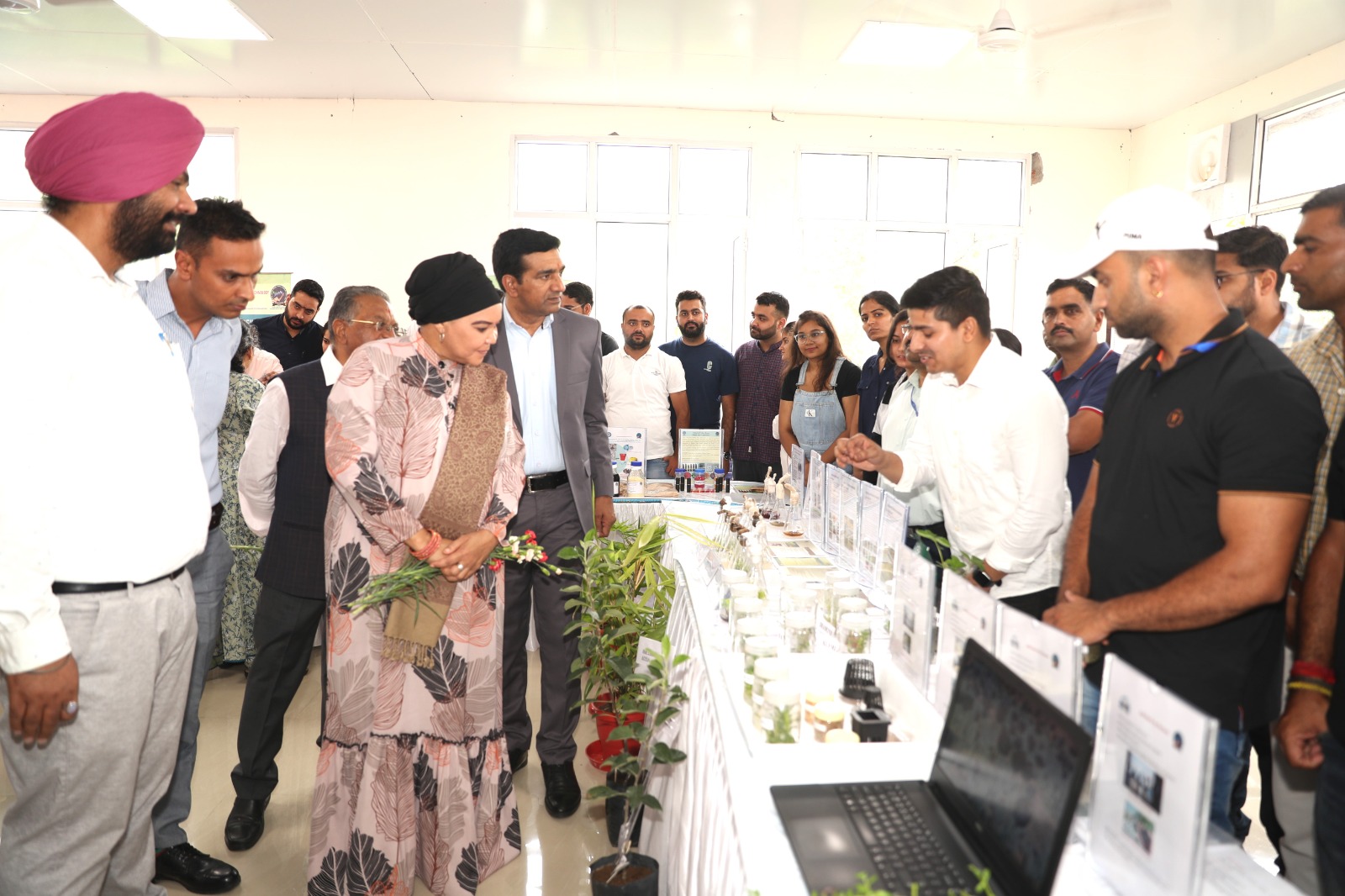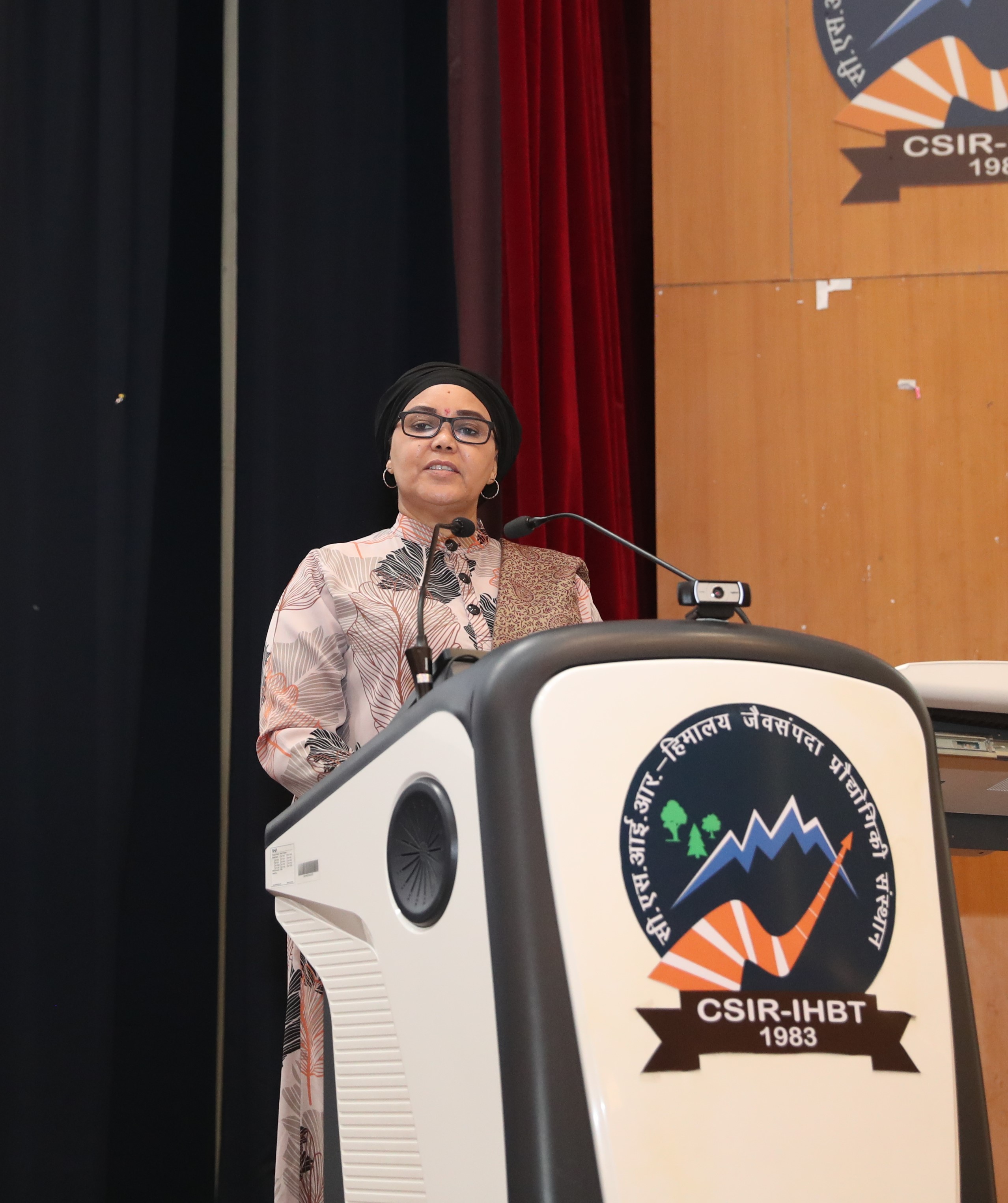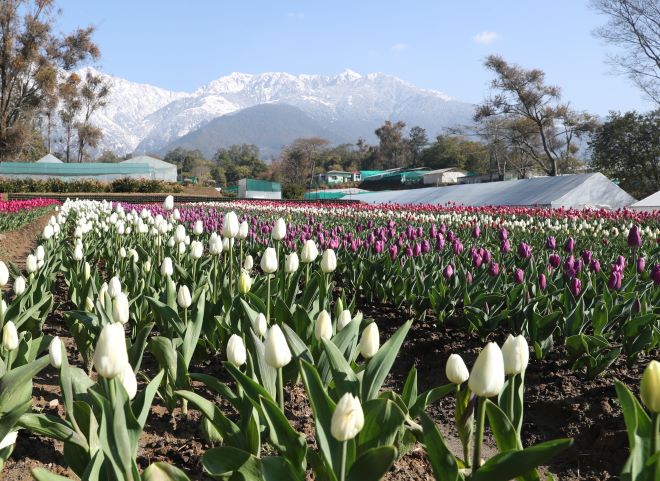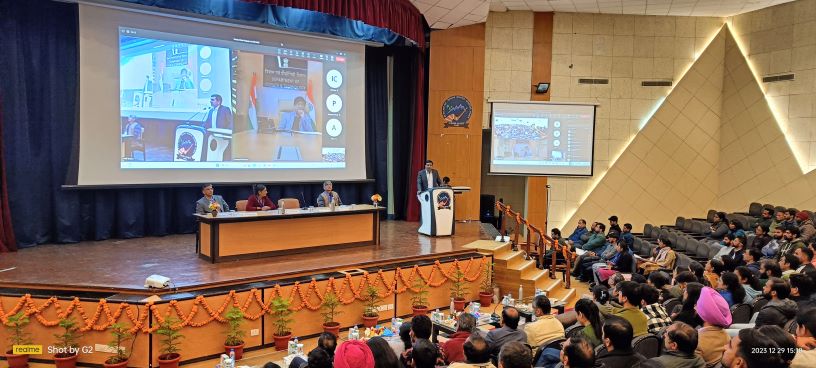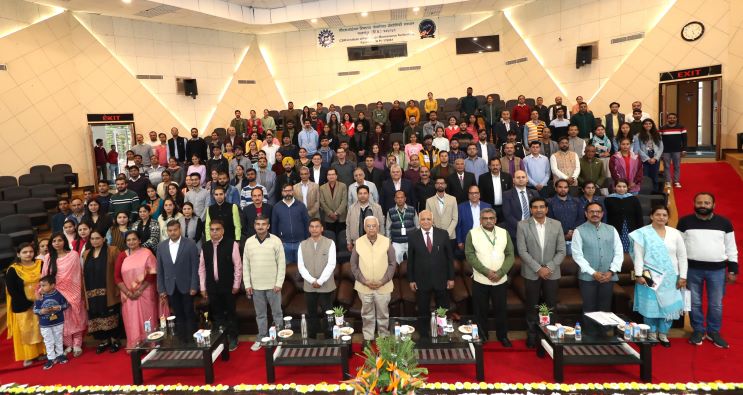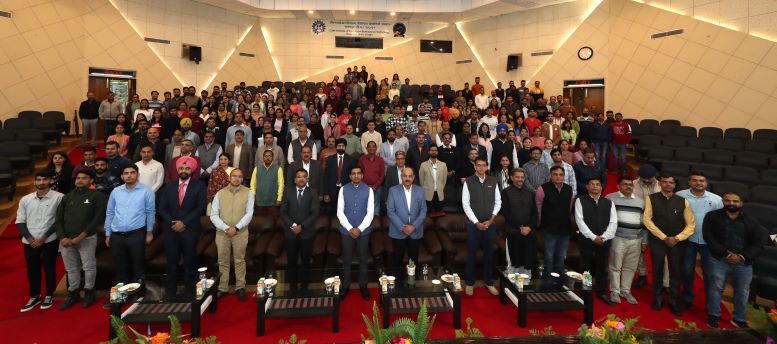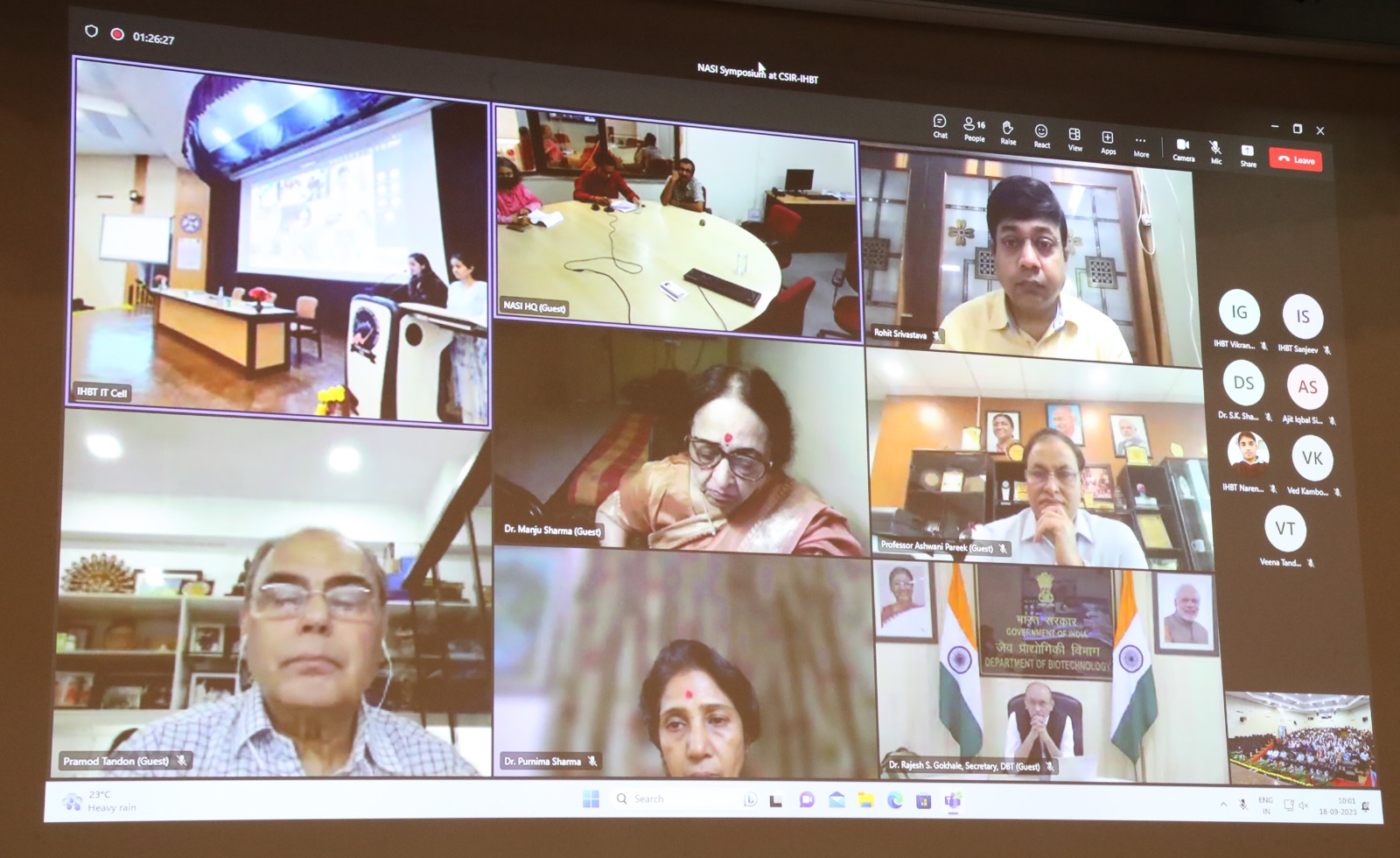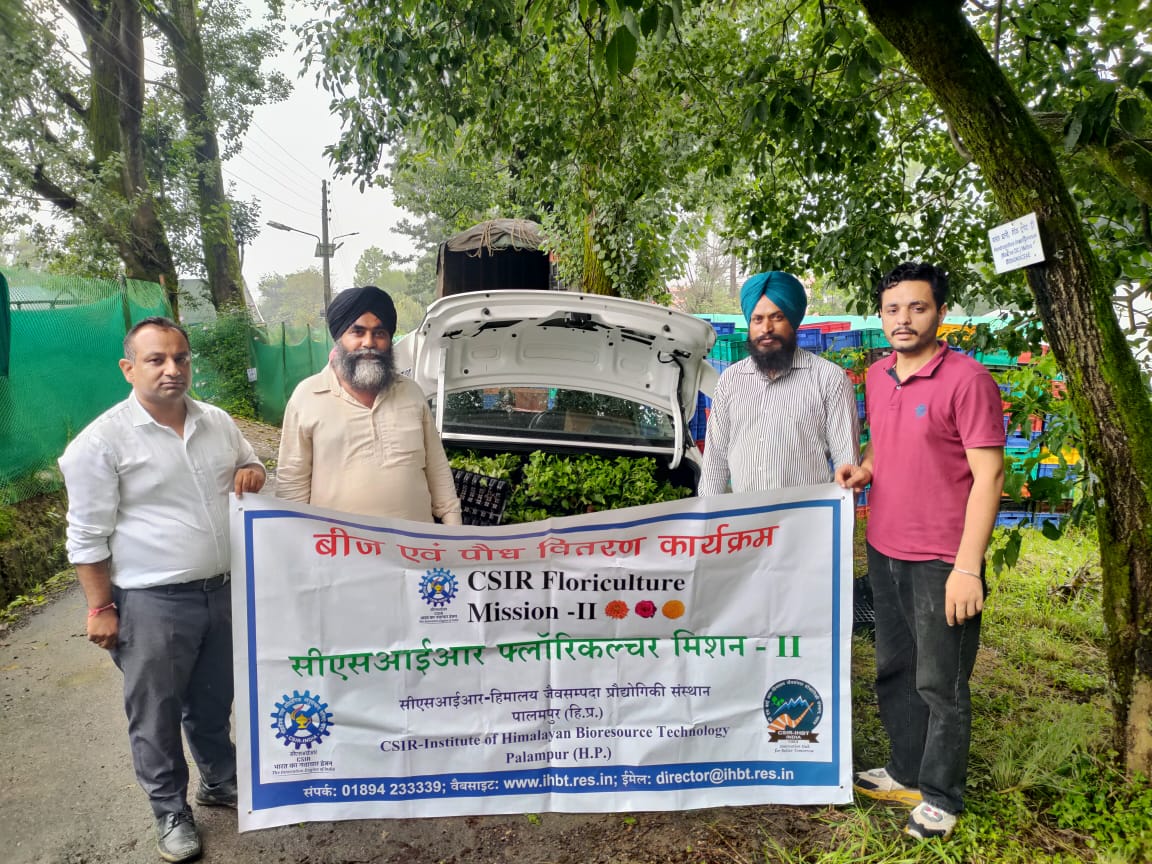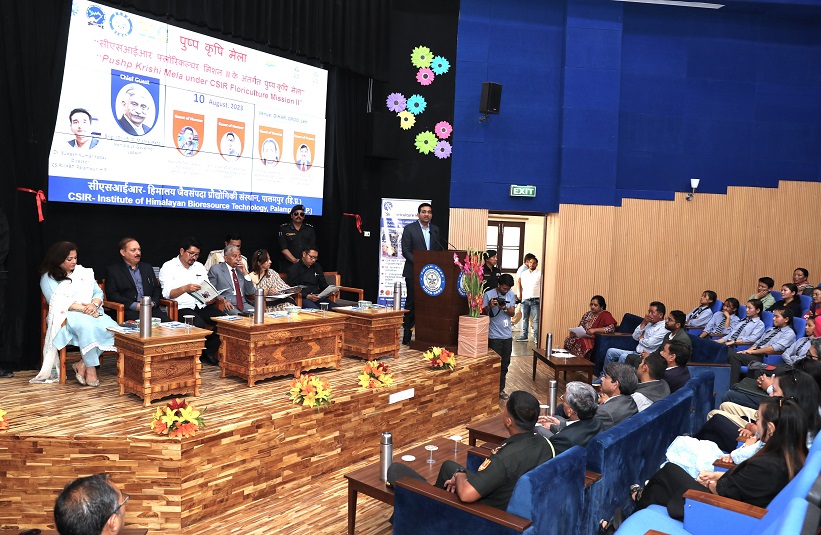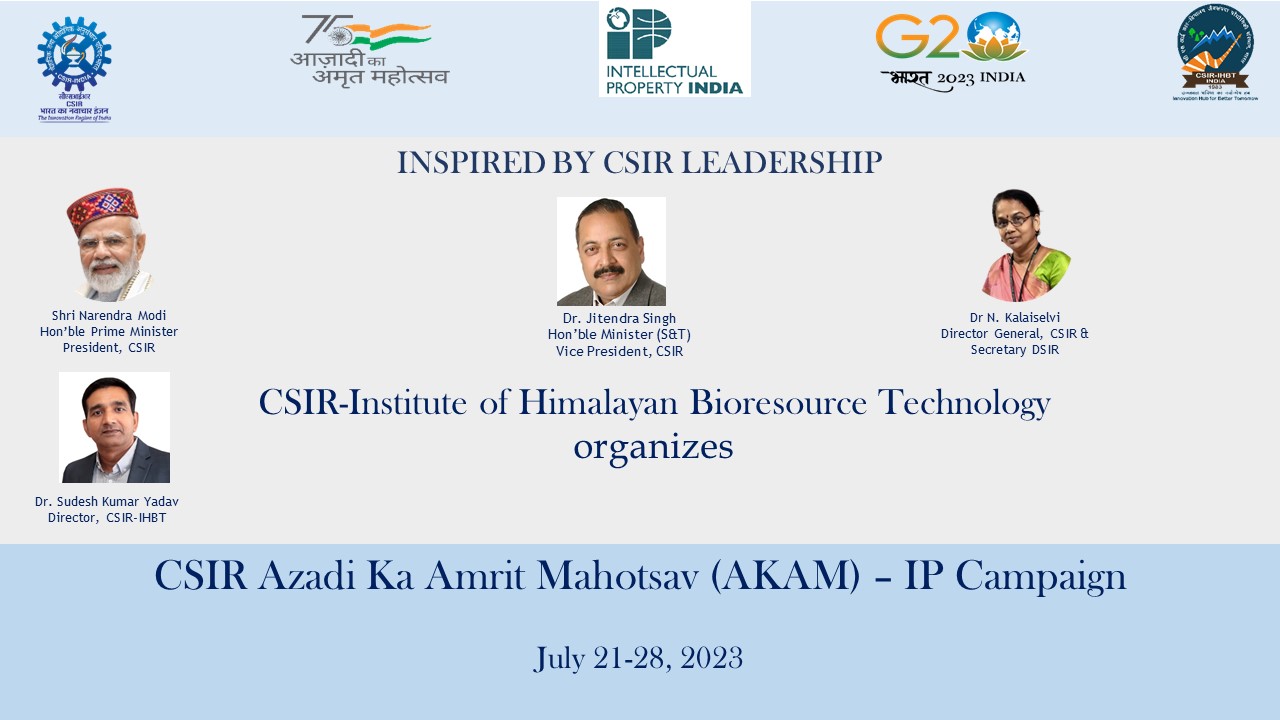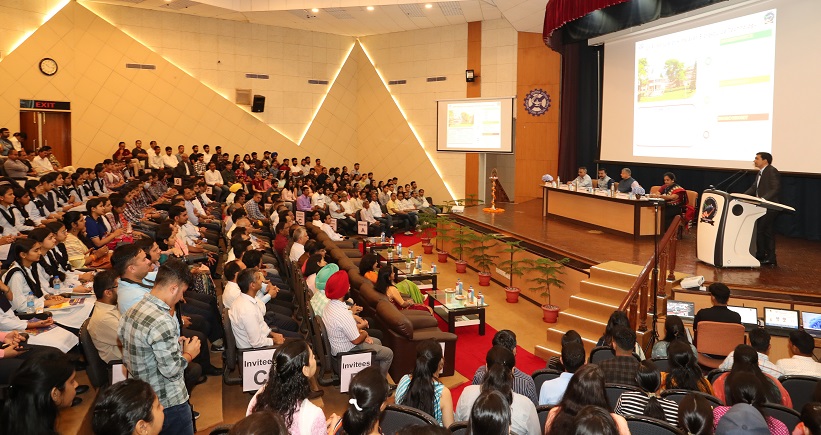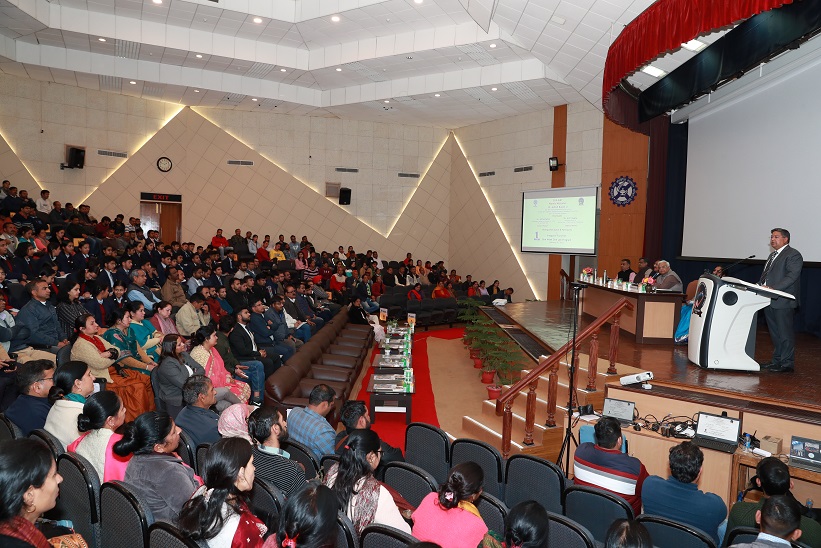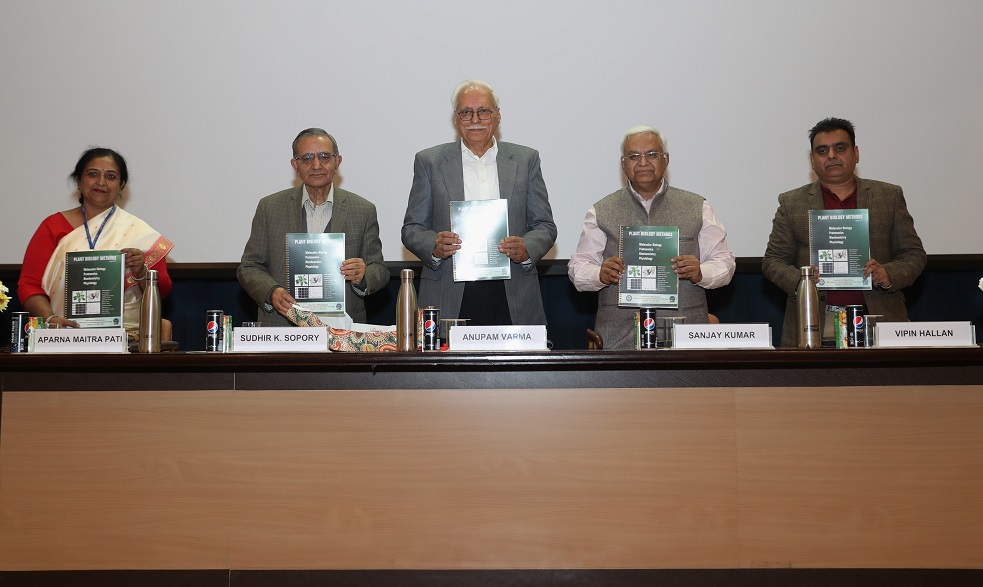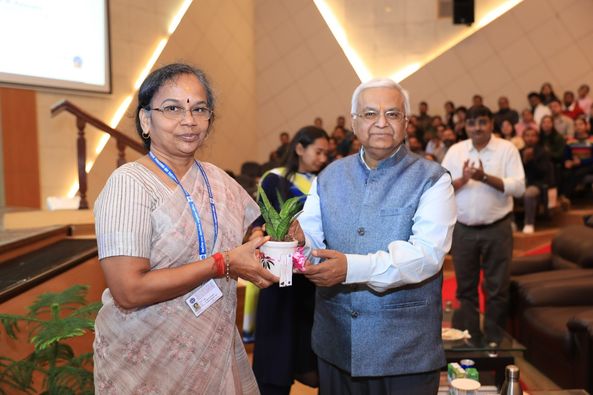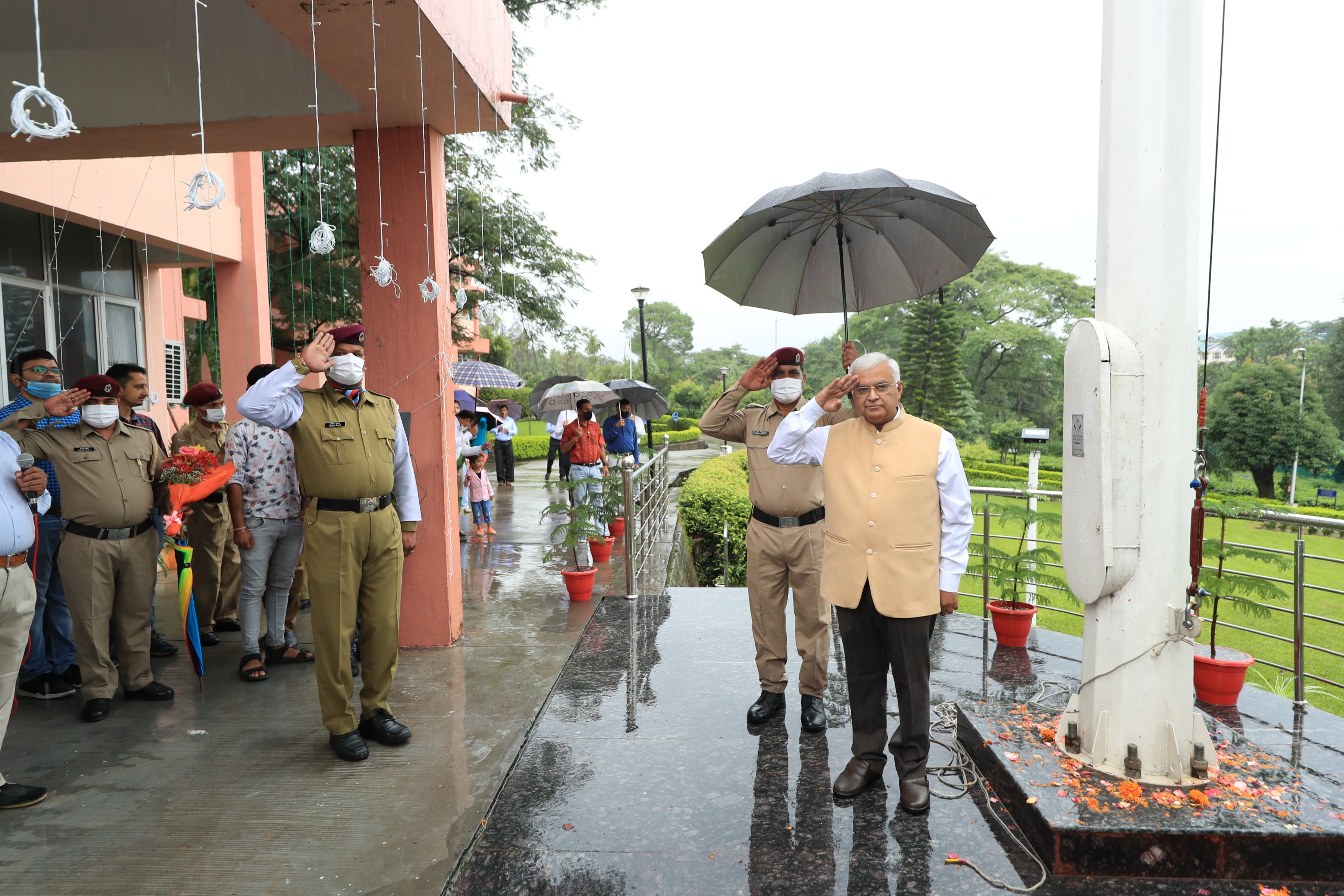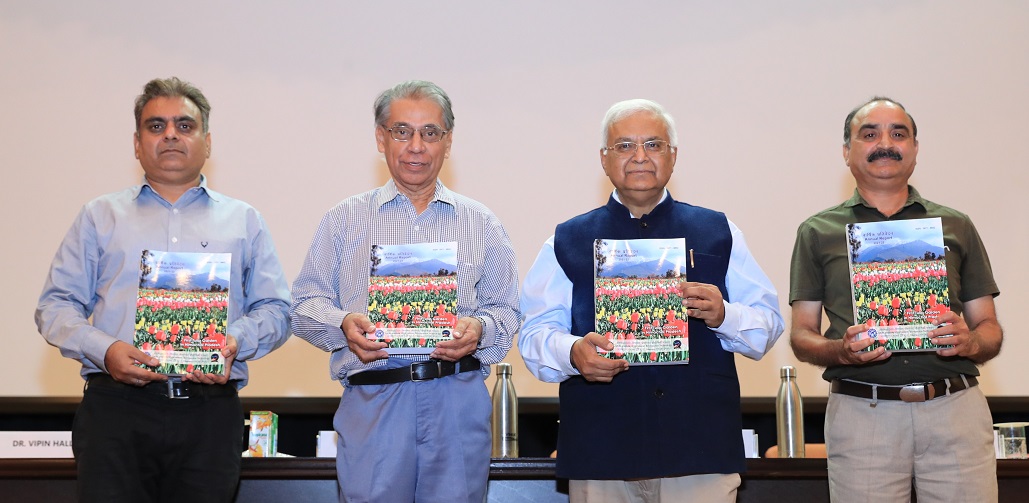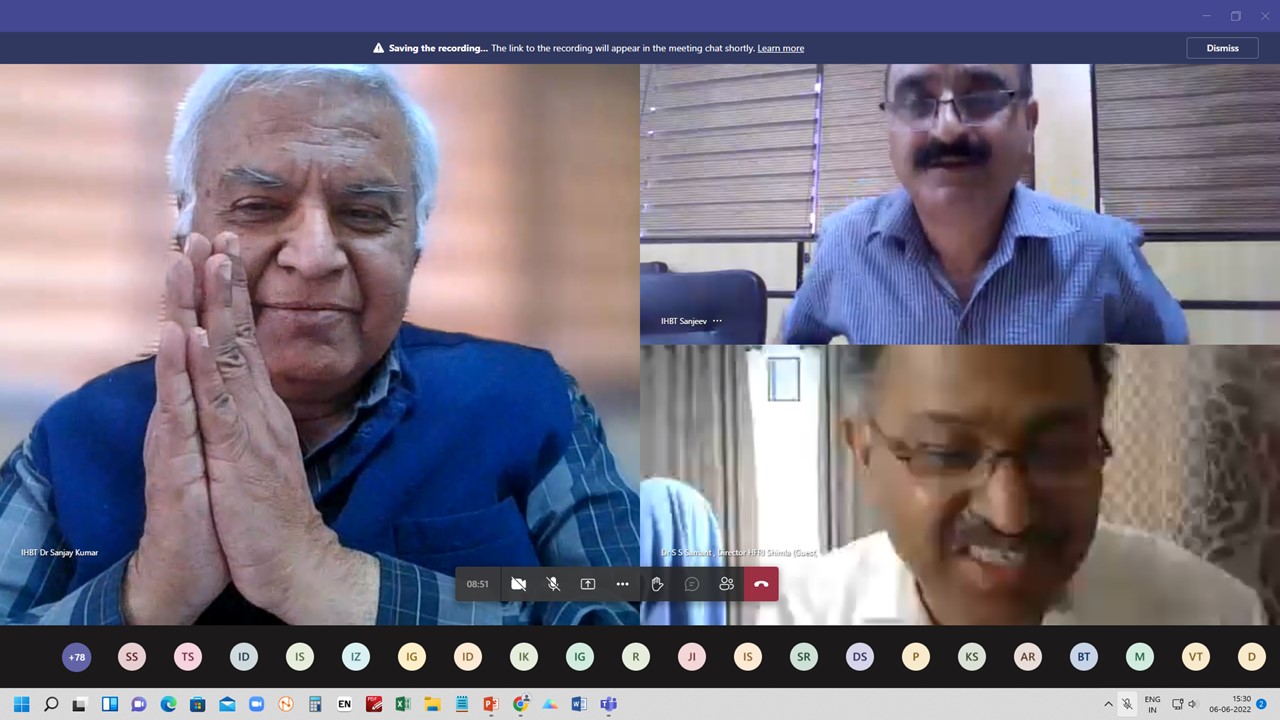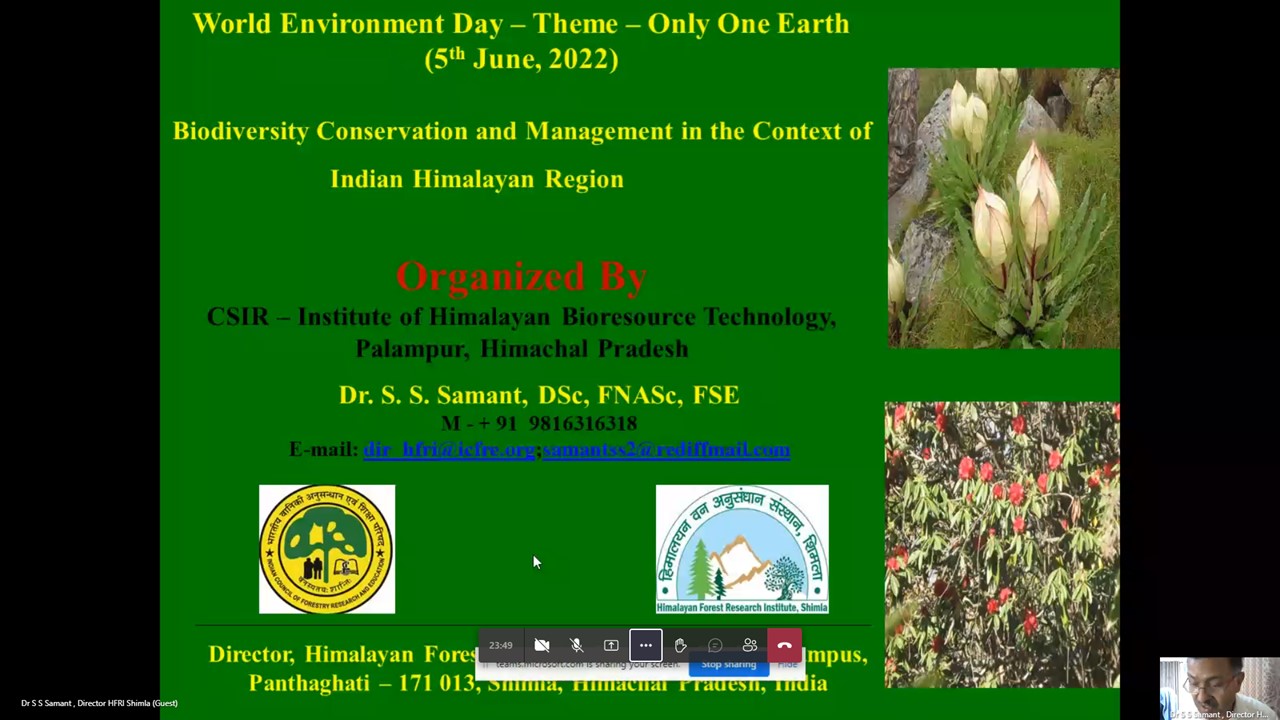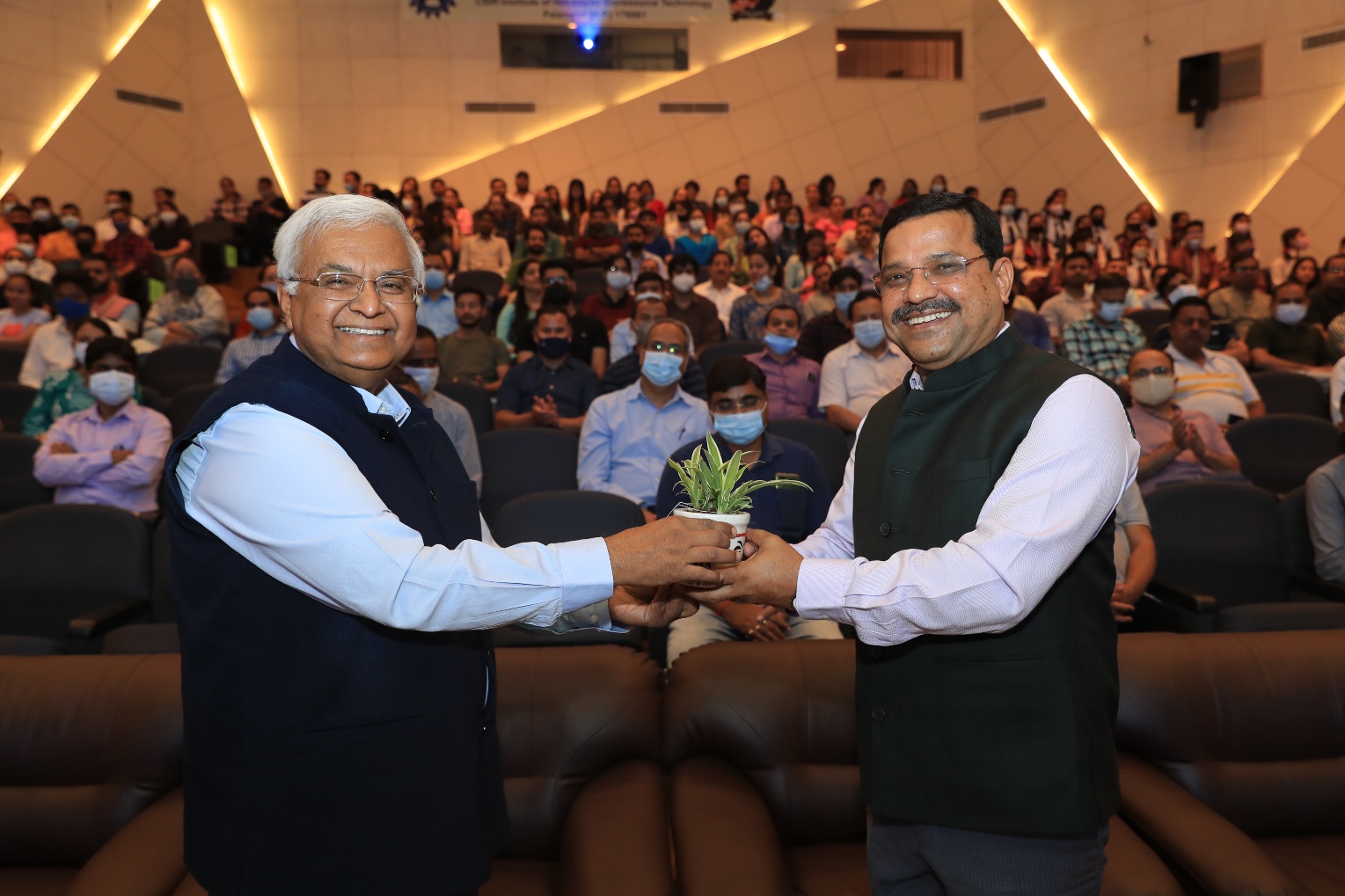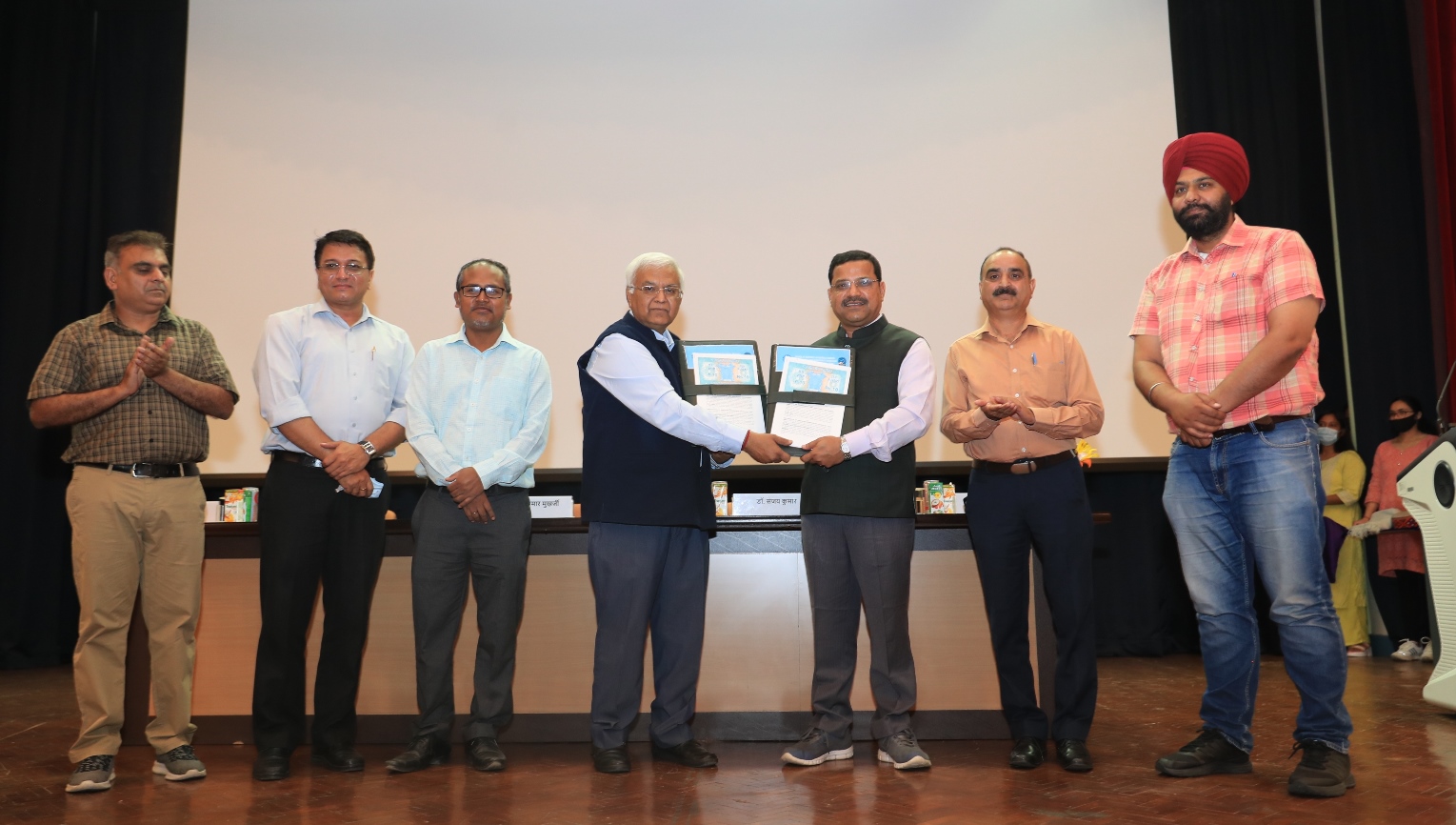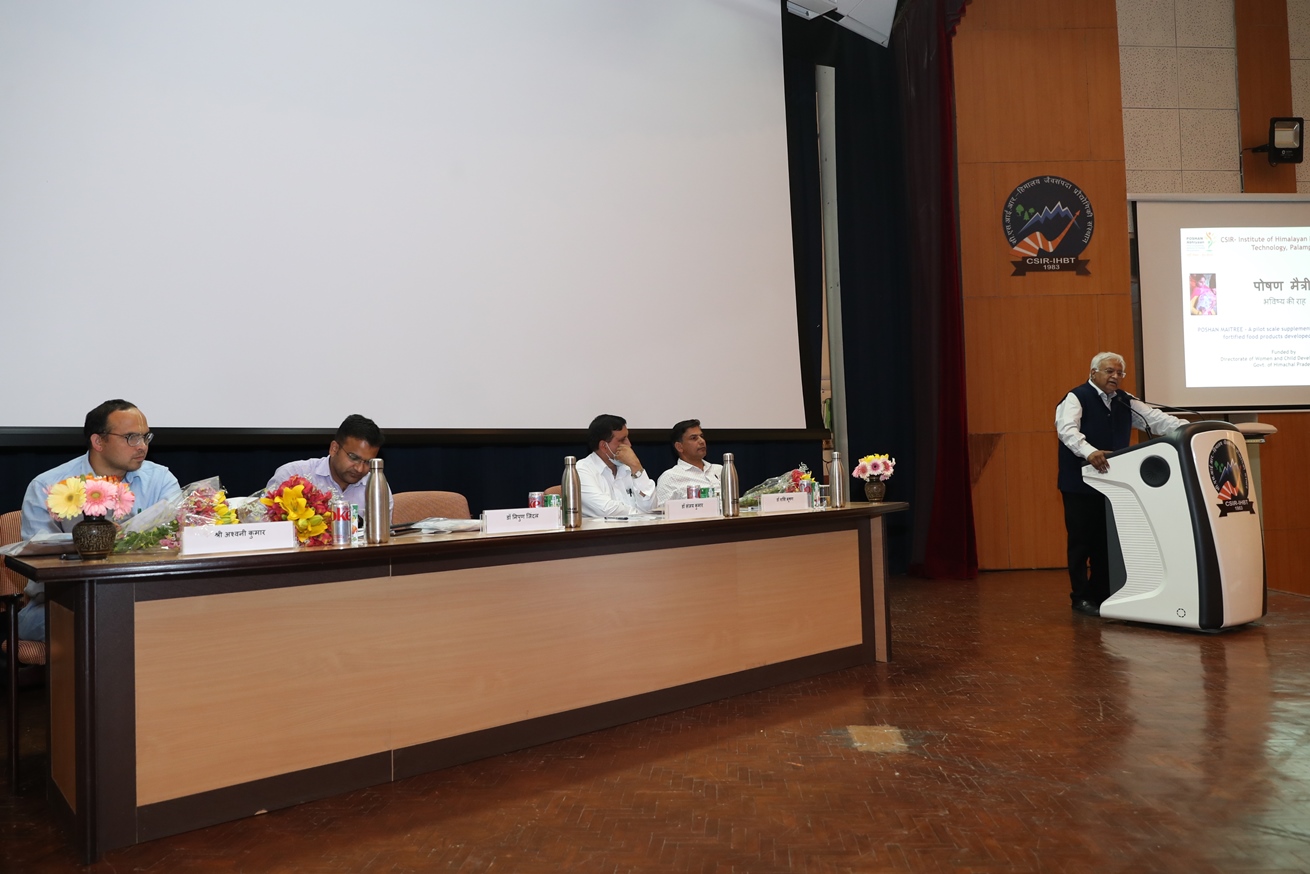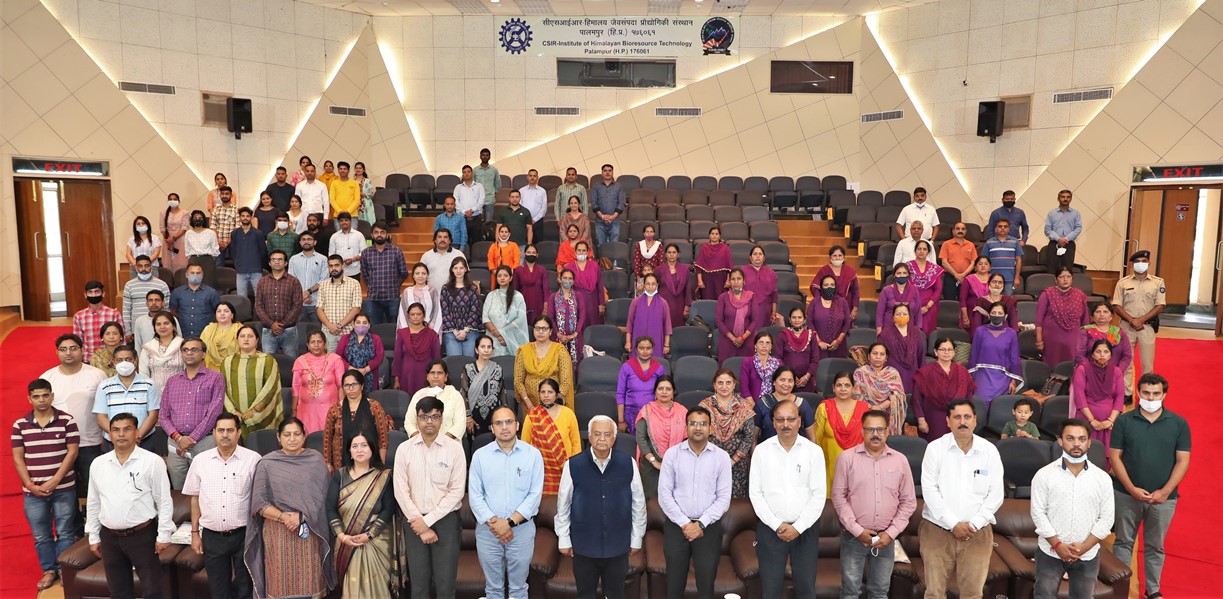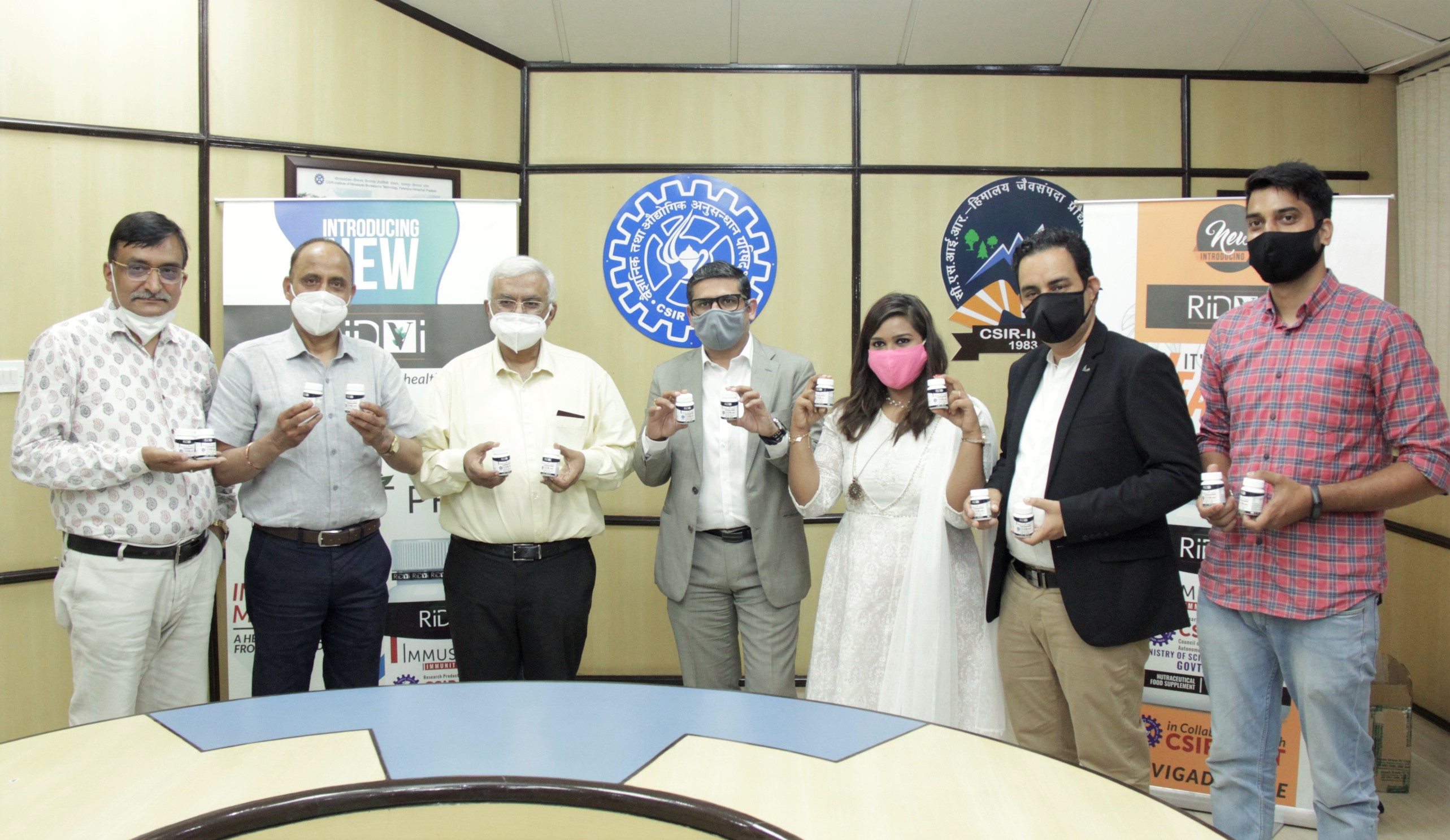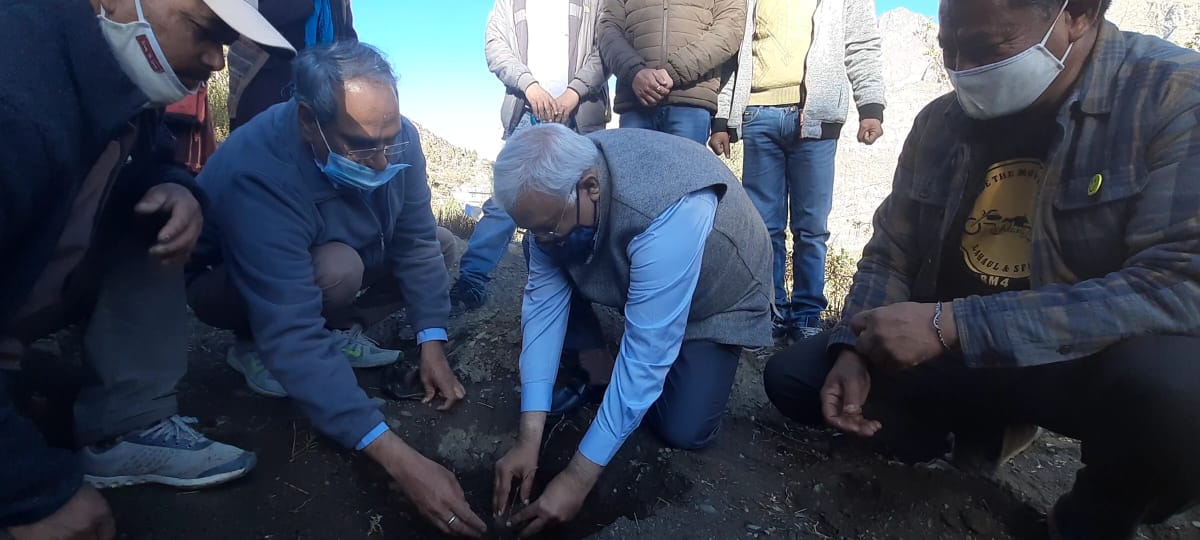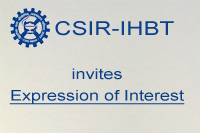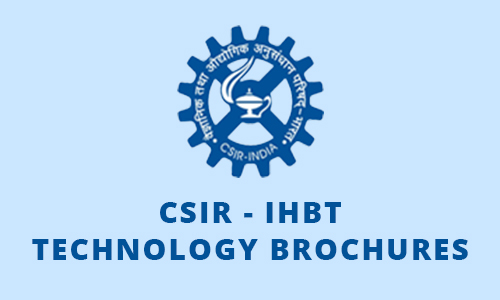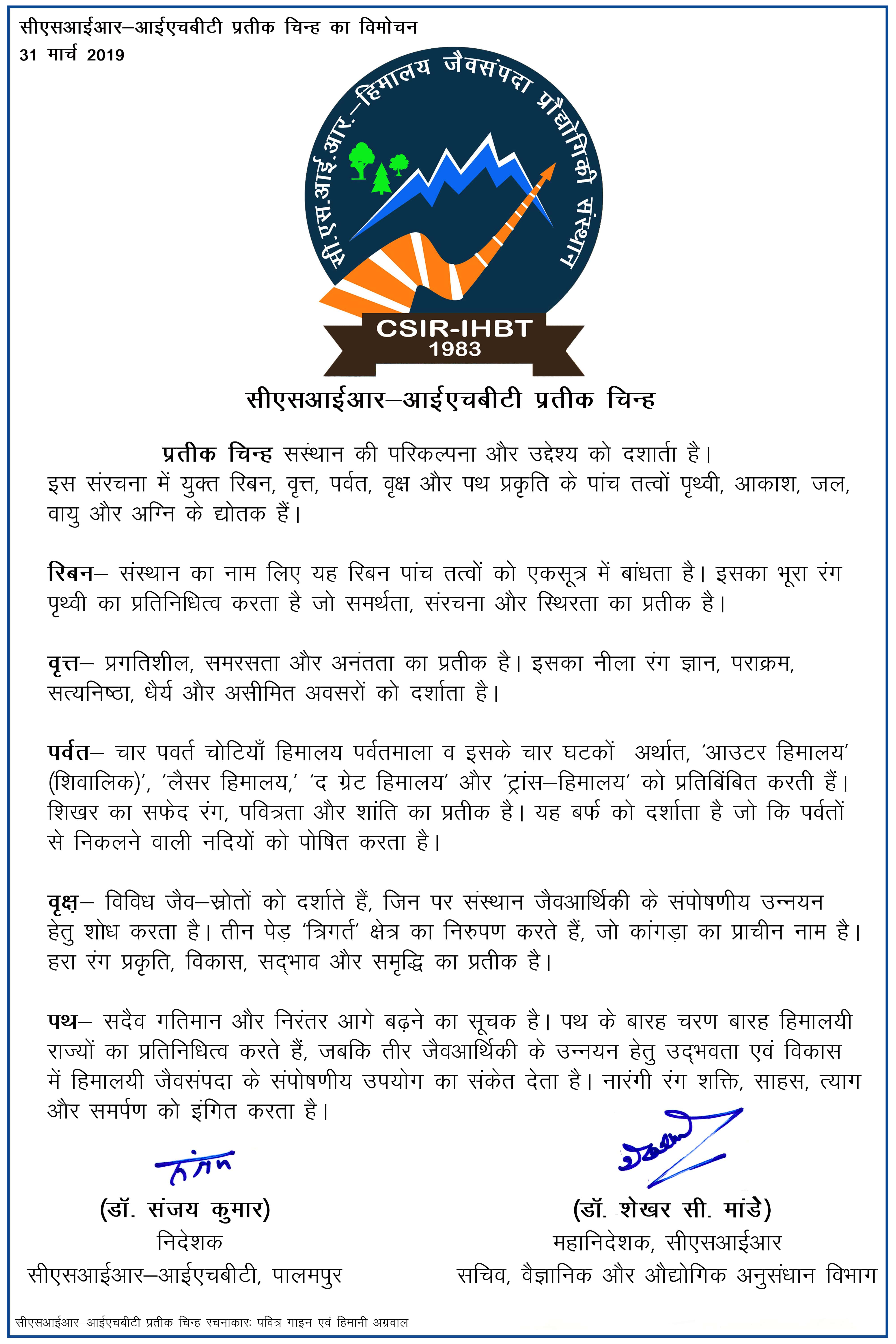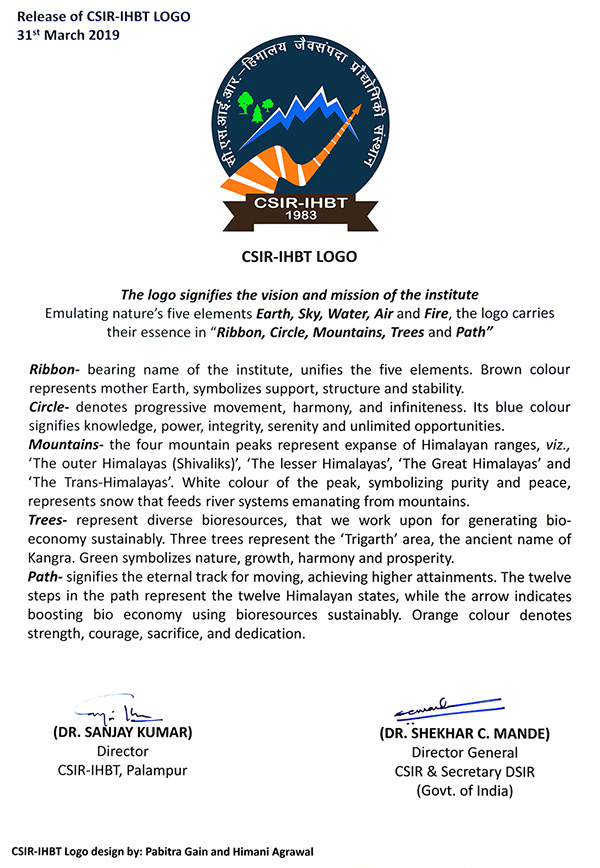- Adhikari BS, Uniyal SK and Rawat GS (2009) Vegetation structure and community patterns of Tehri dam Submergence zone, Uttarakhand, India. EurAsian Journal of Biosciences 3: 40-49.
- Anuradha N, Rana T, Kumar Y, Raja Ram, Hallan V and Zaidi AA (2010) Analysis of the Coat Protein Gene of Indian Strain of Apple Stem grooving virus. Journal of Plant Biochemistry and Biotechnology 19(1): 91-94.
- Bandna, Jaitak V, Singh B and Kaul VK (2009) Synthesis of novel acetates of Caryophyllene under lewis acid conditions. Natural Product Research 23(15): 1445- 1450.
- Bhandari P, Kumar N, Singh B and Ahuja PS (2010) Online HPLC-DPPH method for antioxidant activity of Picrorhiza kurroa Royle ex Benth. and characterization of kutkoside by Ultra-Performance LC-electrospray ionization quadrupole time-of-flight mass spectrometry. Indian Journal of Experimental Biology 48: 323-328.
- Bhandari P, Kumar N, Singh B and Kaur I (2009) Dammarane triterpenoid saponins from Bacopa monnieri. Canadian Journal of Chemistry 87(7): 1230-1234.
- Bhandari P, Kumar N, Singh B, Singh V and Kaur I (2009) Silica- based monolithic column with evaporative light scattering detector for HPLC analysis of bacosides and apigenin in Bacopa monnieri. Journal of Separation Science 32: 2812-18.
- Bhardwaj A, Tewary DK, Kumar R, Kumar V, Sinha AK and Shanker A (2010) Larvicidal and structure-activity studies of natural phenylpropanoides and their semisynthetic derivatives against the tobacco armyworm Spodoptera litura (Fab.) (Lepidoptera: Noctuidae). Chemistry and Biodiversity 7(1): 168-177.
- Chandel V, Singh MK, Hallan V and Zaidi AA (2010) Evidence for the occurrence of a distinct potyvirus on naturally growing Narcissus tazetta. Archieves of Phytopathology and Plant Protection 43(3): 209-214.
- Chaudhary A, Kaur P, Singh B and Pathania V (2009) Chemical composition of hydrodistilled and solvent volatiles extracted from woodchips of Himalayan Cedrus: Cedrus deodara (Roxb.) Loud. Natural Product Communications 9(4): 1257- 1260.
- Dhyani D and Singh S (2010) Domestication and conservation of Incarvillea emodi: a potential ornamental wild. Indian Journal of Agricultural Science 80(2): 182-185.
- Ghawana S, Kumar S and Ahuja PS (2010) Early low-temperature responsive mitogen activated protein kinases RaMPK1 and RaMPK2 from Rheum australe D. Don respond differentially to diverse stresses. Molecular Biology Reports 37: 933–938.
- Gopichand, Singh RD, Kumar A, Meena RL and Ahuja PS (2009) Current status of Ginkgo biloba L. in India. The Indian Forester 135(11): 1588-1593.
- Gulati A, Subramani R, Karthigeyan S, Sud RK, Deepu V, Thomas J, Rajagopal R, Das SC, Tamuly P, Hazarika M and Ahuja PS (2009) Catechin and catechin fractions as biochemical markers to study the diversity of Indian tea (Camellia sinensis (L.) O. Kuntze) germplasm. Chemistry and Biodiversity 6: 1042-52.
- Gulati A, Vyas P, Rahi P and Kasana RC (2009) Plant growth promoting and rhizosphere competent Acinetobacter rhizosphaerae strain BIHB 723 from the cold deserts of himalayas. Current Microbiology 58 (4): 371-377.
- Hossain MM, Sharma M, Teixeira da Silva JA and Pathak P (2010) Seed germination and tissue culture of Cymbidium giganteum Wall. ex Lindl. Scientia Horticulturae 123: 479-487.
- Hossain MM, Sharma M and Pathak P (2009) Cost effective protocol for in vitro mass propagation of Cymbidium aloifolium (L.) Sw.- a medicinally important orchid. Engineering in Life Sciences 9(1): 1-10.
- Hossain MM, Sharma M and Pathak P (2009) In vitro mass propagation of an economically important orchid, Cymbidium aloifolium (L.) Sw. Journal of the Orchid Society of India 22(1-2): 91-95.
- Jaitak V, Bandna, Singh B and Kaul VK (2009) An efficient microwave-assisted extraction process of stevioside and rebaudioside-A from Stevia rebaudiana. Phytochemical Analysis 20: 240-245.
- Jaitak V, Kaul VK, Bandna, Kumar N, Singh B, Savergave LS, Jogdand VV and Nene S (2009) Simple and efficient enzymatic transglycosylation of stevioside by β-cyclodextrin glucanotransferase from Bacillus firmus. Biotechnology Letters 31(9): 1415-20.
- Jaitak V, Sharma K, Kalpana K, Singh HP, Singh B and Kaul VK (2010) Antioxidant activity of Potentilla fulgens: An alpine plant of western Himalaya. Journal of food composition and analysis. 23: 142-147
- Kamunya SM, Wachira FN, Pathak RS, Muoki RC, Wanyoko JK, Ronno WK and Sharma RK (2009) Quantitative genetic parameters in tea (Camellia sinensis (L.) O. Kuntze): I. combining abilities for yield, drought tolerance and quality traits. African Journal of Plant Science 3(5): 93-101.
- Kaul K, Karthigeyan S, Dhyani D, Kaur N, Sharma RK and Ahuja PS (2009) Morphological and molecular analyses of Rosa damascena x R. bourboniana interspecific hybrids. Scientia Horticulturae 122: 258–263.
- Kaur P, Chandel M, Kumar S, Kumar N, Singh B and Kaur S (2010) Modulatory role of alizarin from Rubia cordifolia L. against genotoxicity of mutagens. Journal of Food Chemistry and Toxicology 48: 320- 325.
- Kaur P, Chaudhary A, Singh B and Gopichand (2009) Optimization of extraction technique and validation of developed RP-HPLC-ELSD method for determination of terpene trilactones in Ginkgo biloba leaves. Journal of Pharmaceutical and Biomedical Analysis 50: 1060-1064.
- Kaur P, Kaur S, Kumar N, Singh B and Kumar S (2009) Evaluation of antigenotoxic activity of isoliquiritin apioside from Glycyrrhiza glabra L. Toxicology in Vitro 23: 680-686.
- Kharkwal A, Singh D, Rajkumar S and Ahuja PS (2009) Genetic variation within and among the populations of Podophyllum hexandrum Royle. (Podophyllaceae) in western Himalaya. Plant Genetic Resources Newsletter 156: 67-71.
- Kumar A and Uniyal SK (2008) Distribution pattern of Dendrocalamus strictus in Kangra district of Himachal Pradesh, India. Journal of Bamboo and Rattan 7(3 & 4): 211-217.
- Kumar R (2009) Calibration and validation of regression model for non destructive leaf area estimation of saffron (Crocus sativus L.). Scientia Horticulturae 122:142-145.
- Kumar Y, Hallan V and Zaidi AA (2009) Identification and characterization of bean yellow mosaic virus infecting freesia. Journal of Plant Biochemistry & Biotechnology 18: 253-255.
- Kumari A, Yadav SK and Yadav SC (2010) Biodegradable polymeric nanoparticles based drug delivery systems. Colloid and Surface Chemistry B: Biointerfaces 75(1): 1-18.
- Kunde NP, Jaitak V, Kaul VK and Sharma OP (2010) Composition and antibacterial activity of essential oils of Lantana camara, Ageratum houstorianum and Eupatorium aderophorum. Pharmaceutical Biology, 48(5): 539-544.
- Malik S, Sharma S, Sharma M and Ahuja PS (2010) Direct shoot regeneration from intact leaves of Arnebia euchroma (Royle) Johnston using thidiazuron. Cell Biology International 34(5): 537-542.
- Malik S, Kumar R, Vats SK, Bhushan S, Sharma M and Ahuja PS (2009) Regeneration in Rheum emodi Wall.: a step towards conservation of an endangered medicinal plant species. Engineering in Life Sciences 9(2): 130-134.
- Mohanpuria P, Kumar V, Joshi R, Gulati A, Ahuja PS and Yadav SK (2009) Caffeine biosynthesis and degradation in tea [Camellia sinensis (L.) O. Kuntze] is under developmental and seasonal regulation. Molecular Biotechnology 43(2): 104-111.
- Mohanpuria P and Yadav SK (2009) Retardation in seedling growth and induction of early senescence in plants upon caffeine exposure is related to its negative effect on Rubisco. Photosynthetica 47(1): 293-297.
- Negi A, Rana T, Kumar Y, Hallan V and Zaidi AA (2009) Molecular characterization of Apple stem grooving virus from Pome and Stone fruits in India. Journal of Plant Pathology 91: 501.
- Ogra RK, Mohanpuria P, Sharma U, Sharma M, Sinha AK and Ahuja PS (2009) Indian Acorus calamus Linn. – not a tetraploid. Current Science 97(11): 1644-1647.
- Om Parkash, Jaryan V, Sharma V, Vats SK, Uniyal SK, Brij Lal, Singh RD and Guleria SK (2009) Soliva anthemifolia (Juss.) R. Br. (Asteraceae) - an addition to the flora of Himachal Pradesh. Journal of Economic & Taxonomic Botany 33(4): 829-831.
- Rahi P, Vyas P, Sharma S, Gulati A and Gulati A (2009) Plant growth promoting fungus Discosia sp. from tea rhizosphere. Indian Journal of Microbiology 49: 128-133.
- Rana NK, Mohanpuria P, Kumar V and Yadav S (2009) A CsGS is regulated at transcriptional level during developmental stages and nitrogen utilization in Camellia sinensis (L.) O. Kuntze. Molecular Biology Reports 37: 703-710.
- Rani A, Singh K, Sood P, Kumar S and Ahuja PS (2009) p-Coumarate:CoA ligase as a key gene in the yield of catechins in tea [Camellia sinensis (L.) O. Kuntze]. Functional and Integrative Genomics 9(2): 271-275.
- Salwan R, Gulati A and Kasana RC (2010) Phylogenetic diversity of alkaline protease-producing psychrotrophic bacteria from glacier and cold environments of Lahaul and Spiti, India. Journal of Basic Microbiology 50: 150-159
- Sapra S, Nepali K, Kumar R, Goyal R, Suri OP, Kaul VK and Dhar KL (2010) Analysis of Mentha waste products using GCMS. International Journal of Pharmaceutical Science and Research 1(4): 53-55.
- Shanmugam V, Singh NA, Raja Ram and Dhyani D (2009) Screening carnation and gladiolus cultivars for vascular wilt resistance. Indian Phytopathology 62(1): 117-118.
- Sharma A, Sharma N, Kumar R, Sharma UK and Sinha AK (2009) Water promoted cascade rearrangement approach towards α-aryl aldehydes from arylalkenes using N-halosuccinimides: An avenue for asymmetric oxidation using phase transfer cinchona organocatalysis. Chemical Communication 35: 5299-5301.
- Sharma K, Bari SS and Singh HP (2009) Biotransformation of tea catechins into theaflavins with immobilized polyphenol oxidase. Journal of Molecular Catalysis B: Enzymatic 56 (4): 253-258
- Sharma N, Ghosh P, Sharma UK, Sood S, Sinha AK and Gulati A (2009) Microwave-assisted efficient extraction and stability of Juglone in different solvents from Juglans regia: Quantification of six phenolic constituents by validated RP-HPLC and evaluation of antimicrobial activity. Analytical Letters 42: 2592- 2609.
- Sharma N, Sharma UK, Gupta AP and Sinha AK (2010) Simultaneous determination of epicatechin, syringic acid, quercetin-3-O-galactoside and quercitrin in the leaves of Rhododendron species by using a validated HPTLC method. Journal of Food Composition and Analysis 23: 214-219
- Sharma N, Sharma UK, Gupta AP, Devla, Sinha AK, Brij Lal and Ahuja PS (2009) Simultaneous densitometric determination of shikonin, acetylshikonin and-acetoxyisovalerylshikonin in ultrasonic-assisted extracts of four Arnebia species using reversed-phase thin layer layer chromatography. Journal of Separation Science 32: 3239- 3245.
- Sharma RK, Bhardwaj P, Negi R, Mohapatra T and Ahuja PS (2009) Identification, characterization and utilization of unigene derived microsatellite markers in tea (Camellia sinensis, L). BMC Plant Biology 9: 53.
- Sharma U (2009) Silica supported perchloric acid (HClO4 . SiO2) spotlight. Synlett 19: 3219- 3220.
- Sharma U, Saini R, Kumar N and Singh B (2009) Steroidal saponins from Asparagus racemosus. Chemical and Pharmaceutical Bulletin 57(8): 890-893.
- Sharma UK, Sharma N, Kumar R, Kumar R and Sinha AK (2009) Biocatalytic promiscuity of lipase in chemoselective oxidation of aryl alcohols/acetates: A unique synergism of CAL-B and [hmim]Br for the metal-free H2O2 activation. Organic letters 11: 4846-4848.
- Sharma UK, Sharma N, Sinha AK, Kumar N and Gupta AP (2009) Ultrafast UPLC-ESI-MS and HPLC with monolithic column for determination of principal flavor compounds in vanilla pods. Journal of Separataion Science 32: 3425-3431.
- Sharma V, Bhardwaj P, Kumar R, Sharma RK, Sood A and Ahuja PS (2009) Identification and cross-species amplification of EST derived SSR markers in different bamboo species. Conservation Genetics 10: 721-724.
- Sharma V, Sharma N, Singh H, Srivastava D, Pathania V, Singh B and Gupta CR (2009) Comparative account on GC-MS analysis of Mentha arvensis L. CORN MINT from three different location of north India. International Journal of Drug Discovery and Research 1(1):1-9.
- Sharma V and Uniyal SK (2009) Aeginetia indica L.– A new record to the flora of Himachal Pradesh. Indian Journal of Forestry 32(1): 127-130.
- Singh K, Paul A, Kumar S and Ahuja PS (2009) Cloning and differential expression of QM like protein homologue from tea [Camellia sinensis (L.) O. Kuntze]. Molecular Biology Reports 36: 921-927.
- Singh K, Rani A, Paul A, Dutt S, Joshi R, Gulati A, Ahuja PS and Kumar S (2009) Differential display mediated cloning of anthocyanidin reductase gene from tea (Camellia sinensis) and its relationship with the concentration of epicatechins. Tree Physiology 29: 837-846
- Singh R, Singh B, Singh S, Kumar N, Kumar S and Arora S (2009) Investigation of ethyl acetate extract/fractions of Acacia nilotica Willd. Ex Del as potent antioxidant. Records of Natural Products 3(3):131-138.
- Singh R, Singh B, Singh S, Kumar N, Kumar S and Arora S (2010) Umbelliferon- An antioxidant isolated from Acacia nilotica (L) Wild. Ex. Del. Food Chemistry 120(3): 825- 830.
- Singh S (2009) Boosting agriculture productivity. Kurukshetra 57(7): 3-5.
- Singh S, Singh MK and Kumar S (2009) Economics of chrysanthemum cultivation under polyhouse conditions in Himachal Pradesh. International Journal of Tropical Agriculture 27(3-4): 507-509
- Sinha AK, Sharma N, Sharad A, Sharma A, Kumar R and Sharma UK (2009) Green methodology in synthesis and natural products chemistry of phenolic compounds. Indian Journal of Chemistry: Section B 48(12): 1771-1779.
- Uniyal A and Uniyal SK (2008) Distribution, Status and Conservation of Picrorhiza kurrooa in the Himalayan Region. Envis Bulletin (Wildlife and Protected Areas) 11(1): 55-61.
- Uniyal SK and Uniyal A (2009) Climate change and spruce degradation: common pattern across the globe. Climate Research 38: 261-263.
- Vyas P and Gulati A (2009) Organic acid production in vitro and plant growth promotion in maize under controlled environment by phosphate-solubilizing fluorescent pseudomonas. BMC Microbiology 9: 174.
- Vyas P, Rahi P and Gulati A (2009) Stress tolerance and genetic variability of phosphate-solubilizing fluorescent pseudomonas from the cold deserts of the trans-himalayas. Soil Microbiology 58: 425-434.
- Walia Y, Kumar Y, Rana T, Thakur PD, Sharma U, Raja Ram, Hallan V and Zaidi AA (2009) Molecular characterization and variability analysis of Apple Scar Skin Viroid in India. Journal of General Plant Pathology 75: 307-311.
- Yadav SK (2009) Computational structural analysis and kinetic studies of a cytosolic glutamine synthetase from Camellia sinensis (L.) O. Kuntze. The Protein Journal 28: 428-434.
- Yadav SK and Mohanpuria P (2009) Responses of Camellia sinensis cultivars to Cu and Al stress. Biologia plantarum 53: 737-740.
लोकप्रिय विज्ञान लेख
- सिंह एम के, कुमार संजय एवं राजा राम ( 2009) भव्य गुलदाउदी, विज्ञान प्रगति, सितम्बर, पृष्ठ 9-17
- सिंह आर डी, गोपी चन्द, मीणा रामजी लाल, बृज लाल एवं कुमार संजय (2009) औषध वनस्पतियों का गृहीकरण एवं कृषि, विज्ञान प्रगति, अक्टूबर, पृष्ठ 45-48
- शर्मा उपेन्द्र, बाला मंजु एवं सिंह बिक्रम (2010) टाइनोस्पोरा कॉडिफोलिया, विज्ञान प्रगति, मार्च, पृष्ठ 29-31
- सिंह एम के (2010) पॉलीहाउस में गुलाब की व्यावसायिक खेती की तकनीक, विज्ञान प्रगति] मार्च] पृष्ठ 53-59
- सिंह एम के एवं कुमार संजय (2008) गेंदा पुष्प उत्पादन की तकनीक एवं आय, फल फूल] जनवरी-फरवरी] पृष्ठ 25-28
- Ayman OF, Kumar Y, Hallan V and Zaidi AA (2010) Molecular characterization of the phytoplasmas associated with toon trees and periwinkle in India. Journal of General Plant Pathology 76: 351-354.
- Bafana A, Dutt S, Kumar A, Kumar S and Ahuja PS (2011) The basic and applied aspects of superoxide dismutase. Journal of Molecular Catalysis B: Enzymatic 68: 129–138.
- Bafana A, Dutt S, Kumar S and Ahuja PS (2011) Superoxide dismutase: an industrial perspective. Critical Reviews in Biotechnology 31: 65-76.
- Bani S, Pandey A, Agnihotri VK, Pathania V and Singh B (2011) Selective Th2 upregulation by Crocus sativus : A neutraceutical spice. Evidence-Based Complementary and Alternative Medicine DOI:10.1155/2010/639862.
- Bhardwaj PK, Ahuja PS and Kumar S (2010) Characterization of gene expression of QM from Caragana jubata, a plant species that grows under extreme cold. Molecular Biology Reports 37: 1003–1010.
- Bhatia A, Arora S, Singh B and Nagpal A (2010) Evaluation of in vitro antimutagenic activity of Hypericum perforatum Linn. in ames assay. Pharmacologyonline 1: 167-175.
- Bhatia A, Arora S, Singh B, Kaur G and Nagpal A (2010) Anticancer potential of Himalayan plants. Phytochemistry Review. DOI 10.1007/s11101-010-9202-0.
- Bhattacharya A, Sood P and Citovsky V (2010) The roles of plant phenolics in defence and communication during Agrobacterium and Rhizobium infection. Molecular Plant Pathology 11(5): 705-719.
- Bhatti S and Jha G (2010) Current trends and future prospects of biotechnological interventions through tissue culture in apple. Plant Cell Reports 29: 1215-1225.
- Chawla A, Kumar A, Rajkumar S, Singh RD, Thukral AK and Ahuja PS (2010) Correlation of multispectral satellite data with plant species diversity vis-à-vis soil characteristics in a landscape of western Himalayan region, India. Applied Remote Sensing Journal 1(1): 1-13.
- Chorell E, Bentsson C, Thomas S-LB, Das P, Uvell H, Sinha AK, Pinkner JS, Hultgren SJ and Almqvist F (2011) Synthesis and application of a bromomethyl substituted scaffold to be used for efficient optimization of antivirulence activity. European Journal of Medicinal Chemistry 46 (4): 1103-1116.
- Das P, Sharma D, Shil AK and Kumari A (2011) Solid-supported palladium nano and microparticles: an efficient heterogeneous catalyst for ligand-free Suzuki–Miyaura cross coupling reaction. Tetrahedron Letters 52: 1176-1178.
- Ghawana S, Paul A, Kumar H, Kumar A, Singh H, Bhardwaj PK, Rani A, Singh RS, Raizada J, Singh K and Kumar S (2011) An RNA isolation system for plant tissues rich in secondary metabolites. BMC Research Notes 4:85 (DOI:10.1186/1756-0500-4-85).
- Gill T, Dogra V, Kumar S, Ahuja PS and Sreenivasulu Y (2011) Protein dynamics in Arabidopsis seeds over expressing Potentilla superoxide dismutase during germination under copper stress. Journal of Plant Research (DOI 10.1007/s10265-011-0421-2).
- Gill T, Kumar S, Ahuja PS and Sreenivasulu Y (2010) Over-expression of Potentilla superoxide dismutase improves salt stress tolerance during germination and growth in Arabidopsis thaliana. Journal of Plant Genetics and Transgenics 1: 6-10.
- Gopichand, Singh RD, Meena RL and Brij Lal (2011) Effect of plant growth regulators on sprouting and biomass production of Tylophora asthmatica L. in mid hills of Himalaya. The Indian Forester 137: 255-260.
- Gopichand, Singh RD, Meena RL, Singh KN and Kumar A (2010) Effect of plant growth regulators on germination of seed of Rheum australe D. Don. The Indian Forester 136: 1503-1507.
- Gulati A, Vyas P, Sharma N, Sood S, Rahi P, Pathania V and Prasad R (2010) Production of organic acids and plant growth promotion as a function of phosphate solubilization by Acinetobacter rhizosphaerae from the cold deserts of the trans-Himalayas. Achives of Microbiology 192: 975-983.
- Gupta M, Dohroo NP, Gangta V and Shanmugam V (2010) Effect of biocontrol agents on rhizome disease and growth parameters of ginger. Indian Phytopathology 63(4): 438-441.
- Heikham R and Shankar R (2010) Flanking region sequence information to refine miRNA target prediction. Journal of Biosciences 35: 105-18.
- Hossain MM, Khan SN, Sharma M, Pathak P, Hallan V and Zaidi AA (2009) Cymbidium moasic potexvirus and Odontoglossum ringspot tobamovirus: Major threat to orchid industry. Journal of the Orchid Society of India 23 (1&2): 20-24.
- Jaitak V, Kaul VK, Himlata, Kumar N, Singh B, Dhar J and Sharma OP (2010) New hopane triterpenes and antioxidant constituents from Potentilla fulgens. Natural Product Communication 5(10): 1561-1566.
- Jaryan V, Uniyal SK, Gopichand, Singh RD, Brij Lal, Kumar A and Sharma V (2010) Role of traditional conservation practice: highlighting the importance of Shivbari sacred grove in biodiversity conservation. The Environmentalist 30:101-110.
- Kamunya SM, Wachira FN, Pathak RS, Korir R, Sharma V, Kumar R, Bhardwaj P, Chalo R, Ahuja PS and Sharma RK (2010) Genomic mapping and testing for quantitative trait loci in tea (Camellia sinensis (L.) O. Kuntze). Tree Genetics & Genomes 6: 915–929. Kasana RC (2010) Protease from psychrotrophs: an overview. Critical Reviews in Microbiology 36(2):134-45.
- Kasana RC and Gulati A (2011) Cellulases from psychrophilic microorganisms: A review. Journal of Basic Microbiology (DOI: 10.1002/jobm.201000385).
- Kaur R, Sharma U, Singh B and Arora S (2011) Antimutagenic and antioxidant characteristics of Chukrasia tabularis A. Juss. extracts. International Journal of Toxicology 30(1): 21-34.
- Kawoosa T, Singh H, Kumar A, Sharma SK, Devi K, Dutt S, Vats SK, Sharma M, Ahuja PS and Kumar S (2010) Light and temperature regulated terpene biosynthesis: hepatoprotective monoterpene picroside accumulation in Picrorhiza kurrooa. Functional and Integrative Genomics. 10: 393-404.
- Khattar JIS, Singh DP, Jindal N, Kaur N, Singh Y, Rahi, P and Gulati A (2010) Isolation and characterization of exopolysaccharides produced by the Cyanobacterium limnothrixredekei PUPCCC 116. Applied Biochemistry and Biotechnology 162: 1327-1338.
- Kumar A, Meenakshi, Uniyal SK, Brij Lal, Chawla A, Rajkumar S and Ahuja PS (2010) “HimFlorIS”-An information system for flora in Himachal Pradesh, India. Current Science 99(1): 98-101.
- Kumar R and Sharma S (2010) Allometric model for non destructive leaf area estimation in clary sage (Salvia sclarea L.). Photosynthetica 48 (2): 313-316.
- Kumar R, Mohanakrishnan D, Sharma A, Kaushik NK, Kalia K, Sinha AK and Sahal D (2010) Reinvestigation of structure activity relationship of methoxylated chalcones as antimalarials: Synthesis and evaluation of 2,4,5-trimethoxy substituted patterns as lead candidates derived from abundantly available natural β-asarone. European Journal of Medicinal Chemistry 45: 5292-5301.
- Kumar R, Ramesh K, Singh RD and Prasad R (2010) Modulation of wild marigold (Tagetes minuta L.) phenophases towards the varying temperature regimes-a field study. Journal of Agrometeorology 12(2): 234-240.
- Kumar R, Sharma N, Sharma N, Sharma A and Sinha AK (2011) Metal-free activation of H2O2 by synergic effect of ionic liquid and microwave: Chemoselective oxidation of benzylic alcohols to carbonyls and unexpected formation of anthraquinone in aqueous condition. Molecular Diversity (DOI: 10.1007/s11030-010-9292-z).
- Kumar R, Sharma P, Shard A, Tewary DK, Nadda G and Sinha AK (2011) Chalcones as promising pesticidal agents against diamondback moth (Plutella xylostella): microwave-assisted synthesis and structure-activity relationship. Medicinal Chemistry Research (DOI: 10.1007/s00044-011-9602-8). Kumar V, Yadav SC and Yadav SK (2010) Syzygium cumini leaf and seed extract mediated biosynthesis of silver nanoparticles and their characterization. Journal of Chemical Techonology and Biotechnology 85: 1301-1309.
- Kumar Y, Bhardwaj P, Hallan V and Zaidi AA (2010) Detection and characterization of Ageratum enation virus and a nanovirus-like satellite DNA1 from zinnia causing leaf curl symptoms in India. Journal of General Plant Pathology 76: 395-398.
- Kumari A and Yadav SK (2011) Cellular interactions of therapeutically delivered nanoparticles. Expert Opinion on Drug Delivery 8: 141-151.
- Kumari A, Brij Lal and Fraser-Jenkins CR (2010) Microlepia setosa (Sm.) Alston - a new generic record in the pteridophyte flora of Himachal Pradesh, India. Indian Fern Journal 27: 376-382.
- Kumari A, Om Parkash, Kumar A, Uniyal SK, Gopichand, Brij Lal and Singh RD (2010) Ferns and fern allies of IHBT Campus, Palampur, Himachal Pradesh. Indian Fern Journal 27: 53-64.
- Kumari A, Pakade YB, Singh B, Yadav SK and Yadav SC (2010) Development of biodegradable nanoparticles for delivery of quercetin. Colloid and Surface Chemistry B: Biointerfaces 80: 184-192.
- Kumari A, Yadav SK, Pakade YB, Kumar V, Singh B, Chaudhary A and Yadav SC (2011) Nanoencapsulation and characterization of Albizia chinensis isolated antioxidant quercitrin on PLA nanoparticles. Colloids and Surfaces B: Biointerfaces 82: 224-232.
- Kushwaha R, Chanda S, Ogra RK and Bhattacharya A (2010) Cryopreservation criteria of Podophyllum hexandrum and Aconitum heterophyllum seeds based on storage behavior. Seed Technology 32(2): 117-127.
- Kushwaha R, Bhattacharya A, Singh B and Singh RD (2010) Factors affecting podophyllotoxin yield in the ex situ grown plants of Podophyllum hexandrum, an endangered alpine native of western Himalaya. Journal of Natural Medicine (DOI: 10.1007/s11418-011-0541-y).
- Mahinghara BK, Singh AK, Hallan V, Raja Ram and Zaidi AA (2010) Analysis of coat protein gene & untranslated region of Cucumber mosaic virus isolate infecting various Lilium species and hybrids : association of the isolate infecting Asiatic hybrid lily with subgroup II. Archives of Phytopathology and Plant Protection 43: 826-848.
- Maitra-Pati A, Sud RK, Singh S and Ahuja PS (2010) Management problems and need of North-Western Tea Industry of India. International Journal of Tropical Agriculture 28(3-4): 357-361. Malik S, Sharma N, Sharma UK, Singh NP, Shashi Bhushan, Sharma M, Sinha AK and Ahuja PS (2010) Qualitative and quantitative analysis of anthraquinone derivatives in rhizomes of tissue culture raised plants of Rheum emodi Wall. Journal of Plant Physiology 167: 749-756.
- Mamta, Rahi P, Pathania V, Gulati A, Singh B, Bhanwara RK and Tewari R (2010) Stimulatory effect of phosphate solubilizing bacteria on plant-growth, stevioside and rebaudioside-A contents of Stevia rebaudiana Bertoni. Applied Soil Ecology APSOIL-1436.
- Mamta, Rahi P, Pathania V, Gulati A, Singh B, Bhanwara RK and Tewari R (2010) Comparative efficiency of phosphate solubilizing bacteria under greenhouse conditions for promoting growth and aloin-A content of Aloe barbadensis. Archives of Agronomy and Soil Science (DOI: 10.1080/03650340.2010.522574).
- Mann TS, Kiran Babu GD, Guleria S and Singh B (2011) Production of Eucalyptus cinerea oil by hydrodistillation and supercritical carbon dioxide extraction techniques: A comparative study. Natural Product Communications 6(1): 107-110.
- Negi A, Rana T, Kumar Y, Raja Ram, Hallan V and Zaidi AA (2010) Analysis of the coat protein gene of Indian strain of Apple stem grooving virus. Journal of Plant Biochemistry and Biotechnology 19(1): 91-94.
- Noorani MS, Awasthi P, Singh RM, Raja Ram, Sharma MP, Singh SR, Ahmed N, Hallan V and Zaidi AA (2010) Complete nucleotide sequence of Cherry virus A (CVA) infecting sweet cherry in India. Archives of Virology 155(12): 2079-2082.
- Om Prakash and Sood A (2009) Nursery raisising and management of an exotic edible bamboo Phyllostachys pubescens Mazel ex H. de Lehaie (Moso Bamboo). Indian Forester 135: 349-353.
- Pakade YB and Tewary DK (2010) Application and development of single-drop microextraction for the analysis of pesticide residue in different matrices. Journal of Separation Science 33: 3683-3691.
- Pakade YB, Kumari A, Singh S, Sharma R and Tewary DK (2010) Metal in herbal drugs from Himalayan region. Bulletin of Environmental Contamination and Toxicology 86: 133-136.
- Rajkumar S and Ahuja PS (2010) Developmental adaptation of leaves in Podophyllum hexandrum for effective pollination and dispersal. Current Science 99(11): 1518-1519.
- Rajkumar S, Karthigeyan S, Sud RK, Rajkumar R, Muraleedharan N, Das SC, Hazarika M and Ahuja PS (2010) Genetic diversity of Indian tea (Camellia sinensis (L.) Kuntze) germplasm detected using morphological characteristics. Journal Cell and Plant Science 1(1): 13-22.
- Rana T, Chandel V, Hallan V and Zaidi AA (2011) Expression of recombinant Apple chlorotic leaf spot virus coat protein in heterologous system: production and use in immunodiagnosis. Journal of Plant Biochemistry and Biotechchnology 20: 138-141. Rana T, Chandel V, Kumar Y, Raja Ram, Hallan V and Zaidi AA (2010) Molecular variability analyses of Apple chlorotic leaf spot virus capsid protein. Journal of Biosciences 35: 605–615.
- Rana T, Chandel V, Kumar Y, Raja Ram, Hallan V and Zaidi AA (2010) Analysis of molecular variability of the capsid protein of Apple chlorotic leaf spot virus. PETRIA-Giornale di Pathologia delle Piante 20(2): 309-310.
- Saini R, Guleria S, Kaul VK, Brij Lal, Kiran Babu GD and Singh B (2010) Comparative studies of volatile constituents of Elsholtzia fruiticosa head space analysis. Natural Product Communication 5(4): 641-644.
- Shankar R (2010) The Bioinformatics of next generation sequencing: a meeting report. Journal of Molecular Cell Biology (DOI:10.1093/jmcb/mjq024).
- Shanmugam V and Kanoujia N (2011) Biological management of vascular wilt of tomato caused by Fusarium oxysporum f.sp. lycopersici by plant growth- promoting mixture. Bio Control 57, 85-93.
- Shanmugam V, Kanoujia N, Singh MK, Singh S and Prasad R (2011) Biocontrol of vascular wilt and corm rot of gladiolus caused by Fusarium oxysporum f.sp. gladioli using plant growth promoting rhizobacterial mixture. Crop Protection 30: 807-813.
- Shanmugam V, Ronen M, Shalaby S, Larkov O, Rachamim Y, Hadar R, Rose MS, Carmeli S, Horwitz BA and Lev S (2010) The fungal pathogen Cochliobolus heterostrophus responds to maize phenolics: novel small molecule signals in a plant-fungal interaction. Cellular Microbiology 12:1421-1434.
- Shanmugam V, Verma R, Rajkumar S and Naruka DS (2011). Bacterial diversity and soil enzyme activity in diseased and disease free apple rhizosphere soils. Annals of Microbiology (DOI:10.1007/s13213-010-0193-2).
- Sharma A, Sharma N, Kumar R, Shard A and Sinha AK (2010) Direct olefination of benzaldehydes into hydroxy functionalized oligo (p-phenylenevinylene)s via Pd-catalyzed heterodomino Knoevenagel-decarboxylation-Heck sequence and its application for fluoride sensing pi-conjugated units. Chemical Communications 46: 3283-3285.
- Sharma D, Nagpal A, Pakade YB and Katnoria JK (2010) Analytical methods for estimation of organophosphorus pesticide residues in fruits and vegetables: A Review. Talanta 82: 1077-1089.
- Sharma N, Sharma UK, Salwan R, Kasana RC and Sinha AK (2011) A synergic blend of newly isolated Pseudomonas mandelli 4 KJLPB5 and [hmim]Br for chemoselective aryl alcohol oxidation in H2O2: synthesis of aryl ketone or aldehydes via sequential dehydration-oxidative C=C cleavage. Catalysis Letters (DOI: 10.1007/s10562-010-0542-6). Sharma N, Sharma A, Kumar R, Shard A and Sinha AK (2010) One-pot two-step oxidative cleavage of 1, 2-arylalkenes to aryl ketones instead of arylaldehydes in an aqueous medium: a complementary approach to ozonolysis. European Journal of Organic Chemistry 6025-6032.
- Sharma PK, Chauhan NS, Brij Lal, Husaini AM, Teixeira da Silva JA and Punam (2010) Conservation of phytodiversity of parvati valley in northwestern Himalayas of Himachal Pradesh-India. Medicinal and Aromatic Plant Science and Biotechnology (Medicinal Plants of the Himalayas: Advances and Insights, Special Issue) 4(1): 47-63.
- Sharma RK, Negi MS, Sharma S, Bhardwaj P, Kumar R, Bhattachrya E, Tripathi SB, Vijayan D, Baruah AR, Das SC, Bera B, Rajkumar R, Thomas J, Sud RK, Muraleedharan N, Hazarika M, Lakshmikumaran M, Raina SN and Ahuja PS (2010) AFLP-based genetic diversity assessment of commercially important tea germplasm in India. Biochemical Genetics 48: 549–564.
- Sharma U, Bala M, Kumar N, Kumar P, Singh B, Rampal G and Arora S (2010) Antimutagenic extract from Tinospora cordifolia and its chemical composition. Journal of Medicinal Plants Research 4(24): 2488-2494.
- Sharma U, Bhandari P, Kumar N and Singh B (2010) Simultaneous determination of ten sugars in Tinospora cordifolia by ultrasonic assisted extraction and HPLC-ELSD method. Chromatographia 71: 633–638.
- Sharma U, Kumar P, Kumar N and Singh B (2010) Recent advances in the chemistry of phthalimide analogues and their therapeutic potential. Mini Review in Medicinal Chemistry 10: 678-704.
- Sharma U, Kumar P, Kumar N, Kumar V and Singh B (2010) Highly chemo-and region- selective nitro reduction by using a new catalytic system. Advanced Synthesis and Catalysis 352: 1834-1840.
- Sharma V, Joshi R and Gulati A (2011) Seasonal clonal variations and effects of stresses on quality chemicals and prephenate dehydratase enzyme activity in tea (Camellia sinensis). European Food Research and Technology 232: 307–317.
- Singh D, Singh B and Goel RK (2011) Traditional uses, phytochemistry and pharmacology of Ficus religiosa: A review. Journal of Ethnopharmacology 134: 565–583.
- Singh D, Pathania M, Raja Ram, Zaidi A A and Verma N (2010) Screening of chrysanthemum cultivars for Chrysanthemum stunt viroid in an Indian scenario. Archives of Phytopathology and Plant Protection 43: 1517-1523.
- Singh DP, Khattar JIS, Nadda J, Singh Y, Garg A, Kaur N and Gulati A (2011) Chlorpyrifos degradation by the cyanobacterium Synechocystis sp. strain PUPCCC 64. Environmental Science and Pollution Research (DOI: 10.1007/s11356-011-0472-x). Singh H, Gahlan P, Dutt S, Ahuja PS and Kumar S (2011) Why uproot Picrorhiza kurrooa, an endangered medicinal herb? Current Science 100: 1055-1059.
- Singh L, Hallan V, Raja Ram and Zaidi AA (2011) Expression of recombinant Chrysanthemum virus B coat protein for raising polyclonal antisera. Plant Biochemistry and Biotechnology 20: 96-101.
- Singh RD, Gopichand, Meena RL, Sharma B, Singh B, Kaul VK and Ahuja PS (2010) Seasonal variation of bioactive components in Valeriana jatamansi from Himachal Pradesh, India. Industrial Crops and Products 32: 292-296.
- Singh RS, Gara RK, Bhardwaj PK, Malik S, Kumar R, Sharma M, Ahuja PS and Kumar S (2010) Expression of 3-hydroxy-3-methylglutaryl-CoA reductase, p-hydroxybenzoate-m-geranyltransferase and genes of phenylpropanoid pathway exhibits positive correlation with shikonins content in arnebia [Arnebia euchroma (Royle) Johnston]. BMC Molecular Biology 11: 88. (DOI:10.1186/1471-2199-11-88).
- Singh S, Dhyani D and Ahuja PS (2011) Apomixis in plants–embryology, genetics and molecular basis. Journal of Cell and Plant Sciences 2: 24-31.
- Singh S, Dhyani D and Kumar A (2011) Expression of floral fasciation in gamma-ray induced Gerbera jamesonii mutants. Journal of Cell and Plant Sciences 2(2): 7-11.
- Singh S, Singh MK and Kumar S (2010) Economics of alstroemeria cultivation under polyhouse conditions in Himachal Pradesh. International Journal of Tropical Agriculture 28(3-4): 509-511.
- Singh SK, Gopichand, Ahuja PS and Rajkumar S (2010) Estimation of genetic diversity in Ginkgo biloba trees from northwestern India using AFLP and micro satellite markers. Journal of Plant Genetics & Transgenics 1(1): 16-20.
- Singh, MK and Kumar S (2010) Effect of NPK on growth flowering of cut flower rose (Rosa hybrida) under polyhouse conditions. Environment and Ecology 28(3): 1498-1501.
- Sondhi N, Bhardwaj R, Kaur S, Chandel M, Kumar N and Singh B (2010) Inhibition of H2O2-induced DNA damage in single cell gel electrophoresis assay (comet assay) by castasterone isolated from leaves of Centella asiatica. Health 2(6): 595-602.
- Sood P, Bhattacharya A and Sood A (2011) Problems and possibilities of monocot transformation –An overview. Biologia Plantarum 55(1): 1-15.
- Sreenivasulu Y, Rana B, Chanda SK and Ahuja PS (2010) Development of female gametophyte in Podophyllum hexandrum Royle - an important medicinal herb. Journal of Biology and Life Sciences 1:16-21. Tiwari JK, Poonam, Sarkar D, Pandey SK, Jai Gopal and Rajkumar S (2010) Molecular and morphological characterization of somatic hybrids between Solanum tuberosum L. and S. etuberosum Lindl. Plant Cell Tissue and Organ Culture 103(2): 175-187.
- Uniyal SK and Kumar A (2011) Charcoal making: going green with black. Current Science 100(1): 9.
- Uniyal SK, Om Parkash and Singh RD (2010) Spatial redistribution of Soliva anthemifolia (Juss) R. Br.: possible manifestation of changing climate. Current Science 99(7): 898-899.
- Walia Y, Kumar Y, Rana T, Raja Ram, Hallan V and Zaidi AA (2010) Variability assessment and construction of infectious clone of Indian Apple scar skin viroid. Julius Kühn Archiv 427: 96-100.
- Vyas P, Joshi R, Sharma KC, Rahi P, Gulati A and Gulati A (2010) Cold-adapted and rhizosphere-competent strain of Rahnella sp. with broad-spectrum plant growth-promotion potential. Journal of Microbiology and Biotechnology 20(12): 1724-1734.
- Yadav AK, Singh S, Dhyani D and Ahuja PS (2011) A review on the improvement of Stevia [Stevia rebaudiana (Bertoni)]. Canadian Journal of Plant Science 91(1): 1-27.
- Yadav SC, Kumari A and Yadav R (2011) Development of peptide and protein nanotherapeutics by nanoencapsulation and nanobioconjugation. Peptides 32(1): 173-187.
- Yadav SC, Yadav SK, Sood A, Sharma M and Singh B (2011) Development of antidiabetic nanomedicine from stevioside. Journal of Biomedical Nanotechnology 7(1): 54-55.
- Zaidi AA, Hallan V, Rana T, Raikhy G and Raja Ram (2009) Viruses in ornamental crops and their management: an Indian scenario. Journal of Ornamental Horticulture 12(3): 147-166.
लोकप्रिय विज्ञान लेख
- प्रवीण कुमार एवं विक्रम सिंह (2010) एस्कूलस इंडिका, विज्ञान प्रगति, जुलाई, पृष्ट 47-481
- पुष्पिंदर कौर एवं विक्रम सिंह (2010) जिंकगो बाईलोबा विज्ञान प्रगति, अगस्त, पृष्ट 33-34
- सिंह एम के, संजय कुमार एवं राजा राम (2010) आर्कषक एवं लोकप्रिय पुष्प गुलदाउदी. विश्व कृषि संचार जनवरी 8: पृष्ट 49-56
- Acharya A (2013) Luminescent magnetic quantum dots for in vitro/in vivo imaging and applications in therapeutics. Journal of Nanoscience and Nanotechnology 13: 3753-3768.
- Acharya K, Pal AK, Gulati A, Kumar S, Singh AK and Ahuja PS (2012) Over expression of Camellia sinensis thaumatin-like protein, CsTLP in potato confers enhanced resistance to Macrophomina phaseolina and Phytophthora infestans infection. Molecular Biotechnology 54: 609-622.
- Agnihotri VK (2012) Recent trends in essential oil sciences. Indian Perfumer 56: 31-38.
- Atri NS, Kumar S, Kaur N, Rahi P and Gulati A (2012) Morpho-cultural molecular and nutraceutical studies on coremiopleurotus from India. World Applied Sciences Journal 17(6): 759-763.
- Atri NS, Sharma SK and Gulati A (2012) Study on mycelial growth pattern of five wild Pleurotus species from North West India. American-Eurasian Journal of Scientific Research 7(1): 12-15.
- Bandna, Guha NR, Shil AK, Sharma D and Das P (2012) Ligand-free solid supported palladium(0) nano/microparticles promoted C-O, C-S and C-N cross coupling reaction. Tetrahedron Letters 53: 5318-5322.
- Barwal I, Sood A, Sharma M, Singh B and Yadav SC (2012) Development of stevioside pluronic F-68 copolymer based PLA-nanoparticles as an antidiabetic nanomedicine. Colloids and Surfaces B: Biointerfaces 101: 510-516.
- Bhardwaj J, Mahajan M and Yadav SK (2013) Comparative analysis of DNA methylation polymorphism in between drought sensitive (HPKC2) and tolerant (HPK4) genotypes of horsegram (Macrotyloma uniflorum (Lam.) Verdc.). Biochemical Genetics DOI: 10.1007/s10528-013-9580-2.
- Bhardwaj PK, Kapoor R, Mala D, Bhagwat G, Acharya V, Singh AK, Vats SK, Ahuja PS and Kumar S (2013) Braving the attitude of altitude: Caragana jubata at work in cold desert of Himalaya. Scientific Reports 3: Article number: 1022, DOI:10.1038/srep01022.
- Brar J, Anand M and Sood A (2012) In vitro seed germination of economically important edible Bamboo, Dendrocalamus membranaceus Munro. Indian Journal of Experimental Biology 51: 88-96.
- Chand P and Pakade YB (2013) Removal of Pb from water by adsorption on apple pomace: equilibrium, kinetics and thermodynamics studies. Journal of Chemistry 2013: Article ID 164575, DOI:10.1155/2013/164575.
- Chandel M, Sharma U, Kumar N, Singh B and Kaur S (2012) Antioxidant activity and identification of bioactive compounds from leaves of Anthocephalus cadamba by ultra-performance liquid chromatography/electrospray ionization quadrupole time of flight mass spectrometry. Asian Pacific Journal of Tropical Medicine 5: 977-985.
- Chaudhary A, Das P, Mishra A, Kaur P, Singh B and Goel RK (2012) Naturally occurring himachalenes to benzocycloheptene substituted amino vinyl bromide derivatives: as antidepressant molecules. Molecular Diversity 16: 357-366.
- Chawla A, Kumar A, Lal B, Singh RD and Thukral AK (2012) Ecological characterization of high altitude Himalayan landscapes in the upper Satluj river watershed Kinnaur, Himachal Pradesh, Journal of the Indian Society of Remote Sensing 40(3): 519-539.
- Chawla A, Parkash O, Sharma V, Rajkumar S, Lal B, Gopichand, Singh RD and Thukral AK (2012) Vascular plants, Kinnaur, Himachal Pradesh, India. Check List 8(3): 321-348.
- Chawla A, Yadav PK, Uniyal SK, Kumar A, Vats SK, Kumar S and Ahuja PS (2012) Longterm ecological and biodiversity monitoring in the western Himalaya using satellite remote sensing. Current Science 102(8): 1143-1156.
- Dar MY, Shah WA, Zagar MI, Agnihotri V, Qureshi MA and Singh B (2012) Chemical composition, antibacterial and antifungal activities of the essential oil of Skimmia laureola growing wild in Jammu and Kashmir, India. Natural Product Research DOI: 10.1080114786419.2012.096252.
- Dogra V, Ahuja PS and Sreenivasulu Y (2013) Change in protein content during seed germination of a high altitude plant Podophyllum hexandrum Royle. Journal of Proteomics 8: 26-38.
- Dutta P, Reddy SGE and Borthakur BK (2013) Effect of neem kernal aqueous extract (NKAE) in tea mosquito bug, Helopeltis theivora (Waterhouse, 1886) (Heteroptera Miridae). Munis Entomology & Zoology 8(1): 213-218.
- Gangurde NS, Sayyed RS, Kiran S and Gulati A (2012) Development of eco-friendly bioplastic like PHB by distillery effluent microorganisms. Environmental Science and Pollution Research DOI: 10.1007/s11356-1021-y.
- Ghosh P and Katiyar A (2012) Densitometric HPTLC analysis of juglone, quercetin, myricetin, rutin, caffeic acid and gallic acid in Juglans regia L. Journal of Planar Chromatography 25: 420-425.
- Gopichand, Meena RL, Nag M, Pathania VL, Kaul VK, Singh B, Singh RD and Ahuja PS (2013) Effect of organic manure and plant spacing on biomass and quality of Mentha piperita L. in Himalaya in India. Journal of Essential Oil Research DOI: 10.1080/10412905.2013.775674.
- Guha NR, Reddy CB, Aggarwal N, Sharma D, Shil AK, Bandna and Das P (2012) Solid supported Rh(0) nano/microparticles: an efficient ligand free heterogeneous catalyst for microwave- assisted Suzuki-Miyaura cross coupling reaction. Advanced Synthesis & Catalysis 354: 2911-2915.
- Guleria P and Yadav SK (2012) Steviol glycosides from stevia: biosynthesis pathway review and their application in foods and medicine. Critical Review in Food Science and Nutrition 52: 988-998.
- Hossain MM, Sharma M and Pathak P (2012) In vitro propagation of Dendrobium aphyllum (Orchidaceae) - Seed germination to flowering. Journal of Plant Biochemistry and Biotechnology 22(2): 157-167.
- Jaryan V, Uniyal SK, Kumar A, Gupta RC and Singh RD (2013) Extent of occurrence and area of occupancy of tallow tree (Sapium sebiferum): using the red list criteria for documenting invasive species expanse. National Academy Science Letters 36: 85-91.
- Jha A, Chauhan R, Mehra M, Singh HR and Shankar R (2012) miR-BAG: bagging based identification of microRNA precursors. PLoS ONE 7(9): e45782, DOI:10.1371/journal. pone.0045782.
- Joshi R, Sood S, Dogra P, Mahendru M, Kumar D, Bhangalia S, Pal HC, Kumar N, Bhushan S, Gulati A, Saxena AK and Gulati A (2012) In vitro cytotoxicity, antimicrobial, and metal-chelating activity of triterpene saponins from tea seed grown in Kangra valley, India. Medicinal Chemistry Research 21(12): 404-409.
- Joshi R, Sharma P, Sharma V, Prasad R, Sud RK and Gulati A (2012) Analysis of the essential oil of large cardamom (Amomum subulatum Roxb.) growing in different agro-climatic zones of Himachal Pradesh. India Journal of the Science of Food and Agriculture DOI: 10.1002/ jsfa.5886.
- Katoch D, Kumar D, Sharma U, Kumar N, Padwad YS, Lal B and Singh B (2013) Zephgrabetaine: a new betaine-type amaryllidaceae alkaloid from Zephyranthes grandiflora. Natural Product Communications 8: 161-164.
- Katoch D, Kumar S, Kumar N and Singh B (2012) Simultaneous quantification of amaryllidaceae alkaloids from Zephyranthes grandiflora by UPLC-DAD/ESI-MS/MS. Journal of Pharmaceutical and Biomedical Analysis 71: 187-192.
- Kaur P, Chaudhary A, Katiyar A, Singh B, Gopichand and Singh RD (2012) Rapid validated RP-HPTLC method for the quantification of major bioactive constituents of Crataegus oxyacantha L. Journal of Planar Chromatography 25: 415-419.
- Kaur P, Das P, Chaudhary A and Singh B (2012) Naturally occurring limonene to cinnamyltype γ-butyrolactone substituted aldol condensation derivatives as antioxidant compounds. Natural Product Communications 7: 1127-1130.
- Kaur P, Sharma N, Singh B, Kumar S and Kaur S (2012) Modulation of genotoxicity of oxidative mutagens by glycyrrhizic acid from Glycyrrhiza glabra L. Pharmacognosy Research 4: 189-195.
- Kaur R, Kumar R, Gulati A, Ghanshyam C, Kapur P and Bhondekar AP (2012) Enhancing electronic nose performance: a novel feature selection approach using dynamic social impact theory and moving window time slicing for classification of Kangra orthodox black tea (Camellia sinensis (L.) O. Kuntze). Sensors and Actuators B: Chemical 166-167: 309-319.
- Kumar A, Dutt S, Bagler G, Ahuja PS and Kumar S (2012) Engineering a thermo-stable superoxide dismutase functional at sub-zero to >50 °C, which also tolerates autoclaving. Scientific Reports 2: 387.
- Kumar A, Manjunath KR, Meenakshi, Bala R, Sud RK, Singh RD and Panigrahy S (2012) Field hyperspectral data analysis for discriminating spectral behavior of tea plantations under various management practices. International Journal of Applied Earth Observation and Geoinformation DOI: 10.1016/j.jag.2012.10.006.
- Kumar G, Kanaujia N and Bafana A (2012) Functional and phylogenetic diversity of rootassociated bacteria of Ajuga bracteosa in Kangra valley. Microbiological Research 167(4): 220-225.
- Kumar H, Singh K and Kumar S (2012) 2C-methyl-D-erythritol 2,4-cyclodiphosphate synthase from Stevia rebaudiana Bertoni is a functional gene. Molecular Biology Reports DOI: 10.1007/s11033-012-1998-9.
- Kumar M, Sharma U, Sharma S, Kumar V, Singh B and Kumar N (2013) Catalyst-free water mediated reduction of nitroarenes using glucose as a hydrogen source. RSC Advances 3: 4894- 4898.
- Kumar N (2012) Medicinal chemistry of tumor necrosis factor-α inhibitors and related oxidative stress. Current Topics in Medicinal Chemistry 12(13) 1391.
- Kumar N (2012) Metal phthalocyanines catalyzed selective organic transformations; recent developments and promising future. Organic Chemistry: Current Research 1(3): 1000e109.
- Kumar N, Sharma U, Singh C and Singh B (2012) Thalidomide: chemistry, therapeutic potential and oxidative stress induced teratogenicity. Current Topics in Medicinal Chemistry 12: 1436-1455.
- Kumar R and Sharma S (2012) Effect of light and temperature on seed germination of important medicinal and aromatic plants in north western Himalayas. International Journal of Medicinal and Aromatic Plants 2(3): 468-475.
- Kumar R, Bhandari P, Singh B and Ahuja PS (2012) Evaluation of Picrorhiza kurrooa accessions for growth and quality in north-western Himalayas. Journal of Medicinal Plant Research 6: 2660-2665.
- Kumar R, Kaundal M, Vats SK and Kumar S (2012) Agrometeorological indices of white clover (Trifolium repens) in western Himalayas. Journal of Agrometeorology 14: 138-142.
- Kumar R, Ramesh K, Pathania V and Singh B (2012) Effect of transplanting date on growth, yield and oil quality of Tagetes minuta L. in mid hill of north-western Himalaya. Journal of Essential Oil Bearing Plants 15: 405-414.
- Kumar R, Sharma N, Sharma UK, Shard A and Sinha AK (2012) First metal and base-free selective oxidative coupling of thiols in neat ionic liquids: NMR probed “Ambiphilic' character of neutral [hmim]Br towards atom-efficient synthesis of disulfides. Advanced Synthesis & Catalysis 354: 2107-2112.
- Kumar R, Sharma P, Shard A, Tewary DK, Nadda G and Sinha AK (2012) Chalcones as promising pesticidal agents against diamondback moth (Plutella xylostella): microwave-assisted synthesis and structure-activity relationship Medicinal Chemistry Research 21: 922-931.
- Kumar R, Sharma S and Pathania V (2012) Effect of shading and plant density on growth, yield and oil composition of clary sage (Salvia sclarea L.) in north western Himalaya. Journal of Essential Oil Research 25: 23-32.
- Kumar R, Sharma S, Ramesh K and Singh B (2012) Effect of shade regimes and planting geometry on growth, yield and quality of natural sweetener Stevia rebaudiana Bertoni in western Himalaya. Archives of Agronomy and Soil Science 58: 1-17, DOI: 10.1080/03650340.2012.699676.
- Kumar R, Sharma S, Sood S, Agnihotri VK and Singh B (2013) Effect of diurnal variability and storage conditions on essential oil content and quality of damask rose (Rosa damascena Mill.) flowers in North Western Himalayas. Scientia Horticulturae 154: 102-108.
- Kumar R, Singh MK and Ahuja PS (2012) Effect of planting depth and spacing on dry matter accumulation, size and yield of saffron (Crocus sativus L.) corms in North western Himalayas. Progressive Horticulture 44(1): 71-79.
- Kumar S, Kalra S, Kumar S, Kaur J and Singh K (2012) Differentially expressed transcripts from leaf and root tissue of Chlorophytum borivilianum: a plant with high medicinal value. Gene DOI: 10.1016/j.gene.2012.09.046.
- Kumar S, Singh L, Ferretti L, Barba M, Zaidi AA and Hallan V (2013) Evidence of Grapevine leafroll associated virus-1–3, Grapevine fleck virus and Grapevine virus B occurring in Himachal Pradesh, India. Indian Journal of Virology 24: 66-69.
- Kumar V and Yadav SK (2012) Developmental effect on transcript expression of genes encoding enzymes for flavan-3-ols synthesis and its content in leaves and flowers of tea (Camellia sinensis (L.) O. Kuntze) International Journal Plant Development Biology 6: 5-20.
- Kumar V and Yadav SK (2013) Influence of physiochemical factors on size of gold nanoparticles synthesised using leaf extract of Syzygium cumini. Journal of Chemical Science & Technology 2: 104-107.
- Kumar V and Yadav SK (2013) Overexpression of CsANR increased Flavan-3-ols and decreased anthocyanins in transgenic tobacco. Molecular Biotechnology DOI: 10.1007/s12033-012-9580-1.
- Kumar V, Sharma S, Sharma U, Singh B and Kumar N (2012) Synthesis of substituted amines and isoindolinones: catalytic reductive amination using abundantly available AlCl3/PMHS. Green Chemistry 14: 3410-3414.
- Kumar V, Sharma U, Singh B and Kumar N (2012) Direct one-pot cobalt(II) phthalocyanine catalyzed synthesis of N-substituted isoindolinones Australian Journal of Chemistry 65: 1594-1598.
- Kumari A, Datta A and Uniyal SK (2012) Cryptogramma stelleri (Gmel.) Prantl.- a new fern record for Himachal Pradesh. Indian Journal of Forestry 35(3): 393-395.
- Kumari A, Kumar A, Tewary DK and Nadda G (2012) Field evaluation of bifenazate (Acramite 50WP) for control of tea mites. Munis Entomology & Zoology 7(2): 780-786.
- Kumari A, Kumar V and Yadav SK (2012) Nanotechnology: a tool to enhance therapeutic values of natural plant products. Trends in Medicinal Research 7: 34-42.
- Kumari A, Kumar V and Yadav SK (2012) Plant extract synthesized PLA nanoparticles for controlled and sustained release of quercetin: A green approach. PLoS ONE 7: e41230.
- Kumari A, Pandey VC and Rai UN (2013) Feasibility of fern Thelypteris dentata for revegetation of coal fly-ash landfills. International Journal of Geochemical Exploration DOI: 10.1016/j. gexplo.2013.02.005.
- Kumari R, Bhardwaj P, Singh L, Zaidi AA and Hallan V (2013) Biological and molecular characterization of Cucumber mosaic virus subgroup II isolate causing severe mosaic in cucumber. Indian Journal of Virology 24: 27-34.
- Kushwaha R, Bhattacharya A, Singh B and Singh RD (2012) Factors affecting podophyllotoxin yield in the ex situ grown Podophyllum hexandrum, an endangered alpine native of the western Himalayas. Journal of Natural Medicine 66: 1-7.
- Mahajan M, Joshi R, Gulati A and Yadav SK (2012) Increase in flavan-3-ols by silencing flavonol synthase mRNA affects the transcript expression and activity levels of antioxidant enzymes in tobacco. Plant Biology 14(5): 725-733.
- Mamta, Rahi P, Pathania V, Gulati A, Singh B, Bhanwra RK and Tewari R (2012) Comparative efficiency of phosphate solubilizing bacteria under greenhouse conditions for promoting growth and aloin-A content of Aloe barbadensis. Archives of Agronomy and Soil Science 58(4): 437-449.
- Manna TS, Babu GDK, Guleria S and Singh B (2012) Variation in the volatile oil composition of Eucalyptus citriodora produced by hydrodistillation and supercritical fluid extraction techniques. Natural Product Research DOI: 10.1080/14786419.2012.682996.
- Muoki RC, Paul A and Kumar S (2012) A shared response of thaumatin like protein, chitinase and late embryogenesis abundant protein3 to environmental stress in tea [Camellia sinensis (L.) O. Kuntze]. Functional and Integrative Genomics DOI: 10.1007/s10142-012-0279-y.
- Nadha HK, Salwan R, Kasana RC, Anand M and Sood A (2012). Identification and elimination of bacterial contamination during in vitro propagation of Guadua angustifalia Kunth. Pharmacognosy Magazine 8(30): 93-97.
- Nag A, Bhardwaj P, Ahuja PS and Sharma RK (2012) Identification and Characterisation of 20 novel unigene derived microsatellite markers in Podophyllum hexandrum. Journal of Genetics 92: e4-e7.
- Nag A, Gupta P, Sharma V, Sood A, Ahuja PS and Sharma RK (2013) AFLP and RAPD based genetic diversity assessment of industrially important reed bamboo (Ochlandra travancorica Benth). Plant Biochem & Biotechnol 22: 144-149.
- Pakade YB, Sharma R, Nadda G and Tewary DK (2013) Analytical method for determination of organochlorine pesticides in tea brews using single-drop microextraction with GC-ECD. International Journal of Food Properties 16: 745-755.
- Pal AK, Acharya K and Ahuja PS (2012) Endogenous auxin level is a critical determinant for in vitro adven-titious shoot regeneration in potato (Solanum tuberosum L.). Journal of Plant Biochemistry and Biotechnology 21(2): 205-212.
- Pal AK, Acharya K, Vats SK, Kumar S and Ahuja PS (2013) Over-expression of PaSOD in transgenic potato enhances photosynthetic performance under drought. Biologia Plantarum 57(2):359-364.
- Pal PK (2012) Evaluation, genetic diversity, recent development of distillation method, challenges and opportunities of Rosa damascena: a review. Journal of Essential Oil Bearing Plant 16(1): 1-10
- Pal PK and Singh RD (2012) Understanding crop-ecology and agronomy of Rosa damascena Mill for higher productivity. Australian Journal of Crop Science 7(2): 196-205.
- Pal PK, Singh RD and Prasad R (2012) Non-destructive estimation of chlorophyll and nitrogen content in leaf of Rosa damascena (Mill). Soil Science and Plant Nutrient 58: 604-610.
- Pathania S, Randhawa V and Bagler G (2013) Prospecting for novel plant-derived molecules of Rauvolfia serpentina as inhibitors of aldose reductase, a potent drug target for diabetes and its complications. PLos One 8(4): e61327, DOI: 10.1371/journal.pone.0061327.
- Patial V, Devi K, Sharma M, Bhattacharya A and Ahuja PS (2012) Propagation of Picrorhiza kurrooa Royle ex Benth.: an important medicinal plant of western Himalaya. Journal of Medicinal Plant Research 6(34): 4848-4860.
- Paul A and Kumar S (2012) Dehydrin2 is a stress-inducible, whereas Dehydrin1 is constitutively expressed but upregulated gene under varied cues in tea [Camellia sinensis (L.) O. Kuntze]. Molecular Biology Reports DOI: 10.1007/s11033-012-2466-2.
- Paul A, Lal L, Ahuja PS and Kumar S (2012) Alpha-tubulin (CsTUA) up-regulated during winter dormancy is a low temperature inducible gene in tea [Camellia sinensis (L.) O. Kuntze]. Molecular Biology Reports 39(4): 3485-3490.
- Paul A, Muoki RC, Singh K and Kumar S (2012) CsNAM-like protein encodes a nuclear localised protein and responds to varied cues in tea [Camellia sinensis (L.) O. Kuntze]. Gene 502:69-74.
- Prasad SSSV, Sukapaka M, Prathipati VK, Nemani H, Putcha UK, Pothana S, Koppala SR, Ponday LRK, Acharya V, Veetill GN and Ayyalasomayajula V (2012) Carbenoxolone treatment ameliorated metabolic syndrome in WNIN/ Ob obese rats, but induced severe fat loss and glucose intolerance in lean rats. PLOS One 7(12): e50216.
- Rana A and Singh HP (2012) A rapid HPLC-DAD method for analysis of theaflavins, using C12 as stationary phase. Journal of Liquid Chromatography and Related Techniques 35(16): 2272-2279.
- Rana A, Bhangalia S and Singh HP (2012) A new phenylethanoid glucoside from Jacaranda mimosifolia. Natural Product Research DOI: 10.1080/14786419.2012.717290.
- Rana B and Sreenivasulu Y (2013) Protein changes during ethanol induced seed germination in Aconitum heterophyllum. Plant Science 198: 27-38.
- Rana MS, Rana SB and Saman SS (2012) Extraction, utilization pattern and prioritization of fuel resources for conservation in Manali wildlife sanctuary, North-western Himalaya. Journal of Mountain Science 9(4): 580-588.
- Randhawa V and Bagler G (2012) Identification of SRC as a potent drug target for asthma, using an integrative approach of protein interactome analysis and in silico drug discovery. OMICS: A Journal of Integrative Biology 16(10): 513-526.
- Sahu SC, Dhal NK, Lal B and Mohanty RC (2012) Differences in tree species diversity and soil nutrient status in a tropical sacred forest ecosystem on Niyamgiri hill range, Eastern Ghats, India. Journal of Mountain Science 9(4): 492-500.
- Saini R, Jaitak V, Guleria S, Kaul VK, Babu GDK, Singh B, Lal B and Singh RD (2012) Comparison of headspace analysis of hydrodistilled and supercritical fluid extracted oil of Capillipedium parviflorum. Journal of Essential Oil Research 24: 315-320.
- Saini U, Kaur D, Bhattacharya A, Kumar S, Singh RD and Ahuja PS (2012) Optimising parameters for biolistic gun-mediated genetic transformation of tea [Camellia sinensis (L.) O. Kuntze]. The Journal of Horticultural Science & Biotechnology 87(6): 605-612.
- Salwan R and Kasana RC (2013) Purification and characterization of low temperature active and alkaline stable serine peptidases from psychrotrophic Acinetobacter sp. MN 12 MTCC 10786. Indian Journal of Microbiology 53(1): 63-69.
- Seth CS (2012) A review on mechanisms of plant tolerance and role of transgenic plants in environmental clean-up. Botanical Review 78(1): 32-62.
- Seth CS, Misra V and Chauhan LKS (2012) Accumulation, detoxification and genotoxicity of heavy metals in Indian mustard (Brassica Juncea L.). International Journal of Phytoremediation 14(1): 1-13.
- Seth CS, Remans T, Keunen E, Jozefczak M, Gielen H, Opdenakker K, Weyens N, Vangronsveld J and Cuypers A (2012) Phytoextraction of toxic metals: a central role for glutathione. Plant Cell and Environment 35(2): 334-346.
- Shanmugam V, Gupta S and Dohroo NP (2012) Selection of compatible biocontrol strain mixture based on co-cultivation for control of rhizome rot of ginger. Crop Protection 43: 119-127.
- Shanmugam V, Thakur H and Gupta S (2012) Use of chitinolytic Bacillus atrophaeus strain S2BC-2 antagonistic to Fusarium spp. for control of rhizome rot of ginger. Annals of Microbiology DOI: 10.1007/s13213-012-0552-2.
- Shard A, Sharma N, Bharti R, Dadhwal S, Kumar R and Sinha AK (2012) Tandem heck-decarboxylation-heck strategy for protecting-group-free synthesis of symmetrical and unsymmetrical hydroxylated stilbenoids from halophenols and acrylic acid. Angewandte Chemie International Edition 51: 12250-12253.
- Sharma A, Kumar V, Rattan RS, Kumar N and Singh B (2012) Insecticidal toxicity of spilanthol from Spilanthes acmella Murr. against Plutella xylostella L. American Journal of Plant Sciences 3: 1568-1572.
- Sharma D, Bandana, Shil AK, Singh B and Das P (2012) Consecutive Michael- Claisen process for Cyclohexane-1,3-Dione Derivatives (CDD) synthesis from unsubstituted and substituted acetone. Synlett 23: 1199-1204.
- Sharma D, Kumar S, Shil AK, Guha NR, Bandna and Das P (2012) Solid supported palladium (0) nano/microparticle: a ligand-free efficient recyclable heterogeneous catalyst for mono-and β,β-double-heck reaction Tetrahedron Letters 53: 7044-7051.
- Sharma N, Ghosh P, Sharma UK and Sinha AK (2012) Antioxidant potential of walnut (Juglans regia L.) Bark: quantification of seven phenolic compounds by RP-HPLC. Chemistry of Natural Compounds 48: 881-882.
- Sharma N, Pathania VL, Singh B and Gupta RC (2012) Intraspecific variability of main phytochemical compounds in Picrorhiza kurroa Royle ex Benth. from north Indian higher altitude Himalayas using reversed- phase high- performance liquid chromatography. Journal of Medicinal Plants Research 6: 3181-3187.
- Sharma N, Sharma UK, Kumar R, Richa and Sinha AK (2012) Green and recyclable glycine nitrate (GlyNO3) ionic liquid triggered multicomponent Biginelli reaction for the efficient synthesis of dihydropyrimidinones. RSC Advances 2: 10648-10651.
- Sharma SK, Atri NS, Joshi R, Gulati, A and Gulati A (2012) Evaluation of wild edible mushrooms for amino acid composition. Academic Journal of Plant Sciences 5(2): 56-59.
- Sharma SK, Singh N, Atri NS, Gulati A, Joshi R and Gulati A (2013) Nutritional and neutraceutical composition of five wild edible Pleurotus species from Northwest India. International Journal of Medicinal Mushrooms 15(1): 49-56.
- Sharma U, Bala M, Saini R, Verma PK, Kumar N, Singh B, Munshi R and Bhalerao S (2012) Polysaccharide enriched immunomodulatory fractions from Tinospora cordifolia (Willd) miers ax hook. F. & Thoms. Indian Journal of Experimental Biology 50: 612-617.
- Sharma U, Kumar N and Singh B (2012) Furostanol saponin and diphenylpentendiol from the roots of Asparagus racemosus. Natural Product Communications 7(8): 995-998.
- Sharma U, Kumar N, Singh B, Munshi R and Bhalerao S (2012) Immunomodulatory activity steroidal saponins from Asparagus racemosus. Medicinal Chemistry Research 22: 573-579.
- Sharma U, Kumar N, Verma PK, Kumar V and Singh B (2012) Zinc phthalocyanine with PEG-400 as a recyclable catalytic system for selective reduction of aromatic nitro compounds. Green Chemistry 14: 2289-2293.
- Sharma UK, Sharma N, Kumar R and Sinha AK (2013) Biocatalysts for multicomponent Biginelli reaction: bovine serum albumin triggered waste free synthesis of 3,4-Dihydropyrimidin- 2-(1H)-ones. Amino Acids 44: 1030-1037.
- Sharma UK, Sood S, Sharma N, Rahi P, Kumar R, Sinha AK and Gulati A (2012) Synthesis and SAR investigations of methoxylated cinnamal-dehydes and their some novel Schiff bases derived from natural phenylpropenes as potent antimicrobial and antioxidant agents. Medicinal Chemistry Research DOI: 10.1007/s00044-013-0484-9.
- Sharma V and Shanmugam V (2012) Purification and characterization of an extracellular 24 kDa chitobiosidase from the mycoparasitic fungus Trichoderma saturnisporum. Journal of Basic Microbiology 52(3): 324-331.
- Sharma V, Bhandari P, Singh B, Shanmugam V and Bhattacharya A (2012) Chitinase expression due to reduction in fusaric acid level in an antagonistic Trichoderma harzianum S17TH. Indian Journal of Microbiology DOI: 10.1007/s12088-012-0335-2.
- Sherpa AR, Hallan V and Zaidi AA (2012) In vitro expression and production of antibody against Cymbidium mosaic virus Coat Protein. Indian Journal of Virology 23(1): 46-49.
- Shil AK, Sharma D, Guha NR and Das P (2012) Solid supported Pd(0): an efficient recyclable heterogeneous catalyst for chemoselective reduction of nitroarenes. Tetrahedron Letters 53: 4858-4861.
- Shunmugam N, Majumder S, Sharma U, Rajendran S, Kumar N, Chatterjee S and Singh B (2012) Synthesis and anti-angiogenic activity of benzothiazole, benzimidazole containing phthalimide derivatives. Bioorganic & Medicinal Chemistry Letters 23: 287-290.
- Singh AK, Sharma V, Pal AK, Acharya V and Ahuja PS (2013) Genome-wide organization and expression profiling of NAC transcription factor family in potato (Solanum tuberosum L.). DNA Research DOI: 10.1093/dnares/dst019.
- Singh D, Singh B and Goel RK (2012) Role of saponins for the anticonvulsant effect of adventitious roots of Ficus religiosa. Pharmaceutical Biology 50: 816-822.
- Singh H, Gahlan P and Kumar S (2012) Cloning and expression analysis of ten genes associated with picrosides biosynthesis in Picrorhiza kurrooa. Gene DOI:10.1016/j.gene.2012.12.004.
- Singh KN, Lal B and Todaria NP (2012) Ethnobotany of higher plants in Spiti cold desert of western Himalaya. Nature and Science 10(5): 7-14.
- Singh KN, Lal B, Gopichand and Todaria NP (2012) Ecological features and conservation of Arnebia euchroma– a critically endangered medicinal plant in western Himalaya. International Journal of Conservation Science 3(3): 189-198.
- Singh MK, Kumar R, Devi K, Sharma M and Ahuja PS (2012) In Himachal Pradesh-Saffron to make farmers prosperous. Indian Horticulture 56(6): 24-26.
- Singh NA and Shanmugam V (2012) Cloning and characterization of a bifunctional glycosyl hydrolase from an antagonistic Pseudomonas putida strain P3(4). Journal of Basic Microbiology 52(3):340-349.
- Singh RS and Kumar S (2012) A protocol to remove colored metabolites and other inhibitors from plant tissues to facilitate RNA isolation suitable for downstream applications. Biotechnology Progress 28: 1303-1307.
- Singh S, Sud RK, Gulati A, Joshi R, Yadav AK and Sharma RK (2012) Germplasm appraisal of western Himalayan tea: a breeding strategy for yield and quality improvement. Genetic Resource and Crop Evolution 60: 1501-1513.
- Sivaraju K, Sharma RK and Murthy TGK (2012) Genetic and evolutionary relationship among Nicotina species as elucidated by AFLP. The Journal of Agricultural Science 7:135-144.
- Sood P, Joshi R, Chanda S, Bhattacharya A, Gulati A and Sood A (2013) A method to overcome the waxy surface, cell wall thickening and polyphenol induced necrosis at wound sitesthe major deterrents to Agrobacterium mediated transformation of bamboo, a woody monocot. Journal of Plant Biochemistry and Biotechnology DOI: 10.1007/s13562-013-0189-7.
- Thakur K, Chawla V, Bhatti S, Swarnkar MK, Kaur J, Shankar R and Jha G (2012) Denovo sequence assembly and transcriptome analysis of Venturia inaequalis, the deadly apple scab pathogen. PLoS ONE 8(1): e53937.
- Uniyal SK and RD Singh (2012) Natural resources assessment and their utilization: Analyses from a Himalayan state. Environmental Monitoring and Assessment 184: 4903-4919.
- Uniyal SK, Parkash O and Lal B (2012) Relocating Eremostachys superba Royle ex Benth. In Himachal Pradesh. Current Science 103(5): 467-468.
- Vashisht S and Bagler G (2012) An Approach for the identification of targets specific to bone metastasis using cancer genes interactome and gene ontology analysis. PLOS One 7(1): 1-17.
- Vats SK (2012) Photosynthetic diversity in Indian grass flora. Proceedings of the National Academy of Sciences, India Section B 82(4): 525-529.
- Verma PK, Bala M, Kumar N and Singh B (2012) Therapeutic potential of natural products from terrestrial plants as TNF-α antagonist. Current Topics in Medicinal Chemistry 12: 1422-1435.
- Verma PK, Sharma U, Bala M, Kumar N and Singh B (2012) Transition metal-free 1,3-dimethylimidazolium hydrogen carbonate catalyzed hydration of organonitriles to amides. RSC Advances 3: 895-899.
- Verma PK, Sharma U, Kumar N, Bala M, Kumar V and Singh B (2012) Nickel phthalocyanine assisted highly efficient and selective carbonyl reduction in PEG-400. Catalysis Letters 142: 907-913.
- Yadav AK, Narwal, MS and Arya RK (2013) Evaluation of pearl millet (Pennisetum glaucum L.R. Br.) genotypes for supra-optimal temperature tolerance at seedling stage. Indian Journal of Agricultural Sciences. 83(3): 260-271.
- Yadav AK, Singh S, Dhyani D, Bhardwaj G, Sharma A and Singh B (2013) Induction and morpho-chemical characterization of Stevia rebaudiana colchiploids. Indian Journal of Agricultural Sciences 83(2): 159-169. Books/ Book Chapters
- Ahuja PS, Gulati A, Singh RD, Sud RK and Boruah RC (2013) Science of Tea Technology, Scientific Publisher, ISBN: 9788172338312, 476 pages. Chapters
- Singh B and Sud RK: History of tea in India, p.1-21.
- Singh S, Kumar A, Karthigeyan S and Ahuja PS: Genetic improvement of tea, p.22-63.
- Sharma RK, Bhardwaj P, Kumar R, Sharma H and Ahuja PS: Tea applied genomics: utilizing genetic variability and current genomic tools to enhance productivity, p.64-87.
- Sud RK: Plant propagation, p.88-120.
- Bhattacharya A, Ogra RK, Prakash O and Shekhawat RS: Tea Seed and its Biology, p.121-133.
- Singh RD: Young tea management, p.134-143.
- Sud RK: Tea pruning, p.144-180.
- Sud RK: Tea plucking, p.181-219.
- Singh KK: Mechanization in tea, p.220-235.
- Singh RD: Plant nutrition, p.236-263.
- Singh KK: Water management in tea, p.264-278.
- Gulati A and Sud RK: Disease management in tea, p.279-300.
- Singh RD: Managing weeds in tea, p.301-316.
- Nadda G, Reddy SGE and Shanker A: Insect and mite pests of tea and their management, p.317-333.
- Pakade YB and Shanker A: Pesticide residues in tea, p.334-350.
- Singh RD: Organic tea farming, p.351-358.
- Vats SK and Nagar PK: Plant physiological approaches for enhancing productivity in tea, p.359-376.
- Gulati A: Tea biochemistry, p.377-400.
- Gulati A: Tea manufacture, p.401-423.
- Singh HP, Singh B and Gupta M: Diversified tea products, p.424-429.
- Sood A, Sharma M, Bhattacharya A, Kumar S, Sharma RK, Nagar PK, Prakash O and Ahuja PS: Some recent innovations in tea biotechnology, p.430-476.
- Chopra VL (2013) Climate Change and its Ecological Implications for the Western Himalaya, Scientific Publisher, ISBN: 9788172338091, 407 pages. Chapters
- Kumar A, Uniyal SK and Singh RD: Land use and land cover patterns of Indian Western Himalayas, p.49-77.
- Uniyal SK and Singh RD: Vegetation characteristics, floral diversity and resource use in Western Himalayas, p.162-179.
- Kumar S and Aggarwal PK: Climate-affected alterations in agricultural scenario of Western Himalayan region: local, regional and national relevance and implications, p. 217-244.
- Vats SK and Ahuja PS: Ecological components most likely to be influenced by climate change: nature and impact of the effects, p.288-319.
- Ahuja PS and Chawla A: Research needs for technological preparedness, p.320-359.
- Chopra VL, Chandershekharan I and Chawla A: Policy Considerations, p.360-377.
- Chopra VL and Singh MK (2013) Ornamental Plants for Gardening, Scientific Publisher, ISBN: 978-81-7233-830-5, 306 pages.
- Singh MK: Annual flowers, p. 201-208.
- Singh MK: Rose, p.209-223.
- Dhyani D: Gladiolus, p. 268-282.
- Kumar S: Gardening techniques, tools and directory of services, p. 294-306.
- Arya RK and Yadav AK (2012) Pearl Millet Breeding for Grain Colour, LAP LAMBERT Academic Publishing, ISBN: 978-3-8484-4782-4, 148 pages.
- Yadav SK, Kumar D and Yadav AK (2012) Seed Priming in Okra, LAP LAMBERT Academic Publishing, ISBN: 978-3-8484-8266-5, 154 pages.
- Arya RK and Yadav AK (2013) Seed production technology and seed testing. In: Agricultural Science Spectrum- The Cutting Edge Technology (Eds. Pawan Kumar and Sandeep Kumar), Agrobios (International) Agro House, Jodhpur, ISBN: 978-93-81191-01-9, p.13-24.
- Kamunya SM, Wachira FN, Pathak RS, Muoki RC and Sharma RK (2012) Tea improvement in Kenya. In: Global Tea Breeding: Achievements, Challenges and Perspectives (Advanced Topics in Science and Technology in China (Ed. by Ling chen, Zeno Apostolides, Zong-Mao), Springer, ISBN: 9783642318771, p.177-217.
- Kumar S, Paul A, Bhattacharya A, Sharma RK and Ahuja PS (2012) Tea: Present status and strategies to improve abiotic stress tolerance. In: Improving Crop Resistance to Abiotic Stress (Eds. N Tuteja, SS Gill., Tiburcio A.F. and Tuteja R.) Part III, Chapter 54. Wiley-Blackwell, ISBN: 978-3527328406, p.1401-1424.
- Sharma M, Kaul K, Kaur N, Singh MK, Dhyani D and Ahuja PS (2013) Rose: improvement for crop productivity, In: Improving Crop Productivity in Sustainable Agriculture, First edition, (Eds.N Tuteja, S Gill, R Tuteja), Wiley-VCH, ISBN: 978-3527332427, p.485-506.
- Sood A, Bhattacharya A, Sharma M, Sharma RK, Nadha HK, Sood P, Mehta R, Kaur D, Brar J and Ahuja PS (2013) Somatic embryogenesis and Agrobacterium mediated genetic transformation in bamboos. In: Somatic Embryogenesis and Genetic Transformation in Plants (Eds.J Aslam, PS Srivastava, MP Sharma) Narosa Publishing House, New Delhi, ISBN: 978-8184872279, p.167-178.
- Agnihotri VK, Sharma A, Thakur S, Sood S, Kumar R, Pal PK, Gulati A and Singh B (2013) Essential oil composition and antimicrobial activity of leaves and stem of Stevia rebaudiana Bertoni cultivated in the Western Himalaya, India Himalaya, India. Indian Perfumer 57(2): 25-30.
- Atri NS, Sharma SK, Joshi R, Gulati Ashu and Gulati Arvind (2013) Nutrional and neutraceutical composition of five wild edible Pleurotus species from North-West India. International Journal of Medicinal Mushroom 15(1): 49-56.
- Atri NS, Sharma SK, Sharma BM and Gulati A (2013) Comparative study of alkaloid composition in ten wild fungal species from North West India. African Journal of Basic and Applied Sciences 5(3): 121-125.
- Bajpai PK, Warghat AR, Sharma RK, Yadav A, Thakur AK, Srivastava RB and Stobdan T (2014) Structure and genetic diversity of natural populations of Morus alba in the trans-Himalayan Ladakh region. Biochemical Genetics 52:137–152.
- Bala M, Verma PK, Kumar N, Sharma U and Singh B (2013) Highly efficient iron phthalocyanine catalysed oxidative synthesis of imines from alcohols and amines. Canadian Journal of Chemistry 91(8): 732-737.
- Bala M, Verma PK, Sharma U, Kumar N and Singh B (2013) Iron phthalocyanine as an efficient and versatile catalyst for n-alkylation of heterocyclic amines with alcohols: one-pot synthesis of 2-substituted benzimidazoles, benzothiazoles and benzoxazoles. Green Chemistry 15: 1687-1693.
- Bandna, Sharma D and Das P (2013) Cyanoalkyl amines: as an efficient reagent to stabilize palladium nano/microparticles for Suzuki and basic media for palladium (II) catalyzed Heck cross coupling reaction. Nano Bulletin 2(2): Article No. 130211.
- Bhardwaj J and Yadav SK (2013) A common protein extraction protocol for proteomic analysis: Horse gram a case study. American Journal of Agricultural and Biological Sciences 8(4): 293-301
- Bhardwaj J, Chauhan R, Swarnkar MK, Chahota RK, Singh AK, Shankar R and Yadav SK (2013) Comprehensive transcriptomic study on horse gram (Macrotyloma uniflorum): De novo assembly, functional characterization and comparative analysis in relation to drought stress. BMC Genomics 14: 647.
- Bhardwaj P, Kumar R, Sharma H, Tewari R, Ahuja PS and Sharma RK (2013) Development and utilization of genomic and genic microsatellite markers in Assam tea (Camellia assamica ssp. Assamica) and related Camellia species. Plant Breeding 132(6): 748-763.
- Bhardwaj P, Sharma RK, Kumar R, Sharma H and Ahuja PS (2014) SSR marker based DNA fingerprinting and diversity assessment in superior tea germplasm cultivated in Western Himalaya. Proceedings of the Indian National Science Academy 80(1): 157-162.
- Bhardwaj PK, Mala D and Kumar S (2014) 2-Cys peroxiredoxin responds to low temperature and other cues in Caragana jubata, a plant species of cold desert of Himalaya. Molecular Biology Reports 41(5): 2951-2961.
- Bhattacharya A, Saini U, Joshi R, Kaur D, Pal AK, Kumar N, Gulati A, Mohanpuria P, Yadav SK, Kumar S and Ahuja PS (2013) Osmotin-expressing transgenic tea plants have improved stress tolerance and are of higher quality. Transgenic Research 23(2): 211-23.
- Biswas K, Hallan V, Zaidi AA and Pandey PK (2013) Molecular evidence of Cucumber mosaic virus subgroup II infecting Capsicum annuum L. in the western region of India. Current Discovery 2(2): 97-105.
- Chand P, Shil AK, Sharma M and Pakade YB (2014) Improved adsorption of Cd 2+ ions from aqueous solution using chemically modified apple pomace: mechanism, kinetics and thermodynamics. International Biodeterioration and Biodegradation 90: 8-16.
- Chaudhary A, Sharma U, Vig AP, Singh B and Arora S (2014) Free radical scavenging, antiproliferative activities and profiling of variations in the level of phytochemicals in different parts of broccoli (Brassica oleracea italica). Food Chemistry 148(1): 373-380.
- Das P, Agarwal N and Guha NR (2013) Solid supported Ru(0) nanoparticles: an efficient ligand-free heterogeneous catalyst for aerobic oxidation of benzylic and allylic alcohols to carbonyls. Tetrahedron Letters 54: 2924-2028.
- Dhir S, Zaidi AA and Hallan V (2013) Molecular characterization and recombination analysis of the complete genome of Apple chlorotic leaf spot virus. Journal of Phytopathology 161: 704-712.
- Dhyani D and Singh S (2014) Potential wild rose germplasm of western Himalayas-Conservation, evaluation and registration. Indian Journal of Agricultural Sciences 84(2): 229-235.
- Dogra PD, Bir SS and Singh RD (2013) Indian gymnospermous flora: Protecting the forest region of lower Himalaya while countering climate change. Proceedings of the Indian National Science Academy 79(2): 265-275.
- Dohroo NP, Kansal S, Ahluwalia N and Shanmugam V (2013) First report of Pantoea ananatis strain nvgl-01 on ginger. Plant Disease Research 28(2): 200-202.
- Dua VK, Verma G, Singh B, Rajan A, Bagal U, Agarwal DD, Gupta NC, Kumar S and Rastogi A (2013) Anti-malarial property of steroidal alkaloid conessine isolated from the bark of Holarrhena antidysenterica. Malaria Journal 12:194.
- Gopichand (2013) Species specific changes in chlorophyll fluorescence in deciduous and evergreen tree species growing under short rotation high density energy plantation in north-western Himalaya. Journal of Medicinal Plant Studies 1(5): 41-50.
- Gopichand, Singh RD and Meena RL (2013) Study of seed germination and agro-techniques of Asparagus racemosus Willd. in mid hills of western Himalaya. The Indian Forester 139(11): 1040-1045.
- Gopichand, Singh RD and Meena RL (2013) Study on seed germination and agrotechniques of Cheilocostus specious (J. Konig) C. specht in mid-hill of western Himalaya. Global Journal of Research on Medicinal Plants & Indigenous Medicine 2(8): 562-570.
- Gopichand, Singh RD, Meena RL, Kaul VK and Singh B (2013) Influence of manure and plant spacing on growth and yield of Dioscorea deltoidea Wall: an endangered species. Journal of Medicinal Plants Studies 1(3): 184-190.
- Guleria P and Yadav SK (2014) Overexpression of a glycosyltransferase gene SrUGT74G1 from Stevia improved growth and yield of transgenic Arabidopsis by catechin accumulation. Molecular Biology Reports 41(3): 1741-1752.
- Hossain MM, Rahi P, Gulati A and Sharma M (2013) Improved ex vitro survival of asymbiotically raised seedlings of Cymbidium using mycorrhizal fungi isolated from distant orchid taxa. Scientia Horticulturae 159: 109–112.
- Hossain USK, Dixit D and Sen E (2013) Comparative study of microtubule inhibitors- estramustine and natural podophyllotoxin conjugated PAMAM dendrimer on glioma cell proliferation. European Journal of Medicinal Chemistry 68: 47-57.
- Jaitak V, Kaul VK and Das P (2013) Environmentally benign Michael and Claisen Schmidt reaction of aromatic carbonyl compounds by alkaline polyionic resin. Indian Journal Of Chemistry Section B-Organic Chemistry Including Medicinal Chemistry 52(8): 1137-1145.
- Jaryan V, Datta A, Uniyal SK, Kumar A, Gupta RC and Singh RD (2013) Modelling potential distribution of Sapium sebiferum – an invasive tree species in western Himalaya. Current Science 105(9): 1282-1288.
- Jaryan V, Uniyal SK, Gupta RC and Singh RD (2013) Alien flora of Indian Himalayan state of Himachal Pradesh. Environmental Monitoring and Assessment 185(7): 6129-6153.
- Jaryan V, Uniyal SK, Kumar A, Gupta RC, Parkash O and Singh RD (2013) Distribution characteristics of Sapium sebiferum (L.) Roxb.- An invasive tree species in Himachal Pradesh, western Himalaya. Proceedings of the Indian National Science Academy 79(2): 215-234.
- Joshi R, Babu GDK and Gulati A (2013) Effect of decaffeination conditions on quality parameters of Kangra orthodox black tea. Food Research International 53: 693-703.
- Joshi R, Sood S, Poonam, Mahendru M, Kumar D, Bhangalia S, Pal HP, Kumar N, Bhushan S, Gulati A, Saxena AK and Gulati A (2013) In vitro cytotoxicity, antimicrobial and metal chelating activity of triterpene saponins from tea seed grown in Kangra valley, India. Medicinal Chemistry Research 22(8): 4030-4038.
- Kant K, Walia M, Agnihotri VK, Pathania V and Singh B (2013) Evaluation of antioxidant activity of Picrorhiza kurroa (leaves) extracts. Indian Journal of Pharmaceutical Sciences 75(3): 324-329.
- Kaur R, Pakade YB and Katnoria JK (2013) Genotoxicity and tumor inducing potential of roadside soil samples exposed to heavy traffic emissions at Amritsar (Punjab), India. Journal of Applied and Natural Science 5(2): 382-387.
- Kawoosa T, Gahlan P, Devi AS and Kumar S (2013) The GATA and SORLIP motifs in the 3-hydroxy-3-methylglutaryl-CoA reductase promoter of Picrorhiza kurrooa for the control of light mediated expression. Functional and Integrative Genomics 14(1): 191-203.
- Kulshrestha S, Hallan V, Sharma A, Seth CA, Chauhan A and Zaidi AA (2013) Molecular characterization and intermolecular interaction of coat protein of Prunus necrotic ring spot virus: implications for virus assembly. Indian Journal of Virology 24(2): 235-241.
- Kumar A, Dhiman R and Deshmukh B (2013) Morphometric analysis of watersheds of Kangra region of Indian Himalaya for assessing its fluvial erosion susceptibility. Himalayan Geology 35(1): 47-55.
- Kumar A, Lal B, Rajkumar S, Chawla A and Kaushal R (2013) Landscape mapping and tree diversity assessment of Pangi valley: A remote tribal area of Himachal Pradesh in western Himalaya, India. International Journal of Conservation Science 4(4): 503-508.
- Kumar A, Meenakshi, Kumari CV and Singh RD (2013) KSIS - A web based information system on bioresources of Kangra region of Indian western Himalaya. Asian Journal of Geoinformatics 13(2): 1-6.
- Kumar H and Kumar S (2013) A functional (E)-4-hydroxy-3-methylbut-2-enyl diphosphate reductase exhibits diurnal regulation of expression in Stevia rebaudiana (Bertoni). Gene 527(1): 332-338. Kumar N, Gulati A and Bhattacharya A (2013) L-glutamine and L-glutamic acid facilitate successful Agrobacterium infection of recalcitrant tea cultivars. Applied Biochemistry and Biotechnology 170(7): 1649-1664.
- Kumar R and Sharma S (2013) Simulation and validation of leaf area prediction model for Picrorhiza kurrooa – an endangered medicinal plant of western Himalaya. Journal of Medicinal Plants Research 7(20): 1467-1474.
- Kumar R and Singh RD (2013) Integrated weed management in damask rose (Rosa damascena) nursery. Indian Journal of Agronomy 58(3): 416-420.
- Kumar R, Sharma S and Prasad R (2013) Yield, nutrient uptake and quality of stevia (Stevia rebaudiana Bertoni) as affected by organic sources of nutrient. Communication in Soil and Plant Analysis 44: 3137-3149.
- Kumar R, Sharma S, Kulasekaran R and Singh B (2013) Effects of shade regimes and planting geometry on growth, yield and quality of the natural sweetener plant stevia (Stevia rebaudiana Bertoni) in North-western Himalaya. Archives of Agronomy and Soil Science 59(7): 963-979.
- Kumar R, Sharma S, Sood S and Agnihotri VK (2013) Agronomic interventions for the improvement of essential oil content and composition of damask rose (Rosa damascena Mill.) under western Himalayas. Industrial Crops and Products 48: 171-177.
- Kumar R, Sharma S, Sood S, Agnihotri VK, Singh V and Singh B (2013) Evaluation of several Rosa damascena varieties and Rosa bourboniana accession for essential oil content and composition in western Himalayas. Journal of Essential Oil Research 26(50): 147-152.
- Kumar S and Das P (2013) Solid-supported ruthenium(0): an efficient heterogeneous catalyst for hydration of nitriles to amides under microwave irradiation. New Journal of Chemistry 37: 2987-2990.
- Kumar S, Singh L, Rajaram, Zaidi AA and Hallan V (2014) Simultaneous detection of major pome fruit viruses and a viroid. Indian Journal of Microbiology 54(2): 203-210.
- Kumar V and Yadav SK (2013) Overexpression of CsDFR and CsANR enhanced flavonoids accumulation and antioxidant potential of roots in tobacco. Plant Root 7: 65-76.
- Kumar V, Gill T, Grover S, Ahuja PS and Yadav SK (2013) Influence of human lactoferrin expression on iron homeostasis, flavonoids, and antioxidants in transgenic tobacco. Molecular Biotechnology 53(2): 118-128.
- Kumar V, Guleria P, Kumar V and Yadav SK (2013) Gold nanoparticles exposure induces growth and yield enhancement in Arabidopsis thaliana. Science of the Total Environment 461-462:462-468.
- Kumar V, Kumar M, Sharma S and Kumar N (2014) Highly selective direct reductive amidation of nitroarenes with carboxylic acids using environment friendly cobalt(II) phthalocyanine/PMHS. RSC Advances 4: 11826-11830.
- Kumar V, Kumar S, Singh B and Kumar N (2014) Quantitative and structural analysis of amides and lignans in Zanthoxylum armatum by UPLC-DAD-ESI-QTOF-MS/MS. Journal of Pharmaceutical and Biomedical Analysis 30(94): 23-29
- Kumar V, Nadda G, Kumar S and Yadav SK (2013) Transgenic tobacco overexpressing tea cDNA encoding dihydroflavonol 4-reductase and anthocyanidin reductase induces early flowering and provides biotic stress tolerance. PLoS ONE 8(6): e65535
- Kumar V, Singh C, Sharma U, Verma PK, Singh B and Kumar N (2014) Silica-supported boric acid catalyzed synthesis of dihydropyrimidin-2-ones, bis(indolyl) methanaes, esters and amides. Indian Journal of Chemistry 53B: 83-89
- Kumari A and Yadav SK (2014) Nanotechnology in Agri-Food Sector. Critical Reviews in Food Science and Nutrition 54: 975-984
- Kumari A, Chawla Amit, Lal B and Fraser-Jenkins CR (2014) Dryopteris zayuensis Ching & S.K.Wu and Pteris biaurita L. subsp. fornicata Fraser-Jenk. - two interesting records in the pteridophyte flora of Himachal Pradesh, India. Indian Journal of Forestry 37(1): 115-120.
- Kumari A, Lal B and Parkash O (2013) Pteridophytic diversity of Barot, Mandi district, Himachal Pradesh, India. Journal of the Bombay National Historical Society 110(2): 135-141
- Mahajan M and Yadav SK (2014) Gain of function mutation in tobacco MADS box promoter switch on the expression of flowering class B genes converting sepals to petals. Molecular Biology Reports 41(2): 705-712.
- Manju A, Brar J and Sood A (2013) In vitro propagation of an edible bamboo, Bambusa bambose and assessment of clonal fidelity through molecular markers. Journal of Medical and Bioengineering 2: 257-261.
- Manjunath KR, Kumar A, Mehra M, Renu, Uniyal SK, Singh RD, Ahuja PS, Ray SS and Panigrahy S (2014) Developing spectral library of major plant species of Western Himalayas using ground observations. Journal of the Indian Society of Remote Sensing 42(1): 201-216.
- Manu P, Gangola MP, Parkash J, Ahuja PS and Dutt S (2013) Components of antioxidant system of Picrorhiza kurrooa exhibit different spatio-temporal behavior. Molecular Biology Reports 40(12): 6593-603.
- Mondal KK and Shanmugam V (2013) Advancements in the diagnosis of bacterial plant pathogens: an overview. Biotechnology and Molecular Biology Reviews 8: 1-11
- Nadha HK, Kumar R, Sharma RK, Anand M and Sood A (2013) In vitro propagation of Dendrocalamus asperand testing the clonal fidelity using RAPD and ISSR markers. International Journal of Current Research 5(8): 2060-2067
- Nadda G (2013) Medicinal and aromatic crops as hosts of Helicoverpa armigera Hübner (Lepidoptera: Noctuidae). Lepcey- The Journal of Tropical Asian Entomology 02(1): 44-46
- Noorani, Awasthi P, Sharma MP, Raja Ram, Zaidi AA and Hallan V (2013) Simultaneous detection and identification of four cherry viruses by two stepmultiplex RT-PCR with an internal control of plant nad5 mRNAMd Salik. Journal of Virological Methods 193: 103-107
- Pal PK, Agnihotri VK, Gopichand and Singh RD (2013) Impact of level and timing of pruning on flower yield and secondary metabolites profile of Rosa damascena under western Himalayan region. Industrial Crops and Products 52: 219-227
- Pal PK, Prasad R and Pathania V (2013) Effect of decapitation and nutrient applications on shoot branching, yield, and accumulation of secondary metabolites in leaves of Stevia rebaudiana Bertoni. Journal of Plant Physiology 170: 1526-1535.
- Parimooa HA, Sharma R, Patil RD, Sharma OP, Kumar P and Kumar N (2014) Hepatoprotective effect of Ginkgo biloba leaf extract on lantadenes-induced hepatotoxicity in guinea pigs. Toxicon 81: 1-12.
- Parkash J, Vaidya T, Kirti S and Dutt S (2014) Translation initiation factor 5A in Picrorhiza is up-regulated during leaf senescence and in response to abscisic acid. Gene 542: 1-7
- Pati AM, Singh S, Ram D and Ahuja PS (2013) Study on the problems and need of herbal industry in HP. International Journal of Scientific Research 2(9): 67-70
- Praveen G and Yadav SK (2013) Agrobacterium mediated transient gene silencing (AMTS) in Stevia rebaudiana: insights into steviol glycoside biosynthesis pathway. PLoS One 8(9): e74731.
- Rana A and Singh HP (2013) Bio-utilization of wild berries for preparation of highly valued herbal wines. Indian Journal of Natural Products and Resources 4(2): 165-169.
- Rana A, Rana S, Majeed R, Singh HP, Gulati A, Hamid A, Vyas D and Dhyani D (2014) Comparative studies for screening of bioactive constituents from various parts of Incarvillea emodi. Natural Product Research 28(8): 593-596
- Randhawa V, Sharma P, Bhushan S and Bagler G (2013) Identification of key nodes of type 2 diabetes mellitus protein interactome and study of their interactions with Phloridzin. OMICS A Journal of Integrative Biology 17(6): 302-317
- Reddy SGE, Kumari A and Lal B (2013) First report of the aphid, Amphorophora ampullata (Homoptera: Aphididae) on the fern, Hypolepis polypodioides (Hypolepidaceae) from western Himalayas (India). American Fern Journal 103(3):185-187.
- Salwan R, Swarnkar MK, Singh AK and Kasana RC (2014). First draft genome sequence of a member from the genus Planomicrobium, isolated from the Chandra river, India. Genome Announcement 2: e01259-13.
- Shanmugam V, Thakur H, Kaur J, Gupta S, Rajkumar S and Dohroo NP (2013) Genetic diversity of Fusarium spp. inciting rhizome rot of ginger and its manage-ment by PGPR consortium in the western Himalayas. Biological Control 66(1): 1-7
- Sharma D, Bandna, Reddy CB, Kumar S, Shil AK, Guha NR and Das P (2013) Microwave assisted solvent and catalyst free method for novel classes of β-enaminoester and acridinedione synthesis. RSC Advances 3(26): 10335-10340
- Sharma D, Reddy CB, Shil AK, Saroach RP and Das P(2013) Cyclohexyl iodide promoted approach for coumarin analogue synthesis using small scaffold. Molecular Diversiy 17(4): 651-659.
- Sharma S and Kumar R (2013) Effect of planting time on compositional variation, oil content and growth in clary sage (Salvia sclarea L.) under western Himalayan conditions. Indian Perfumer 57(3): 31-36.
- Sharma S, Kumar M, Kumar V and Kumar N (2013) Vasicine catalyzed direct C-H arylation of unactivated arenes: organocatalytic application of an abundant alkaloid. Tetrahedron Letters 54(36): 4868-4871.
- Sharma U, Katoch D, Sood S, Kumar N, Singh B, Thakur A and Gulati A (2013) Synthesis antibacterial and antifungal activity of 2-amino-1,4-naphthoquinones using silica-supported perchloric acid (HClO4- SiO2) as a mild, recyclable and highly efficient heterogeneous catalyst. Indian Journal of Chemistry: Section B 52: 1431-1440
- Shil AK and Das P (2013) Solid supported platinum (0) nanoparticles catalyzed chemo-selective reduction of nitroarenes to N-Arylhydroxylamines. Green Chemistry 15(12): 3421-3428.
- Shil AK, Guha NR, Sharma D and Das P (2013) Solid supported palladium (0) nano/microparcles catalyzed ultrasound induced continuous flow technique for large scale Suzuki reaction. RSC Advances 3(33): 13671-13676.
- Singh C, Kumar V, Sharma U, Kumar N and Singh B (2013) Emerging catalytic methods for amide synthesis. Current Organic Synthesis 10(2): 241-264.
- Singh MK, Kumar S and Rajaram (2012) Nutritional studies on cut flower production of gerbera (Gerbera jamesonii) under polyhouse conditions in mid hills of western Himalayas. Journal of Ornamental Horticulture 15(3-4): 266-270.
- Singh O, Gupta M, Mittal V, Kirans S, Nayyar H, Gulati A and Tewari R (2013) Novel phosphate solubilizing bacteria Pantoea cypripedii PS1 along with Enterobacter aerogenes PS16 and Rhizobium ciceri enhance the growth of Chickpea (Cicer aerietinum L.). Plant Growth Regulation 73(1): 79-89.
- Singh S, Kumar A and Dhyani D (2013) Inheritance of pigment markers associated with flavonoid and carotenoid pigmentation in flowers of Gerbera jamesonii. Canadian Journal of Plant Breeding 1(3): 110-114.
- Sood A, Anand M, Brar J, Shafi A and Sood P (2014) In vitro propagation, biochemical studies and assessment of clonal fidelity through molecular markers in Bambusa balcooa: an edible bamboo. Journal of Tropical Forest Science 26(1): 115-124.
- Sood S, Walia S, Gupta M and Sood A (2013) Quality evaluation of shoots and other edible products of an edible bamboo- Dendrocalamus hamiltonii. Current Research in Nutrition and Food Science 1(2): 169-176.
- Soodan RK, Nagpal A, Pakade YB and Katnoria JK (2014) Analytical techniques for estimation of heavy metals in soil ecosystem: A tabulated review. Talanta 125: 405-410.
- Srivastava A, Raj SK, Kumar S, Snehi SK, Kulshreshtha A, Hallan V and Pande SS (2013) Molecular identification of Ageratum enation virus, betasatellite and alphasatellite molecules isolated from yellow vein diseased Amaranthus cruentus in India. Virus Genes 47: 584-590.
- Uniyal SK (2013). Bark removal and population structure of Taxus wallichiana Zucc. in a temperate mixed conifer forest of western Himalaya. Environmental Monitoring and Assessment 185(4): 2921-2928.
- Uniyal SK (2014) Who will collect and name them. Biodiversity and Conservation 23: 511-512.
- Verma PK, Kumar N, Sharma U, Bala M, Kumar V and Singh B (2013) Transition metal-free sodium borohydride promoted controlled hydration of nitriles to amides. Synthetic Communications 43(21): 2867-2875.
- Walia M, Rawat K, Bhushan S, Padwad YS and Singh B (2013) Fatty acid composition, physico-chemical properties, antioxidant and cytotoxic activity of apple seed oil obtained from apple pomace. Journal of the Science of Food and Agriculture 94(5): 929-34.
- Walia M, Sharma U, Agnihotri VK and Singh B (2014) Silica-supported boric acid assisted conversion of mono- and poly-saccharides to 5-hydroxymethylfurfural in ionic liquid. RSC Advances 4(28): 14414- 14418.
- Walia M, Sharma U, Bhushan S, Kumar N and Singh B (2013) Arabinan-type polysaccharides from industrial apple pomace waste. Chemistry of Natural Compounds 49(5): 794-798
- Walia Y, Dhir S, Raja Ram, Zaidi AA and Hallan V (2014) Identification of the herbaceous host range of Apple scar skin viroid and analysis of its progeny variants. Plant Pathology 63: 684-690
- Yadav AK, Singh S and Dhiman R (2014) Self-incompatibility evidenced through scanning electron microscopy and pollination behaviour studies in Stevia rebaudiana. Indian Journal of Agricultural Sciences 84(1): 93-100
- Book Chapters
- Bhushan S and Gupta M (2013) Apple pomace: source of dietary fibre and antioxidant for food fortification. In: Handbook of Food Fortification and Health, From Concepts to Public Health Applications Volume-2 (Eds. Victor R. Preedy, Rajaventhan Srirajaskanthan, Vinood B. Patel), Humana Press, ISBN: 978-1-4614-7109-7), Series: Nutrition and Health, p. 21-27.
- Kumar S (2013) Divergent strategies to cope up with climate change in Himalayan plants. In: Climate Change and Abiotic Stress Tolerance, Vol. -2 (Eds. N. Tuteja and S.S. Gill). Wiley Wiley-VCH Verlag GmbH & Co. Weinheim, Germany, ISBN 978-3-527-33491-9, p. 903-931.
- Chandel M, Sharma U, Kumar N, Singh B and Kaur S (2014) In vitro studies on the antioxidant/ antigenotoxic potential of aqueous fraction from Anthocephalus cadamaba bark. In: Perspectives in Cancer Prevention-Translational Cancer Research (Ed. PR Sudhakaran), Springer India, ISBN: 978-81-322-1533-2-5, p. 61-72.
- Brij Lal (2014) Ethnobotany of Sal Tree (Shorea robusta Gaertn. f.): An Overview. In: Ethnobotanical Studies In India (Ed. Sanjeev Kumar), Deep Publications, New Delhi. ISBN: 978-93-80702-06-3, p. 48-53.
News & Events
आई.आई.एस.एफ -2025 के कर्टेन रेज़र कार्यक्रम का आयोजन
closeइंडिया इंटरनेशनल साइन्स फेस्टिवल (आई.आई.एस.एफ)-2025 के कर्टेन रेज़र कार्यक्रम का आयोजन
Curtain Raiser Program of India International Science Festival (IISF)-2025
सी.एस.आई.आर.- हिमालय जैवसंपदा प्रौद्योगिकी संस्थान, पालमपुर (हि.प्र.) ने इंडिया इंटरनेशनल साइन्स फेस्टिवल (आई.आई.एस.एफ)-2025 के कर्टेन रेज़र कार्यक्रम का आयोजन संस्थान परिसर में बड़े उत्साह के साथ किया।
संस्थान के निदेशक डॉ. सुदेश कुमार यादव ने प्रतिभागियों का स्वागत किया, जिनमें आसपास के क्षेत्रों के स्कूल और कॉलेजों के छात्र भी शामिल थे। उन्होंने बताया कि आई.आई.एस.एफ -2025 का आयोजन 6 से 9 दिसंबर 2025 तक पंजाब विश्वविद्यालय, चंडीगढ़ में किया जाएगा तथा इसका उद्देश्य विज्ञान को उत्सव के रूप में मनाना है, जो जिज्ञासा और सीखने को बढ़ावा देता है। डॉ. यादव ने छात्रों को इस राष्ट्रीय आयोजन में सक्रिय रूप से भाग लेने के लिए प्रेरित किया।
कार्यक्रम के मुख्य वक्ता हिमाचल प्रदेश विश्वविद्यालय, शिमला के भौतिकी विभाग के प्रोफेसर डॉ. शशि धीमान थे। उन्होंने भारत के वैज्ञानिक इतिहास और उसकी वर्तमान प्रासंगिकता पर प्रकाश डाला। डॉ. धीमान ने इस वर्ष के आई.आई.एस.एफ विषय “विज्ञान से समृद्धि: आत्मनिर्भर भारत के लिए” पर विस्तार से चर्चा की और सभी से वैश्विक कल्याण हेतु आत्मनिर्भर भारत के निर्माण में योगदान देने का आह्वान किया।
कार्यक्रम के दौरान आई.आई.एस.एफ में प्रस्तावित गतिविधियों, प्रदर्शनियों और प्रमुख आकर्षणों की जानकारी साझा की गई। छात्रों ने संस्थान का भ्रमण किया और वैज्ञानिकों के साथ संवाद कर विज्ञान की दुनिया को करीब से जाना। लगभग 300 विद्यार्थियों इस कार्यक्रम में उपस्थित रहे।
The CSIR-Institute of Himalayan Bioresource Technology (CSIR-IHBT), Palampur, Himachal Pradesh, hosted the Curtain Raiser for the India International Science Festival (IISF)-2025 on November 14, 2025, with great enthusiasm and participation.
Dr. Sudesh Kumar Yadav, Director CSIR-IHBT welcomed the participants that included school and college students from nearby areas. He apprised the gathering that IISF-2025 is scheduled to take place from 6 to 9 December, 2025 at Panjab University, Chandigarh. He emphasized the festival’s aim of celebrating science by fostering curiosity, learning, and engagement, and encouraged students to actively participate in this vibrant national event.
The keynote address was delivered by Dr. Shashi Dhiman, Professor of Physics at Himachal Pradesh University, Shimla. He offered an insightful overview of India’s scientific heritage and its relevance in today’s world. Dr. Dhiman elaborated on this year’s IISF theme, “Vigyan Se Samruddhi: for Aathmanirbhar Bharat”, urging everyone to contribute towards building a self-reliant India that serves the global good.
Details of activities, exhibitions and highlights proposed during the IISF were also shared, the students also visited the institute and interacted with the scientists. More than 300 students participated in the program.
जनजातीय गौरव वर्ष का समापन समारोह
closeजनजातीय गौरव वर्ष (नवंबर 2024 – नवंबर 2025) का समापन समारोह
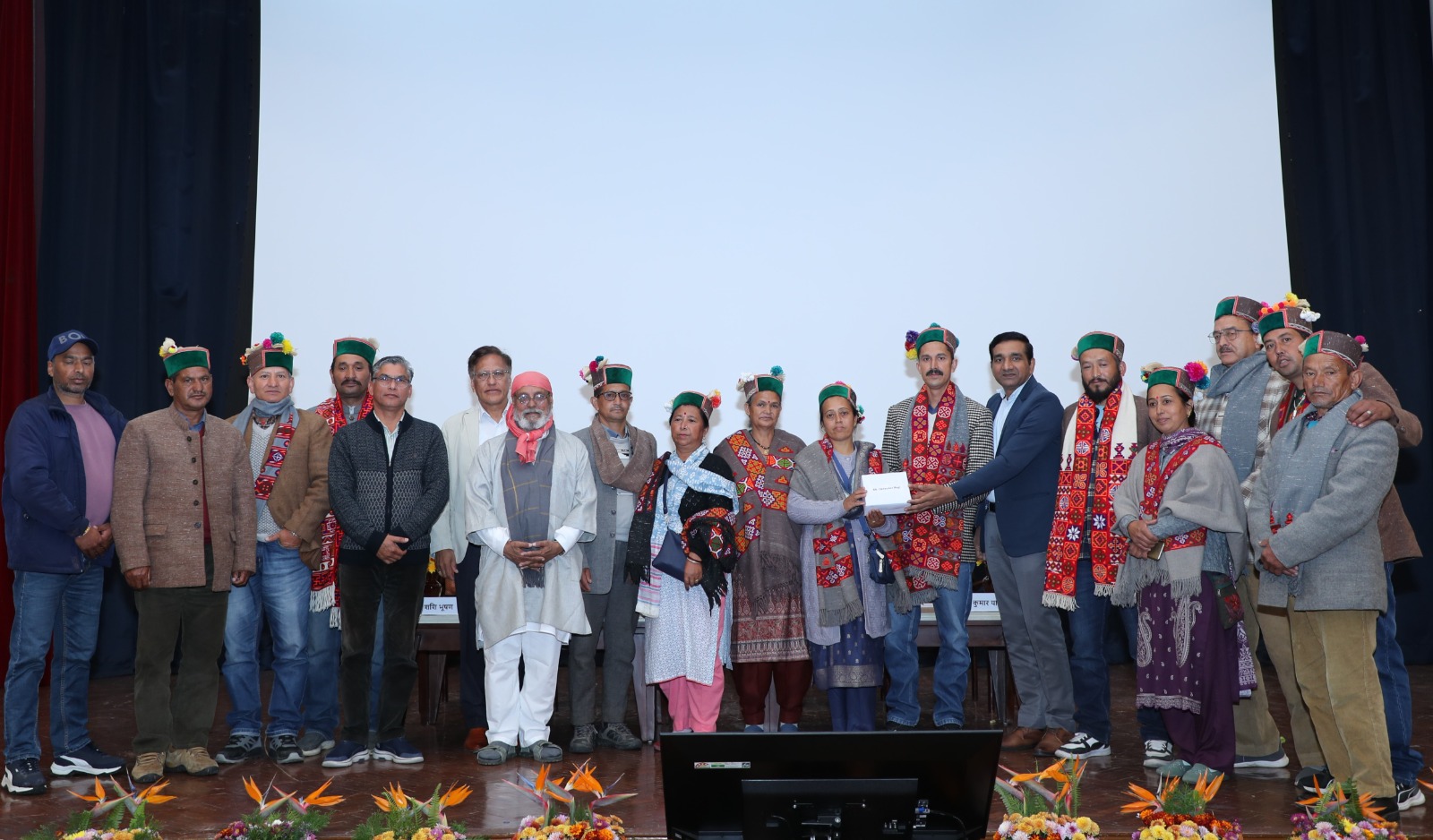
सी.एस.आई.आर.- हिमालय जैवसंपदा प्रौद्योगिकी संस्थान, पालमपुर (हि.प्र.) द्वारा भगवान बिरसा मुंडा की 150 वीं जयंती के उपलक्ष्य में आयोजित जनजातीय गौरव वर्ष (नवंबर 2024 – नवंबर 2025) का समापन समारोह दिनांक 14 नवम्बर, 2025 को संस्थान के एस.एस. भटनागर सभागार में आयोजित किया गया।
इस अवसर पर डॉ. अनिल प्रकाश जोशी, पद्म भूषण, संस्थापक, हेस्को, देहरादून मुख्य अतिथि के रूप में शामिल हुए उन्होने भगवान बिरसा मुंडा को नमन करते हुए पारंपरिक ज्ञान एवं उसके संरक्षण पर विशेष बल दिया। डॉ. जोशी ने पर्यावरण और बदलती जीवन शैली को विस्तारपूर्वक रेखांकित किया और एक समन्वय स्थापित करने के लिए सभी का आवाहन किया।
प्रो. चंद्र मोहन पर्शीरा, निदेशक जनजातीय अध्ययन संस्थान, हिमाचल प्रदेश विश्वविद्यालय, शिमला मुख्य वक्ता थे। डॉ पर्शीरा नें उच्च हिमालय जनजातीय क्षेत्रों में रहने वालों के जीवन पर प्रकाश डाला और विस्तार से उनकी जीवन शैली का परिचय दिया। प्रतिकूल परिस्थितियों में जीवन यापन, व्यवहरिक ज्ञान, और सामाजिक ताने बाने पर उनका विशेष जोर रहा।
इससे पहले सी.एस.आई.आर.-आई.एच.बी.टी के निदेशक डॉ. सुदेश कुमार यादव ने प्रतिभागियों का स्वागत करते हुए संस्थान द्वारा जनजातीय क्षेत्रों में किए जा कार्यों का ब्योरा प्रस्तुत किया और जनजातीय जीवन शैली से ज्ञान अर्जित करने पर ज़ोर दिया। इस अवसर पर लाहौल, किन्नौर एवं चंबा से आए प्रतिभागियों को पादप सामग्री भी वितरित की गई।
84th CSIR Foundation Day Celebrations
closeसीएसआईआर-आई एच बी टी में 84वें सी एसआईआर स्थापना दिवस समारोह का आयोजन
सी.एस.आई.आर.-हिमालय जैवसंपदा प्रौद्योगिकी संस्थान, पालमपुर ने 08 अक्टूबर 2025 को 84वां सी.एस.आई.आर स्थापना दिवस उत्साह के साथ मनाया।
कार्यक्रम के मुख्य अतिथि प्रो. आर.पी. तिवारी, माननीय कुलपति, केंद्रीय विश्वविद्यालय पंजाब, बठिंडा थे। उन्होंने सी.एस.आई.आर और संस्थान को इसकी गौरवशाली यात्रा के लिए बधाई दी। उन्होंने कहा कि सी.एस.आई.आर अपनी स्थापना से ही अनुसंधान और विकास में अग्रणी रहा है तथा विश्व को महत्वपूर्ण योगदान और नवाचार प्रदान कर रहा है।उन्होंने हिमालय को एक जीवित प्रयोगशाला बताया जो मानव कल्याण के लिए अति महत्वपूर्ण है। डॉ. तिवारी ने सभा को प्रकृति-अनुकूल जीवनशैली अपनाने और हिमालयी जैव संसाधनों के संरक्षण एवं प्रबंधन में अपनी भूमिका निभाने का आग्रह किया। उन्होंने संस्थान को उसके प्रयासों के लिए शुभकामनाएं दीं।
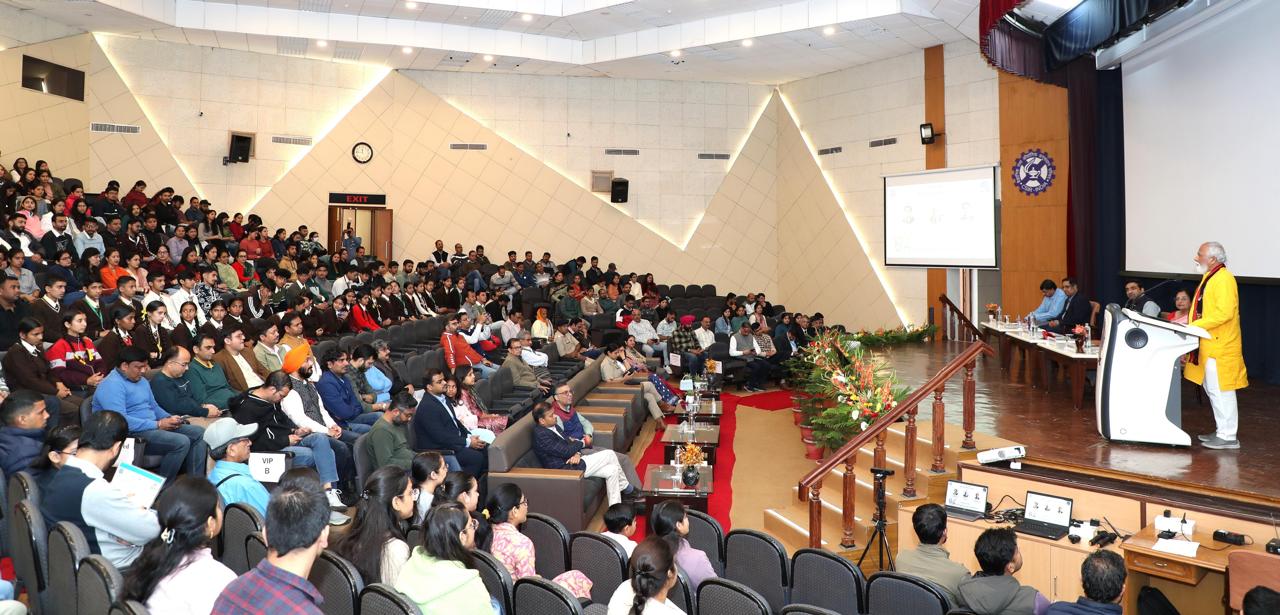
कार्यक्रम के विशिष्ट अतिथि डॉ. रविकृष्ण चेबोलू, प्रतिष्ठित वैज्ञानिक और प्रमुख, सी.एस.आई.आर -इनोवेशन कॉम्प्लेक्स, मुंबई थे। उन्होंने वैश्विक स्वास्थ्य प्रवृत्तियाँ और भारत की भूमिका विषय पर मुख्य संभाषण दिया। उन्होंने व्यक्तिगत स्वास्थ्य सेवा के उभरते स्वरूप और इस संदर्भ में कृत्रिम बुद्धिमत्ता की भूमिका पर बल दिया। डॉ. रविकृष्ण ने इस क्षेत्र में भारत की संभावनाओं को स्पष्ट रूप से रेखांकित किया और बताया कि भारत किस प्रकार वैश्विक कल्याण को बढ़ावा दे रहा है।
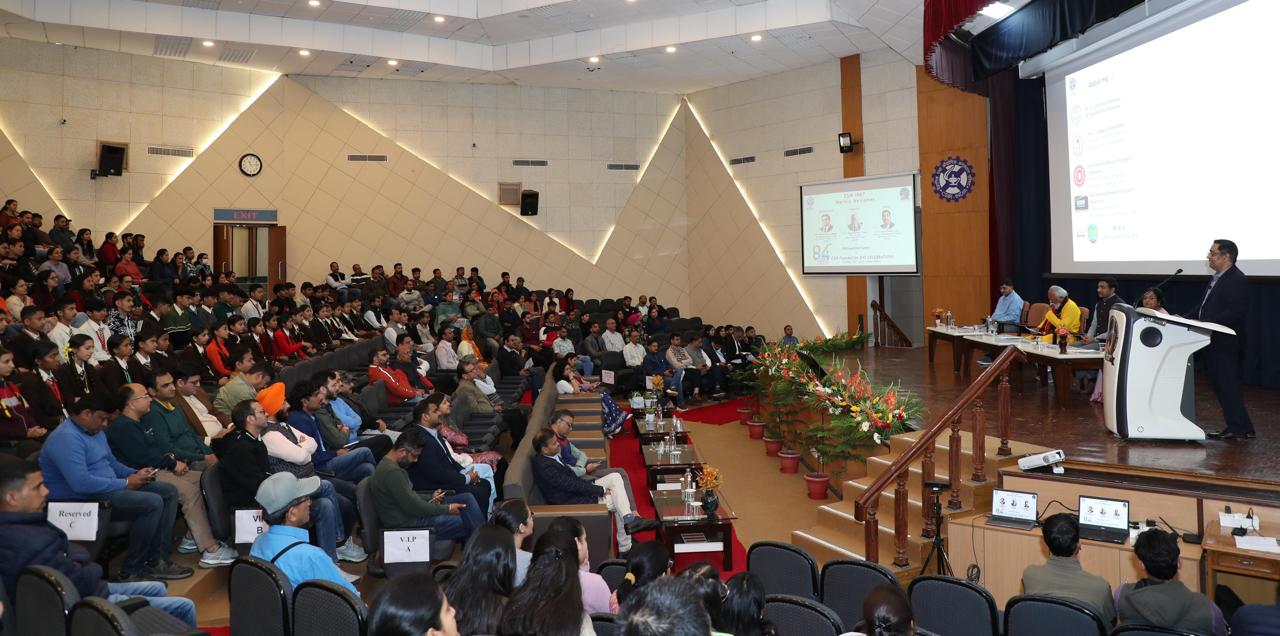
इससे पूर्व, सी.एस.आई.आर.-आई.एच.बी.टी के निदेशक डॉ. सुदेश कुमार यादव ने सभी अतिथियों का स्वागत करते हुए उन्हें सी.एस.आई.आर स्थापना दिवस की शुभकामनाएं दीं। उन्होंने राष्ट्र निर्माण और जनकल्याण में सी.एस.आई.आर की भूमिका तथा संस्थान की गतिविधियों पर प्रकाश डाला। उन्होंने पुष्पविज्ञान, सगंध , मिलेट, जैवसंपदा मिशन की जानकारी दी और बताया कि इनसे समाज को किस तरह से लाभ प्राप्त हुए हैं। अपने संबोधन में उन्होंने आगे बताया कि विज्ञान एवं प्रौद्योगिकी से देश को बहुत अधिक उम्मीद है। अतः हमारा दायित्व है कि राष्ट्र एवं विश्व की अपेक्षाओं को पूरा करने की दिशा में प्रयासरत रहें।
इस अवसर पर तीन प्रौद्योगिकी हस्तांतरण एवं दो उद्यमियों को शोध सहयोग के लिए समझौता ज्ञापनों पर हस्ताक्षर भी किए गए। स्वास्थ्य विभाग, राज्य सरकार, जिला ऊना के साथ इस अवसर पर टी.बी मुक्त भारत अभियान के तहत एक पोषण किट का भी विमोचन किया गया।
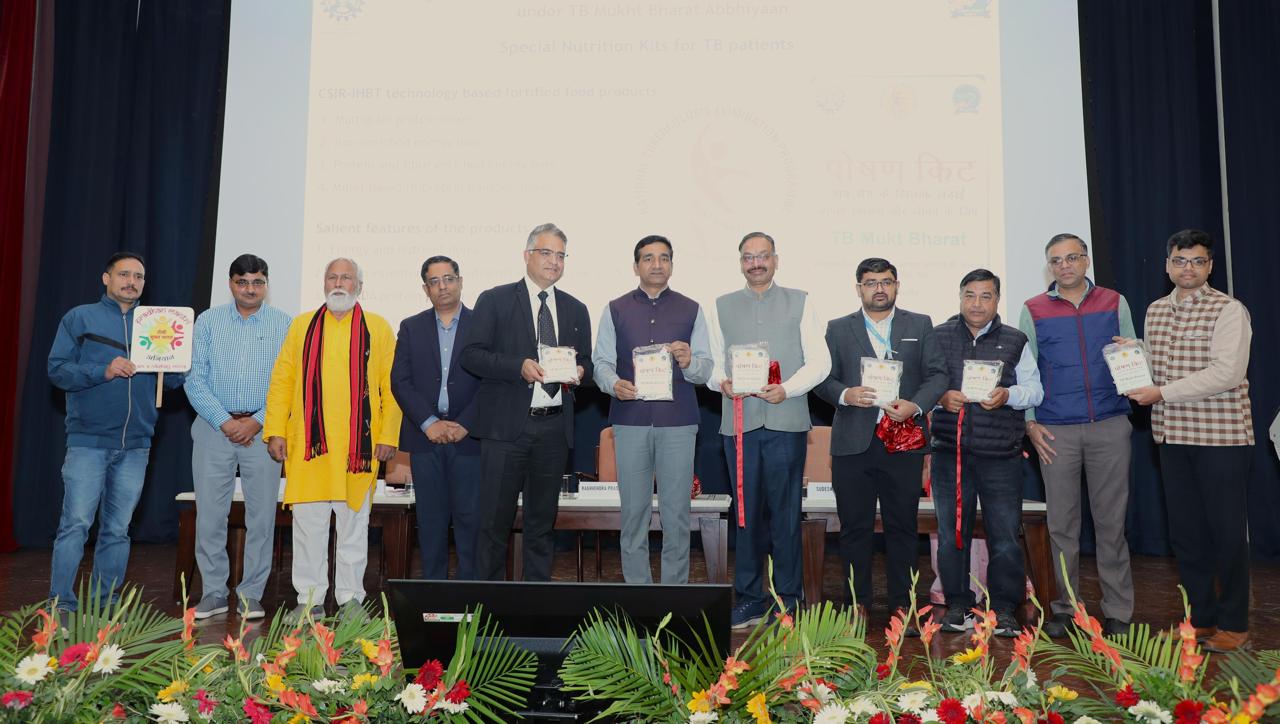
संस्थान से इस वर्ष सेवानिवृत्त हुए स्टाफ सदस्य श्री ब्रह्म दास और श्रीमती रुजला देवी को सम्मानित किया गया। कार्यक्रम में उन स्टाफ सदस्यों के बच्चों को भी सम्मानित किया गया जिन्होंने खेलों में उत्कृष्ट प्रदर्शन किया।
इस समारोह में संस्थान के स्टाफ, छात्र, अतिथि तथा अन्य गणमान्य व्यक्ति शामिल हुए। शहीद मेजर सुधीर कुमार वालिया राजकीय वरिष्ठ माध्यमिक विद्यालय, बनूरी, पालमपुर (जिला कांगड़ा, हिमाचल प्रदेश) के 38 छात्रों और 02 शिक्षकों ने सी.एस.आई.आर -जिज्ञासा कार्यक्रम के तहत समारोह में प्रतिभागिता की।
The CSIR-Institute of Himalayan Bioresource Technology, Palampur (HP) celebrated the 84th CSIR Foundation Day on 08 October 2025 with fervour and gaiety.
Prof. RP Tiwari, Hon’ble Vice Chancellor, Central University of Punjab, Bathinda, was the Chief Guest of the function. He complimented the CSIR and the institute on its glorious journey. He noted that CSIR, since its inception, has been the torchbearer of research and development and is providing critical inputs and breakthroughs to the nation and the global community. He exhorted the gathering to adopt a nature-friendly lifestyle and play a role in the conservation and management of Himalayan bioresources. He referred to Himalaya as the living laboratory that provides goods and services for human well-being. He wished the institute the very best in its endeavours.
Dr. Ravikrishna Chebolu, Distinguished Scientist and Head of the CSIR-Innovation Complex, Mumbai was the Guest of Honour. He delivered the keynote address on Global Trends in Healthcare and India’s Alignment. Dr. Ravikrishna lucidly expressed the opportunities and advantages that India has in this sector and how it can promote global good. He emphasized the emergence of personalized healthcare and the role of artificial intelligence in this context.
Prior to these Dr. Sudesh Kumar Yadav, Director CSIR-IHBT, welcomed all the guests and wished them on the occasion. He highlighted the role of CSIR and the activities of the institute towards nation-building. He detailed about the floriculture, aroma, millet, bioresource conservation and prospection mission and the benefits that they have brought to the society. He, further, said that the nation has great expectations from science and technology and we should rise to the call.
On the occasion, the institute signed three technology transfer agreements and two memorandum of understandings for collaboration and facility creation. A nutrition kit for TB patients under the TB Mukt Bharat Abhiyaan in association with the State Health Department district Una was also launched.
Staff members, Mr. Brahm Das and Smt. Rujala Devi, who had superannuated from the institute during the current year, were felicitated. The function also saw felicitation of wards of the staff member who had excelled in sports.
The celebrations were attended by the staff, students, guests and other dignitaries from the nearby organizations. 38 students and 02 teachers from Shaheed Major Sudhir Kumar Walia Government Senior Secondary School, Banuri, Palampur (Distt. Kangra, H.P.), attended the programme and visited the institute on the day under CSIR-Jigyasa Programme.
संस्थान में 9 से 23 सितम्बर, 2025 तक हिंदी पखवाड़ा का आयोजन
closeसंस्थान में 9 से 23 सितम्बर, 2025 तक हिंदी पखवाड़ा का आयोजन
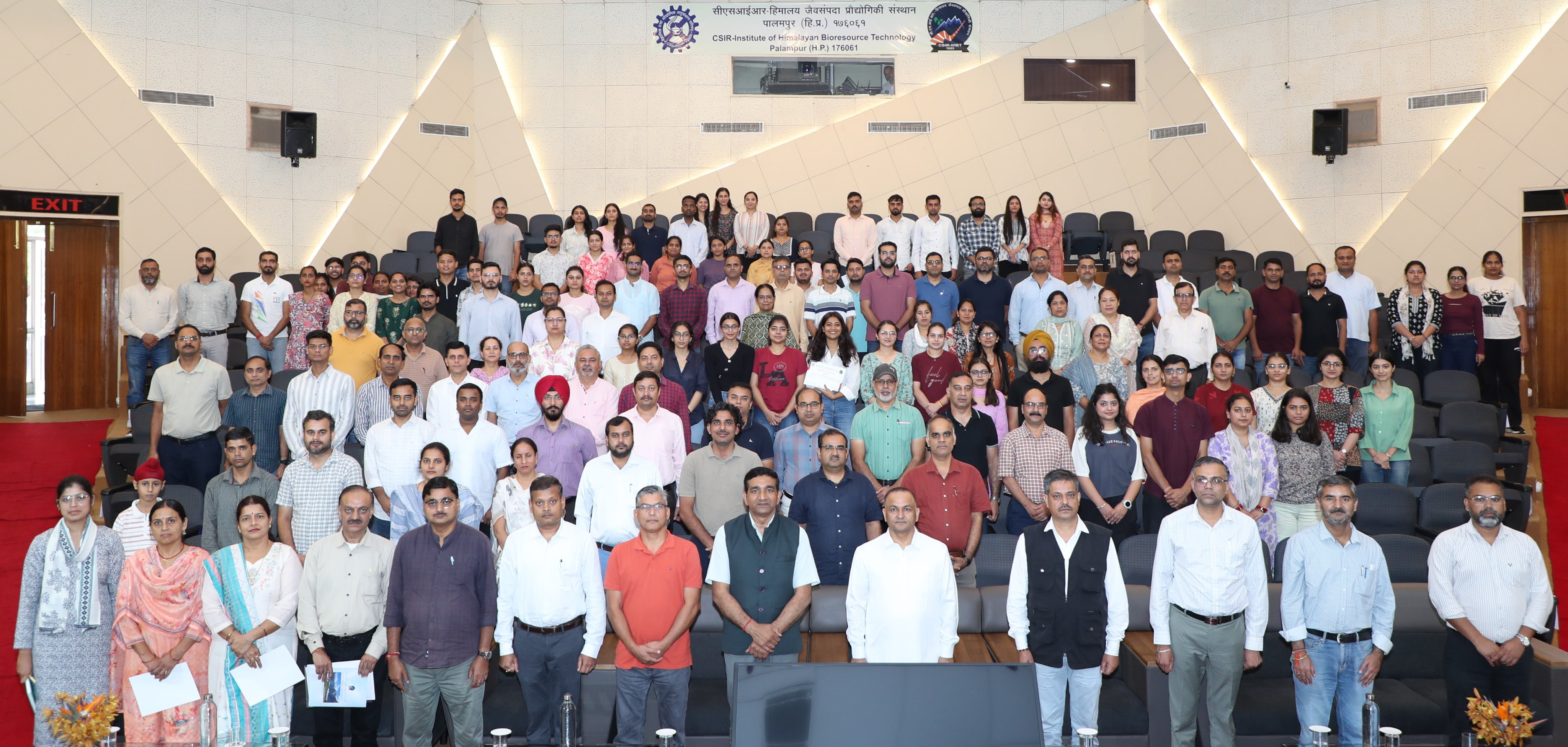
सी.एस.आई.आर - हिमालय जैव संपदा प्रौद्योगिकी संस्थान में 9 से 23 सितम्बर, 2025 तक हिंदी पखवाड़ा का आयोजन किया गया। 23 सितम्बर 2025 को हिंदी दिवस के मुख्य समारोह का आयोजन किया गया। इस अवसर पर जवाहरलाल नेहरू विश्वविद्यालय, नई दिल्ली के प्रोफेसर डा. कृष्ण मोहन पाण्डेय ने वेदों में विज्ञान विषय पर एक संभाषण दिया । अपने संबोधन में उन्होंने वेदों में वर्णित अनेकों औषधियों के उपयोग के बारे में बहुत ही रोचक तथ्य प्रस्तुत किए।
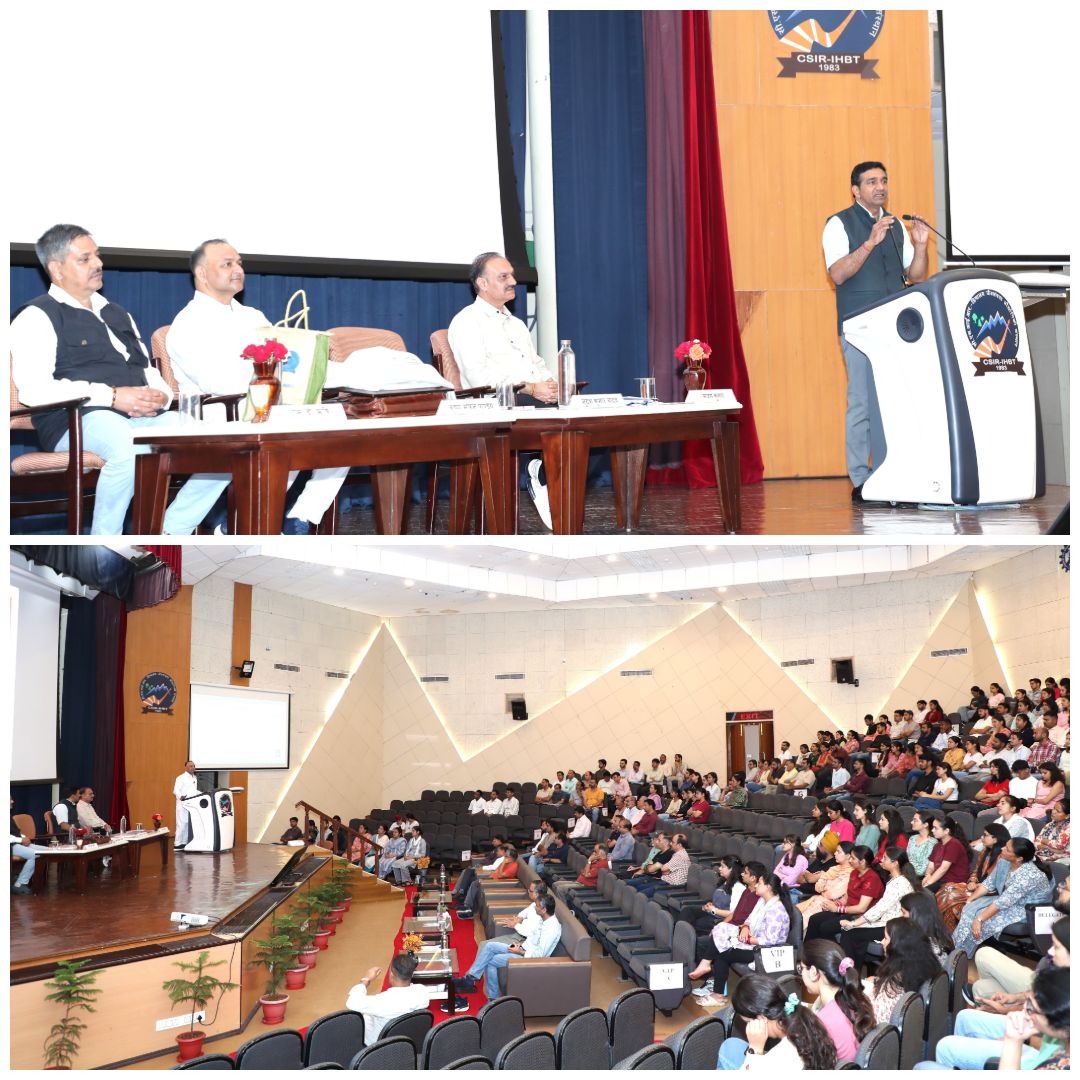
संस्थान के निदेशक डा. सुदेश कुमार यादव ने अपने संबोधन में कहा कि आज का विषय बहुत ही प्रासंगिक है। आवश्यकता है कि विज्ञान के क्षेत्र में हो रहे अनुसंधान, उपलब्धियां जन-जन तक पहुँचें, क्योंकि यदि ये उपलब्धियां आम लोगों तक नहीं पहुँचेंगी, तो ऐसे अनुसंधान की क्या सार्थकता? राष्ट्रीय स्तर पर राजभाषा हिन्दी ही एक ऐसी भाषा है जिसके माध्यम से वैज्ञानिक उपलब्धियों को जन-जन तक पहुँचाने का कार्य सफलतापूर्वक किया जा सकता है। उन्होंने वैज्ञानिकों से आह्वान किया कि वे अपने शोध को जन साधारण तक पहुंचाने की दिशा में प्रयास करें। हिंदी माध्यम से तैयार करके संस्थान के एक वार्षिक प्रकाशन हिमसंपदा वैज्ञानिकी के माध्यम से भी अपने शोध को आगे बढ़ाए। उन्होंने हिंदी पखवाड़ा के अंतर्गत आयोजित की जाने वाली प्रतियोगिताओं के विजेताओं को अपनी शुभकामनाएं दीं तथा सभी कर्मियों से आह्वान किया कि इनसे प्रेरणा लेते हुए आने वाले समय में इन आयोजनों में अपनी सक्रिय प्रतिभागिता सुनिश्चित करें।
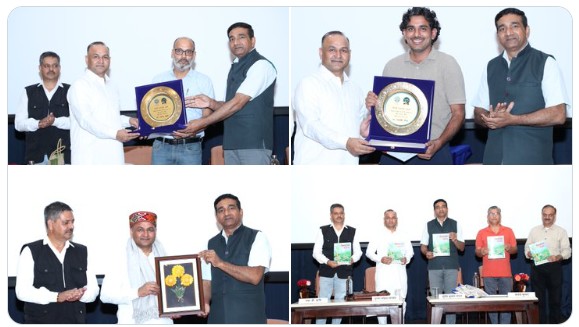
इस अवसर पर संस्थान की पत्रिका हिमसंपदा वैज्ञानिकी का विमोचन भी किया गया। विभिन्न प्रतियोगिताओं के विजेताओं को पुरस्कृत भी किया गया।
उल्लेखनीय हे कि हिंदी पखवाड़े के अन्तर्गत दिनांक 09.09.2025 भाषान्तर एवं टिप्पण लेखन, 10.09.2025 को लोकप्रिय विज्ञान लेखन, 16.09.2025 को हिंदी भाषण प्रतियोगिता ( रिसर्च स्कॉलर के लिए) तथा 19.09.2025 को हिंदी कार्यशाला का आयोजन किया गया।
National symposium on sustainable development and conservation of Himalayan bioresources through a multidisciplinary approach
“ ...
National symposium on sustainable development and conservation of Himalayan bioresources through a multidisciplinary approach
closeहिमालयी जैवसंसाधनों के सतत विकास और संरक्षण हेतु बहु-विषयक दृष्टिकोण पर राष्ट्रीय संगोष्ठी
National Symposium on Sustainable Development and Conservation of Himalayan Bioresources through a Multidisciplinary Approach
सी.एस.आई.आर - हिमालय जैवसंपदा प्रौद्योगिकी संस्थान, पालमपुर, हिमाचल प्रदेश में आयोजित दो दिवसीय, हिमालयी जैवसंसाधनों के सतत विकास और संरक्षण हेतु बहु-विषयक दृष्टिकोण पर राष्ट्रीय संगोष्ठी 3 सितंबर 2025 सम्पन्न हुई। यह छात्र-प्रेरित पहल डॉ. सर्वपल्ली राधाकृष्णन की जयंती के उपलक्ष्य में आयोजित की गई थी, जिसमें देशभर से 100 से अधिक प्रतिभागियों ने भाग लिया।
अपने उद्घाटन संबोधन में सी.एस.आई.आर-आई.एच.बी.टी के निदेशक डॉ. सुदेश कुमार यादव ने अतिथियों और प्रतिभागियों का स्वागत करते हुए संस्थान की नवीनतम गतिविधियों के बारे में जानकारी दी और जैव संसाधनों के संरक्षण और जैव आर्थिकी में उसके योगदान पर प्रकाश डाला।
डॉ. राकेश सहगल, एन.आई.टी , हमीरपुर (हिमाचल प्रदेश), ने इस आयोजन तथा संस्थान द्वारा किए जा रहे कार्यों की सराहना की। उन्होने विचार प्रकट करते हुए कहा की वैज्ञानिक दृष्टिकोण एवं परस्पर सहयोग आज की आवश्यकता हैं जिन पर हमे और अधिक ध्यान देना होगा। जवाहरलाल नेहरू विश्वविद्यालय, नई दिल्ली से आए डॉ. पी.के. जोशी ने जैव संसाधनों की मैपिंग और विश्लेषण के लिए सेंसर-आधारित इमेजिंग तकनीकों पर विचार प्रस्तुत किये।
तदोपरांत विशेषज्ञों और छात्रों द्वारा चार सत्रों में प्रस्तुतियाँ दी गईं। पहले सत्र में आई.आई.एफ.एम भोपाल के डॉ. सी.पी. काला ने अल्पाइन चारागाहों और उनके पारिस्थितिकी तंत्र की भूमिका पर मुख्य व्याख्यान दिया।
दूसरे सत्र में एच.ए.पी.पी.आर.सी, उत्तराखंड के डॉ. वी.के. पुरोहित ने उच्च हिमालयी औषधीय पौधों और उनके महत्व पर प्रकाश डाला। महाराष्ट्र की राइज एंड शाइन बायोटेक प्राइवेट लिमिटेड के श्री ललित अवहद ने जीव विज्ञान में जैव प्रौद्योगिकी के अनुप्रयोगों पर चर्चा की।
तीसरे सत्र में नई दिल्ली जे.एन.यू से आए डॉ. पी.के. वर्मा ने पादप कोशिका और आणविक विज्ञान पर विशेषज्ञ वक्तव्य प्रस्तुत किया। वहीं डॉ. मोहर सिंह, एन.बी.पी.जी.आर, शिमला ने भविष्य के विकास के लिए आनुवंशिक संसाधनों के महत्व को रेखांकित किया।
चौथे सत्र में डॉ. पी.एस. पनेसर, एस.एल.आई.ई.टी, पंजाब ने खाद्य क्षेत्र और इस दिशा में हो रहे अनुसंधानओं पर विचार साझा किए। डॉ. एस. जाचक, एन.आई.पी.ई.आर, पंजाब ने ऑनलाइन माध्यम से सभा को संबोधित किया और फाइटोफार्मास्युटिकल्स तथा प्राकृतिक उत्पादों पर प्रकाश डाला।
इसके अतिरिक्त, छात्रों द्वारा कुल 15 मौखिक एवं 57 पोस्टर प्रस्तुतियाँ दी गईं। इस अवसर पर संस्थान द्वारा हस्तांतरित तकनीकों पर आधारित उत्पादों की एक प्रदर्शनी भी आयोजित की गई तथा मूल्यवर्धित खाद्य उत्पादों के क्षेत्र में दो प्रौद्योगिकी हस्तांतरण समझौतों पर हस्ताक्षर किए गए। एक ताश्विका इंडिया, नई दिल्ली के साथ और दूसरा महालक्ष्मी माल्ट प्रोडक्टस, हरियाणा के साथ। संगोष्ठी के दौरान आयोजित विभिन्न प्रतियोगिताओं जैसे फोटोग्राफी, वीडियोग्राफी, प्रस्तुतियाँ, पोस्टर और मीम्स के विजेताओं को भी सम्मानित किया गया।
The two-day “National symposium on sustainable development and conservation of Himalayan bioresources through a multidisciplinary approach" organized by the CSIR-Institute of Himalayan Bioresource Technology, Palampur, Himachal Pradesh, concluded on September 3, 2025. This student-driven initiative to commemorate the birth anniversary of Dr. Sarvepalli Radhakrishnan drew participation from more than 100 participants across the nation.
In his inaugural address, Dr. Sudesh Kumar Yadav, Director CSIR-IHBT warmly welcomed the guests and participants, and apprised them about the recent activities of the institute and how it is helping in the conservation, value addition, and bioprospection of resources for generating bio-economy. Dr. Rakesh Sehgal, National Institute of Technology, Hamirpur (HP), lauded the institute for hosting this wonderful event and opined that problem-solving collaborative efforts with a focus on the future are the need of the hour. Dr. PK Joshi, Jawaharlal Nehru University, New Delhi, deliberated on the use of sensor-based imaging technologies in mapping resources and conducting temporal analysis.
Subsequently, presentations were made by the experts and students in four sessions. In the first session, Dr. CP Kala, Indian Institute of Forest Management, Bhopal, delivered the lead lecture on alpine meadows and the role of grazing in shaping their ecology. The second session had an address by Dr. VK Purohit, High Altitude Plant Physiology Research Centre, Uttarakhand, who focussed on high altitude medicinal plants and their importance. Mr. Lalit Avhad from Rise N Shine Biotech Pvt Ltd., Maharashtra dwelled on the biotechnological applications in the plant sciences.
The same was followed by session 3 that had expert talks by Dr. PK Verma, Jawaharlal Nehru University, New Delhi, who deliberated upon the cell and molecular biology of plant resources for their conservation. Dr. Mohar Singh, National Bureau of Plant Genetic Resources, Shimla, highlighted the importance of genetic resources for future development.
Session 4 had expert talks by Dr. PS Panesar, Sant Longowal Institute of Engineering and Technology, Punjab who reflected upon the food and recent research in this direction. Dr. S Jachak, National Institute of Pharmaceutical Education & Research, Panjab addressed the gathering online and spoke on phytopharamaceuticals and natural products.
Additionally, a total of 15 oral and 57 poster presentations were made by the students.
On the occasion, the institute signed two technology transfer agreements, one with Tashvika India Pvt. Ltd, New Delhi and other with Mahalaxmi Malt Products Pvt. Ltd, Haryana in the field of value added food products. An exhibition of products based on the technologies transferred by the institute was also organized. Also, the winners of various competitions, such as photography, videography, presentations, posters, and memes organized as part of the symposium, were felicitated.
43rd CSIR-IHBT Foundation Day Celebrations
closeसीएसआईआर-आईएचबीटी, पालमपुर का 43वां स्थापना दिवस समारोह
43rd Foundation Day Celebrations of CSIR-IHBT
सी.एस.आई.आर.-हिमालय जैवसंपदा प्रौद्योगिकी संस्थान, पालमपुर ने 2 जुलाई 2025 को उत्साह और उल्लास के साथ अपना 43वां स्थापना दिवस मनाया।
समारोह के मुख्य अतिथि डा. वीपी पॉल, माननीय सदस्य, नीति आयोग, भारत सरकार ने अपने संबोधन में सीएसआईआर-आईएचबीटी के स्थापना दिवस की शुभकामनाएं देते हुए संस्थान की उपलब्धियों की सराहना की।डॉ. पॉल कहा कि विकसित भारत 2047 का सपना विज्ञान और प्रौद्योगिकी के माध्यम से ही संभव है। उन्होंने महिला स्वास्थ्य व कुपोषण के मुद्दों पर भी चर्चा की और कहा कि आत्मनिर्भर भारत के निर्माण के लिए सभी को एक साथ चलना होगा।
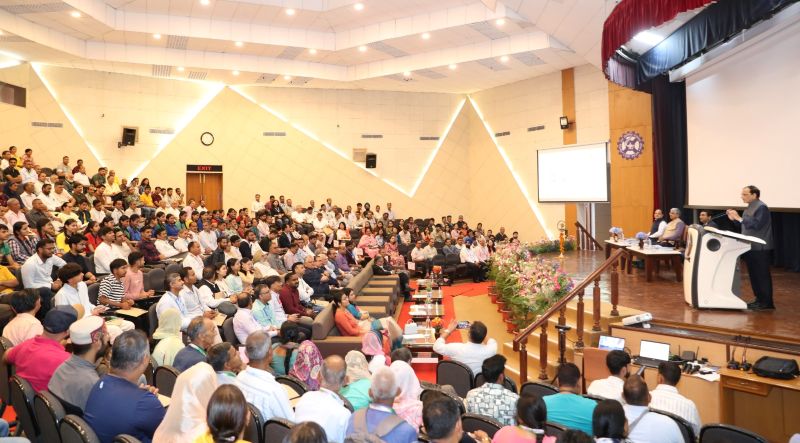
डॉ. टी.आर. शर्मा, राष्ट्रीय प्रोफेसर और पूर्व उप-महानिदेशक, भाकृअनुप, ने स्थापना दिवस व्याख्यान दिया। उन्होंने चावल की “ब्लास्ट” रोग प्रतिरोधक किस्मों के प्रजनन की सामाजिक, खाद्य सुरक्षा, पारिस्थितिकी और आर्थिक दृष्टि से महत्ता को रेखांकित किया। डॉ. महेश कुमार दधीच, सी.ई.ओ, एन.एम.पी.बी ने ऑनलाइन संबोधित करते हुए हिमालय में औषधीय पादपों की विविधता, हर्बल क्षेत्र की भूमिका तथा दुर्लभ व संकटग्रस्त पादपों के संरक्षण एवं प्रबंधन की आवश्यकता पर बल दिया। आई.आई.एस. ई.आर. मोहाली के निदेशक डॉ. ए.के. त्रिपाठी, जो कि प्रोग्राम के विशिष्ट अतिथि थे, ने कहा कि विज्ञान ने सामाजिक विकास में विशेष भूमिका निभाई है। उन्होंने सी.एस.आई.आर अरोमा मिशन के द्वारा सामाजिक सशक्तिकरण पर प्रकाश डाला।
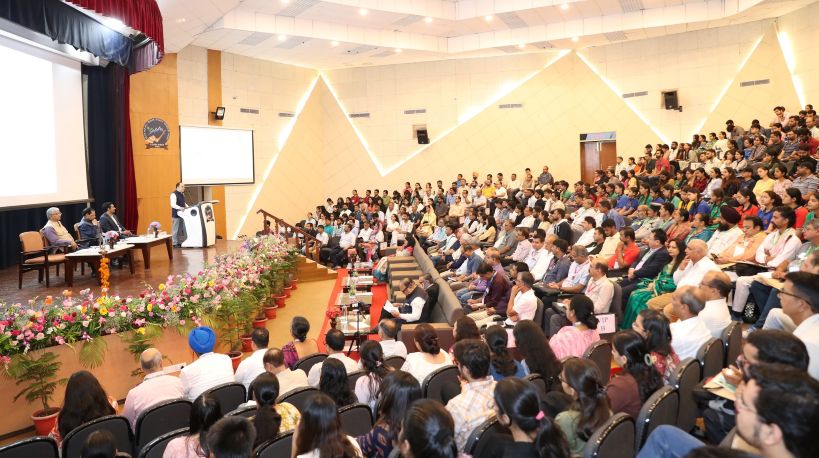
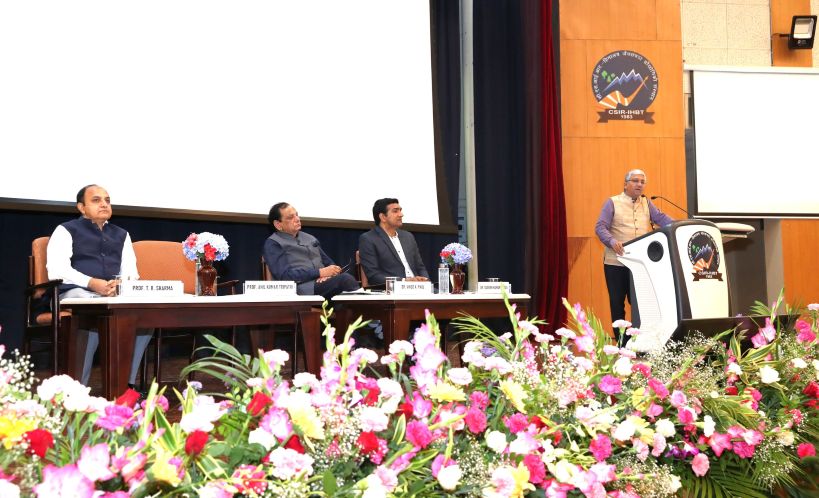
इससे पहले सी.एस.आई.आर.-आई.एच.बी.टी के निदेशक डा. सुदेश कुमार यादव ने अतिथियों का स्वागत करते हुए संस्थान की गतिविधियों पर प्रकाश डाला। उन्होंने फ्लोरीकल्चर, अरोमा और मिलेट मिशन जैसी पहलों और उनके सामाजिक अनुकूल प्रभावों की जानकारी दी। उन्होने जैवआर्थिकी को बढावा देने में संस्थान का सामर्थ्य तथा नए अवसरों के बारे में विस्तार से बताया।
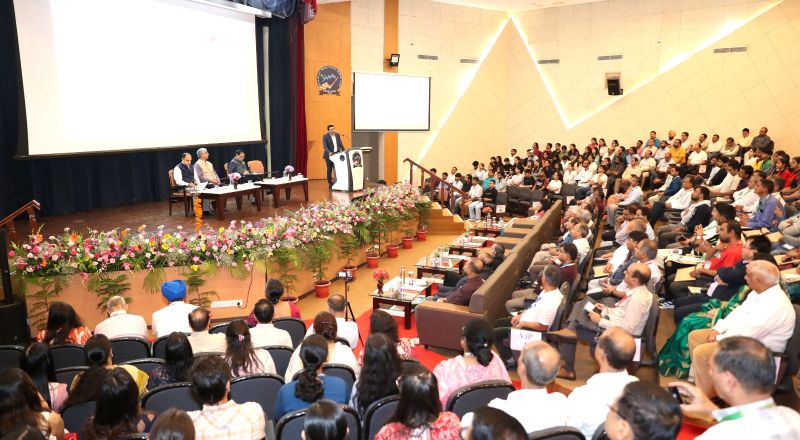
इस अवसर पर संस्थान ने त्रिपुरा विश्वविद्यालय, त्रिपुरा और भारतीय चिकित्सा एवं होम्योपैथी फार्माकोपिया आयोग, गाज़ियाबाद के साथ समझौता ज्ञापनों पर हस्ताक्षर किए। साथ ही सूरज श्री केमिकल्स लिमिटेड, नई दिल्ली; हिमालय एपियरीज, ऊना; एच.पी. फाइटोपल्स, पालमपुर; एवं प्लांट हब बायोटेक प्रा. लि., सोलन (हि.प्र.) के साथ तकनीकी हस्तांतरण समझौतों पर भी हस्ताक्षर हुए। साथ ही संस्थान द्वारा आयोजित दो दिवसीय "हर्बल स्टेकहोल्डर मीट" का उद्घाटन हुआ, जिसमें तीन सत्र और विशेषज्ञों के व्याख्यान शामिल हैं। हर्बल स्टेकहोल्डर मीट की स्मारिका का भी इस अवसर पर विमोचन हुआ।
समारोह में सी.एस.आई.आर-आई.एच.बी.टी “वार्षिक रिपोर्ट-2024-25”;“इकनॉमिक इम्पैक्ट ऑफ सी.एस.आई.आर.-आई.एच.बी.टी टेक्नोलोजीस”; “पोटेनसिएल क्रॉप फॉर हर्बल सैक्टर”; एवं लो चिलिंग एपल वैराइटीज” पर पुस्तक व ब्रॉशर का विमोचन किया गया। सी.एस.आई.आर मिशन “जैव सम्पदा, संरक्षण और संभावनाएं” पर एक वीडियो और ब्रॉशर भी विमोचित किए गए ।
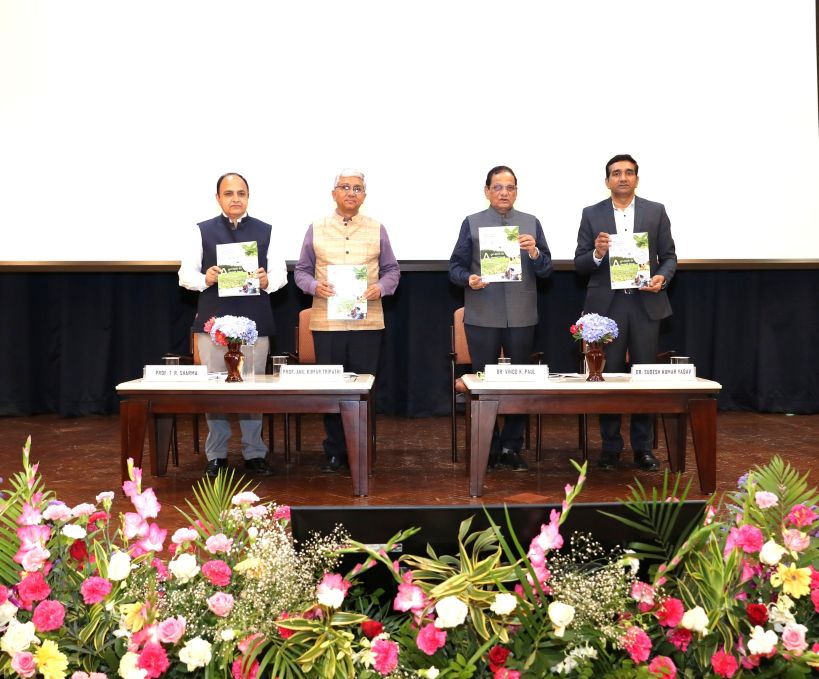
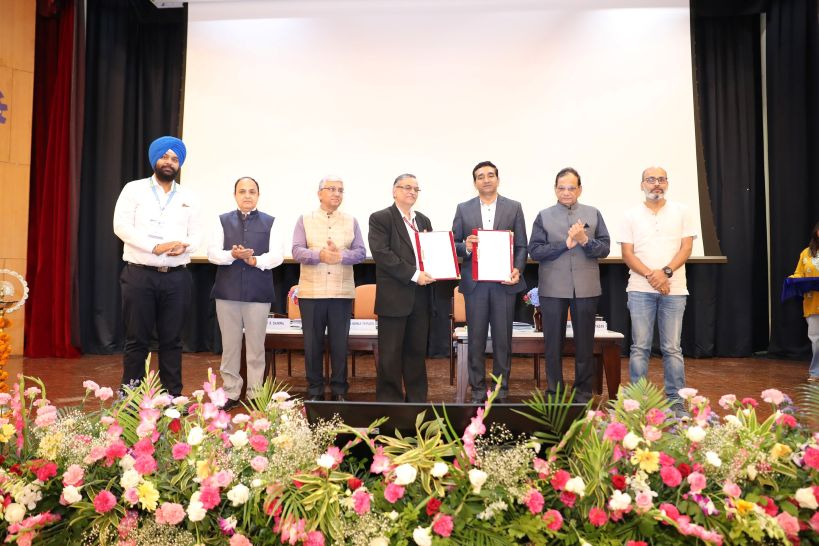
कार्यक्रम में “मोंक फ्रूट के जर्मप्लाज्म रिसोर्स सेंटर और गुलाब के प्रदर्शन प्लॉट्स का उद्घाटन भी किया गया ।स्थापना दिवस समारोह में किसान, शिक्षाविद, उद्योगपति, वैज्ञानिक, छात्र और अन्य गणमान्य व्यक्ति शामिल हुए।
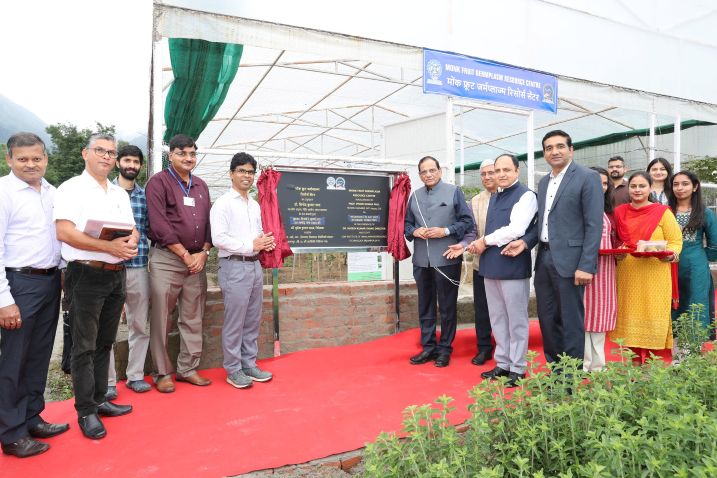
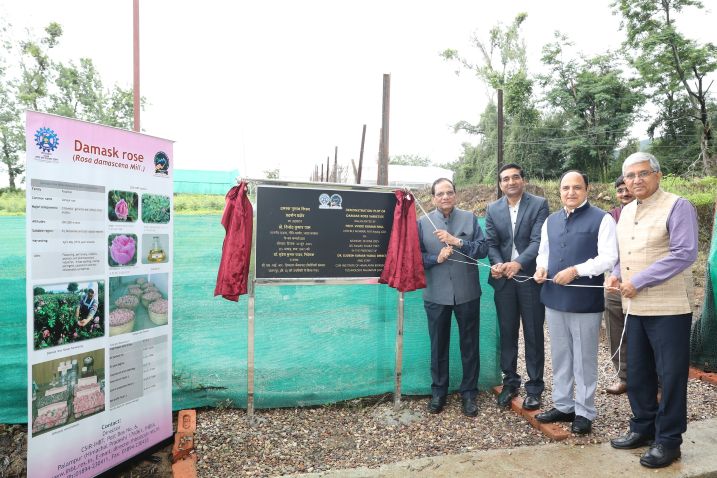
The CSIR-Institute of Himalayan Bioresource Technology, Palampur (HP) celebrated its 43rd foundation day on 2 July 2025 with fervor and gaiety.
Dr. VK Paul, Hon’ble Member NITI Aayog, Government of India was the Chief Guest of the function. He complimented the institute on its glorious journey and presented his views on the importance of bioresources and livelihood. He noted that they have the potential to revolutionize socio-economy and emphasized about the NITI Aayog’s initiatives and their implications especially in the Himalaya. Women health and malnutrition were also discussed by him.
Dr. Paul stated that Science & Technology is a key pillar to Viksit Bharat and exhorted the gathering to rise to the occasion in making India a global leader. He wished the institute the very best in its endevours.
Dr. TR Sharma, National Professor and Former DDG ICAR delivered the foundation day lecture. He emphasized the natural wealth of Himalaya and shared his insights on rice breeding towards blast resistance and its implications for society, food security, ecology and economy.
Dr. Mahesh Kumar Dadhich, CEO NMPB delivered the keynote address online wherein he stressed upon the diversity of medicinal plants in the Himalaya and the role of NMPB. Promotion, conservation and management of rare and threatened plants was emphasized by him.
Dr. AK Tripathi, Director IISER Mohali who was the guest of honour stated that science has played a major role in shaping civilization and forms the basis of societal growth. He highlighted the role of CSIR Aroma mission in local empowerment and establishing science- society connect.
Prior to these Dr. Sudesh Kumar Yadav, Director CSIR-IHBT welcomed all the guests and wished them on the occasion. He presented the activities of the institute and how it is boosting bioeconomy, particularly in the Himalayan region. He detailed about the floriculture, aroma and millet mission and the benefits that have flown to the society.
On the occasion, the institute signed two Memorandum of Understanding, one with Tripura University, Tripura and the other with Pharmacopoeia Commission for Indian Medicine and Homoeopathy, Ghaziabad. Also, Technology Transfer agreements were signed with Suraj Shree Chemicals Ltd, New Delhi; Himalaya Apiaries, Una; and H.P. Phytopulse, Palampur. An agreement with Plant Hub Biotech Pvt. Ltd., Solan (H.P.) was also signed.
The program saw release of the CSIR-IHBT Annual Report 2024-25; books on Economic impact analysis of CSIR-IHBT Technologies, Potential crops for herbal sector; and a brochure on low chilling varieties of apples. A video and a brochure on the newly implemented CSIR Mission on “Bioresource Conservation and Prospection” were also launched.
The program also witnessed the inauguration of the two-day Herbal Stakeholder Meet being organized by the institute and the release of its souvenir. The meet has three sessions and address by experts.
Also, monk fruit germplasm resource center and rose demonstration plots were inaugurated as a part of the foundation day celebrations. The celebrations were attended by the Farmers, Academicians, Industrialists, Scientists, Students and others.
Visit of Hon'ble Union Minister of Textiles, GOI to CSIR-IHBT
closeVisit of Hon'ble Union Minister of Textiles, GOI to CSIR-IHBT
Shri Giriraj Singh, Hon’ble Union Minister of Textiles, Govt. of India, visited CSIR-IHBT on 24/05/2025. He was welcomed by the Director, Dr. Sudesh Kumar Yadav, and the staff of the institute. The Director apprised the Hon’ble Minister about the work being carried out at the institute that is improving the livelihoods of rural people and contributing to the vision of Viksit Bharat. The Director particularly mentioned the CSIR Aroma, Floriculture, and Phytopharmaceutical missions and their implications in bringing human growth and well-being. .

Director, NIFT Kangra, Dr. Rahul Chandra, was also present during the programme. He spoke about creativity and design thinking in the changing times.
The Hon’ble Minister lauded the efforts of CSIR-IHBT and its contribution towards boosting the bioeconomy of the region. He was happy to note that the outputs of science being conducted in the institute are reaching society. He emphasized the need for environment and user-friendly technologies that are easily accessible and operable. He wished the institute the very best in its endeavours.
Prior to this, Shri Giriraj Singh ji planted a tree sapling as a part of “Ek Ped Maa Ke Naam” initiative and visited various facilities of the institute. He also inaugurated the Biochar and Compost Booster production unit in the institute.

On the occasion, the institute signed a technology transfer agreement with Komal Innovation and Wellness Initiatives, Nagrota Bagwan, Kangra (HP). Also, a memorandum of understanding for collaborative research on fibre and natural colours was signed with NIFT Kangra (HP). An agreement with Vijya Wellness and Biosciences LLP, Dera Mandi, New Delhi, on advanced technical textile solutions was also signed. As a part of the programme, the Hon’ble Minister launched beverages and food products prepared by startups, and distributed planting material of aromatic marigold and chrysanthemum to farmer clusters.

National Technology Day Celebrations
closeसीएसआईआर-आईएचबीटी, पालमपुर में राष्ट्रीय प्रौद्योगिकी दिवस समारोह का आयोजन
National Technology Day Celebrations
सी.एस.आई.आर.-हिमालय जैवसंपदा प्रौद्योगिकी संस्थान, पालमपुर में राष्ट्रीय प्रौद्योगिकी दिवस 15 मई 2024 को मनाया गया। इस वर्ष की प्रौद्योगिकी दिवस थीम " यंत्रा —युगांतर फॉर एडवांसिंग न्यू टेक्नोलॉजी, रिसर्च, एंड एक्सेलेरेशन" थी, जो वैश्विक स्तर पर आत्मनिर्भर तकनीकी नवाचार के प्रति राष्ट्र की प्रतिबद्धता को दर्शाती है।
संस्थान के निदेशक, डॉ. सुदेश कुमार यादव ने उपस्थित जन का स्वागत करते हुए प्रौद्योगिकी दिवस की शुभकामनाएं दी। अपने संबोधन में, उन्होंने समाज पर प्रौद्योगिकी के परिवर्तनकारी प्रभाव और ज्ञान को आगे बढ़ाने तथा आर्थिक वृद्धि को बढ़ावा देने में सी.एस.आई.आर-आई.एच.बी.टी की भूमिका पर प्रकाश डाला। उन्होंने सी.एस.आई.आर अरोमा, फ्लॉरिकल्चर एवं फाइटोफार्मास्युटिकल मिशन के अंतर्गत संस्थान के योगदान को उजागर किया, जिससे किसानों को आधुनिक खेती और प्रसंस्करण तकनीकों में सशक्त किया गया है।
समारोह के मुख्य अतिथि श्रीमती सुचित सिंह, प्रमुख नेटर्क इनोवेशन, विजया वेलनेस एंड बायोसाइंसेज एलएलपी,नई दिल्ली ने "मॉलिक्यूल टू मार्केट: आधुनिक चिकित्सीय अनुप्रयोगों में प्राकृतिक रूप से प्राप्त बायोएक्टिव्स का उपयोग" विषय पर संभाषण दिया। उन्होंने औषधीय प्रयोगों के लिए प्राकृतिक संसाधनों के महत्व को रेखांकित किया और आधुनिक विज्ञान एवं उत्पाद विकास में आर्टिफिशियल इंटेलिजेंस की भूमिका पर प्रकाश डाला।
समारोह के दौरान, व्योम बायोटेक प्रा. लि., इंदौर; धर्मा किसान विकास समिति, चंबा; और शशांक एग्रो टेक प्रा. लि., झारखंड के साथ प्रौद्योगिकी हस्तांतरण पर समझौते किए गए। इसके अलावा, संस्थान ने विजया वेलनेस एंड बायोसाइंसेज एल.एल.पी, नई दिल्ली; और बॉक्स एंड पॉट्स प्रा. लि., कांगड़ा के साथ समझौता ज्ञापन पर हस्ताक्षर किए, ताकि प्रौद्योगिकी-आधारित समाधान विकसित करने के लिए सहयोग को बढ़ावा दिया जा सके। इस अवसर पर किन्नौर क्षेत्र के किसानों को हींग के पौधों का वितरण भी किया गया।
इस कार्यक्रम में क्षेत्र के गणमान्य व्यक्तियों; संस्थान के पूर्व वैज्ञानिकों, वर्तमान में कार्य कर रहे कर्मचारियों एवं छात्रों; उद्योग विशेषज्ञों और मीडिया प्रतिनिधियों ने समारोह की शोभा बढ़ाई।
The CSIR-Institute of Himalayan Bioresource Technology (CSIR-IHBT), Palampur (HP) marked the celebration of National Technology Day with a special event emphasizing India’s technological advancements and self-reliance on 15th May 2025. The theme for this year, YANTRA—Yugantar for Advancing New Technology, Research, and Acceleration—highlighted the nation’s commitment to self-reliant technological innovation on global scale.
Dr. Sudesh Kumar Yadav, Director CSIR-IHBT, extended a warm welcome to the dignitaries and attendees. In his address, he spoke about the transformative impact of technology on society and the role of CSIR-IHBT in advancing knowledge and fostering growth. He emphasized the institute’s contribution under the Aroma, Floriculture, and Phytopharmaceutical Missions, which have empowered farmers by introducing modern cultivation and processing techniques.
The Chief Guest, Ms. Suchita Singh, Vijya Wellness and Biosciences LLP, New Delhi, delivered a talk on “Molecule to Market: Harnessing the Power of Nature-Derived Bioactives in Modern Therapeutics.” She highlighted the importance of harnessing bioactive compounds from natural sources for medicinal applications and the use of artificial intelligence in novel discoveries.
During the programme, technology transfer agreements were signed with Vyoum Biotech Pvt. Ltd. Indore; Dharama Kisan Vikas Samiti, Chamba; and Sashanka Agro Tech Pvt Ltd. Jharkhand. Also, the institute signed memorandum of understandings with Vijya Wellness and Biosciences LLP, New Delhi; and Box and Pots Pvt Ltd, Kangra to foster collaborations aimed at advancing technology-based solutions. On the occasion, Heeng plants were distributed to farmers from Kinnaur region.
The programme was attended by scientists, research scholars, dignitaries from the region, institute staff, media representatives, and industry experts, showcasing collective efforts towards scientific progress.
Summit on Smart & Sustainable Agriculture
closeSummit on Smart & Sustainable Agriculture
स्मार्ट और सतत कृषि पर एक सम्मेलन
सी.एस.आई.आर.-हिमालय जैवसंपदा प्रौद्योगिकी संस्थान, पालमपुर में 22 अप्रैल 2025 को स्मार्ट और सतत कृषि पर एक सम्मेलन का आयोजन किया गया।/p>
श्री वी. आर. लाज़गा, उपाध्यक्ष, सहकारी विकास प्राधिकरण, एशिया और प्रशांत क्षेत्र में कृषि सहकारी समितियों के विकास के लिए नेटवर्क (NEDAC), फिलीपींस, ने NEDAC के बारे में विस्तार पूर्वक बताया, जिसका मुख्य उद्देश्य छोटे ग्रामीण उत्पादकों को एक साथ लाकर व्यापारिक उपक्रमों का निर्माण करना है, जिससे वे विभिन्न प्रकार के कृषि उत्पादों का निर्यात कर सकें।
श्री ज्योति सरूप, उन्नति कोऑपरेटिव मार्केटिंग-कम-प्रोसेसिंग सोसाइटी लिमिटेड, तलवाड़ा, पंजाब ने इस तरह की पहलों में सहकारी समितियों की भूमिका पर प्रकाश डाला। उन्होने प्रतिभागियों को संस्थान की प्रौद्योगिकी का लाभ उठाने का आहवान किया। इससे पहले, सी.एस.आई.आर-आई.एच.बी.टी के निदेशक, डॉ. सुदेश कुमार यादव ने अपने स्वागत संबोधन में संस्थान में की जा रही जैव-संसाधन आधारित गतिविधियों का विस्तार से वर्णन किया तथा उसके लक्ष्यों एवं गतिविधियों पर प्रकाश डाला।
उन्होंने सी.एस.आई.आर मिशन कार्यक्रमों जैसे कि अरोमा मिशन, फ्लोरीकल्चर मिशन, फाइटोफार्मास्यूटिकल मिशन के बारे में जानकारी दी, जिससे किसान समूहों का निर्माण हुआ और उन्हें उद्योग से जोड़ा गया।
इस कार्यक्रम में पंजाब, हरियाणा, हिमाचल प्रदेश सहित 10 राज्यों के प्रतिभागियों ने भाग लिया।
The CSIR-Institute of Himalayan Bioresource Technology, Palampur hosted a Summit on Smart & Sustainable Agriculture on April 22, 2025.
Prof. Rajat Sandhir, Director, PU-IIT Ropar Regional Accelerator for Holistic Innovations (PI-RAHI) highlighted the role of smart & sustainable agriculture and its need in the changing time. He detailed about the summit objectives and stressed on adopting latest technologies that are not only environment friendly but also user friendly.
Mr V R Lazaga, Vice-Chairman, Cooperative Development Authority, Network for the Development of Agricultural Cooperatives in Asia and the Pacific (NEDAC), Philippines, deliberated upon the role of NEDAC that has a prime focus on bringing together small rural producers to form large business ventures for exporting a wide range of agricultural products.
Mr Jyoti Saroop, Unati Co-operative Marketing-cum-Processing Society Ltd., Talwara, Punjab shared his views on how cooperatives have a key role to play in such initiatives.
Prior to this, Dr. Sudesh Kumar Yadav, Director CSIR-IHBT presented the welcome address and dwelled in the detail about the bioresource based activities being carried out in the institute. He emphasized that through CSIR mission programmes like the Aroma Mission, Floriculture Mission, Phytopharmaceutical Mission; the institute has been able to sustainably boost the bioeconomy of the region through the formation of farmer clusters and by linking them to the industry.
Participants from 10 states including Punjab, Haryana, Himachal Pradesh participated in the programme.
DG-CSIR visit to CSIR-IHBT
close
डॉ. (श्रीमती) एन. कलैसेल्वी, महानिदेशक सी.एस.आई.आर. एवं सचिव डी.एस.आई.आर, भारत सरकार ने सी.एस.आई.आर.-हिमालय जैवसंपदा प्रौद्योगिकी संस्थान, पालमपुर की तीन दिवसीय (15-17 मार्च 2025) यात्रा सम्पन्न की।
उन्होंने संस्थान के स्टाफ एवं छात्रों के साथ बातचीत की और संस्थान की विभिन्न प्रयोगशालाओं एवं फील्ड्स का दौरा किया। अपने संबोधन में, उन्होंने संस्थान द्वारा किए जा रहे अनुसंधान और उसके दूरगामी प्रभावों के लिए सराहना की। उन्होंने सभी को एकजुट होकर राष्ट्र की आकांक्षाओं को पूरा करने और आत्मनिर्भर भारत के निर्माण की प्रेरणा दी।
इससे पहले, डॉ. सुदेश कुमार यादव, निदेशक सी.एस.आई.आर.-आई.एच.बी.टी ने माननीय महानिदेशक का स्वागत किया और उन्हें संस्थान द्वारा किए जा रहे कार्यों से अवगत कराया।
उल्लेखनीय है कि अपनी तीन दिवसीय यात्रा के दौरान, डॉ. कलैसेल्वी ने हिमाचल प्रदेश के ऊना जिले के सिंघा में आर.जे. सेंट्स स्टीविया प्रसंस्करण संयंत्र का उद्घाटन किया, जिसे सी.एस.आई.आर.-आई.एच.बी.टी के तकनीकी सहयोग से विकसित किया गया है। उन्होंने स्टीविया फार्म और सी.एस.आई.आर. अरोमा मिशन फेज़ III के तहत सुगंधित पौधों की खेती में शामिल अरोमा क्लस्टर्स का भी दौरा किया और उनसे बातचीत की।
डॉ. (श्रीमती) एन. कलैसेल्वी ने कहा कि उन्होंने इन तीन दिनों में बहुत कुछ सीखा है और वह जल्द ही वापस आने की उम्मीद करती हैं।
Dr. (Mrs.) N. Kalaiselvi, Director General CSIR & Secretary DSIR, Govt. of India completed her three days’ (15-17 March 2025) visit to the CSIR-Institute of Himalayan Bioresource Technology, Palampur.
She interacted with the staff and students, and visited the various field and laboratories of the institute. In her address, she complimented the institute for the research being conducted and its far-reaching implications. She motivated all to come together, to meet the aspirations of the nation and a self-reliant Bharat.
Prior to this, Dr. Sudesh Kumar Yadav, Director CSIR-IHBT, welcomed the Hon’ble DG and apprised her of the work being done by the institute.
It is pertinent to mention that during her three-days visit, Dr. Kalaiselvi inaugurated the RJ Saints Stevia processing plant at Singha in Una district of Himachal Pradesh which has been developed with the technical support of CSIR-IHBT. Stevia is a low-calorie natural sweetener that can be consumed by diabetics. She also visited the Stevia farms, and the aroma clusters involved in the cultivation of aromatic plants under the CSIR Aroma Mission Phase III at Chowki Maniar, district Una, Himachal Pradesh and interacted with them.
Dr. (Mrs.) N. Kalaiselvi said she has learnt a lot during these three days and looks forward to coming back soon.
Dr. (Mrs.) N. Kalaiselvi, DG CSIR and Secretary, DSIR inaugurated the RJ Saints Stevia processing plant in Una district, Himachal Pradesh
“ ...
Dr. (Mrs.) N. Kalaiselvi, DG CSIR and Secretary, DSIR inaugurated the RJ Saints Stevia processing plant in Una district, Himachal Pradesh
close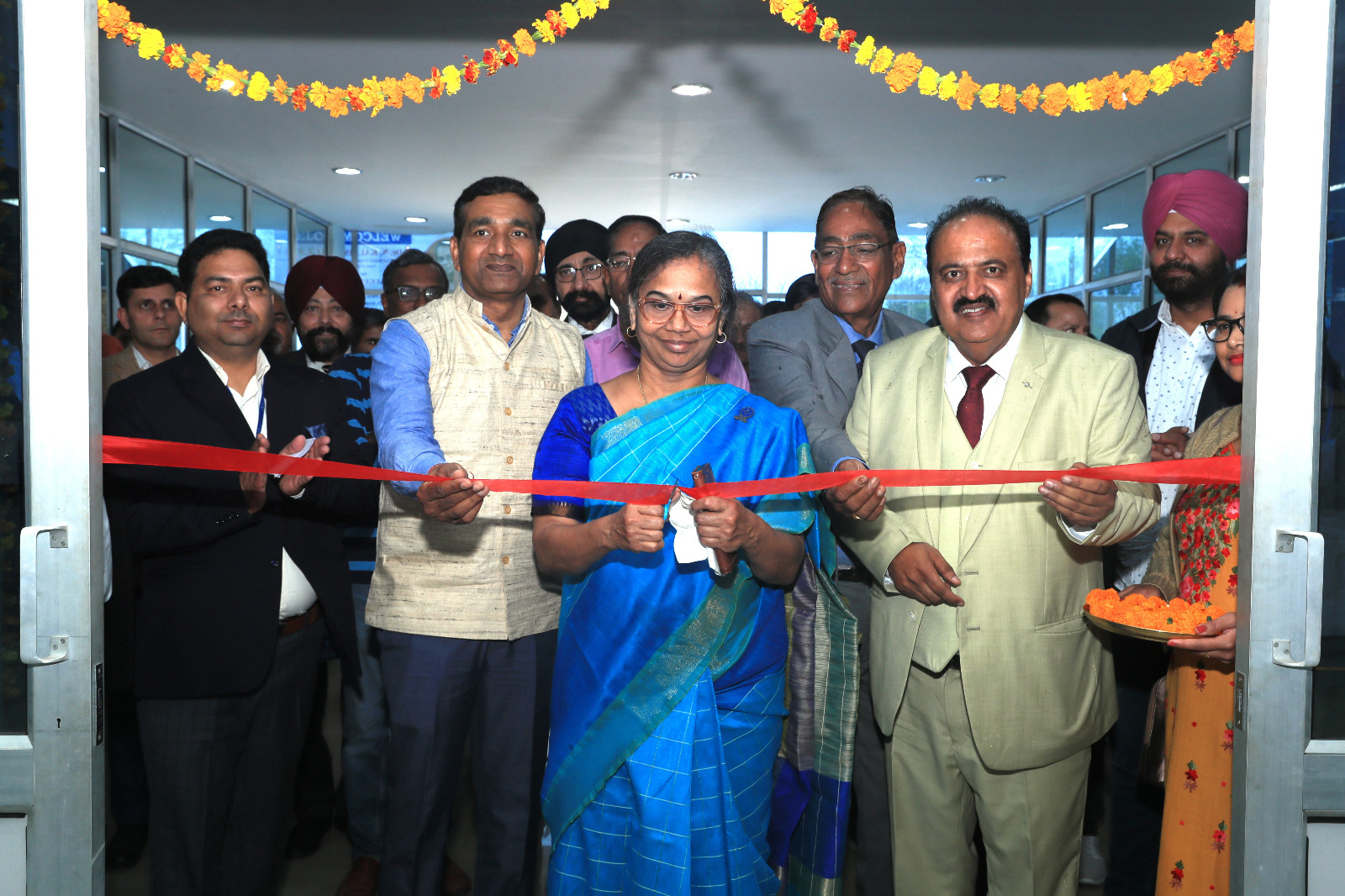
डॉ. (श्रीमती) एन. कलैसेल्वी, महानिदेशक सी.एस.आई.आर. एवं सचिव डी.एस.आई.आर, भारत सरकार ने हिमाचल प्रदेश के ऊना जिले के सिंघा में आर. जे सेंट्स स्टीविया प्रसंस्करण सयन्त्र का उद्घाटन किया, जिसे सी.एस.आई.आर.-हिमालय जैवसंपदा प्रौद्योगिकी संस्थान, पालमपुर के तकनीकी सहयोग से विकसित किया गया है। यह अपनी तरह की अनूठी ग्रीन प्रसंस्करण इकाई है, जो सूखे स्टीविया पत्तों को स्टेविओल ग्लाइकोसाइड पाउडर में प्रसंस्कृत करने की क्षमता रखती है। स्टीविया एक कम कैलोरी वाला प्राकृतिक स्वीटनर है, जो सुक्रोज से लगभग 300 गुना मीठा होता है और जिसे डायबिटीज़ के रोगी भी सेवन कर सकते हैं।
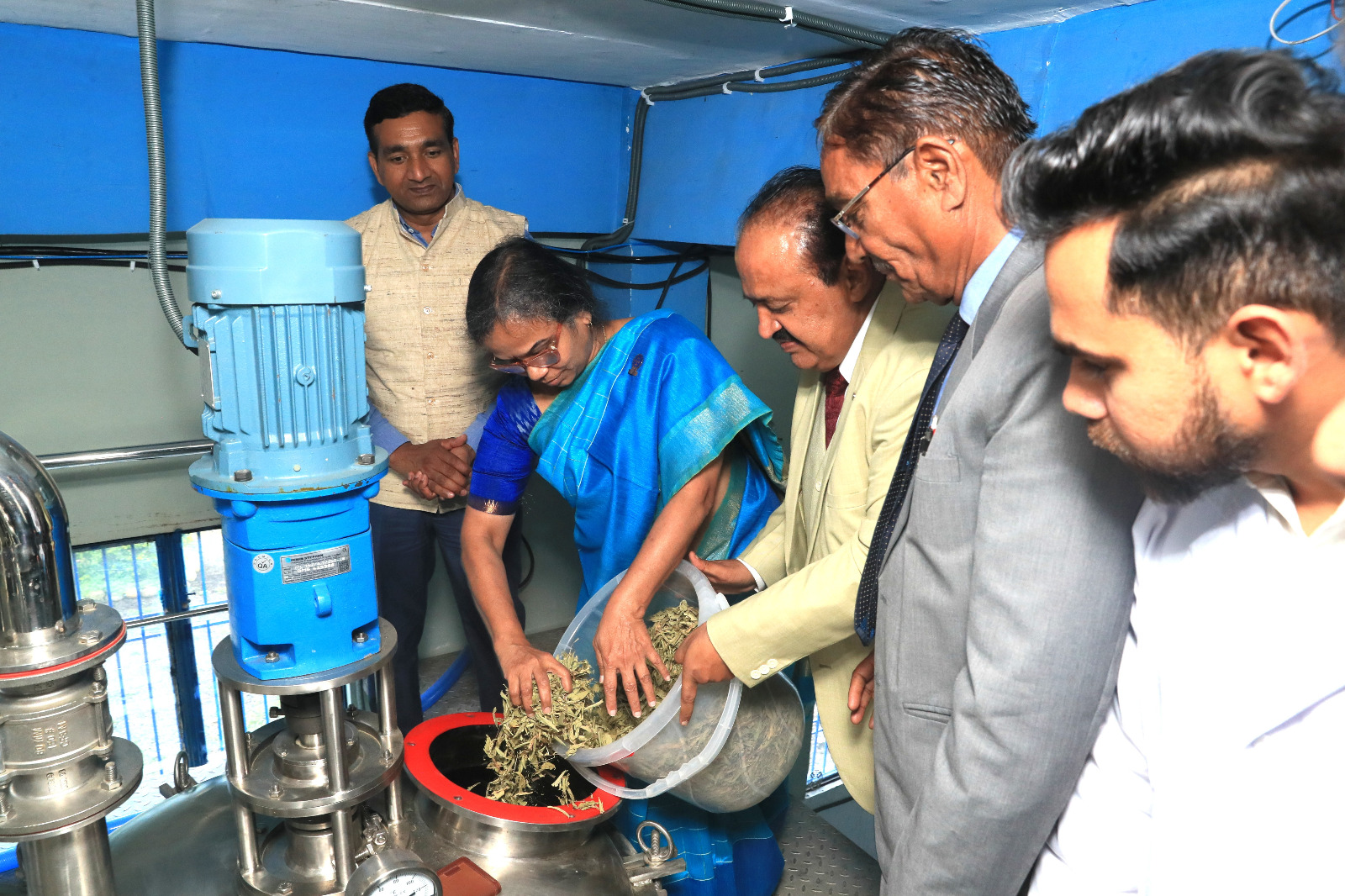
इससे पहले, डॉ. कलैसेल्वी ने स्टीविया के खेतों का दौरा किया, जहां संस्थान द्वारा विकसित "हिम स्टीविया" किस्म को 200 एकड़ से अधिक के क्षेत्र में लगाया गया है। उन्होंने नवीनतम खेत प्रबंधन तकनीकों का अवलोकन किया, जिसमें ड्रोन का उपयोग शामिल रहा।
उन्होंने खुशी व्यक्त कि संस्थान ने आर.जे सेंट्स को उत्तम पौध सामग्री से लेकर ग्रीन प्रसंस्करण तकनीक तक, समग्र समर्थन प्रदान किया। भारत में डायबिटीज़ के बढ़ते प्रकोप को देखते हुए, डॉ. कलैसेल्वी ने आर.जे सेंट्स को भी इस शानदार पहल के लिए बधाई दी। उन्होंने विकसित भारत की दिशा में संस्थान के प्रयासों की सराहना की।
इस अवसर पर, डॉ. सुदेश कुमार यादव, निदेशक सी.एस.आई.आर-आई.एच.बी.टी ने संस्थान द्वारा स्टीविया पर किए गए कार्यों का उल्लेख किया। उन्होंने बताया कि दुनिया भर में 20-79 आयु वर्ग के लगभग 540 मिलियन लोग डायबिटीज़ के साथ जी रहे हैं और यह संख्या 2030 तक 645 मिलियन होने का अनुमान है। भारत में अकेले 18 वर्ष से अधिक आयु के 77 मिलियन लोग डायबिटीज़ से पीड़ित हैं। आमतौर पर डायबिटीज़ के रोगियों को चीनी का सेवन न करने की सलाह दी जाती है। यहाँ स्टीविया एक मीठे विकल्प के रूप में आता है।
उन्होंने संस्थान द्वारा विकसित "हिम स्टीविया" किस्म की विशेषताओं पर चर्चा की, जिसमें 14.5% ग्लाइकोसाइड है। उन्होंने उच्च उत्पादकता और उपज के लिए उत्तम कृषि प्रथाओं और पत्तियों से शुद्ध स्टेविओल ग्लाइकोसाइड निकालने के लिए ग्रीन प्रोसेस तकनीक पर जोर दिया।
इस अवसर पर, स्टीविया पर एक तकनीकी ब्रोचर का विमोचन किया गया और प्रगतिशील किसानों को उसकी गुणवत्तापूर्ण पौध सामग्री वितरित की गई। इसके साथ ही, धनवंतरी ग्राम संगठन, हिमाचल प्रदेश के साथ एक आसवन इकाई स्थापित करने हेतु समझौता ज्ञापन पर हस्ताक्षर किए गए। इस अवसर पर महालक्ष्मी माल्ट प्रोडक्ट्स प्राइवेट लिमिटेड, हरियाणा के साथ प्रौद्योगिकी हस्तांतरण समझौते पर हस्ताक्षर किए गए।
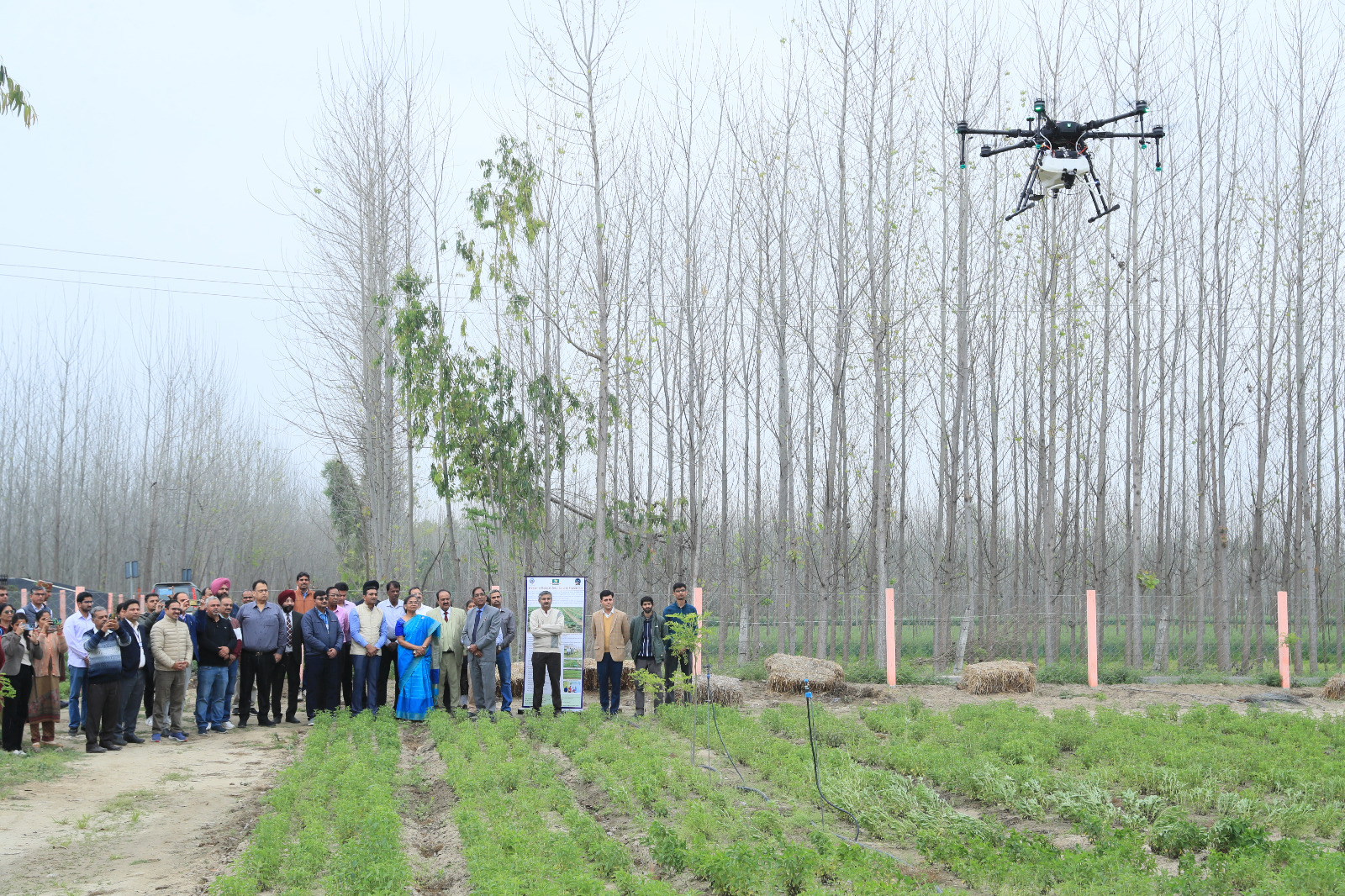
Dr. (Mrs.) N. Kalaiselvi, Director General CSIR & Secretary DSIR, Govt. of India inaugurated the RJ Saints Stevia processing plant at Singha in Una district of Himachal Pradesh that has been developed with the technical support of CSIR-Institute of Himalayan Bioresource Technology, Palampur. It is one of its kind green processing unit that has the capacity of processing dry stevia leaves into steviol glycoside powder.
It is pertinent to mention that Stevia is a low-calorie natural sweetener which is about 300 times sweeter than sucrose and can be consumed by diabetics.
Prior, to this Dr. Kalaiselvi visited the Stevia farms wherein the variety “Him Stevia” developed by the institute is being grown in an area of more than 200 acres. She witnessed the latest farm management practices including use of drone for spraying plant nutrients.
Dr. Kalaiselvi also congratulated RJ Saints for taking this wonderful initiative that has the potential to be a game changer as India is the diabetic capital of the world. She appreciated the efforts of the institute in striving towards Viksit Bharat.
On the occasion, Dr. Sudesh Kumar Yadav, Director CSIR-IHBT presented the work carried out by the institute on Stevia. He emphasized that worldwide, some 540 million people in the age group of 20-79 years are living with diabetes and that this number is projected to upsurge to 645 million by 2030. India alone has 77 million people above the age of 18 years with diabetes. Generally, diabetes patients are not recommended to consume cane sugar wherein stevia comes as a sweet alternate. He dwelled on the characteristics of the variety “HimStevia” developed by the institute that has 14.5% total glycoside content.
He also emphasized on the Good Agricultural Practices (GAP) for higher productivity and yield, and the green process technology for extracting pure steviol glycoside from leaves.
Mr. Ravi Sharma, the owner of RJ Saints recalled his involvement with the institute since 2016 and thanked the institute for the help and guidance.
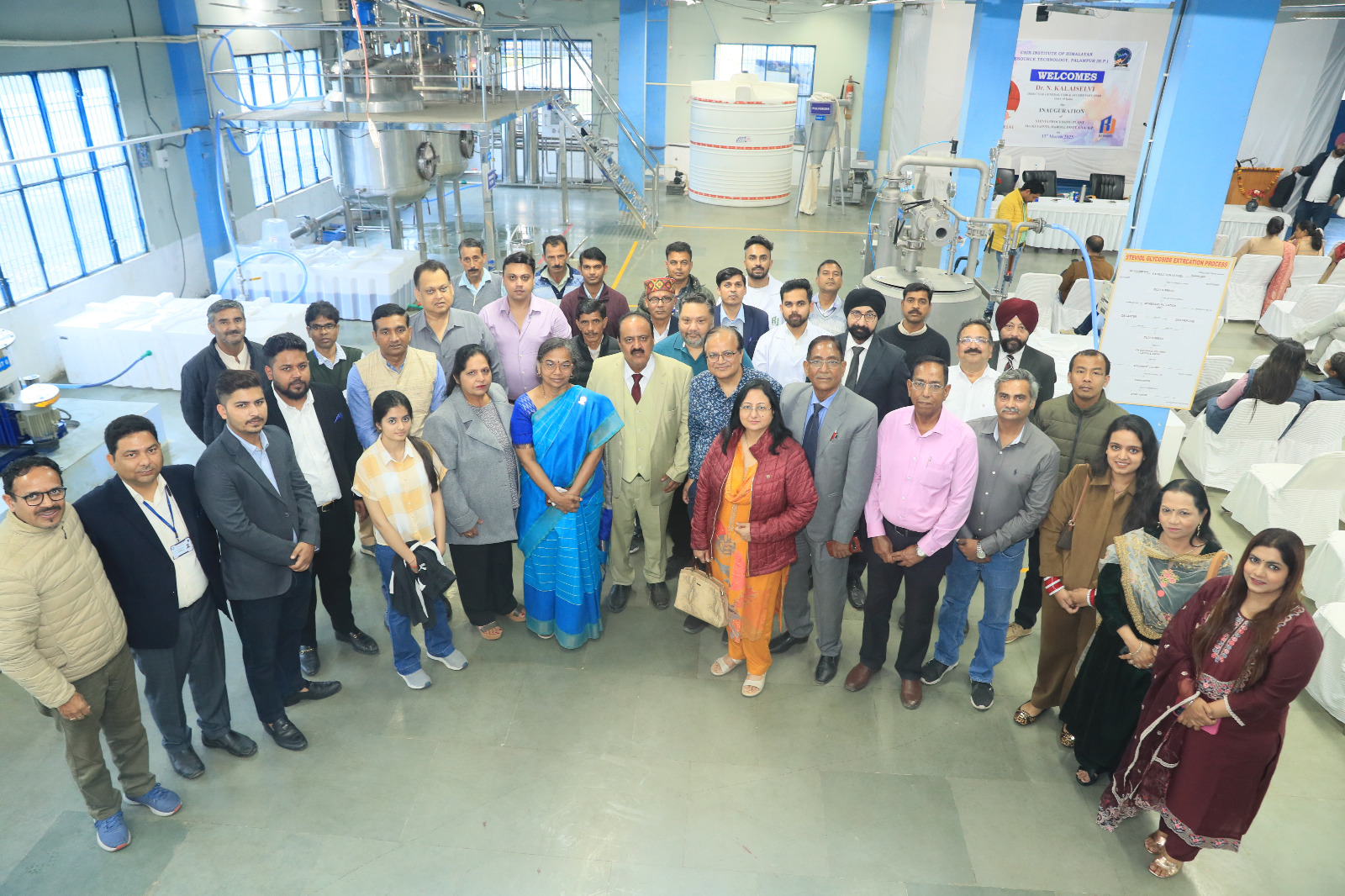
International Women's Day Celebrations
closeCelebrations of International Women's Day at CSIR-IHBT
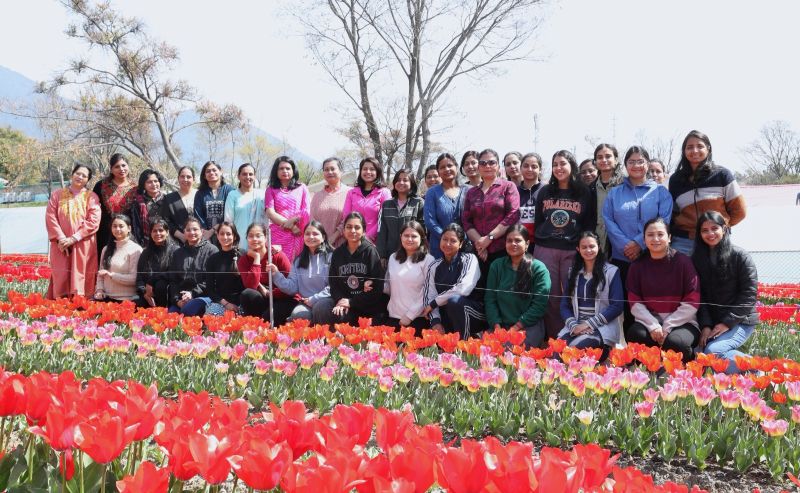
Women employees, scholars, students and family members enthusiastically participated in a week-long series of events held by CSIR-IHBT to commemorate International Women's Day from March 3rd to March 9th, 2025.
Aerobics Sessions (3rd March 2025): Kicking off the festivities, aerobics sessions were held for female research scholars and staff, with approximately 70 energetic participants.
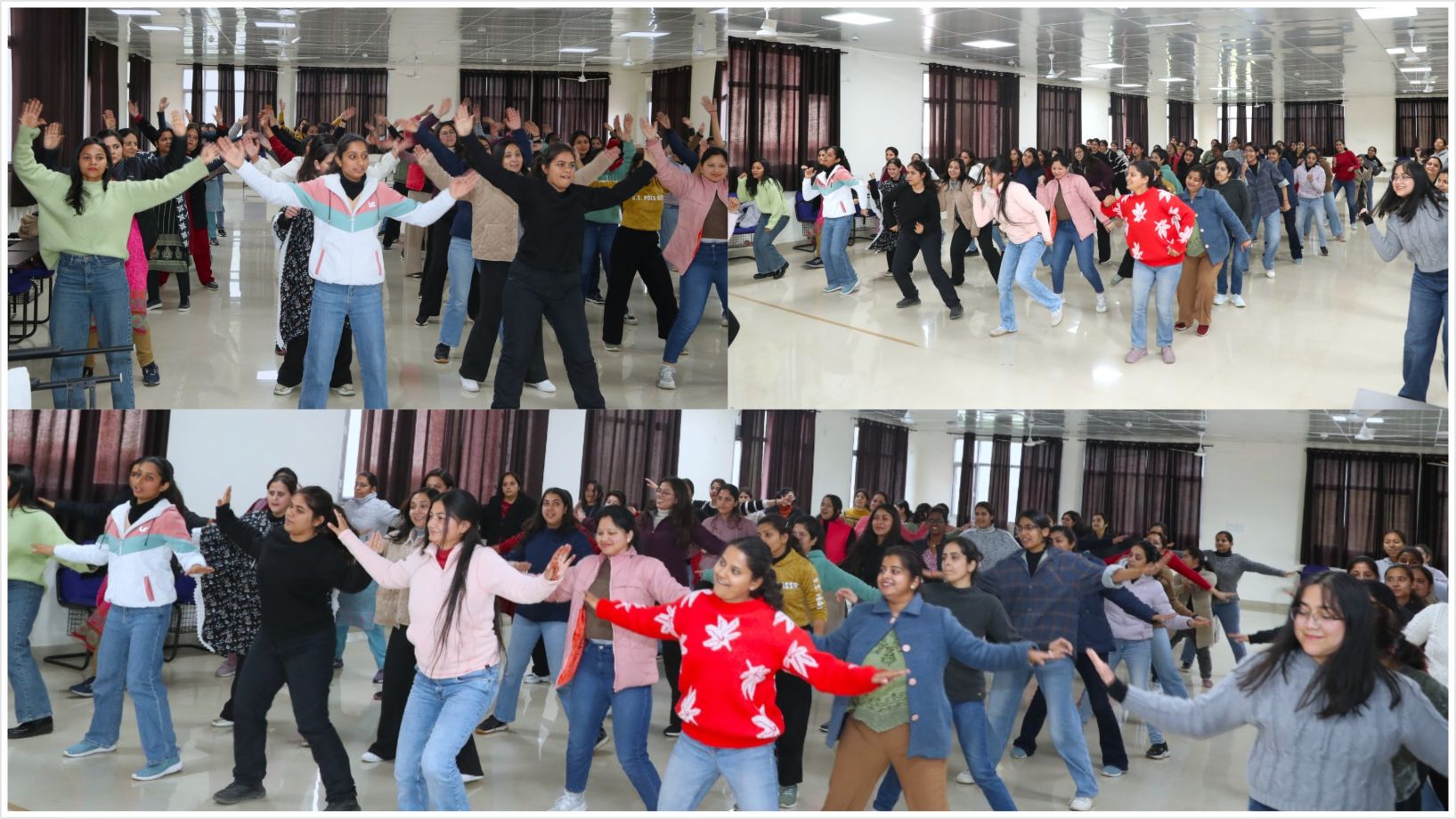
Sports Event (4th March 2025): The institute organized a lively sports event, honouring International Women's Day. It saw spirited participation from 30 female research scholars, staff, and their wards.
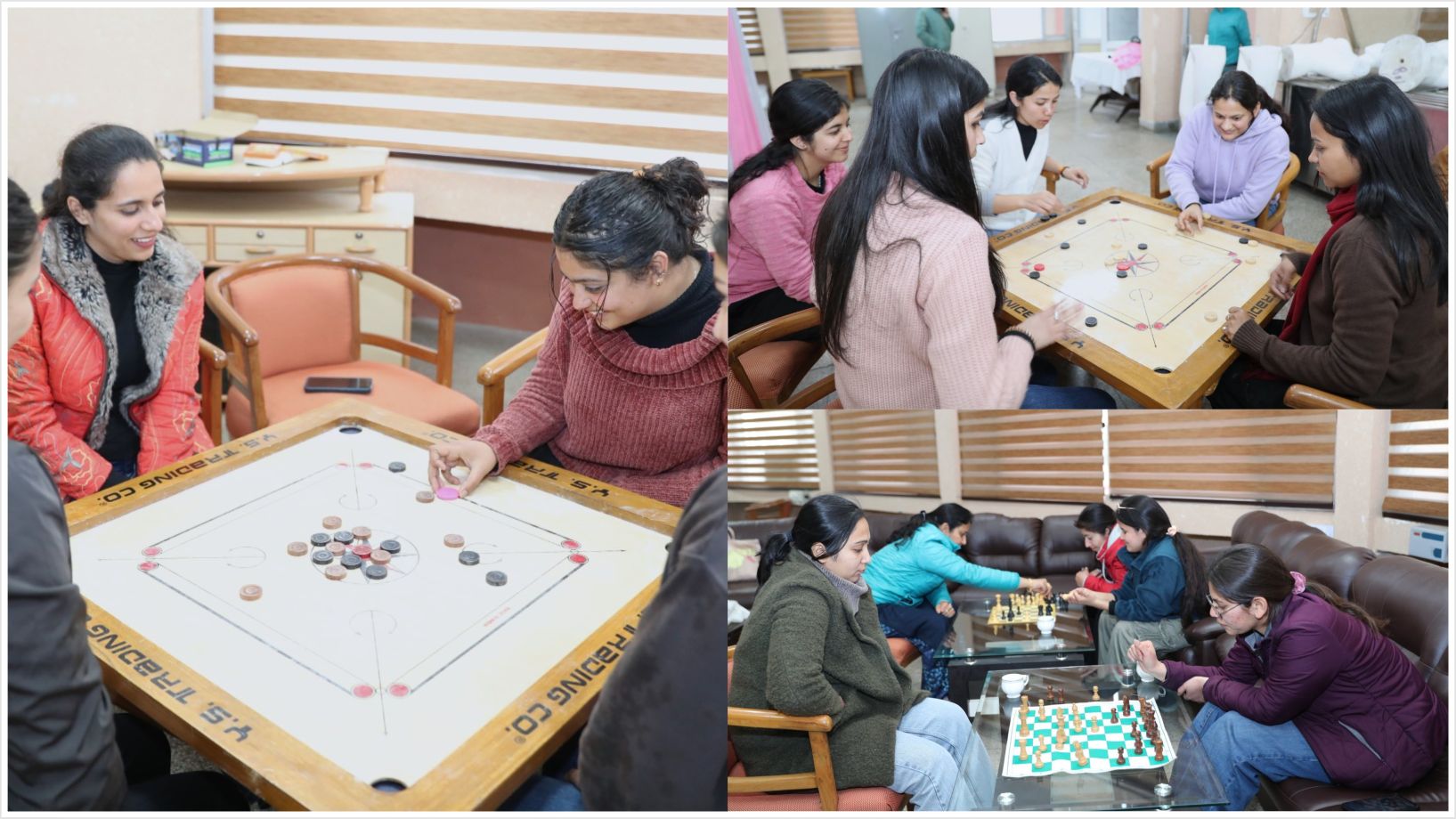
Educational Talk on Women's Health (5th March 2025): Professor (Dr.) Rashmi Srivastava from Rajiv Gandhi Govt. Post Graduate Ayurvedic College Paprola delivered an insightful talk on "Diet and Drugs for Women's Health." The event was attended by staff, scholars, and family members of CSIR-IHBT.
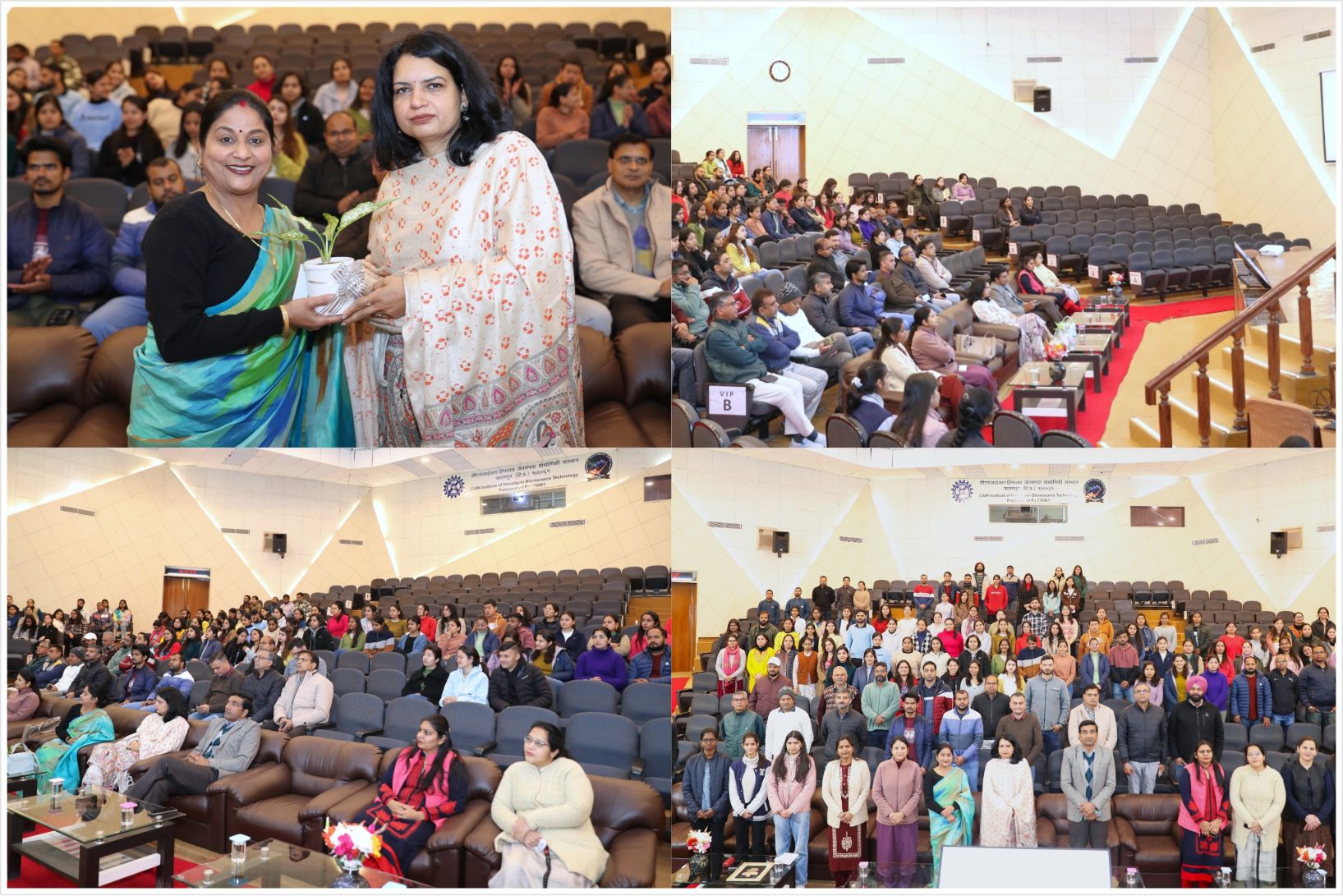
Self-Defense & Martial Arts Sessions (6th March 2025): Empowering female research scholars and employees, CSIR-IHBT organized self-defense and martial arts sessions to enhance their physical and mental strength.
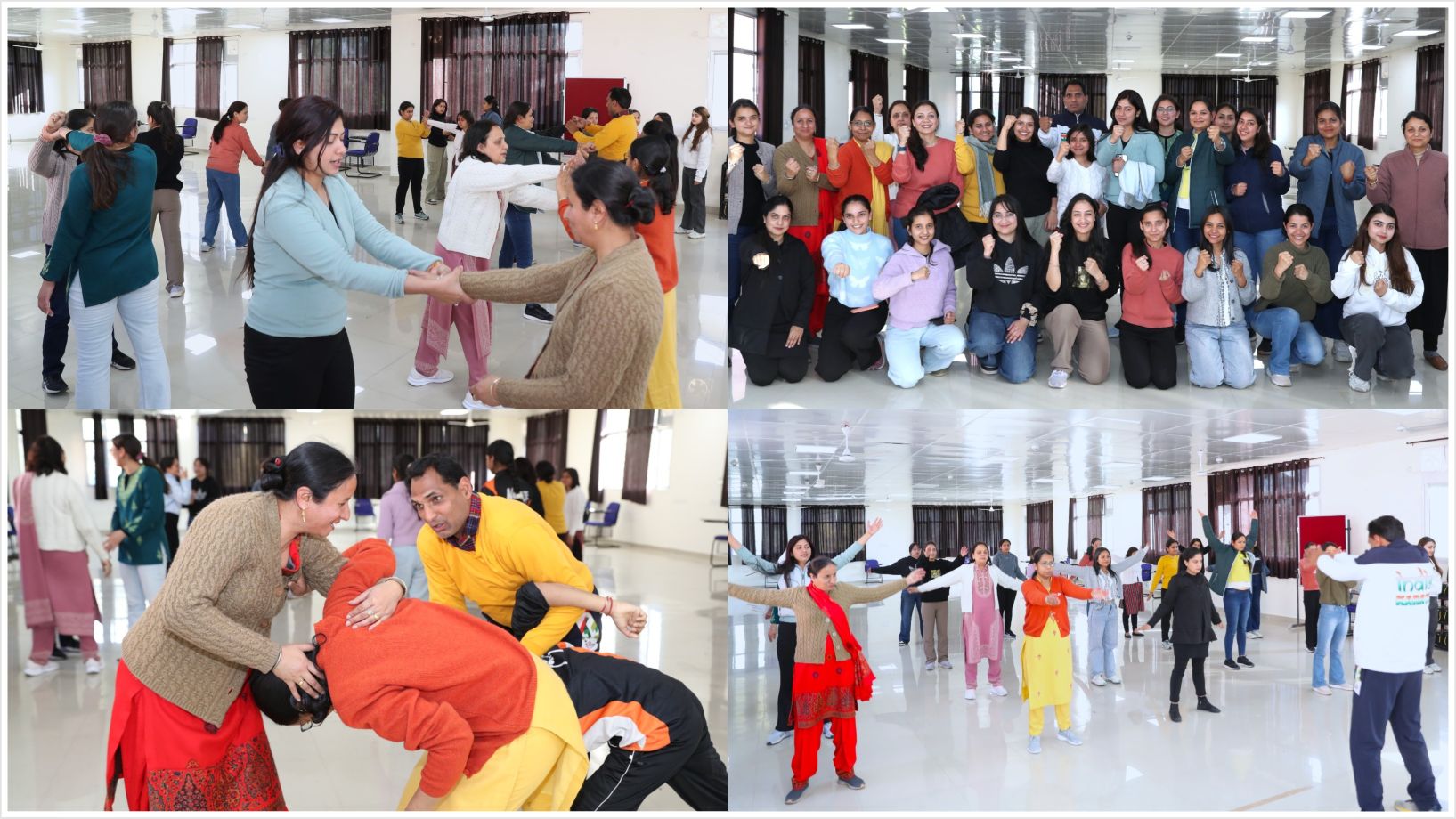
Talk on Mental Health & Wellness (7th March 2025): Dr. Vikesh Gupta, Assistant Professor at RPGMC Kangra (HP), delivered a compelling talk titled "Women Mental Health Matters: Empowering Women’s Mental Well-being – Strategies for Stress Relief."
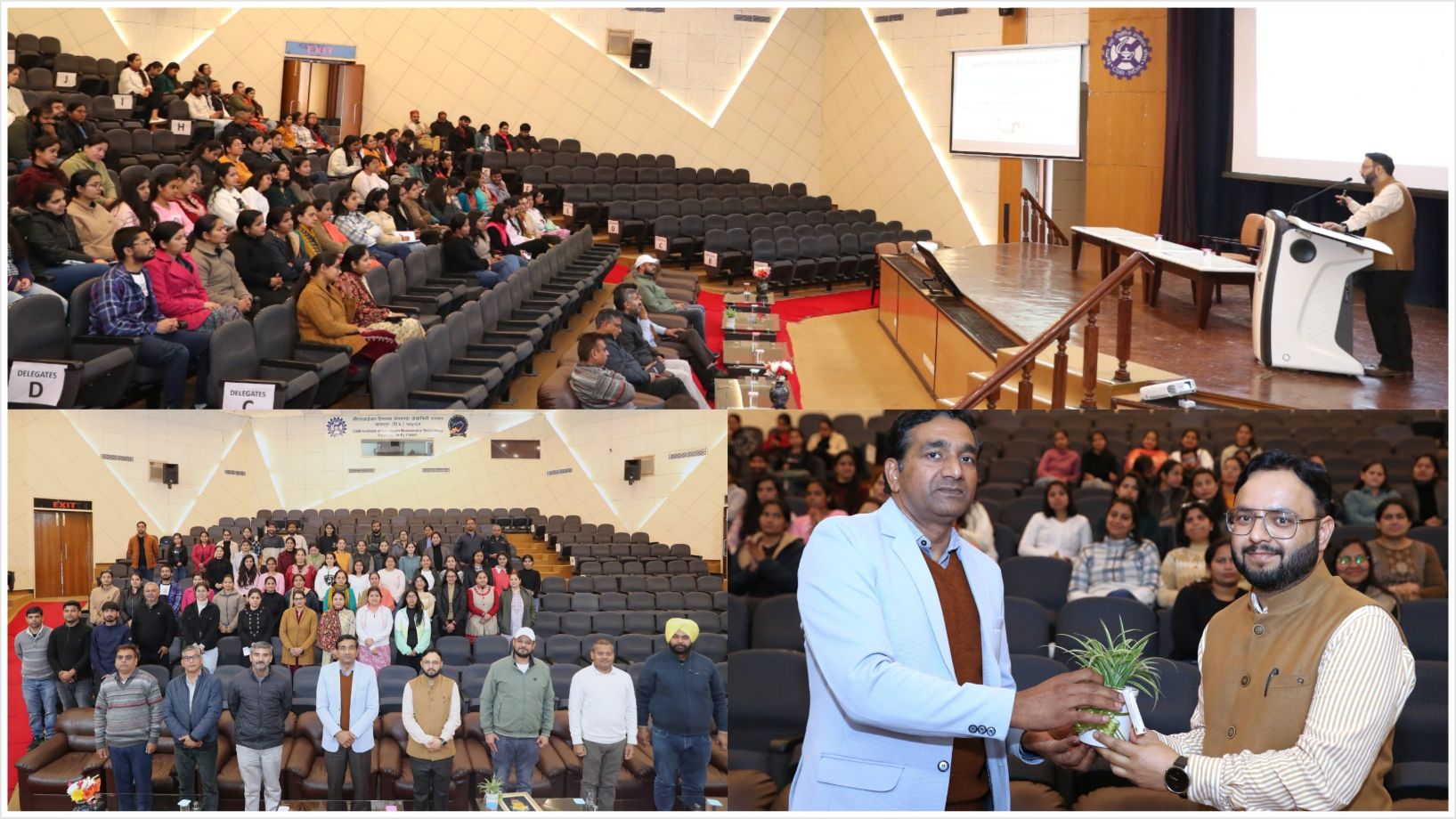
Yoga Session (8th March 2025): Emphasizing holistic health, a calming yoga session was conducted for female scholars and family members.
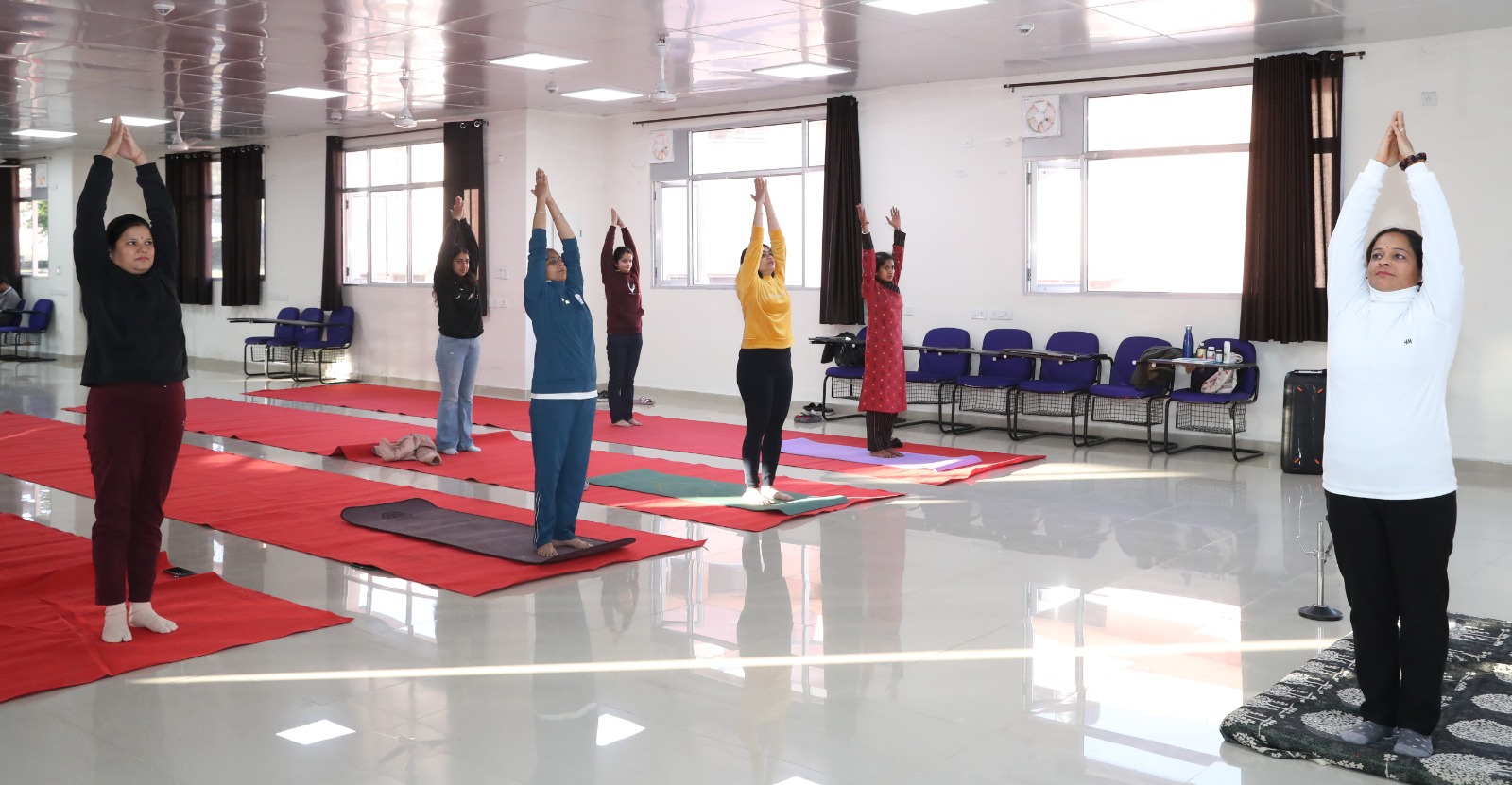
Cyclothon and Walkathon (9th March 2025): The celebrations concluded with a vibrant Cyclothon and Walkathon. Scientists, staff members, and students participated with great enthusiasm, showcasing unity and community spirit.
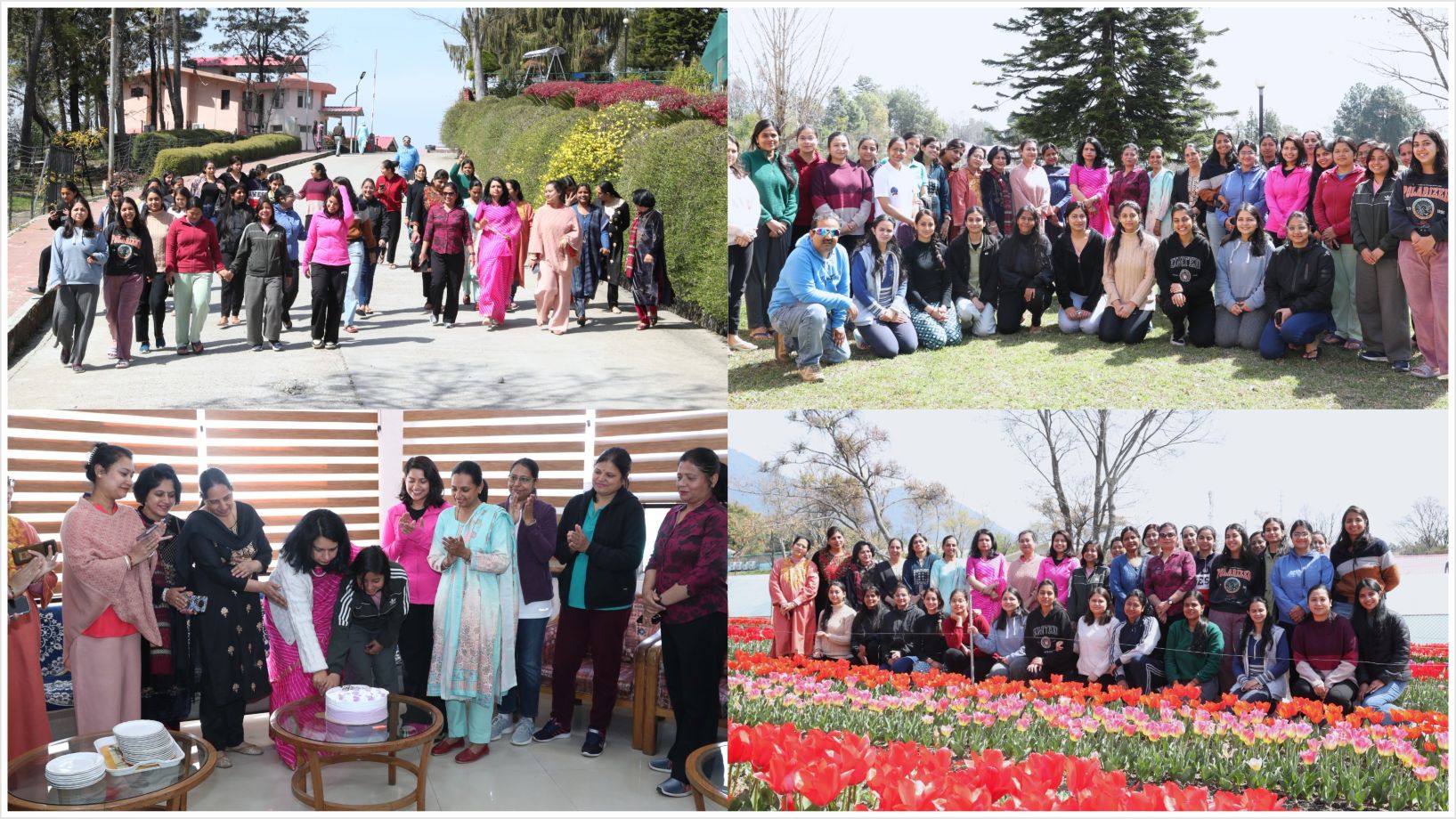
The concluding session was hosted by the Ladies Club and Staff Club, with Mrs. Kavita Yadav, President of, the Ladies Club, CSIR-IHBT, as the chief guest. In her inspiring address, Mrs. Yadav applauded the dedication of women scientists, staff, students, and their families for their invaluable contributions to the institute’s scientific achievements. She then led the Walkathon alongside the women participants, marking a symbolic moment of unity and empowerment. The week-long celebrations concluded with a group photograph of all the women with Mrs. Yadav at the tulip garden.
National Science Day Celebrations-2025
closeसीएसआईआर-आईएचबीटी, पालमपुर में राष्ट्रीय विज्ञान दिवस समारोह का आयोजन
National Science Day Celebrations
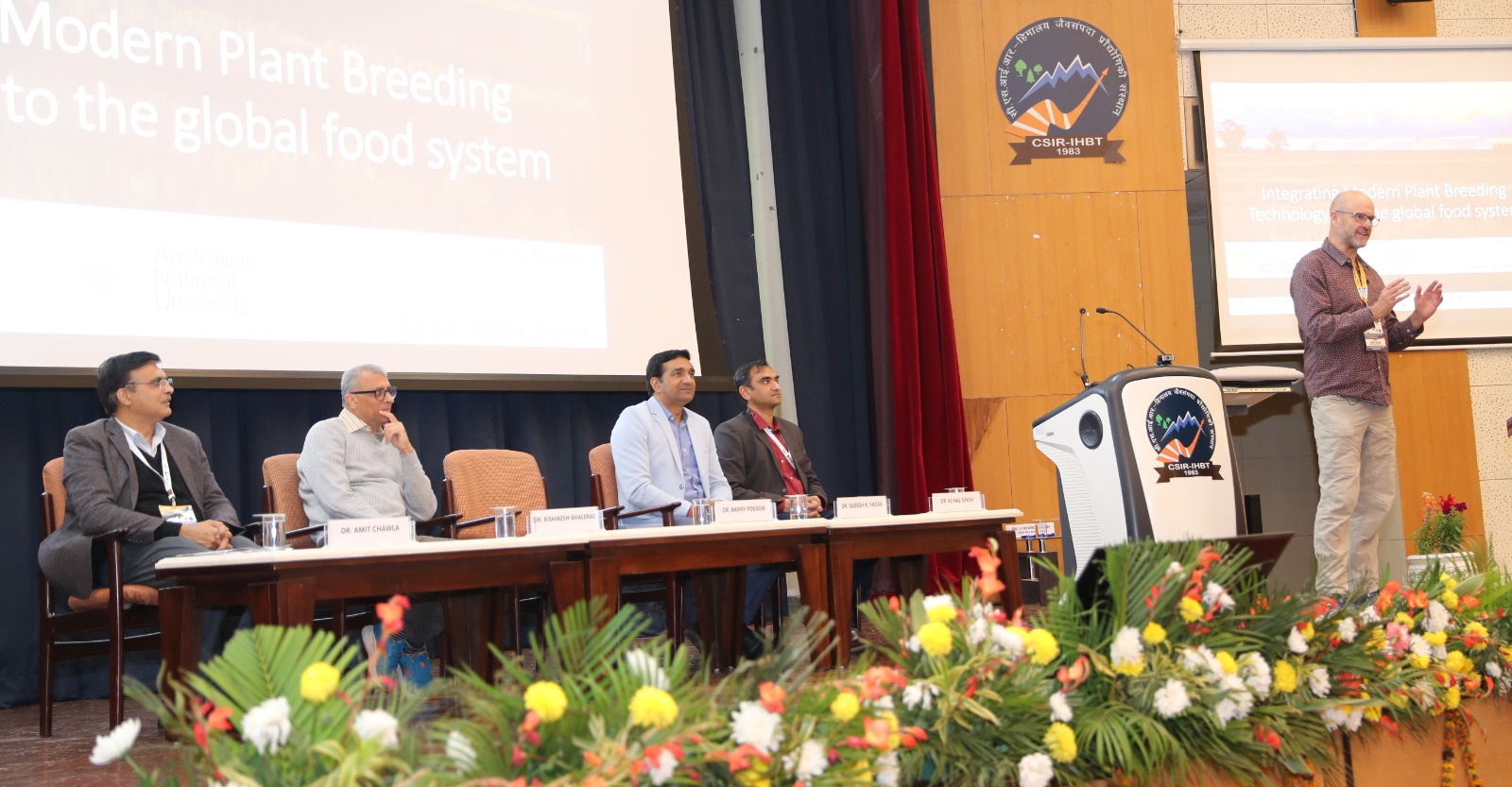
सी.एस.आई.आर.-हिमालय जैवसंपदा प्रौद्योगिकी संस्थान, पालमपुर ने 28 फरवरी 2025 को अपने परिसर में राष्ट्रीय विज्ञान दिवस को उत्साह के साथ मनाया। यह दिन सर सी.वी. रमन द्वारा 1928 में रमन प्रभाव की खोज करने के उपलक्ष में मनाया जाता है, जिसके लिए उन्हें वर्ष 1930 में नोबेल पुरस्कार से सम्मानित किया गया था। इस वर्ष राष्ट्रीय विज्ञान दिवस का विषय रहा "विकसित भारत के लिए विज्ञान और नवाचार में वैश्विक नेतृत्व के लिए भारतीय युवाओं को सशक्त बनाना"।
डॉ. बैरी पोगसन, ऑस्ट्रेलियन नेशनल यूनिवर्सिटी, ऑस्ट्रेलिया, समारोह के मुख्य अतिथि थे। उन्होंने फसल सुधार के लिए नई प्रजनन प्रौद्योगिकियों को उजागर किया। उन्होंने इनकी संभावनाओं और बाधाओं पर चर्चा की और बदलते पर्यावरण और बढ़ती जनसंख्या में प्रजनन प्रौद्योगिकियों की भूमिका पर जोर दिया।
डॉ. ऋषिकेश भालेराओ, स्वीडिश अकैडमी ऑफ एग्रिकल्चर, स्वीडन, समारोह के सम्मानित अतिथि थे। उन्होने विज्ञान में और अधिक निवेश एवं युवाओं को आकर्षित करने पर बल दिया।
इससे पहले, सी.एस.आई.आर.-आई.एच.बी.टी. के निदेशक डॉ. सुदेश कुमार यादव ने अपने संबोधन में सब का स्वागत किया और राष्ट्रीय विज्ञान दिवस की शुभकामनाएं दीं। उन्होंने संस्थान के वैज्ञानिक प्रयासों और कार्यों की जानकारी दी तथा बताया कि कैसे इनसे जैव-आर्थिक और लोगों की आजीविका को सुधारने में मदद मिली है। उन्होंने विशेष रूप से पुष्पविज्ञान और सगंध मिशन के उदाहरण दिए। उन्होंने जोर दिया कि विज्ञान को नई उभरती समस्याओं और राष्ट्रीय आवश्यकताओं को ध्यान में रखते हुए कार्य करना चाहिए। उन्होंने जिज्ञासा पहल और कौशल विकास कार्यक्रमों के बारे में बताया जो युवाओं को सशक्त बनाने पर केंद्रित हैं। उन्होंने सभी से एक साथ आने और विकसित भारत के निर्माण की दिशा में योगदान करने का आग्रह किया।
इस अवसर पर सूखे फूलों से हस्तशिल्प बनाने की तकनीक का हस्तांतरण किया गया , जबकि किसानों को पियोनी और गेंदा के उच्च गुणवत्ता वाली पौधरोपण सामग्री वितरित की गई।
इस कार्यक्रम में, संस्थान के कर्मी और छात्रों के अलावा ई.एम.बी.ओ कार्यशाला के प्रतिभागी, निकटवर्ती संगठनों के कर्मचारी, एवं वरिष्ठ माध्यमिक विद्यालय जिया, कांगड़ा के छात्र और शिक्षकों ने प्रतिभागिता की।
संस्थान में राष्ट्रीय विज्ञान दिवस समारोह के साथ ही सी.एस.आई.आर-आई.एच.बी.टी द्वारा आयोजित 4 दिवसीय ई.एम.बी.ओ अंतर्राष्ट्रीय कार्यशाला भी पूर्ण हो गई।
The CSIR-Institute of Himalayan Bioresource Technology celebrated the National Science Day with fervor and gaiety on its campus on 28 Feb 2025. This day is celebrated to mark the discovery of Raman Effect by Sir CV Raman in 1928, for which he was awarded the Nobel Prize in 1930. The theme for this year is “Empowering Indian Youth for Global Leadership in Science and Innovation for Viksit Bharat”
Dr. Barry Pogson from Australian National University, Australia was the Chief Guest of the function. He highlighted the new breeding technologies for crop improvement and discussed their opportunities and constraints in the changing environment. He emphasized on skill, precission and search for answering key questions that are the need of the hour.
Dr. Rishikesh Bhalerao from Swedish University of Agriculture, Sweden was the Guest of Honour. He put forth his views that further investment in science is desired and that there is a need to attract young minds at the right age.
Prior this, Dr. Sudesh Kumar Yadav, Director CSIR-IHBT welcomed the guests and extended his wishes for the occasion. He briefed on the scientific endeavors of the institute and how they have been able to improve the bio-economy and livelihood of common people. He particularly cited examples of the Floriculture and Aroma mission. He emphasized that science should address the emerging problems and the national needs. He presented about the Jigyasa initiative and skill development programmes that focus on empowering youth. He urged all to come together and contribute towards building a Viksit Bharat.
On the occasion, a transfer of technology on artefacts from dried flower was signed while quality planting materials of Peony and Marigold were distributed to farmers.
In addition to staff and students of the institute, participants of EMBO workshop, & nearby organizations; school students & teachers from Govt. Sen. Sr. School Jia, Kangra also participated in the programme.
The National Science Day celebration at the institute also marked the culmination of the 4 day long EMBO international workshop organized by CSIR-IHBT.
EMBO International Workshop & Industry, Farmer and Academia Meet
closeई.एम.बी.ओ अंतर्राष्ट्रीय कार्यशाला और उद्योग, किसान और शिक्षाविदों की बैठक
EMBO International Workshop and Industry, Farmer & Academia meet
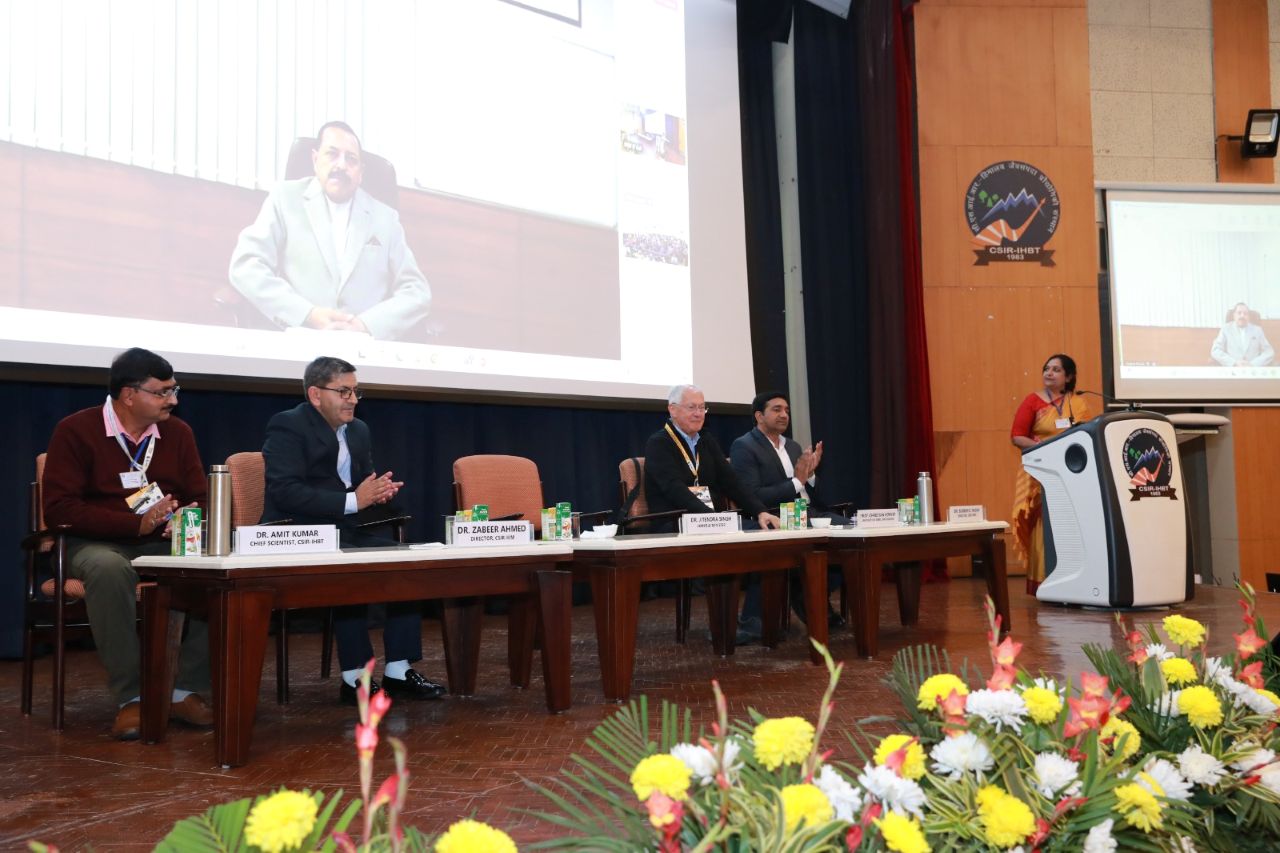
डॉ. जितेंद्र सिंह, माननीय राज्य मंत्री (स्वतंत्र प्रभार) विज्ञान और प्रौद्योगिकी मंत्रालय और पृथ्वी विज्ञान मंत्रालय, एवं उपाध्यक्ष सी.एस.आई.आर., आज सी.एस.आई.आर.-हिमालय जैवसंपदा प्रौद्योगिकी संस्थान, पालमपुर (सी.एस.आई.आर.-आई.एच.बी.टी.), पालमपुर द्वारा आयोजित ई.एम.बी.ओ अंतर्राष्ट्रीय कार्यशाला और उद्योग, किसान और शिक्षाविदों की बैठक में मुख्य अतिथि रहे। उन्होने कार्यक्रम में ऑनलाइन प्रतिभागिता की।
अपने अध्यक्षीय संबोधन में डॉ. जितेंद्र सिंह ने हिमालयी क्षेत्र की जैव-आर्थिकी को बढ़ावा देने में संस्थान के प्रयासों की सराहना की तथा स्टार्टअप्स और इन्क्यूबेटीज को प्रोत्साहित करने पर संस्थान के कार्यों पर प्रसन्नता व्यक्त की। माननीय मंत्री जी ने पुष्पकृषि और सगंध मिशन तथा पोषण मैत्री अभियान की सफलता पर खुशी जताई।
उन्होंने जनता को सशक्त बनाने के लिए सरकार द्वारा शुरू किए गए विभिन्न मिशनों को उजागर किया। उन्होंने समन्वय और एक सप्ताह एक थीम उत्सवों का भी उल्लेख किया तथा सभी से एकजुट होकर विकसित भारत के लिए काम करने का आह्वान किया।
डॉ. जितेंद्र सिंह ने जोर देकर कहा कि विज्ञान का लाभ आम आदमी तक पहुंचना चाहिए जिसमे मीडिया का विशेष महत्व है। बदलते परिवेश में सोशल मीडिया इसमे महत्वपूर्ण भूमिका निभा रहा है और इसका उपयोग बेहतर तरीके से किया जाना चाहिए। उन्होंने सभा को वर्चुअली संबोधित किया।
सी.एस.आई.आर.-आई.एच.बी.टी. के निदेशक, डॉ. सुदेश कुमार यादव ने अपने स्वागत संबोधन में माननीय मंत्री, गणमान्य व्यक्तियों और सभी प्रतिभागियों का हार्दिक स्वागत किया। उन्होंने संस्थान की गतिविधियों और उपलब्धियों को प्रस्तुत किया और आत्मनिर्भरता और समावेशी विकास की दिशा में संस्थान के योगदान को उजागर किया।
इसके पहले, माननीय मंत्री ने संस्थान के ट्यूलिप उद्यान को जनता के लिए खोल दिया। उन्होंने संस्थान में स्वायत्त ग्रीन हाउस, हींग बीज उत्पादन सुविधा, हींग क्यू.पी.एम सुविधा, सजावटी बल्ब उत्पादन सुविधा, फाइटो-एनालिटिकल सुविधा का भी उद्घाटन किया। डॉ. जितेंद्र सिंह ने फाइटोफैक्टरी सुविधा की आधारशिला भी रखी और संस्थान की प्रौद्योगिकियों पर आधारित उत्पादों और पहलों की प्रदर्शनी का भी उद्घाटन किया। इसमें इन्क्यूबेटीज, स्टार्टअप्स और किसान समितियों के स्टॉल थे।
इस अवसर पर सुगंधित फसलों और पुष्पकृषि पर ब्रोशर सहित संस्थान के पांच प्रकाशनों को भी जारी किया गया। इसके अलावा, दो प्रौद्योगिकी हस्तांतरण समझौतों पर भी हस्ताक्षर किए गए । निदेशक आई.आई.आई.एम. जम्मू , डॉ. ज़बीर अहमद और प्रोफेसर क्रिश्चियन कोर्नर भी इस अवसर पर उपस्थित थे।
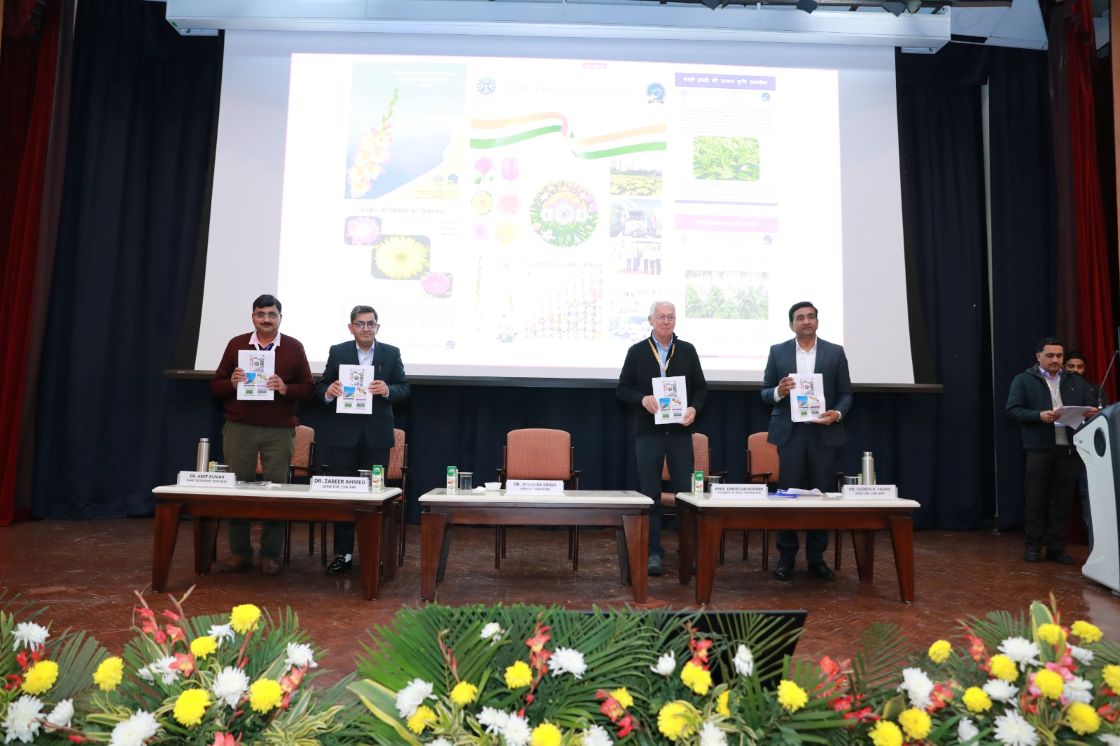
Dr. Jitendra Singh, Hon’ble minister of State (Independent Charge) Ministry of Science & Technology and Ministry of Earth Sciences, and Vice-President CSIR was the Chief guest of the EMBO international workshop and Industry, Farmer & Academia meet organized by the CSIR-Institute of Himalayan Bioresource Technology, Palampur in its premises today.
In his presidential address, he lauded the efforts of the institute towards boosting bio-economy of the Himalayan region through scientific interventions and nurturing young minds. He was happy to note the start-ups and incubatees being supported by the institute and the success of floriculture and aroma mission and the Poshan Maitree Abhiyan.
He highlighted the various missions that have been initiated by the government to empower the masses. Coupling of states and extended one week one theme celebrations were put forth by him. He exhorted the gathering to come together and work for a Viksit Bharat.
He emphasized that science has to be for the society and it should reach the common man for which the social media has to be optimally utilized. He virtually addressed the gathering.
Dr. Sudesh Kumar Yadav, Director CSIR-IHBT in his opening remarks extended a warm welcome to the Hon’ble Minister, dignitaries and all the participants. He presented the activities and achievements of the institute and highlighted its contribution towards self-reliance and inclusive growth.
Prior to this, the Hon’ble Minister declared open the Tulip garden for the public. He also inaugurated the Autonomous Green House, Heeng Seed Production facility, Heeng QPM facility, Ornamental bulb production facility, Phyo-analytical facility in the institute. He also laid the foundation stone of Phytofactory facility. An exhibition showcasing products and initiatives based on the institute technologies and know how was also inaugurated by Dr. Jitendra Singh. It had stalls from incubatees, startups and farmer societies.
On the occasion, five institute’s publications including brochures on aroma crops and floriculture were also released. Further, the Institute signed two transfer of technology agreements on the occasion.
Among other, Director IIIM, Dr. Zabeer Ahmed and Prof. Christian Korner also present graced the occasion.
Tulip Festival & National Symposium on Ornamental Bulbous Flowers
closeट्यूलिप फेस्टिवल और साज-सज्जा के कंद फूलों पर राष्ट्रीय संगोष्ठी
Tulip Festival & National Symposium on Ornamental Bulbous Flowers
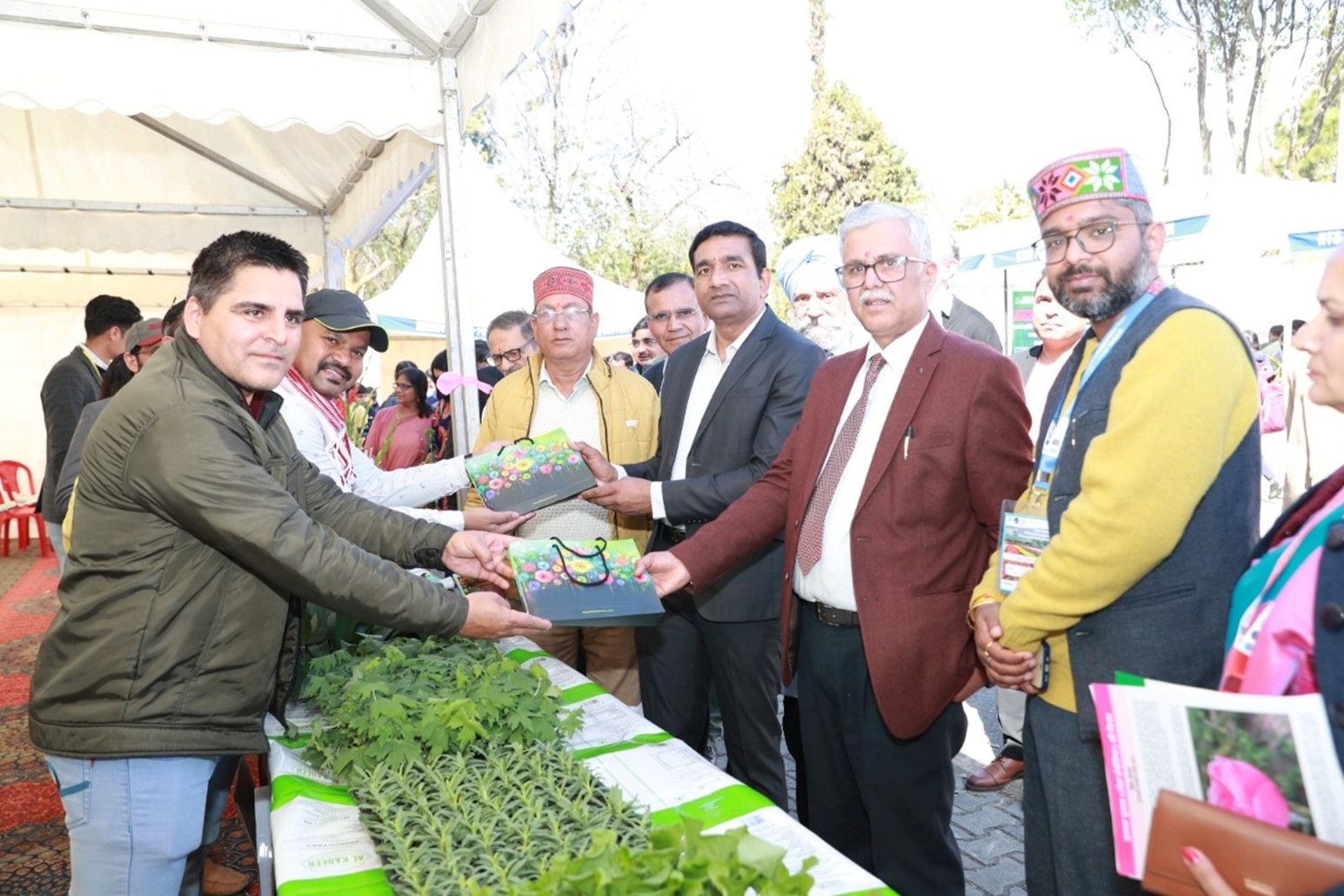
दो दिवसीय ट्यूलिप फेस्टिवल और साज-सज्जा के कंद फूलों पर राष्ट्रीय संगोष्ठी आज सीएसआईआर-हिमालय जैवसंपदा प्रौद्योगिकी संस्थान (सी.एस.आई.आर.-आई.एच.बी.टी), पालमपुर में शुरू हुई । इस संगोष्ठी का आयोजन संस्थान इंडियन सोसाइटी ऑफ ओर्नामेंटल हॉर्टिकल्चर (आईएसओएच) के साथ मिलकर कर रहा है और इसका उद्देश्य सजावटी कंद फूलों को बढ़ावा देना है।
सी.एस.आई.आर.-आई.एच.बी.टी के निदेशक डॉ. सुदेश कुमार यादव कार्यक्रम के मुख्य अतिथि थे। अतिथियों और गणमान्य व्यक्तियों का स्वागत करते हुए उन्होंने आजीविका और अर्थव्यवस्था को आकार देने में पुष्पविज्ञान की भूमिका और संस्थान के योगदान को उजागर किया। उन्होंने सीएसआईआर फ्लॉरिकल्चर मिशन, जो कि पुष्प फसलों के माध्यम से जैव-आर्थिक वृद्धि पर ध्यान केंद्रित करते हुए प्रचार, सुधार, मूल्य संवर्धन और जागरूकता का काम करता है, के बारे में विस्तार से बताया। उन्होंने अपनी शुभकामनाएं दीं और आशा व्यक्त की कि यह संगोष्ठी सभी के लिए लाभप्रद होगी।
आईएसओएच के उपाध्यक्ष डॉ. वाई सी गुप्ता कार्यक्रम के विशिष्ट अतिथि थे। डॉ. गुप्ता ने इस क्षेत्र में हो रहे नवीन कार्यों पर प्रकाश डाला और पुष्पविज्ञान के व्यापक दायरे पर चर्चा की। आईएसओएच के सचिव डॉ. एस एस सिंधु ने संगोष्ठी के बारे में संक्षेप में बताया और पुष्पविज्ञान को बढ़ावा देने में आईएसओएच की भूमिका को उजागर किया। इस अवसर पर आईएसओएच द्वारा उन व्यक्तियों को फेलोशिप और पुरस्कार प्रदान किए गए जिन्होंने पुष्पविज्ञान के क्षेत्र में उत्तम योगदान दिया है।
इस अवसर पर किसान मेला भी आयोजित किया गया, जिसमें विभिन्न अवसरों, उत्पाद और नवीन कृषि पद्धतियों का प्रदर्शन किया गया।
संगोष्ठी में देश भर से 250 से अधिक प्रतिभागी, 15 उद्योगों के प्रतिनिधि और 50 से अधिक किसान उपस्थित रहे।
सीएसआईआर-आईएचबीटी के वैज्ञानिक डॉ. भव्य भार्गव ने धन्यवाद ज्ञापन प्रस्तुत किया।
The two-day Tulip Festival & National Symposium on Ornamental Bulbous Flowers began today at the CSIR-Institute of Himalayan Bioresource Technology (CSIR-IHBT), Palampur. The symposium is being organized in collaboration with the Indian Society of Ornamental Horticulture (ISOH) and aims to promote ornamental bulbous flowers.
The Chief Guest of the function Dr. Sudesh Kumar Yadav, Director CSIR-IHBT greeted the guests and dignitaries. He highlighted the role of floriculture in shaping the livelihood and economy of the region and the institute's contribution to it. He emphasized the CSIR Floriculture Mission which caters to promotion, improvement, value addition, and awareness creation amongst the masses with a focus on boosting the bioeconomy through flower crops. He hoped the symposium would pave the way for new initiatives benefitting one and all. He wished the symposium a grand success.
Dr. Y C Gupta, Vice President of the ISOH was the Guest of Honour at the function. Dr. Gupta dwelled on the recent work in the area and the wider scope of floriculture. Dr. SS Sindhu, Secretary ISOH briefed about the symposium and highlighted the role of the society in promoting floriculture.
On the occasion, fellowship and awards were also presented by the ISOH to individuals who have exceptionally contributed to the field of floriculture. As a part of the symposium, a Kisan Mela exhibiting opportunities and innovative agricultural practices was also inaugurated.
More than 250 participants from across the nation, representatives from 15 industries, and more than 50 farmers from the adjoining states participated in the symposium. Dr. Bhavya Bhargava, Scientist CSIR-IHBT presented the vote of thanks.
Deep Bioinformatics Bootcamp Season 2
closeडीप बायोइन्फार्मेटिक्स बूटकैंप सीज़न 2
Deep Bioinformatics Bootcamp Season 2
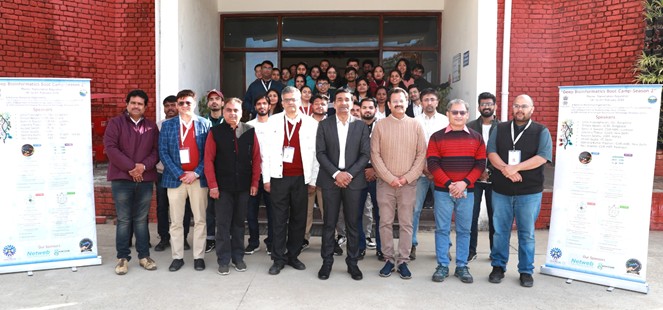
चार दिनों तक चलने वाली राष्ट्रीय बायोइन्फार्मेटिक्स कार्यशाला "डीप बायोइन्फार्मेटिक्स बूटकैंप सीज़न 2" का शुभारंभ 18 फरवरी, 2025 को सी.एस.आई.आर.-हिमालय जैवसंपदा प्रौद्योगिकी संस्थान, पालमपुर में हुआ। इस वर्ष कार्यशाला का विषय है “ट्रांस्क्रिप्शनल रेगुलेशन” ।
सी.एस.आई.आर.-आई.एच.बी.टी. के निदेशक, डॉ. सुदेश कुमार यादव ने सभी प्रतिभागियों का गर्मजोशी से स्वागत किया और आशा व्यक्त कि यह कार्यशाला उनके लिए उपयोगी साबित होगी। सीएसआईआर-राष्ट्रीय वनस्पति अनुसंधान संस्थान, लखनऊ के प्रमुख वैज्ञानिक डॉ. समीर सावंत ने उद्घाटन संबोधन दिया। भारतीय विज्ञान संस्थान, बेंगलुरु की जैविक विज्ञान संकाय की डीन, प्रोफेसर उषा विजय राघवन कार्यक्रम की मुख्य वक्ता रही।
इसके बाद, प्रतिभागियों को लिनक्स और प्रोग्रामिंग पर हैंड्स-ऑन प्रशिक्षण दिया गया। इस कार्यशाला में पूरे भारत से कुल 34 प्रतिभागी प्रतिभागिता कर रहे रहे हैं, जिनमें तमिलनाडु, कर्नाटक, ओडिशा, गुजरात, सिक्किम, पंजाब, हिमाचल, हरियाणा जैसे राज्य शामिल हैं।
The 52nd Shanti Swarup Bhatnagar Memorial Tournament (SSBMT) outdoor finals sports extravaganza came to an end on 10 February 2025. The tournament saw participation of sixteen CSIR laboratories in cricket and volley ball. Altogether, a total of 20 cricket and 20 volleyball league matches, followed by semi-finals and finals in each of the sport were played. Additionally, a women's cricket match between was played.
Dr. Sudesh Kumar Yadav, Director CSIR-IHBT extended a warm welcome to all the participants and hoped that the workshop would be useful to them. Dr Sameer Sawant, Chief Scientist CSIR-National Botanical Research Institute, Lucknow gave the inaugural talk while the keynote speaker of the event was Prof. Usha Vijayraghavan, Dean of Biological Sciences, Indian Institute of Science, Bengaluru.
Subsequently, hands-on training on Linux and Programming was imparted to the participants. A total of 34 participants from all over India including states like Tamil Nadu, Karnataka, Odisha, Gujarat, Sikkim, Punjab, Himachal, Haryana are participating in the workshop.
52nd Shanti Swarup Bhatnagar Memorial Tournament (SSBMT)
closeसीएसआईआर-आईएचबीटी में 52वें शांति स्वरूप भटनागर मेमोरियल टूर्नामेंट (SSBMT) आउटडोर फाइनल्स खेल महोत्सव का भव्य समापन
52nd Shanti Swarup Bhatnagar Memorial Tournament (SSBMT) Outdoor Final

52वें शांति स्वरूप भटनागर मेमोरियल टूर्नामेंट (SSBMT) के आउटडोर फाइनल्स का खेल महोत्सव दिनांक 10/02/25 को समाप्त हो गया। इस टूर्नामेंट में क्रिकेट और वॉलीबॉल में सोलह सीएसआईआर प्रयोगशालाओं ने प्रतिभागिता की। कुल मिलाकर, 20 क्रिकेट और 20 वॉलीबॉल लीग मैच, तदोपरांत सेमीफाइनल और प्रत्येक खेल के फाइनल मैच खेले गए। इसके अतिरिक्त, महिलाओं का एक क्रिकेट मैच भी खेला गया।
सीएसआईआर-आईएचबीटी ग्राउंड में खेले गए फाइनल मैचों में कड़ी प्रतिस्पर्धा और समर्पित प्रयास देखने को मिला।
क्रिकेट और वॉलीबॉल, दोनों खेलों के फाइनल्स में सीएसआईआर-एनएएल, बेंगलूरु ने जीत हासिल की। उन्होंने क्रिकेट में सीएसआईआर-आईआईसीटी, हैदराबाद और वॉलीबॉल में सीएसआईआर-सीईईआरआई, पिलानी को हराया। यह दिन उनके लिए स्वर्णिम रहा। सीएसआईआर-एनएएल द्वारा खेल के संयमित और शानदार प्रदर्शन की प्रशंसा की गई जिसने उन्हें विजेता बनाया।
क्रिकेट में, वेणु (सीएसआईआर-एनएएल) को प्लेयर ऑफ द मैच घोषित किया गया जबकि मेघनाथ प्लेयर ऑफ द टूर्नामेंट रहे।
वहीं वॉलीबॉल में, राघव प्लेयर ऑफ द मैच और स्वरूप को प्लेयर ऑफ द टूर्नामेंट चुना गया।
डॉ. अमित कुमार, वरिष्ठ प्रधान वैज्ञानिक, सी.एस.आई.आर.-आई.एच.बी.टी. ने आई.आई.एस.एफ. 2024 के विस्तृत प्रोग्राम की जानकारी सांझा की और धन्यवाद प्रस्ताव भी प्रस्तुत किया।
संबंधित विजेता और उपविजेता टीमों को ट्रॉफियाँ एक बड़े आयोजन में दी गईं जिसमें सुश्री नेत्रा मेती, आईएएस, एसडीएम पलमपुर और सुश्री शालिनी अग्निहोत्री, आईपीएस, पुलिस अधीक्षक, कांगड़ा विशिष्ट अतिथि के रूप में शामिल रही। कार्यक्रम में सीएसआईआर स्पोर्ट्स प्रमोशन बोर्ड के अधिकारी भी उपस्थित थे।
सुश्री शालिनी अग्निहोत्री ने टीम बिल्डिंग और अनुशासन में खेलों की भूमिका को उजागर किया। उन्होंने टूर्नामेंट में लगभग 250 खिलाड़ियों की भागीदारी पर खुशी व्यक्त की और उन्हें शुभकामनाएं दीं।
खेल प्रमोशन बोर्ड ने टूर्नामेंट के आयोजन के लिए सीएसआईआर-आईएचबीटी के प्रयासों की सराहना की। उन्होंने टीम भावना और प्रेरणा के लिए भी संस्थान को सराहा।
इससे पहले, सीएसआईआर-आईएचबीटी के निदेशक, डॉ. सुदेश कुमार यादव ने अपने संबोधन में सभी का स्वागत किया और देश भर से आये खिलाड़ियों का उनके अनुशासनपूर्ण भागीदारी के लिए धन्यवाद किया और उम्मीद जताई कि उनका धौलाधार की तलहटी में प्रवास सुखद रहा होगा। उन्होंने खिलाड़ियों को उनकी समर्पण, कठिन परिश्रम और खेल भावना के लिए प्रशंसा की। उन्होंने कहा कि ये चार दिन उत्साह से भरे हुए थे और हमेशा याद रखे जाएंगे। इसके बाद, टूर्नामेंट को समाप्त घोषित कर दिया गया।
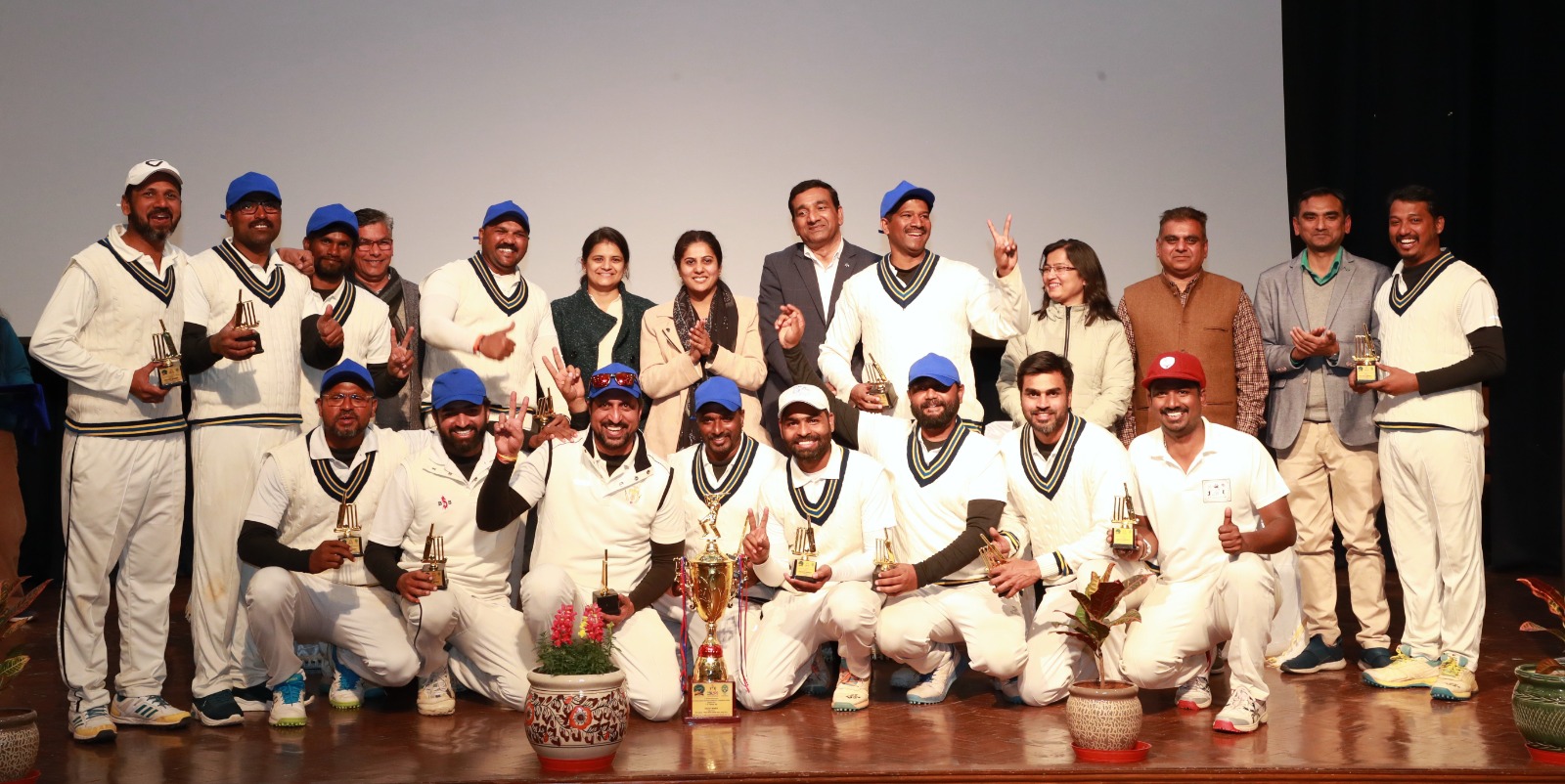
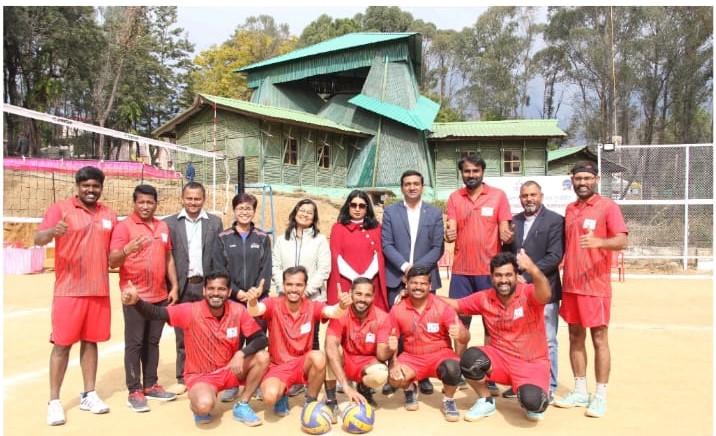
The 52nd Shanti Swarup Bhatnagar Memorial Tournament (SSBMT) outdoor finals sports extravaganza came to an end on 10 February 2025. The tournament saw participation of sixteen CSIR laboratories in cricket and volley ball. Altogether, a total of 20 cricket and 20 volleyball league matches, followed by semi-finals and finals in each of the sport were played. Additionally, a women's cricket match between was played.
The finals that were played at the CSIR-IHBT ground saw an intense competition and dedicated effort by the teams.
It was a golden day for CSIR-NAL as they won finals of both the sports defeating CSIR-IICT Hyderabad in cricket and CSIR-CEERI, Pilani in volleyball. A composed and consistent display of game by CSIR-NAL was noteworthy that helped them lift the winner trophies.
In cricket, the player of the match was awarded to Venu (CSIR-NAL) while Meghanath (CSIR-IICT) was announced player of the tournament due to his steady performance.
In volleyball, Raghav and Swaroop Bagh both from CSIR-NAL were adjudged the player of the match and player of the tournament, respectively.
The winner and runner up trophies were presented to the respective teams in a mega event wherein Ms. Netra Meti, IAS, SDM Palampur and Ms. Shalini Agnihotri, IPS, Superintendent of Police, Kangra were the guests of honour. Officials from the CSIR Sports Promotion Board were present on the occasion.
Ms. Netra Meti complimented the institute for hosting the programme. She opined that we have so much to learn from sports. She said it not only provides physical endurance but also mental agility.
Ms. Shalini Agnihotri highlighted the role of sports in team building and discipline. She was happy to note the participation of around 250 players in the tournament and wished them all the very best.
The Sports Promotion board lauded the efforts of the CSIR-IHBT in putting up the tournament and organizing it so well. They also appreciated the team for their spirit and motivation.
Prior to this, the Director CSIR-IHBT, Dr. Sudesh Kumar Yadav, in his address welcomed one-and-all and expressed his gratitude to all the players who came from across the country for their disciplined participation and hoped that their stay in the foothills of Dhauladhar was pleasant. He complimented the players for their dedication, hard work and sports spirit. He said these four day were full of excitement, joy and will always be remembered.
Subsequently, the tournament was declared closed.
Capacity Building Program on Plant Tissue Culture
closeCapacity Building Program on Plant Tissue Culture
(20th to 24th January, 2025)
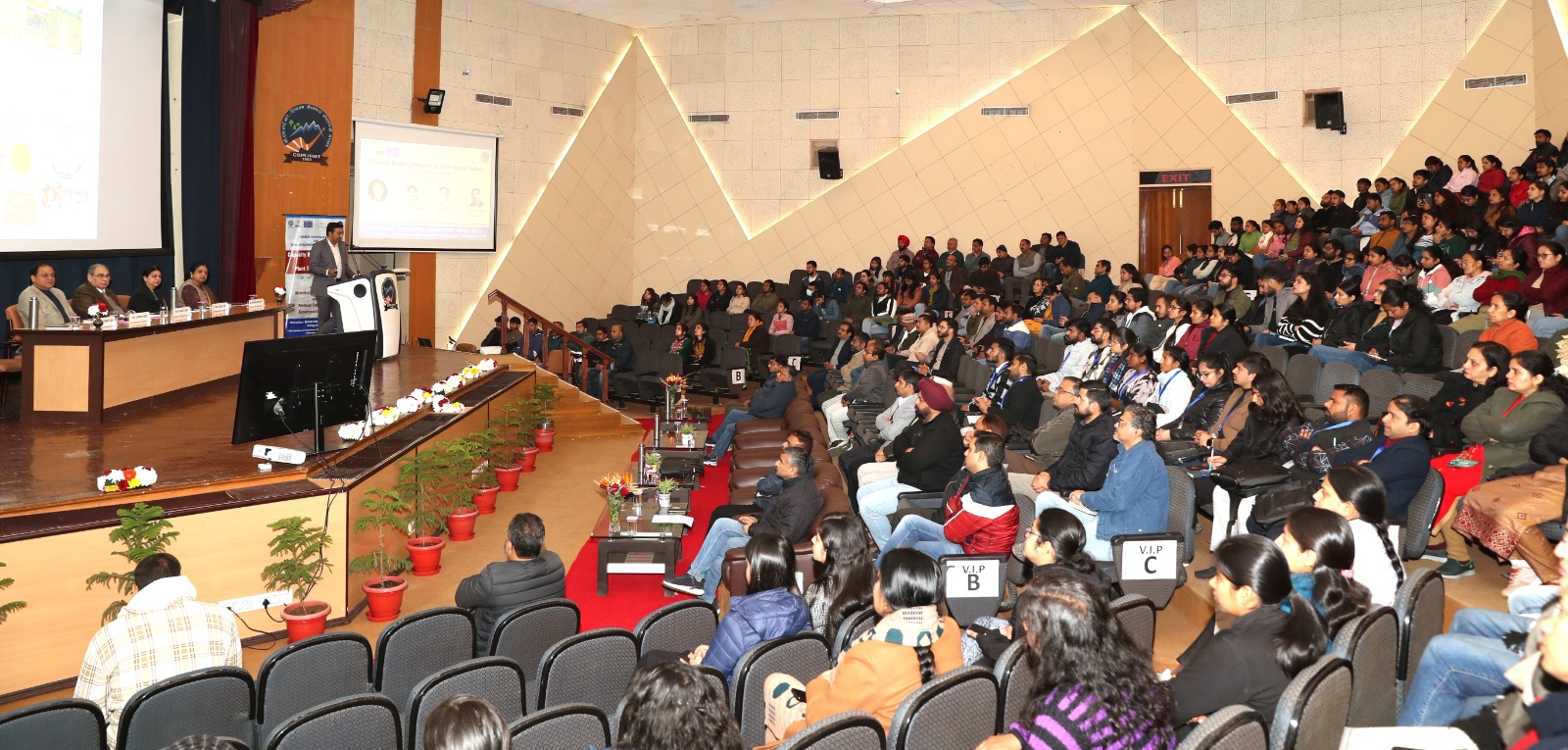
The CSIR-Institute of Himalayan Bioresource Technology is conducting a 5-day “Capacity Building Program on Plant Tissue Culture” for Empowering Masters/PhD scholars/ Industrial personnels/ Entrepreneurs/ Centre and State Government officers with Plant Tissue Culture Skills from 20th to 24th January, 2025, Funded by the Ministry of Micro, Small and Medium Enterprises, Government of India (under Advanced E-SDP training programmes). About 20 participants from different states participated in the workshop. The inaugural ceremony on 20th January 2025 witnessed the gracious presence of eminent dignitaries, including (Padma Shri) Prof. Pramod Tandon, Honorary Scientist, The National Academy of Sciences, India; Secretary, Plant Tissue Culture Association (India) and Former, Vice-Chancellor, NEHU, Shillong, as the Chief Guest, Prof. Prof. Ashwani Pareek, Executive Director, NABI, Mohali, Punjab and Dr Sneh L. Singla-Pareek, Group Leader, Plant Stress Biology, ICGEB, New Delhi, as the Guest of Honour. The occasion was further graced by Dr. Sudesh Kumar Yadav, Director, CSIR-IHBT. Dr. Sudesh Kumar Yadav, Director, CSIR-IHBT, introduced the audience to the research activities related to Plant Tissue Culture and value addition which are carried out in the institute. The Keynote Talk by Guest of Honour Dr Sneh. L. Singla-Pareek, who presented an insightful talk on the engraving problem of food shortage and how advance molecular technologies can help in tackling these problems to feed the burgeoning population. Prof Ashwani Pareek addresses on the increasing abiotic stress under changing climate scenario and different OMICS approaches to develop climate resilient crop species. Prof Pramod Tandon addresses that by using tissue culture techniques how you can develop entrepreneurship by giving examples of previous success stories. The programme was attended by the staff and scholars of the institute. Prof Pramod Tandon; Prof Ashwani Pareek and Dr Sneh Lata Singla-Pareek planted tree in the Institute under Plant4Mother campaign. On this occasion Director CSIR-IHBT exchanged MoU with Government Arya Degree College at Nurpur, Distt Kangra Himachal Pradesh for research and development.
सीएसआईआर-आईएचबीटी में साहित्यिक परिचर्चा एवं महिला कवि सम्मेलन का आयोजन
closeसीएसआईआर-आईएचबीटी में साहित्यिक परिचर्चा एवं महिला कवि सम्मेलन का आयोजन
सीएसआईआर सभागार पालमपुर में 'हिमाचल प्रदेश में हिंदी साहित्य में चित्रित समाज' विषय पर भाषा और संस्कृति विभाग हिमाचल प्रदेश और रचना साहित्य एवं कला मंच के सौजन्य से शोधपत्र पर चर्चा की गई।
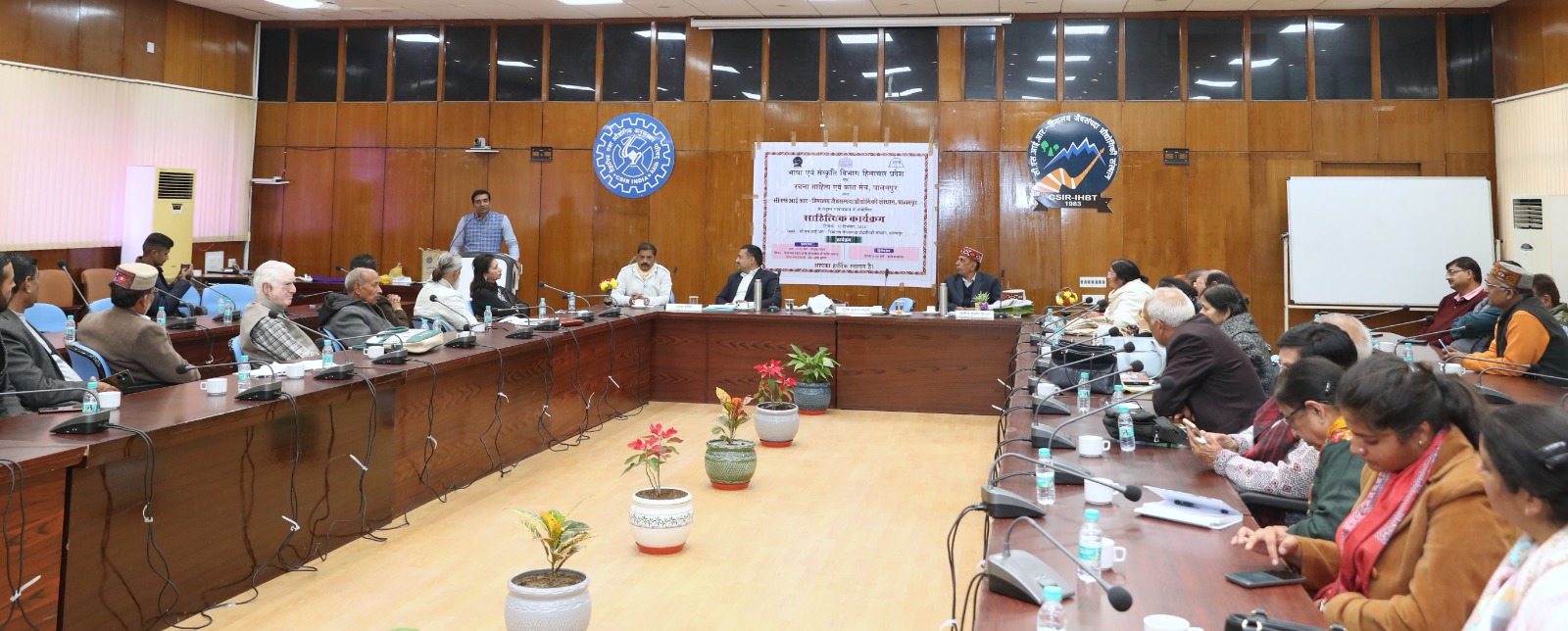
कार्यक्रम में मुख्यातिथि सीएसआईआर के निदेशक डॉ. सुदेश कुमार यादव और अध्यक्ष डॉ. सुशील कुमार फुल्ल रहे। निदेशक डॉ. यादव ने साहित्यिक कार्यक्रमों के लिए भविष्य में भी सहयोग करते रहने का आश्वासन दिया। शोधपत्र डॉ. आशु फुल्ल ने प्रस्तुत किया जिस पर त्रिलोक मेहरा, पंकज दर्शी, भूपेन्द्र जम्वाल 'भूपी' , राजीव त्रिगर्ती, गंगाराम राजी, प्रभात शर्मा, चिरानन्द आनन्द, कुशल कटोच, विक्रम गथानिया, कृष्ण चन्द्र महादेविया आदि विद्वानों ने अपने अपने विचार प्रकट किए। सहायक निदेशक भाषा एवं संस्कृति विभाग हिमाचल प्रदेश सुरेश राणा और ज़िला भाषा अधिकारी कांगड़ा अमित गुलेरी भी इस अवसर पर मौजूद रहे। द्वितीय सत्र में कवि सम्मेलन का आयोजन किया गया जिसमें रूपेश्वरी शर्मा ने पांचाली का अंतर्द्वंद्व कविता का वाचन किया। कमलेश सूद, सुमन शेखर, सुदर्शना भटेड़िया, सोनिया शर्मा, सुमन बाला, हरिप्रिया, डॉ. शिल्पी आदि ने भी अपनी अपनी रचनाओं से श्रोताओं को मंत्रमुग्ध किया। डॉ. अलका वत्स ने भजन प्रस्तुत किया जिसे सभागार में उपस्थित विद्यार्थियों ने ख़ूब सराहा।
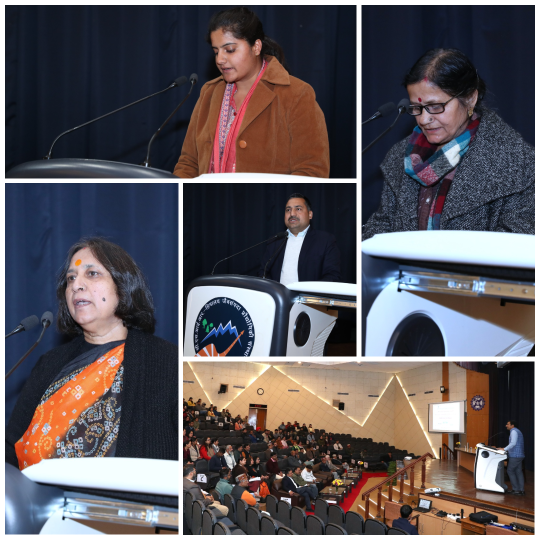
International Science Festival (IISF) curtain raiser program
closeसीएसआईआर-आईएचबीटी में इंटरनेशनल साइंस फेस्टिवल (आई.आई.एस.एफ.) के कर्टेन रेज़र कार्यक्रम का आयोजन
International Science Festival (IISF) curtain raiser program
सी.एस.आई.आर.-हिमालय जैवसंपदा प्रौद्योगिकी संस्थान, पालमपुर ने 08 नवंबर 2024 को इंडिया इंटरनेशनल साइंस फेस्टिवल (आई.आई.एस.एफ.) के कर्टेन रेज़र कार्यक्रम का आयोजन किया। आई.आई.एस.एफ. एक वार्षिक कार्यक्रम है, जिसका मुख्य उद्देश्य विज्ञान को उत्सव के रूप में मनाना है। यह लोगों और वैज्ञानिक समुदाय को एक साथ लाने , मिलकर काम करने, और जन कल्याण के लिए वैज्ञानिक कार्यों का आनंद अनुभव करने के अवसर प्रदान करता है।
इस वर्ष आई.आई.एस.एफ. 30 नवंबर से 03 दिसंबर 2024 तक गुवाहाटी, असम में आयोजित किया जाएगा, जिसका विषय "भारत को विज्ञान और प्रौद्योगिकी संचालित वैश्विक विनिर्माण केंद्र में बदलना" है। आई.आई.एस.एफ. "आधुनिक बुनियादी ढांचे और प्रकृति के साथ सामंजस्य में एक समृद्ध भारत" की परिकल्पना करता है, जो सभी क्षेत्रों के सभी नागरिकों को विज्ञान और प्रौद्योगिकी के माध्यम से अपनी क्षमता तक पहुंचने के अवसर प्रदान करता है।
सी.एस.आ.ईआर.-आई.एच.बी.टी. में कर्टेन रेज़र कार्यक्रम में, कार्यक्रम के मुख्य अतिथि, श्री कोम्पेला एस शास्त्री , राष्ट्रीय सचिव, विज्ञान भारती ने आई.आई.एस.एफ. के महत्व और वैज्ञानिक दृष्टिकोण को बढ़ावा देने में इसकी भूमिका पर प्रकाश डाला। उन्होंने देश की समृद्ध वैज्ञानिक विरासत और इसे गति देने की आवश्यकता पर विस्तार से चर्चा की।
कार्यक्रम के विशिष्ट अतिथि, डॉ. अश्विनी राणा, अध्यक्ष, विज्ञान भारती एच.पी चैप्टर और एसोसिएट प्रोफेसर, एन.आई.टी. हमीरपुर ने विकास में विज्ञान की भूमिका और इसे जनसाधारण के बीच लोकप्रिय बनाने की आवश्यकता पर बल दिया। उन्होंने एच.पी चैप्टर द्वारा किए जा रहे कार्यों और राष्ट्र निर्माण में उनकी महत्ता को प्रस्तुत किया।
इससे पहले, सी.एस.आई.आर.-आई.एच.बी.टी. के निदेशक, डॉ. सुदेश कुमार यादव ने गणमान्य व्यक्तियों और अतिथियों का स्वागत किया। उन्होंने संस्थान में किए जा रहे कार्यों के बारे में विस्तार से बताया। उन्होंने बताया कि कैसे संस्थान, सी.एस.आई.आर. मिशनों जैसे अरोमा, फ्लोरीकल्चर और फाइटोफार्मास्युटिकल के माध्यम से विकसित भारत 2047 के सपने को पूरा करने की ओर अग्रसर है। उन्होंने जनसाधारण के बीच जागरूकता सृजन और विज्ञान को लोकप्रिय बनाने की आवश्यकता को भी रेखांकित किया ताकि इसके पूर्ण लाभ प्राप्त किए जा सकें और युवा पीढ़ी को प्रेरित किया जा सके।
डॉ. अमित कुमार, वरिष्ठ प्रधान वैज्ञानिक, सी.एस.आई.आर.-आई.एच.बी.टी. ने आई.आई.एस.एफ. 2024 के विस्तृत प्रोग्राम की जानकारी सांझा की और धन्यवाद प्रस्ताव भी प्रस्तुत किया।
इस अवसर पर जिज्ञासा कार्यक्रम के अंतर्गत राजकीय वरिष्ठ माध्यमिक कन्या विद्यालय, पालमपुर की 50 छात्राओं और पीएम श्री केन्द्रीय विद्यालय, पालमपुर के 50 छात्र सभागार में उपस्थित रहे तथा संस्थान की गतिविधियों को जाना। इसके अतिरिक्त पीएम श्री केन्द्रीय विद्यालय, धर्मशाला के 116 छात्र; राजकीय माध्यमिक विद्यालय चंद्रोन, जिला कांगड़ा के 34 छात्र और केलप्पाजी कृषि इंजीनियरिंग एवं प्रौद्योगिकी महाविद्यालय तवानुर, केरल के 20 छात्र (बी.टेक. फूड टेक.) और 02 शिक्षकों ने संस्थान की अनुसंधान प्रयोगशालाओं का दौरा किया।
CSIR-Institute of Himalayan Bioresource Technology, Palampur organized the India International Science Festival (IISF) curtain raiser program on 08 November 2024.
The IISF is an annual program, the main purpose of which is the celebration of science by all. It provides opportunities to people and the scientific fraternity to come together, work together, and experience the joy of doing science for well-being.
This year the IISF will be held at Guwahati, Assam from 30 November to 03 December 2024 with the theme “Transforming India into A Science and Technology Driven Global Manufacturing Hub”. IISF envisages “A prosperous Bharat in harmony with modern infrastructure and nature, giving opportunities for all citizens of all regions to reach their potential through science and technology”.
In the curtain raiser program at CSIR-IHBT, the Chief Guest of the program, Sh. Kompella S Sastry, National Secretary Vijnana Bharati highlighted the importance of IISF and its role in promoting scientific temper with fun activities. He dwelled in detail on the rich scientific legacy of the country and the need to promote it.
The Guest of Honour, Dr. Ashwani Rana, President Vijnana Bharati HP Chapter & Associate Professor, NIT Hamirpur deliberated upon the role of science in the development and the need for its popularization amongst the masses. He presented the activities being carried out by the chapter and their importance in nation-building.
Prior to this, the Director CSIR-IHBT, Dr. Sudesh Kumar Yadav extended a warm welcome to the dignitaries and guests. He spoke in detail about the activities being carried out in the institute. He highlighted how CSIR-IHBT through CSIR missions such as the Aroma, Floriculture, and Phytopharmaceutical, is catering to the dream of Viksit Bharat 2047. He also underlined the need to create awareness and popularize science among the masses to reap its full benefit and motivate the younger generation.
Dr. Amit Kumar, Senior Principal Scientist at CSIR-IHBT, shared detailed information about the IISF 2024 program and also presented the vote of thanks.
On this occasion, 50 students from Government Senior Secondary Girls School, Palampur, and 50 students from PM Shri Kendriya Vidyalaya, Palampur, attended the programme and learned about the institute’s activities under the Jigyasa program. Additionally, 116 students from PM Shri Kendriya Vidyalaya, Dharamshala; 34 students from Government Secondary School Chandron, Kangra district; and 20 students (B.Tech. Food Tech.) along with 2 teachers from Kelappaji College of Agricultural Engineering and Technology, Tavanur, Kerala, visited the institute’s research laboratories.
Ayurveda Diwas
closeसीएसआईआर-आईएचबीटी में आयुर्वेद दिवस का आयोजन
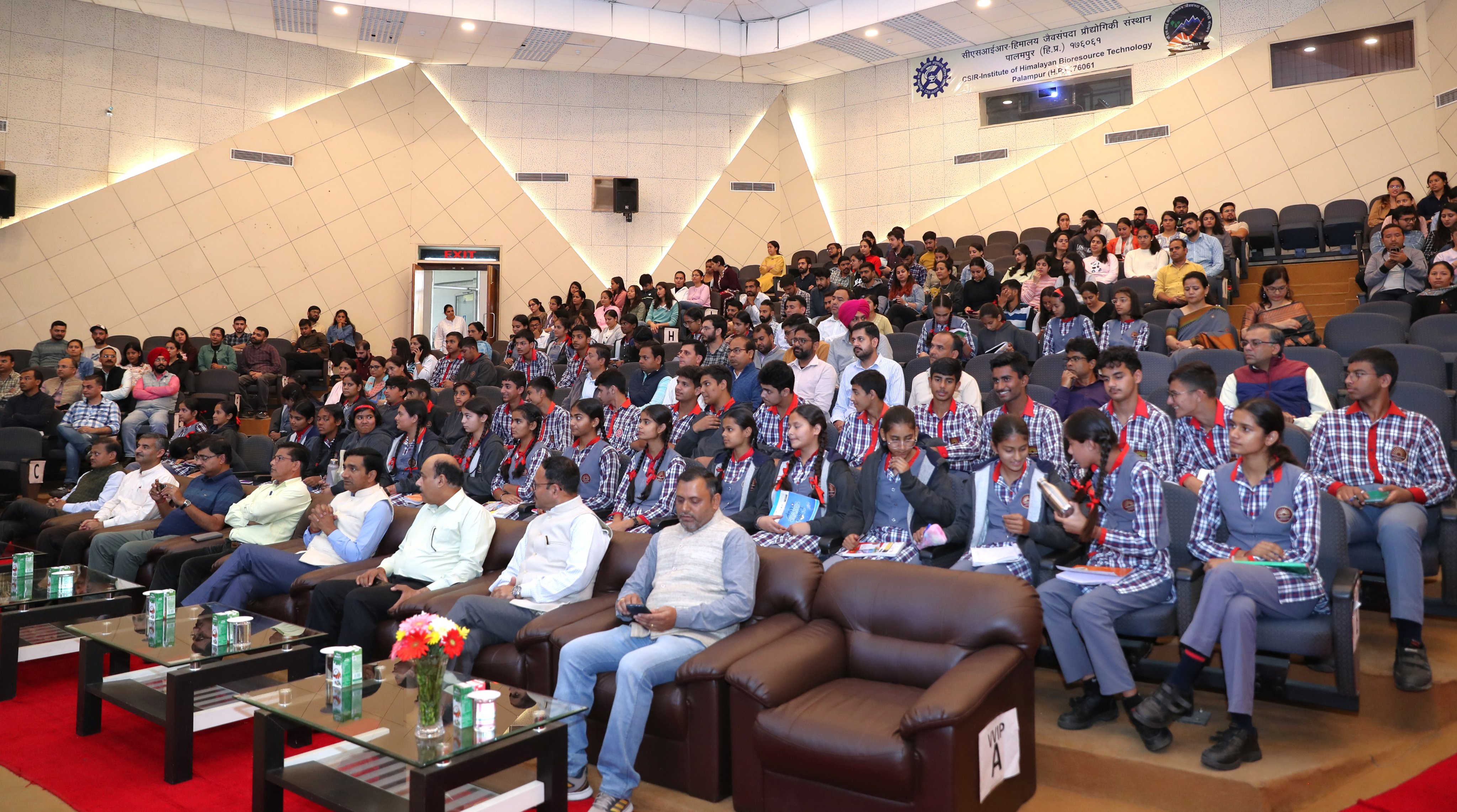
सी एस आई आर-हिमालय जैवसंपदा प्रौद्योगिकी संस्थान, पालमपुर में 29 अक्तूबर 2024 को 9वें आयुर्वेद दिवस का आयोजन किया गया। भारत सरकार आयुर्वेदिक सिद्धांतों, जड़ी-बूटियों और जीवनशैली के बारे में जागरूकता बढ़ाने के लिए वर्ष 2016 से हर साल धनवंतरी जयंती के अवसर पर आयुर्वेद दिवस मनाती आ रही है। इस वर्ष का विषय है “वैश्विक स्वास्थ्य के लिए आयुर्वेद नवाचार”।
समारोह में राजकीय आयुर्वेदिक महाविद्यालय, पपरोला के प्रधानाचार्य डा. विजय चौधरी ने उपर्युक्त विषय पर अपने संबोधन में दैनिक जीवन में आयुर्वेद, विशेष तौर पर आहार एवं जीवनशैली के महत्व पर प्रकाश डाला। उन्होने कहा कि आयुर्वेद एक मजबूत चिकित्सा प्रणाली और वैश्विक स्तर पर लगातार बढ़ रही है।
इससे पहले, संस्थान के निदेशक डा. सुदेश कुमार यादव ने अपने स्वागत संबोधन में आयुर्वेद दिवस की शुभकामनाएँ दी । उन्होंने आयुर्वेद दिवस 2024 की थीम को रेखांकित करते हुए संस्थान द्वारा इस दिशा में किए जा रहे कार्यों जैसे कि जड़ी बूटियों का दस्तावेज़ीकरण, सत्यापन और प्रामाणिकता पर विस्तार पूर्वक ब्योरा प्रस्तुत किया। साथ ही उन्होने पादप संरक्षण एवं उनके प्रसार हेतु संस्थान द्वारा किए गए कार्य भी बताए तथा इस पर और अधिक बल देने का आवाहन किया।
संस्थान के कार्मिक एवं छात्रों; आयुर्वेदिक कॉलेज, पपरोला के सदस्यों के साथ साथ केंद्रीय विद्यालय, पालमपुर के छात्रों एवं शिक्षकों ने इस कार्यक्रम में अपनी प्रतिभागिता दर्ज की।
ONE WEEK, ONE THEME
closeCSIR-IHBT Palampur, organized AGRI NUTRIBIOTECH (ANB) THEME “ONE WEEK, ONE THEME” Program
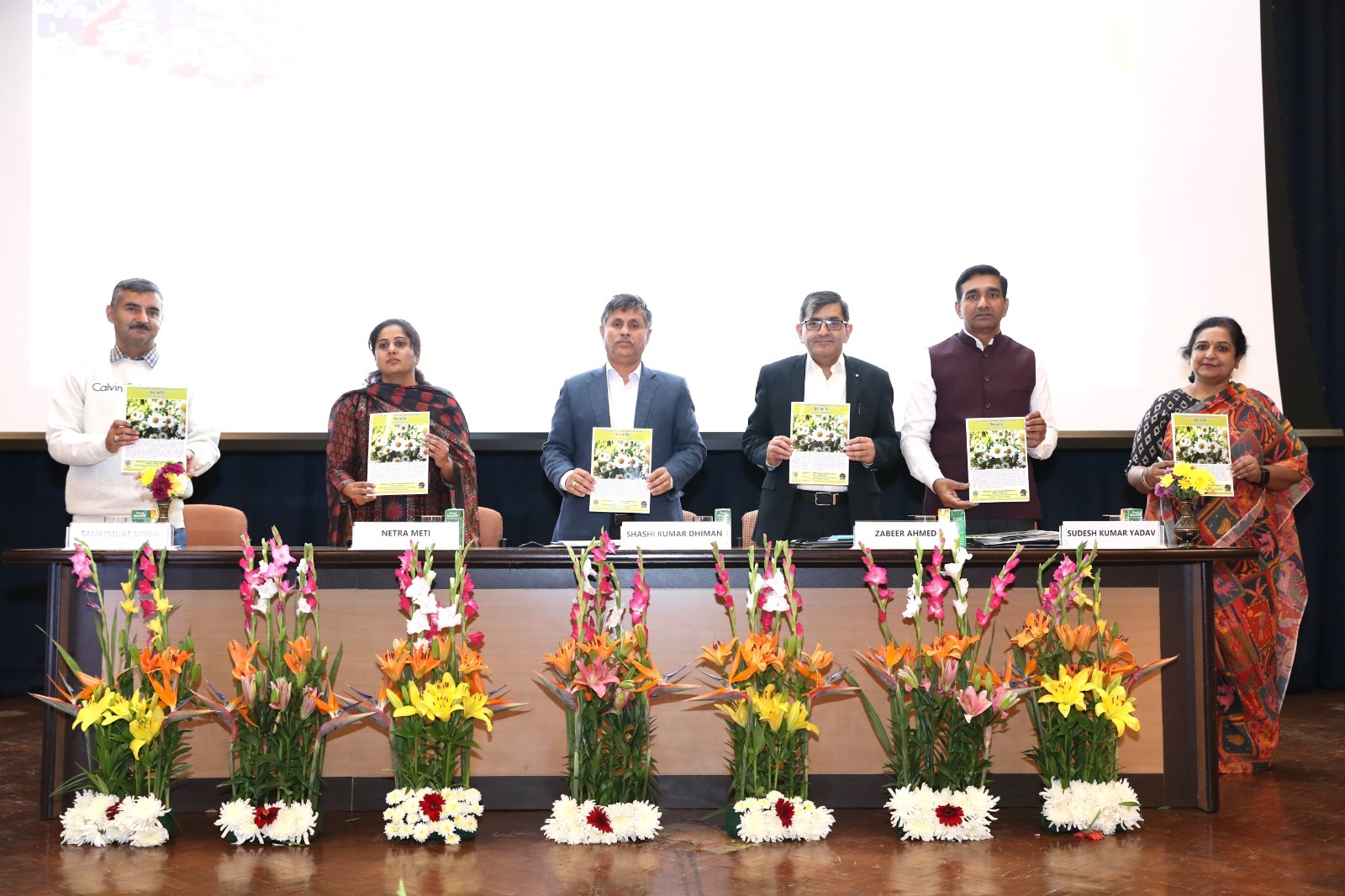
CSIR-Institute of Himalayan Bioresource Technology (CSIR-IHBT), Palampur, organized AGRI NUTRIBIOTECH (ANB) THEME “ONE WEEK, ONE THEME” Program on November 5, 2024.
Event brought together 100 farmers, entrepreneurs, startups, industrialists from HP, Mumbai, Delhi, Punjab and Ladakh, and 91 students with 6 teachers from PM SHRI Kendriya Vidyalaya Palampur and Neugal Public Sr. Sec. School, Bindraban, as part of the CSIR-JIGYASA Program.
The program was graced by distinguished guests including Prof. Shashi Kumar Dhiman, Vice Chancellor, HPTU, Dr. Zabeer Ahmed Director, CSIR- IIIM Jammu, and Madam Netra Meti, IAS (SDM Palampur). Dr. Sudesh Kumar Yadav, Director CSIR-IHBT addressed the gathering. Dr Prabodh Kumar Trivedi, Director, CSIR-CIMAP, Lucknow, also ANB Theme Director delivered the presidential address. Dr. Kannan Srinivasan, Director CSIR-CSMCRI, Bhavnagar joined the OWOT program virtually.
The program featured the release of new aromatic plant varieties. Farmers received seeds of valuable aromatic crops such as German Chamomile, Lavender, Rosemary, Palmarosa, Aromatic Marigold, and floriculture crops Lilium and gypsophila.
An exhibition highlighted advancements in agrotechnology, biotechnology, and environmental technologies. Transfer of technology for millet panjeeri to Tashvika Foods and dry flower artefacts to local self-help groups was done. Seven new startups along with mentors participated in the event. The event also included interactions with industry partners, promoting income opportunities through aromatic and floriculture farming and sustainable agricultural practices.
This initiative is aimed at empowering local farmers with sustainable practices and promoting the cultivation of aromatic and floriculture crops for increased economic benefits.
83rd CSIR Foundation Day Celebrations
closeसीएसआईआर-आई एच बी टी में 83वें सी एसआईआर स्थापना दिवस समारोह का आयोजन
सी एसआईआर-हिमालय जैवसंपदा प्रौद्योगिकी संस्थान, पालमपुर में वैज्ञानिक तथा औद्योगिक अनुसंधान परिषद् (सी एसआईआर) का 83वां स्थापना दिवस समारोह दिनांक 17 अक्टूबर 2024 को बडे़ हर्षोल्लास से मनाया गया। सन् 1942 में भारत की सबसे बड़ी परिषद, सी एसआईआर, की स्थापना हुई थी और इसे विभिन्न क्षेत्रों में अत्याधुनिक ज्ञान-विज्ञान के लिए विश्व भर में जाना जाता है। संपूर्ण भारत में अपनी 37 राष्ट्रीय प्रयोगशालाओं, 39 आउटरीच केंन्द्रो, एक नवाचार परिसर, एवं तीन यूनिट्स के माध्यम से सी एसआईआर राष्ट्र की सेवा में अपना योगदान दे रहा है।
समारोह के मुख्य अतिथि पद्मभूषण प्रो. आर.एस. परोदा, चेयरमैन, टी ए ए एस एवं पूर्व महानिदेशक, भारतीय कृषि अनुसंधान परिषद, ने सी एसआईआर को शुभकामनाएं देते हुए संस्थान की शोध गतिविधियों एवं ग्रामीण आर्थिकी के उन्नयन में महत्वपूर्ण भूमिका एवं योगदान के लिए संस्थान की सराहना की। अपने संबोधन में उन्होंने ‘उत्तरी हिमालय की कृषि जैवविविधता का प्रबन्धन’ विषय पर संभाषण दिया। उन्होने कहा कि विज्ञान ने हमें कृषि क्षेत्र में आत्मनिर्भर बनाया है। प्रत्येक पौधे में विविध गुण होते हैं जिनका उपयोग कई प्रकार की औषधियों तथा उत्पाद बनाने के लिए किया जाता है। इनका हमारे दैनिक जीवन में अत्यधिक महत्व है। अतः जैवविविधता का संरक्षण एवं सतत उपयोग होना चाहिए जिस के लिए हम सब को मिलकर कार्य करना होगा।
समारोह के विशिष्ट अतिथि, पद्मभूषण एवं पद्मश्री डॉ. अनिल जोशी, संस्थापक, हिमालयन पर्यावरण एवं संरक्षण संगठन (हेस्को), देहरादून ने अपने संबोधन में कहा कि पर्यावरण संरक्षण समय की आवश्यकता है। यदि हम अभी भी जल, भूमि, वायु, वन के प्रति जागरूक न हुए तो भावी पीढ़ी के लिए जीवन बहुत कठिन हो जाएगा। उन्होने पारिस्थितिकी पर विशेष बल दिया तथा हिमालय क्षेत्र की विशिष्ट भौगोलिक एवं सामाजिक जरूरतों पर प्रकाश डाला।
इससे पहले संस्थान के निदेशक डा. सुदेश कुमार यादव ने अतिथियों का स्वागत करते हुए संस्थान की प्रमुख वैज्ञानिक उपलब्धियों के बारे में बताया। उन्होने जैव-आर्थिकी को बढावा देने में संस्थान के सामर्थ्य तथा नए अवसरों के बारे में विस्तार से चर्चा की। उन्होने कहा, संस्थान ने पुष्प एवं सगंध फसलों की कृषि तकनीक विकसित करके किसानों एवं उद्यमियों को आत्मनिर्भता की ओर अग्रसर किया हैं। संस्थान जननी सुरक्षा कार्यक्रम के अंतर्गत पोषण से भरपूर उत्पादों को राज्य सरकार को उपलब्ध करा रहा है। उन्होने कहा, हमारा दायित्व है कि राष्ट्र एवं विश्व की अपेक्षाओं को पूरा करने की दिशा में प्रयासरत रहें।
इस अवसर पर सी एसआईआर-आई एच बी टी में 25 वर्ष का सेवा काल पूर्ण करने वाले, तथा इस वर्ष सेवानिवृत्त हुए कार्मिकों का अभिनंदन किया गया। पढ़ाई एवं खेलों में उत्कृष्ट प्रदर्शन करने वाले संस्थान के कार्मिकों के बच्चों को भी सम्मानित किया गया। साथ ही साथ संस्थान द्वारा विकसित प्रौद्योगिकियों को दो उद्यमियों तथा दीनदयाल उपाध्याय गोरखपुर विश्वविद्यालय के साथ शैक्षणिक तथा शोध कार्यो के लिए समझौता ज्ञापनों पर हस्ताक्षर भी किए गए।
इस अवसर पर एक कार्यशाला “ हिमालय में जलवायु परिवर्तन के परिदृश्य के तहत बागवानी उत्पादन को बनाए रखना” का शुभारंभ भी किया गया।
Hindi Diwas
closeहिंदी दिवस का आयोजन
सी.एस.आई.आर - हिमालय जैवसंपदा प्रौद्योगिकी संस्थान में 19 सितम्बर को हिंदी दिवस का आयोजन किया गया तथा 30 अगस्त 2024 से प्रारंभ हुए हिंदी पखवाड़े का समापन हुआ।
इस अवसर पर सीएसआईआर- राष्ट्रीय विज्ञान संचार एवं नीति अनुसंधान संस्थान(निस्पर), नई दिल्ली से विज्ञान प्रगति के संपादक डा. मनीष मोहन गोरे ने हिंदी में विज्ञान लेखन की बातें: कुछ जानी कुछ अनजानी’ विषय पर अपनी प्रस्तुति दी। अपनी प्रस्तुति में उन्होंने विज्ञान लेखन से जुड़ी बारिकियों, विज्ञान संचार के उद्देश्यों और सामाजिक लाभों के बारे में चर्चा की। उन्होंने वैज्ञानिको से अपील किया कि वे अनुसंधान के साथ-साथ अपने प्रयोग और शोध के बारे में जन सामान्य से भी संवाद स्थापित करें। ऐसे प्रयासों से आम जन में विज्ञान को लेकर एक समझ विकसित होगी तथा उनका नजरिया तार्किक होगा।
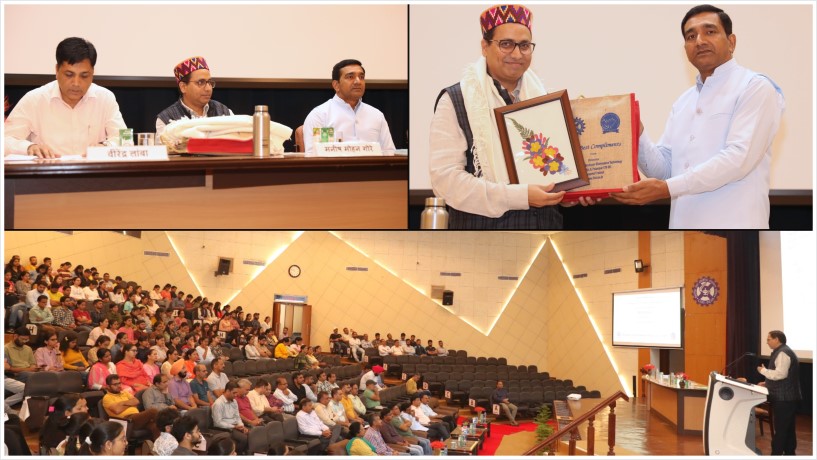
संस्थान के निदेशक डा. सुदेश कुमार यादव ने अपने संबोधन में कहा कि आज का विषय बहुत ही प्रासंगिक है। आवश्यकता है कि विज्ञान के क्षेत्र में हो रहे अनुसंधान, उपलब्धियां जन-जन तक पहुँचें, क्योंकि यदि ये उपलब्धियां आम लोगों तक नहीं पहुँचेंगी, तो ऐसे अनुसंधान की क्या सार्थकता? राष्ट्रीय स्तर पर राजभाषा हिन्दी ही एक ऐसी भाषा है जिसके माध्यम से वैज्ञानिक उपलब्धियों को जन-जन तक पहुँचाने का कार्य सफलतापूर्वक किया जा सकता है। उन्होंने वैज्ञानिकों से आह्वान किया कि वे अपने शोध को जन साधारण तक पहुंचाने की दिशा में प्रयास करें। हिंदी माध्यम से तैयार करके संस्थान का एक वार्षिक प्रकाशन के रूप में तैयार करें। साथ ही शोध एवं विकास संबन्धी उपलब्धियों को जन-जन तक पंहुचाने की दिशा में संस्थान द्वारा अंग्रेजी में प्रकाशित संस्थान की शोध उपलब्धियों की सफलता की कहानियों को हिंदी अनुवाद उपलब्ध कराने की कृपा करें ताकि अंतिम संपादन करके इसे प्रकाशित किया जाए। उन्होंने हिंदी पखवाड़ा के अंतर्गत आयोजित की जाने वाली प्रतियोगिताओं के विजेताओं को अपनी शुभकामनाएं दीं तथा सभी कर्मियों से आह्वान किया कि इनसे प्रेरणा लेते हुए आने वाले समय में इन आयोजनों में अपनी सक्रिय प्रतिभागिता सुनिश्चित करें।
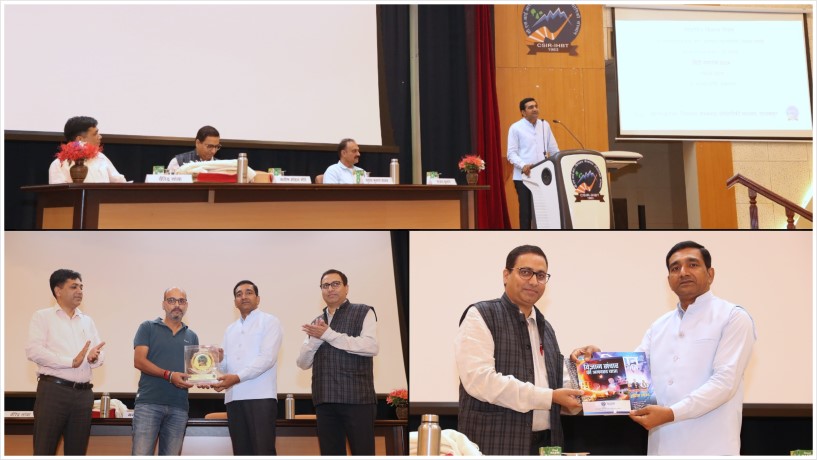
इस अवसर पर विभिन्न प्रतियोगिताओं के विजेताओं को पुरस्कृत भी किया गया। मंच का संचालन संस्थान के हिंदी अधिकारी श्री संजय कुमार ने किया तथा प्रशासनिक अधिकारी श्री वीरेन्द्र लाम्बा ने धन्यवाद ज्ञापन प्रस्तुत किया।
42nd CSIR-IHBT Foundation Day Celebrations
closeसीएसआईआर-आईएचबीटी, पालमपुर का 42वां स्थापना दिवस समारोह
42nd Foundation Day Celebrations of CSIR-IHBT
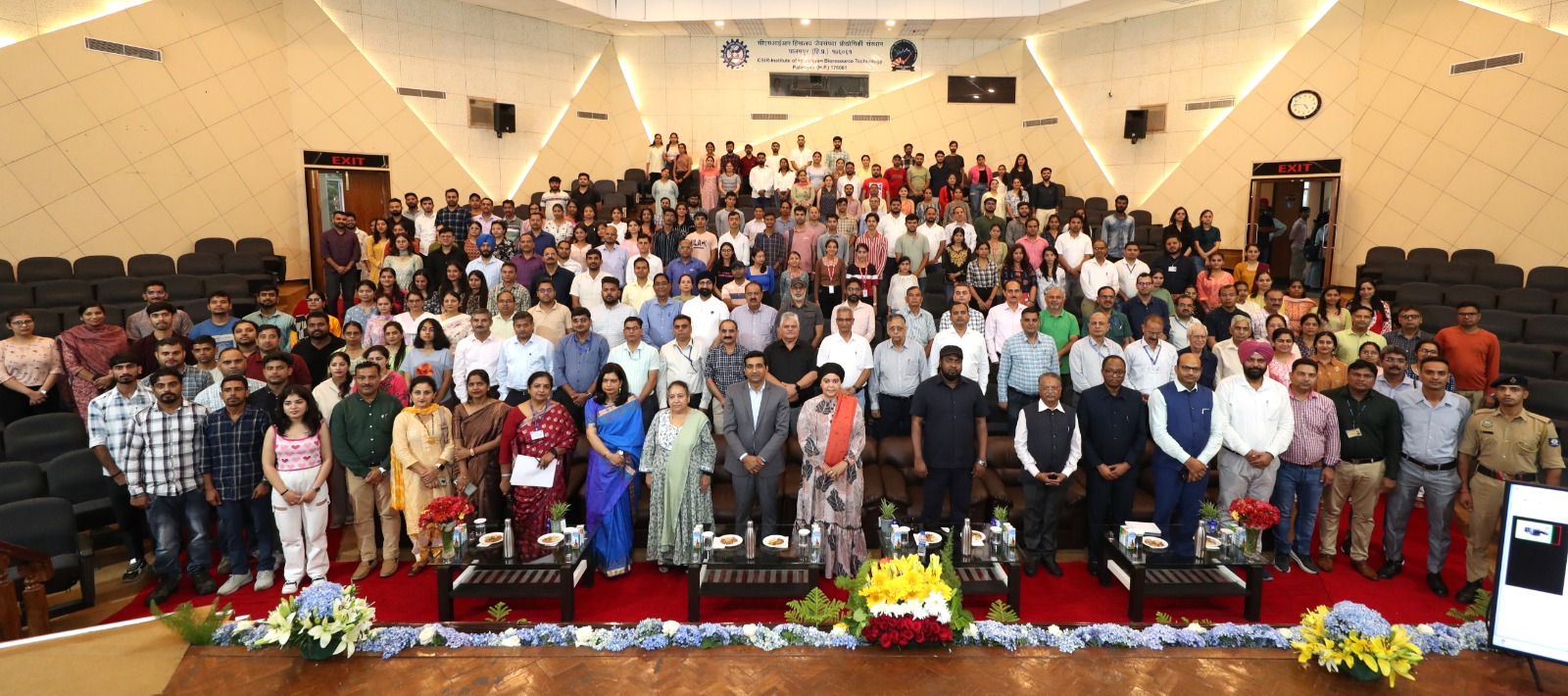
सी एस आई आर-हिमालय जैवसंपदा प्रौद्योगिकी संस्थान, पालमपुर ने 2 जुलाई 2024 को अपना 42वां स्थापना दिवस मनाया।
इस अवसर पर मुख्य अतिथि डॉ. (श्रीमती) एन. कलैसेल्वी, माननीय महानिदेशक, सी एस आई आर एवं सचिव डी एस आई आर, भारत सरकार ने संस्थान के कार्य की सराहना और स्थापना दिवस की हार्दिक बधाई दी।। अपने संबोधन में उन्होने कहा कि विज्ञान एवं प्रौद्योगिकी से देश को बहुत अधिक उम्मीद है। अतः हमारा दायित्व है कि राष्ट्र एवं विश्व की अपेक्षाओं को पूरा करने की दिशा में प्रयासरत रहें। हिमालय में अपार संभावनाएं है एवं संस्थान को जैवसंपदा से जैवार्थिकी की ओर सदा अग्रसर रहना चाहिए।
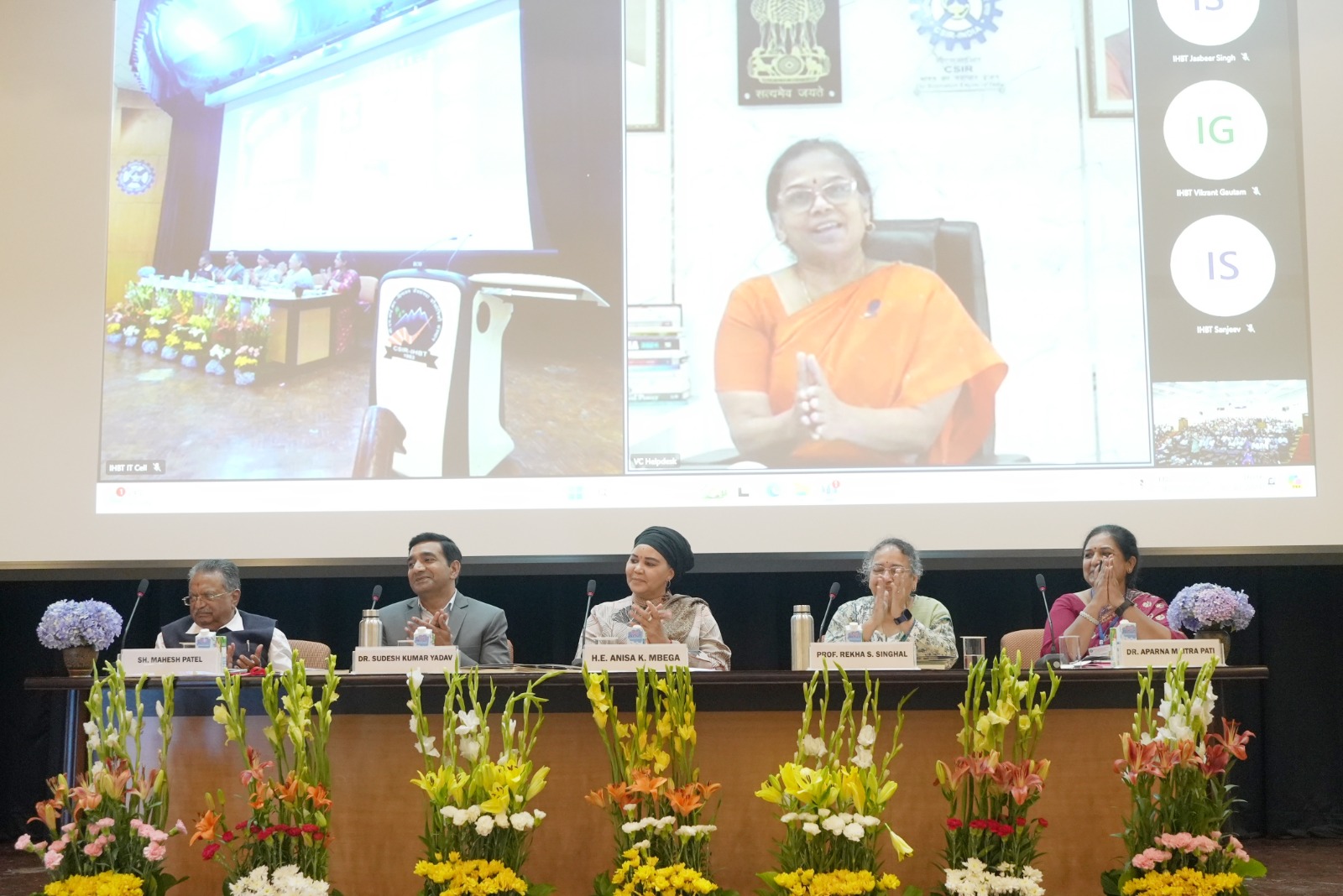
समारोह की विशिष्ट अतिथि महामहिम अनीसा के. बेगा उच्चायुक्त, संयुक्त गणराज्य तंजानिया उच्चायोग, भारत, नई दिल्ली ने अपने संबोधन में सी एस आई आर-आई एच बी टी स्थापना दिवस की शुभकामनाएं देते हुए संस्थान की उपलब्धियों की सराहना की। उन्होने कहा जैवसंपदा जीवन का आधार हैं और दोनों देश मिलकर इस क्षेत्र में आगे बढ़ सकते हैं।
प्रो. रेखा सिंघल, प्रोफेसर एवं विभागाध्यक्ष, खाद्य इंजीनियरिंग एवं प्रौद्योगिकी विभाग, रासायनिक प्रौद्योगिकी संस्थान (आईसीटी), मुंबई ने “सतत खाद्य उत्पादन एवं प्रसंस्करण - वर्तमान समय की अत्यावश्यकता” विषय पर स्थापना दिवस व्याख्यान दिया तथा 17 सतत विकास लक्ष्यों की ओर ध्यान आकर्षित किया।
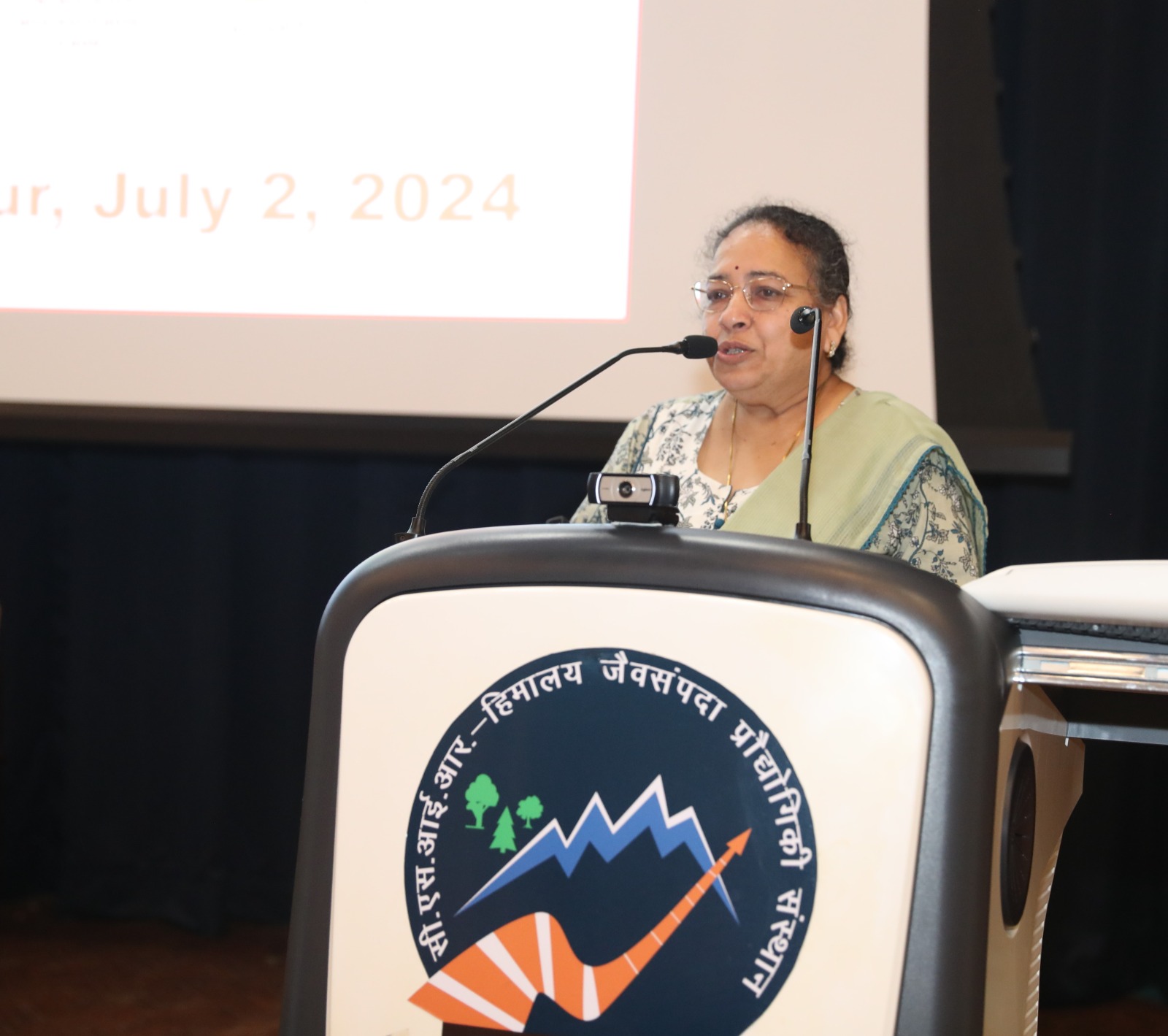
इससे पूर्व, सी एस आई आर-आई एच बी टी के निदेशक डा. सुदेश कुमार यादव ने संस्थान की उपलब्धियों पर प्रकाश डालते हुए जैवआर्थिकी को बढ़ावा देने में संस्थान का सामर्थ्य तथा नए अवसरों के बारे में विस्तार से बताया। उन्होंने बताया कि अरोमा मिशन के तीसरे चरण के अंतर्गत सी एस आई आर-आई एच बी टी ने ग्यारह राज्यों और दो केंद्र शासित प्रदेशों में सगंध फसलों की खेती के अंतर्गत क्षेत्र को बढ़ाया है। सी एस आई आर-फ्लोरीकल्चर मिशन के अंतर्गत हिमाचल प्रदेश, पंजाब, हरियाणा, उत्तराखंड और लद्दाख के लगभग एक हज़ार किसानों को गुणवत्ता युक्त रोपण सामग्री वितरित की गई है।
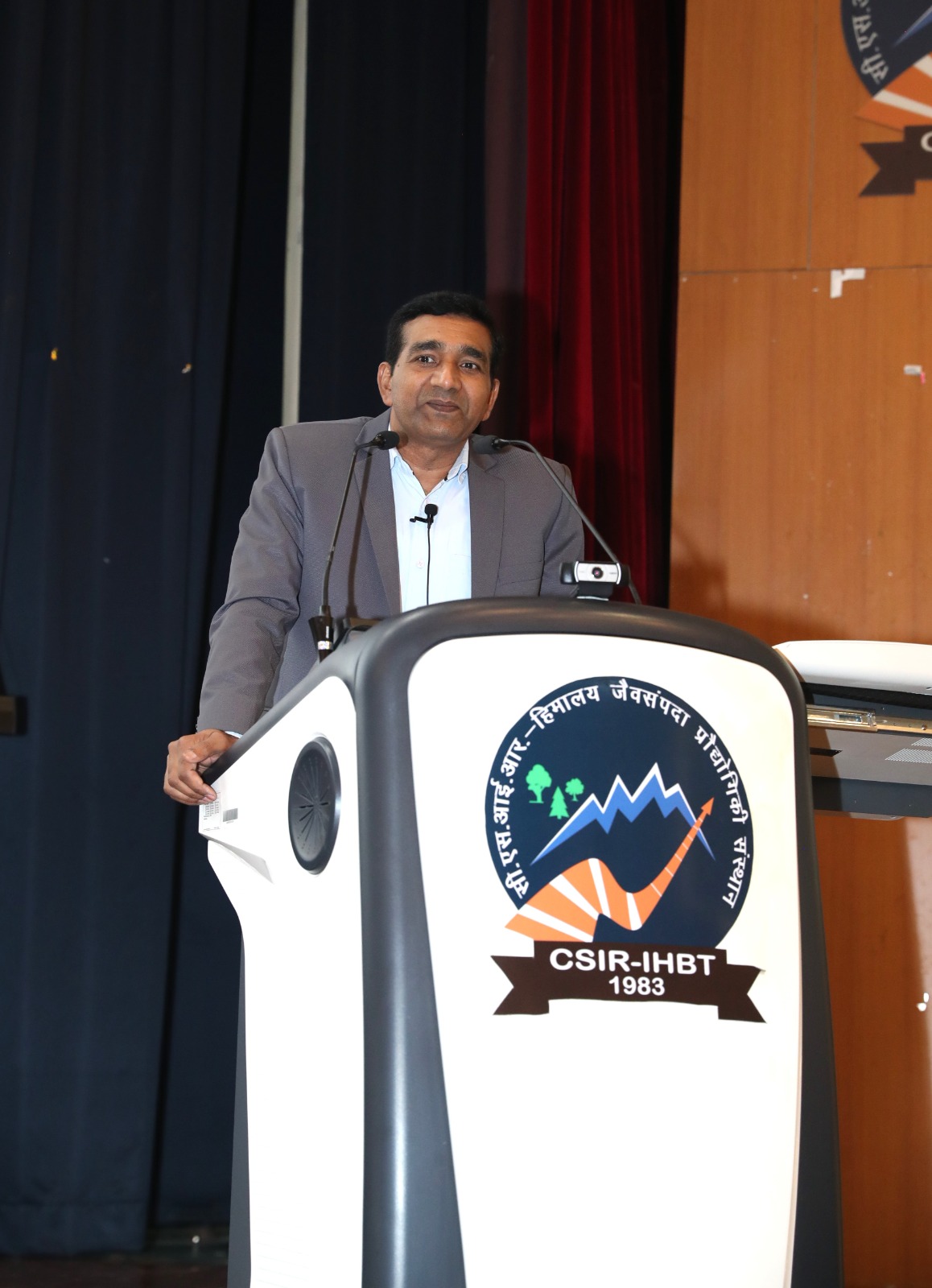
इस अवसर पर संस्थान के वार्षिक प्रतिवेदन 2023-24 तथा सी एस आई आर-आई एच बी टी सक्सैस स्टोरिज़ का भी विमोचन किया। इसके साथ ही फ्लोरिकल्चर एवं हाइपेरिकम पर 2 ब्रोशर भी विमोचित किए गए।
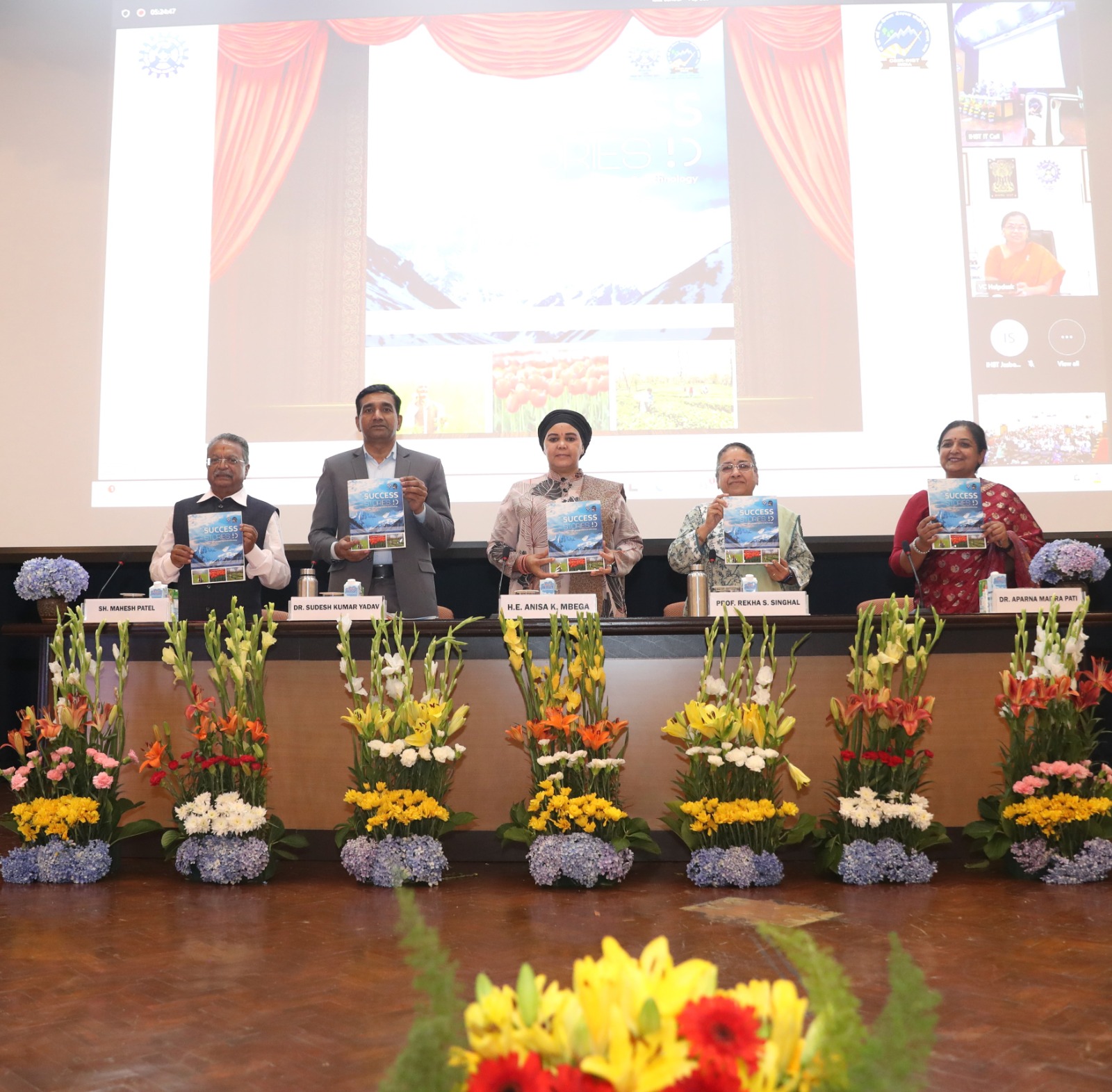
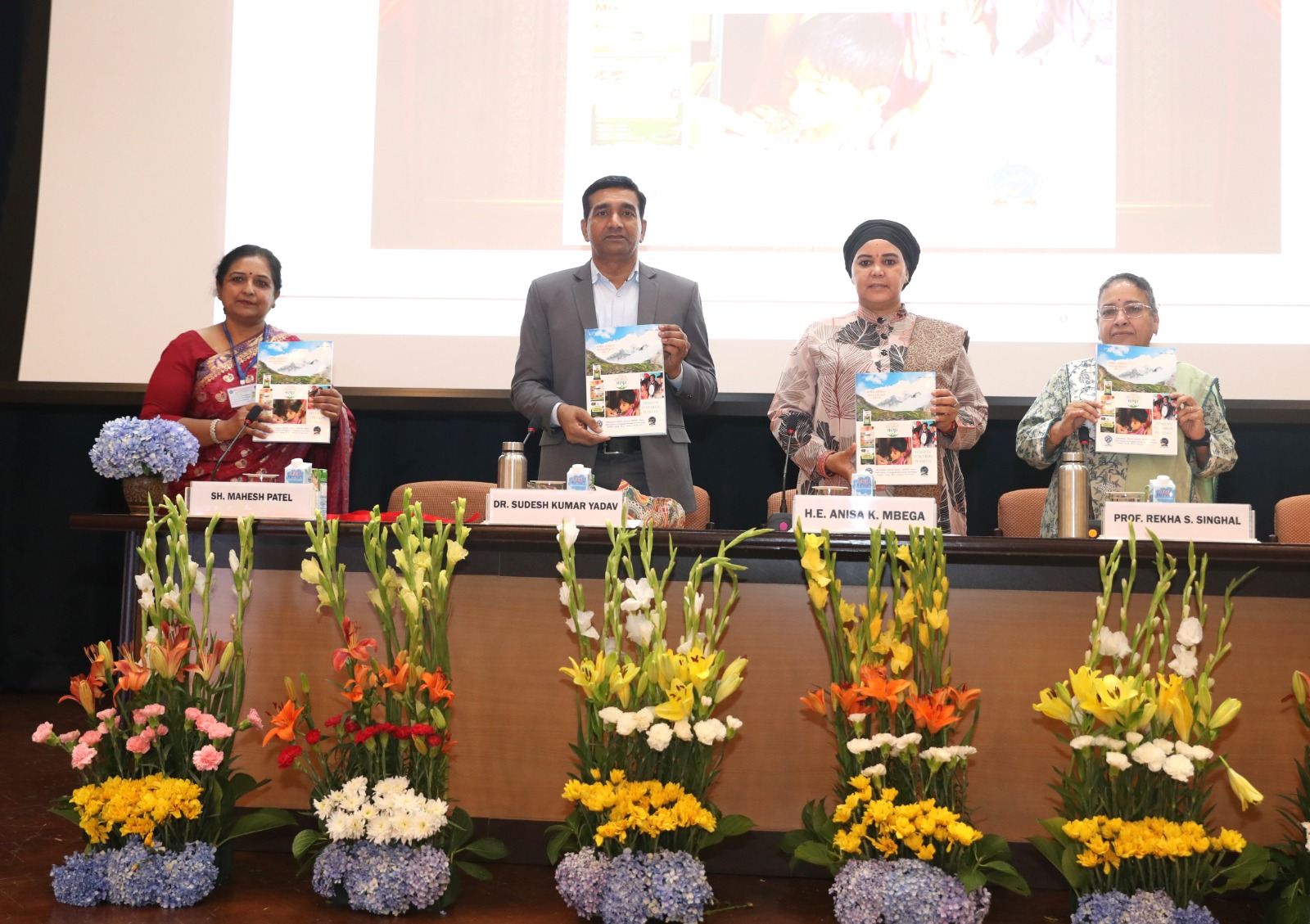
समारोह के दौरान संस्थान ने एम्पावरिंग फार्मर्स फाउंडेशन तंजानिया के साथ समझौता ज्ञापन पर हस्ताक्षर किए। साथ ही दो प्रौद्योगिकी हस्तांतरण समझौते, ज़नानी नुट्रसनल्स प्राइवेट लिमिटेड, तमिलनाडू एवं मनी एंड कंपनी, अंब, भी किए गए। किसानों को सगंध पादप के बीज भी वितरित किए गए।
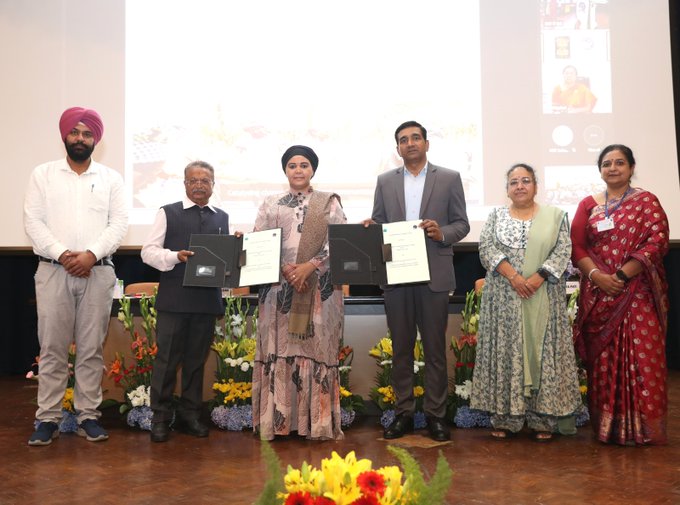
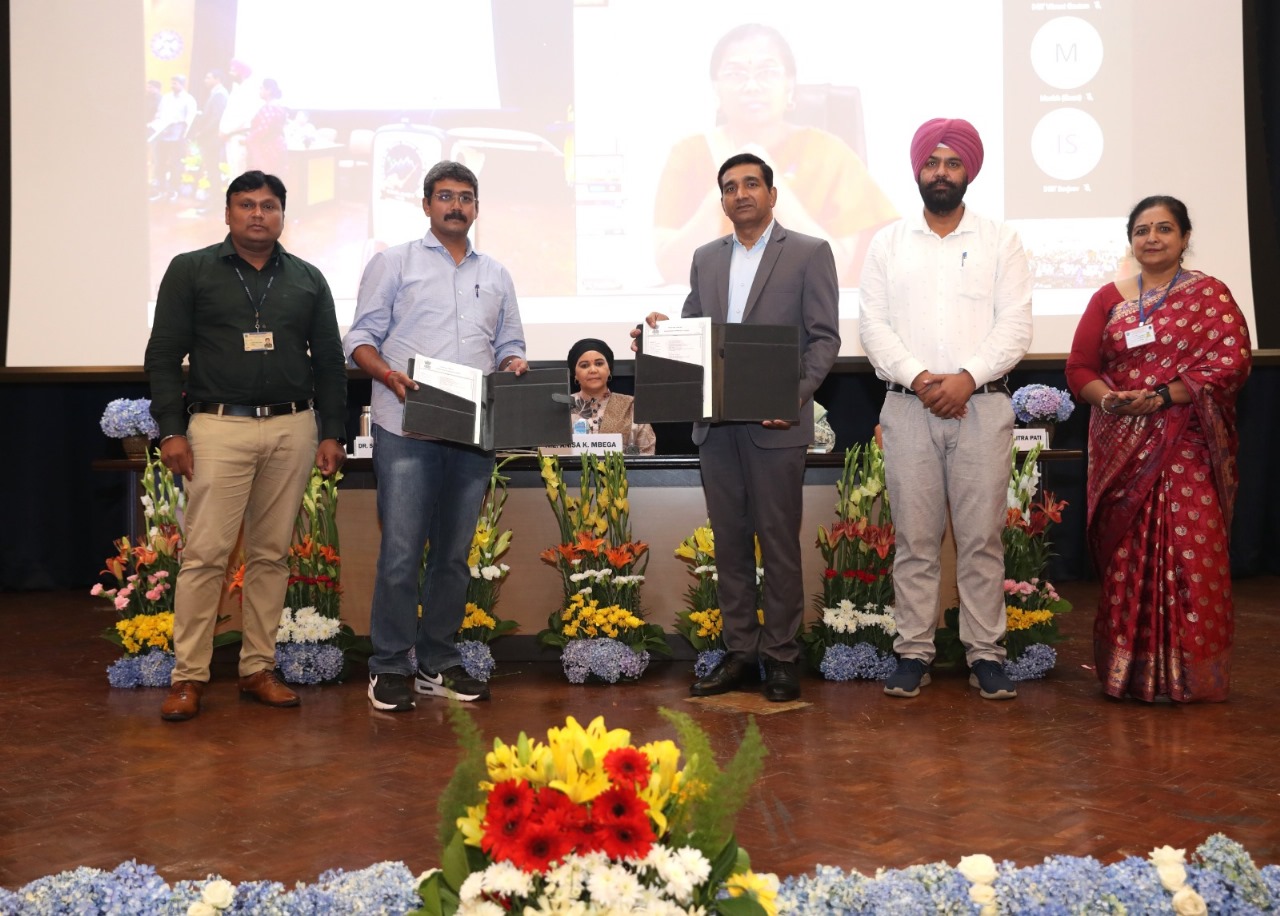
स्थापना दिवस के अवसर पर संस्थान में टाईप-4 के नवनिर्मित आवासों, होस्टल परिसर में व्यायामशाला, स्वायत हरित गृह का उद्घाटन तथा बनूरी फार्म की चारदिवारी निर्माण का शिलान्यास भी किया। उद्यमियों, स्टार्ट-अप के साथ विचार विमर्श एवं एक प्रदर्शनी का आयोजन भी किया गया।
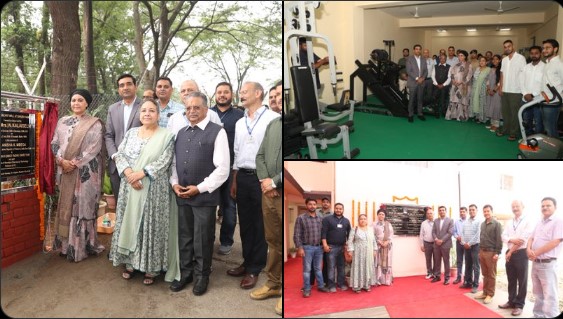
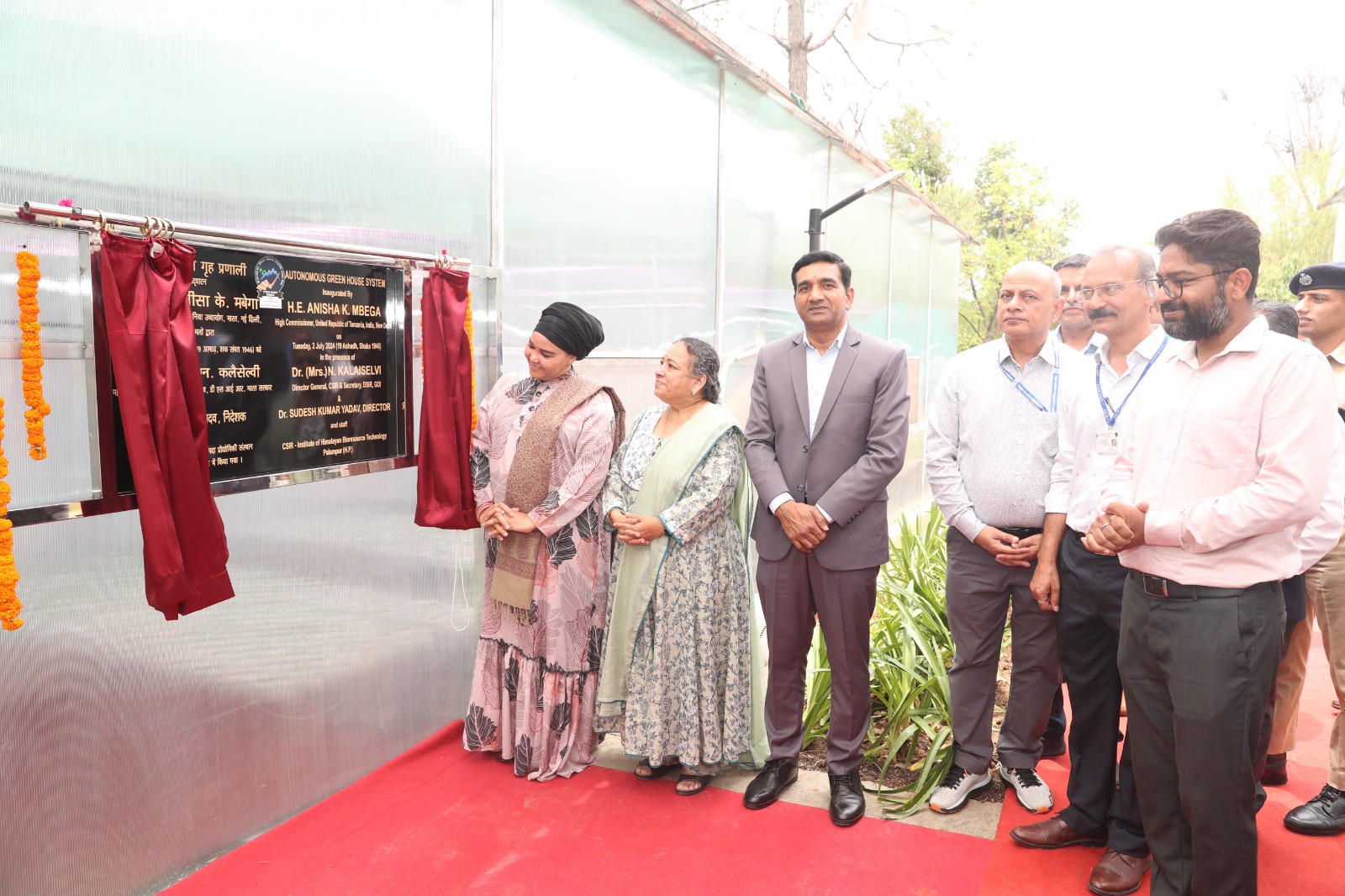
इस अवसर पर सी एस आई आर जिज्ञासा कार्यक्रम के अन्तर्गत पीएम श्री केंद्रीय विद्यालय पालमपुर, जिला काँगड़ा, हिमाचल प्रदेश के 50 छात्रों व 03 अध्यापकों नें भाग लिया । कृषि विश्वविद्यालय के 50 छात्रों तथा काशी हिन्दू विश्वविद्यालय, बनारस के 30 छात्रों ने संस्थान की शोध एवं विकास गतिविधियों का अवलोकन किया।
समारोह में संस्थान के कर्मचारी, छात्र, पूर्व कमर्चारी, उद्यमी एवं उत्पादक, नगर के गणमान्य व्यक्ति, तथा मीडिया के प्रतिनिधि भी शामिल हुए।
Swachhata Pakhwada - 2024
closeस्वच्छता पखवाड़ा - 2024
Swachhata Pakhwada 2024
(1-15th May 2024)
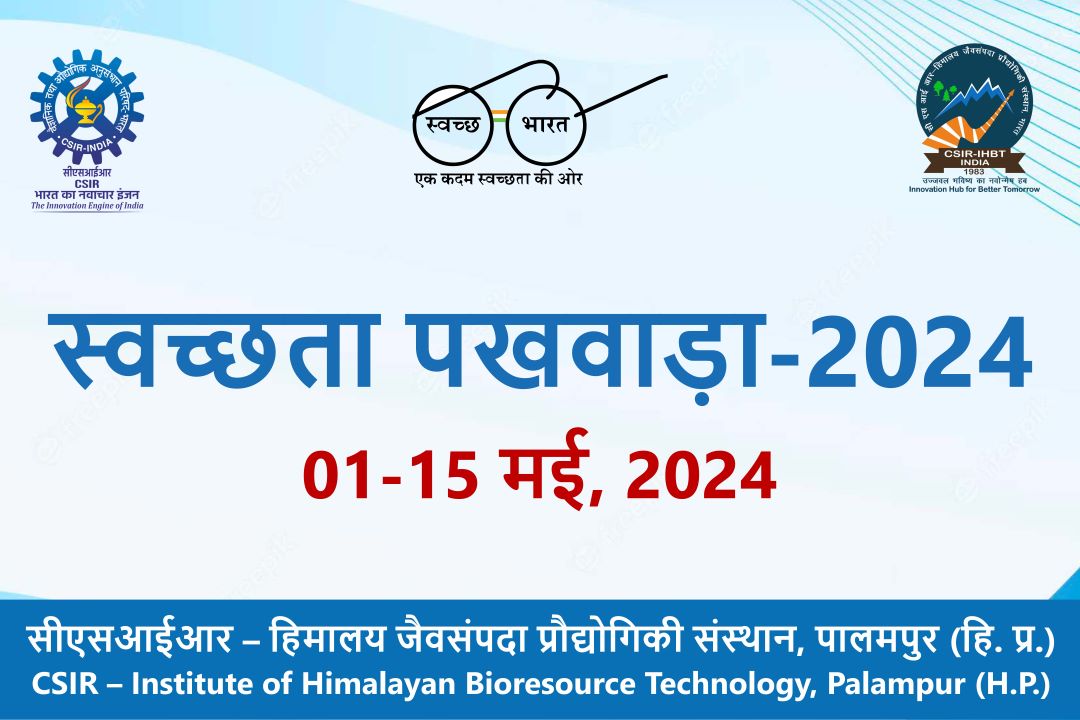
CSIR-IHBT is celebrating Swachhata Pakhwada from 1st-15th May 2024. On first day, Director CSIR-IHBT administered the Mass Swachhta pledge to all the staff members & research scholars. This was followed by Swachhata Rally from the Directorate towards the main gate and residential complex.
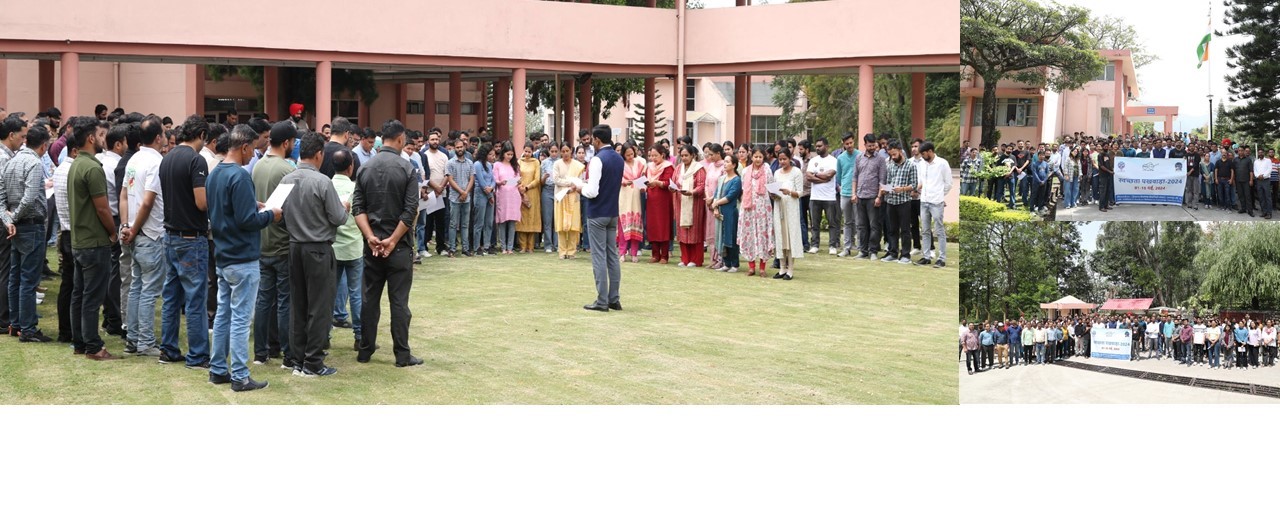
On 2nd May 2024, a plantation drive was organized in CSIR-IHBT Campus. Annual floriculture seedlings (Marigold and Tuberose) were planted by Director, scientists, along with staff members & research scholars.
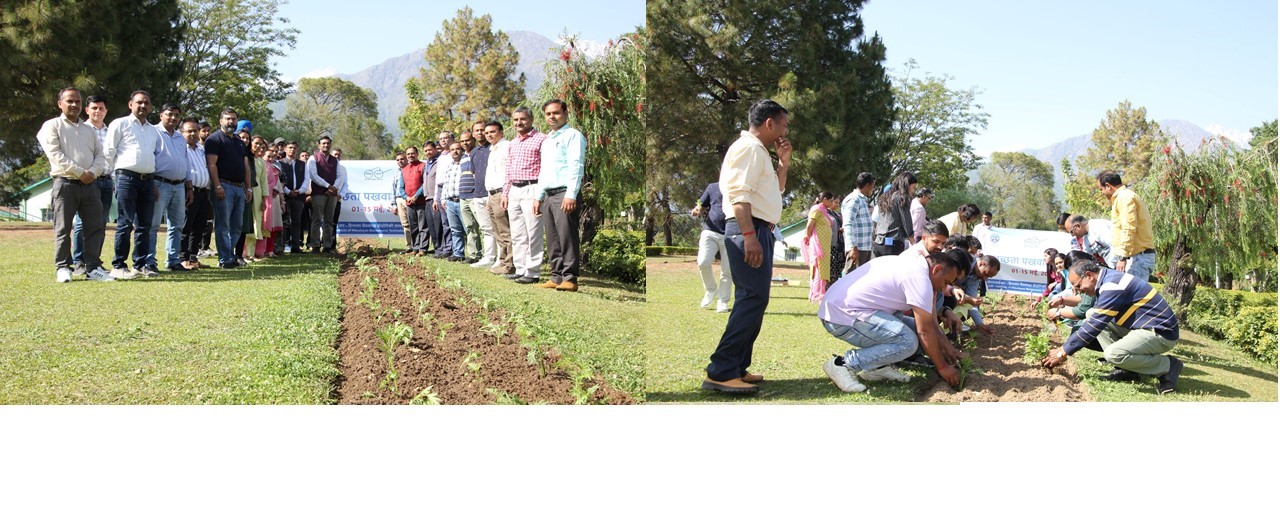
On 3rd May there were a mass awareness program was held at Neugal Public Sr. Sec. School, Bindraban engaging 200 students and 20 teachers. The event was conducted under the aegis of CSIR-Jigyasa program. Focused on "Waste to Wealth," the event showcased the institution's ongoing R&D activities on innovative waste management solutions through lectures and exhibitions. It was conducted by research scholars.
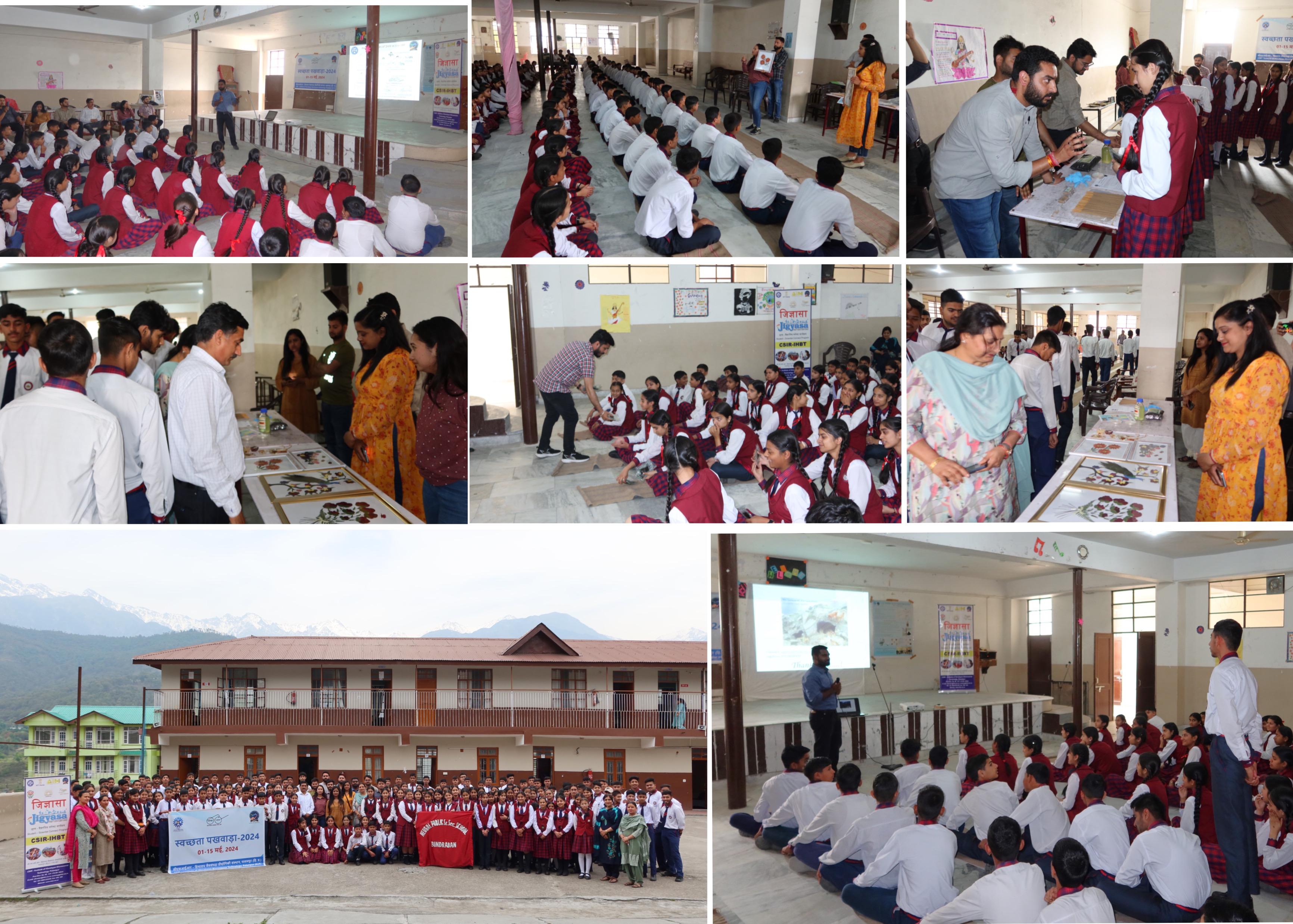
The cleanliness drive was carried out in residential colonies and hostel buildings on day 4 of Swachhata Pakhwada. The director, staff members, and research scholars participated in the cleanliness drive.
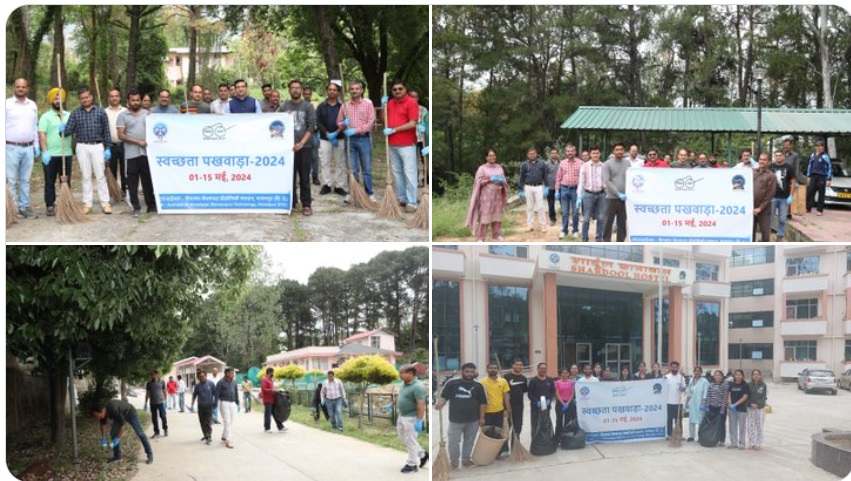
A painting exhibition was organized on two themes viz., Clean and Green India and Waste to Wealth in the institute on 7th May 2024. School children of the IHBT staff members and IHBT research scholars/project fellows participated in the event (40 no). The event was conducted by CSIR-IHBT, Palampur under the aegis of the CSIR-Jigyasa program.
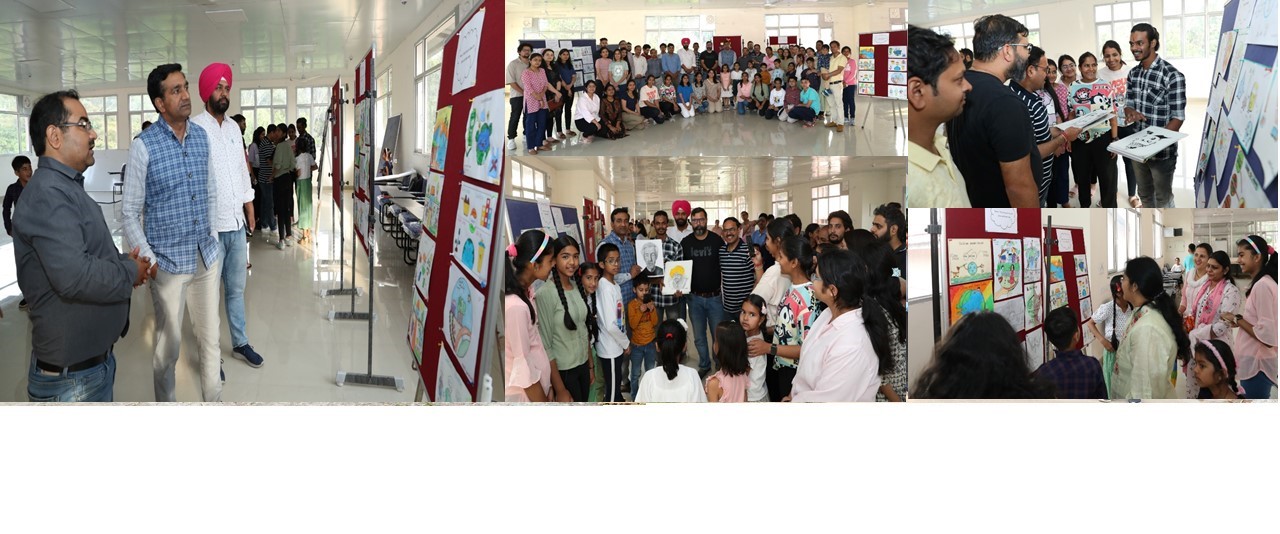
As a part of Swachhata Pakdwada, a 'Nukkad Natak on Swachhata' was organized on May 8, 2024. In addition to the staff and scholars, family members of Institute's staff also attended the programme.
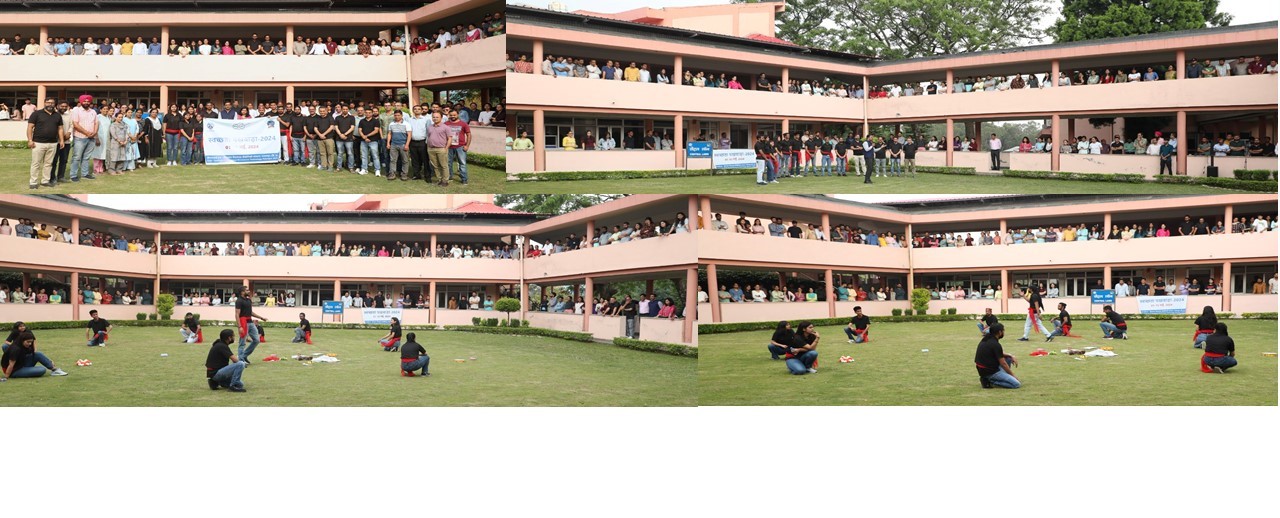
A slogan writing competition for spreading awareness on different aspects of cleanliness was organized on May 9, 2024. Staff members, research scholars, and staff wards participated in the event.
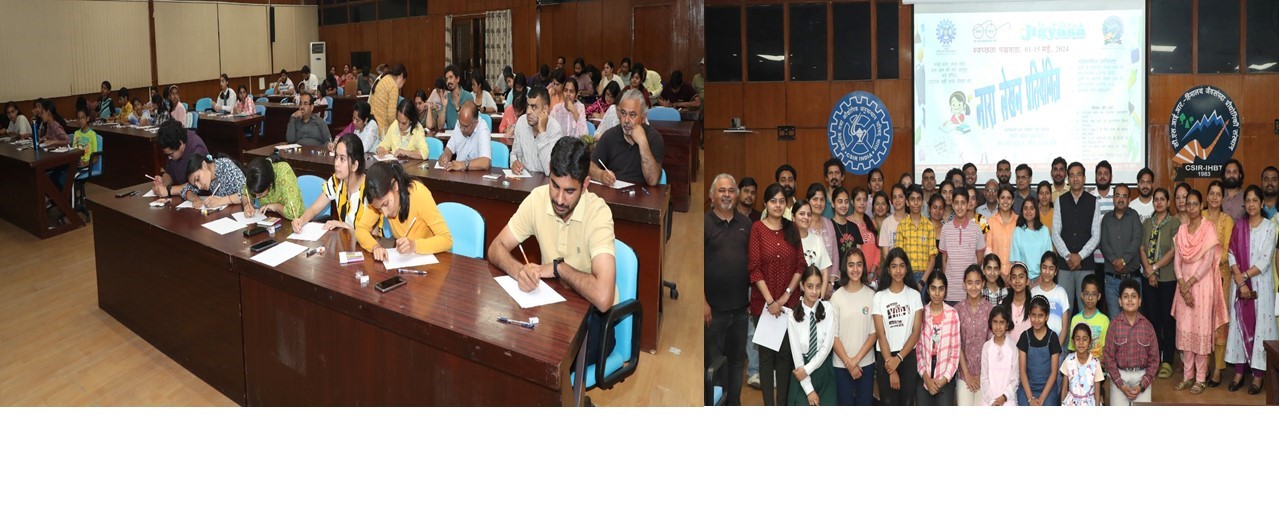
A signature campaign was launched on May 13, 2024 to abide by the cleaning statements for maintaining healthy and fresh environment in the campus.

A cleanliness drive was organized at the CSIR-IHBT guest house to spread awareness on different aspects of cleanliness on May 14, 2024. Staff member of the Institute participated in the event.
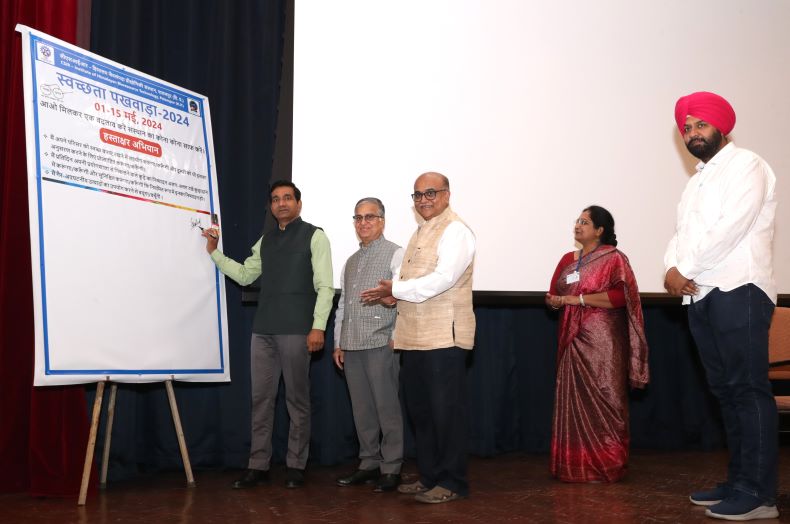
A cleanliness drive was organized at the CSIR-IHBT guest house to spread awareness on different aspects of cleanliness on May 14, 2024. Staff member of the Institute participated in the event.
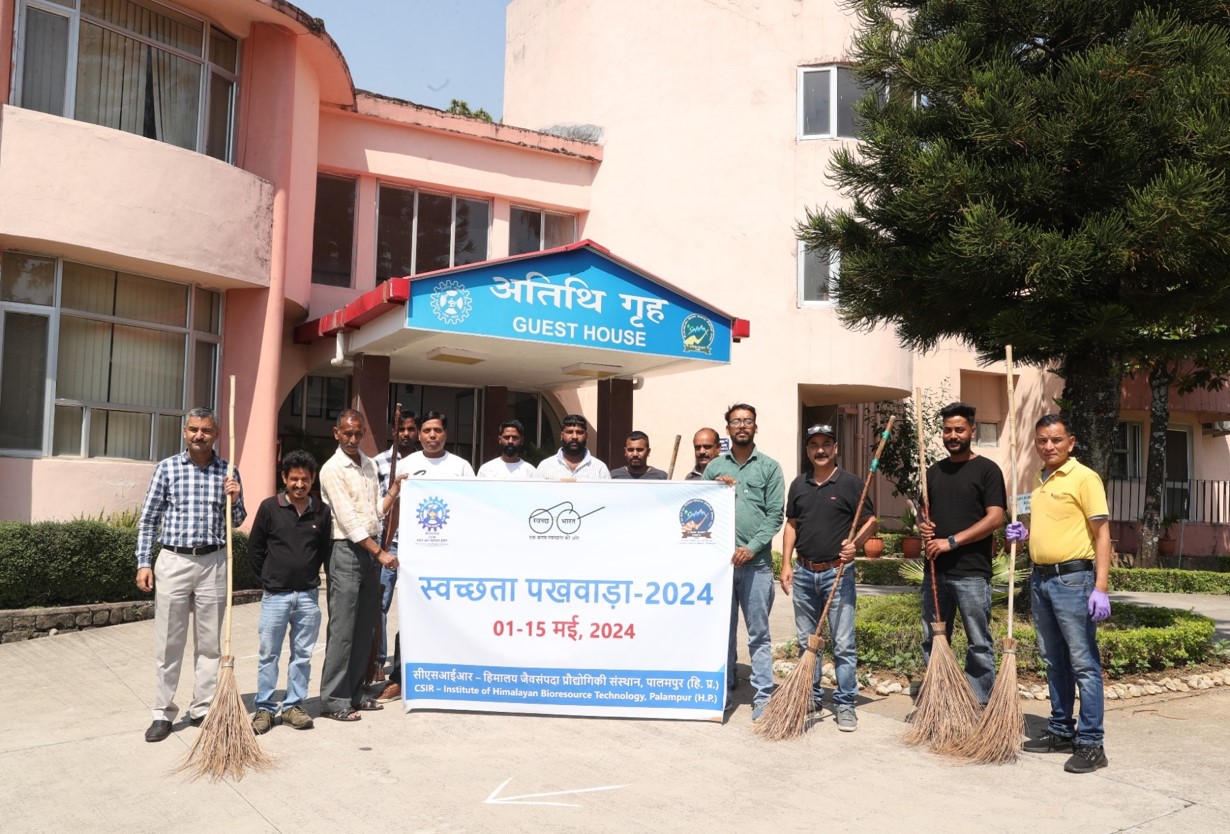
The closing ceremony of Swachhata Pakhwada was held at CSIR-IHBT on May 15, 2024. The institute had been actively participating in Swachhata Pakhwada from May 1st to May 15th, 2024, engaging in a variety of activities including campus and residential area cleanliness drives, Nukkad natak, painting, and slogan writing competitions.
During the ceremony, Mr. Sanjeev Sharma, Senior Scientific Officer from the Pollution Control Board in Dharamsala, delivered a lecture on the rules and regulations regarding Waste Management. Dr. Sudesh Kumar Yadav, the Director of CSIR-IHBT, also addressed the audience, emphasizing the importance of individual responsibility in maintaining cleanliness in both our workplace and daily lives. The event was well-attended by the staff and research scholars of the institute
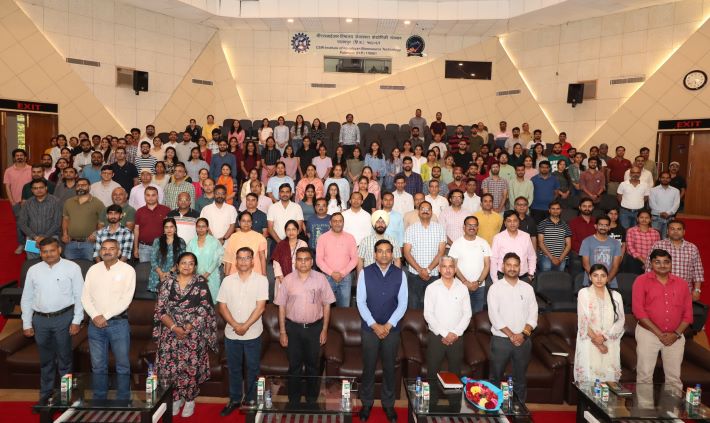
National Science Day Celebrations
closeसीएसआईआर-आईएचबीटी, पालमपुर में राष्ट्रीय विज्ञान दिवस समारोह का आयोजन
National Science Day Celebrations
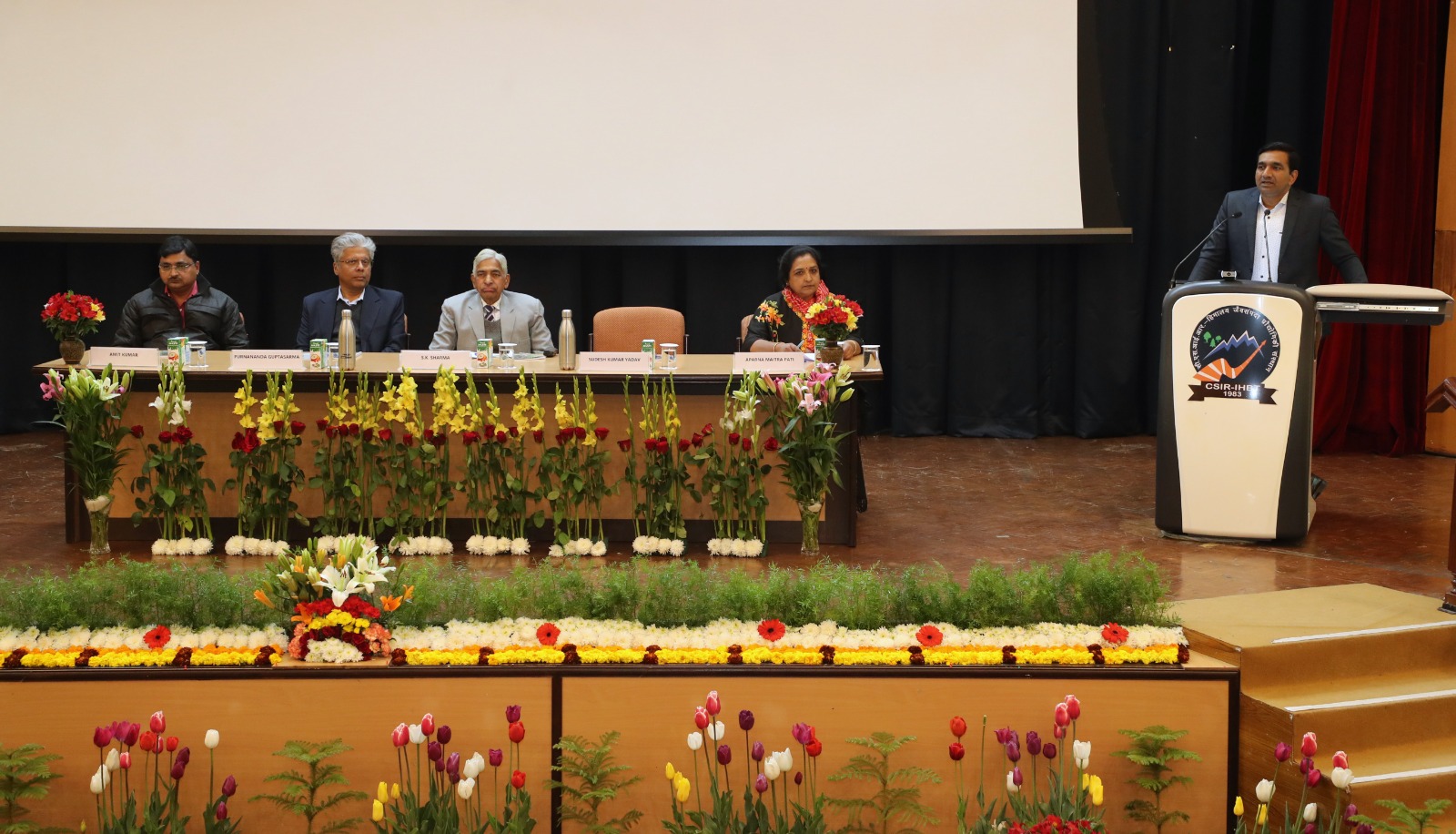
सी.एस.आई.आर.-हिमालय जैवसंपदा प्रौद्योगिकी संस्थान, पालमपुर में 28 फरवरी को राष्ट्रीय विज्ञान दिवस मनाया गया। डा. चन्द्रशेखर वैंकटरमन द्वारा 28 फरवरी 1928 को ‘रमन प्रभाव’ की खोज के लिए उन्हें 1930 में भौतिकी में नोबल पुरस्कार प्रदान किया गया था। इस उपलक्ष में यह दिन पूरे देश में राष्ट्रीय विज्ञान दिवस के रुप में मनाया जाता है। इस वर्ष का थीम “विकसित भारत के लिए स्वदेशी तकनीक” है।
इस अवसर पर मुख्य अतिथि प्रो. एस. के. शर्मा, मानद प्रोफेसर एवं पूर्व कुलपति, सीएसके हिमाचल प्रदेश कृषि विश्वविद्यालय, पालमपुर ने राष्ट्रीय विज्ञान दिवस की शुभकामनाएं देते हुए संस्थान की शोध गतिविधियों, उद्यमिता विकास और ग्रामीण आर्थिकी के उन्नयन में महत्वपूर्ण भूमिका एवं योगदान के लिए संस्थान की सराहना की। अपने संबोधन में उन्होने कहा कि स्वदेशी तकनीक के द्वारा भारत ने विश्व पर अपनी छाप छोड़ी है। कोरोना महामारी की वैक्सीन और चंद्रयान मिशन इसके नवीनतम उदाहरण हैं। उन्होंने संस्थान के वैज्ञानिकों से आवाहन किया कि टीम भावना के माध्यम से जन समुदाय के उत्थान के लिए कार्य करें ताकि 2047 तक भारत एक विकसित देश हो।
प्रो. पूर्नानंद गुप्ताशर्मा, डीन फैक्लटी, राष्ट्रीय विज्ञान शिक्षा एवं अनुसंधान संस्थान, मोहाली ने राष्ट्रीय विज्ञान दिवस संभाषण दिया। अपने संबोधन में उन्होंने कहा कि हमे पर्यावरण अनुकूल तकनीकों को बढ़ावा देना होगा। प्लास्टिक से हो रहे नुकसान पर उन्होने विशेष बल दिया। अपने संबोधन में उन्होने बहुत ही सरल शब्दों में बताया की कैसे प्लास्टिक का विघटन कर उसे पुनः उपयोगी बनाया जा सकता है। इस हेतु एंजाइम के प्रयोगों पर विशेष बल दिया तथा नवीनतम जानकारी साझा की।
संस्थान के निदेशक डा. सुदेश कुमार यादव ने स्वागत संबोधन में संस्थान की प्रमुख उपलब्धियों एवं गतिविधियों का विवरण प्रस्तुत करते हुए बताया कि संस्थान किस तरह ग्रामीण क्षेत्रों में विज्ञान, तकनीक और नवाचार के माध्यम से किसानों की आय बढ़ाने में सक्रिय भूमिका निभा रहा है ताकि देश आत्मनिर्भर हो सके। व्यवसायिक रूप से महत्वपूर्ण पौधों की रोपण सामग्री उपलब्ध कराने एवं ग्रामीणों के कौशल विकास में संस्थान निरंतर लगा है। प्रशिक्षण कार्यक्रमों के माध्यम से किसानों, बेरोजगार युवाओं, उद्यमियों में क्षमता निर्माण संस्थान का एक महत्वपूर्ण पक्ष रहा है।
इस अवसर पर एयरोडाइन इंडिया वेंचर प्रा. लि., नई दिल्ली के साथ ड्रोन तकनीक पर समझौता ज्ञापन एवं यूनिसेड रिसर्च कंनस्लटेंट प्रा. लि., कानपुर के साथ एनआरडीसी, नई दिल्ली के माध्यम से खाद्य प्रौद्योगिकी हस्तांतरण पर हस्ताक्षर किए गए।
राष्ट्रीय विज्ञान दिवस को जन दिवस के रूप में मनाया गया। इस अवसर पर जवाहर नवोदय विद्यालय, मण्डी के 40 छात्रों तथा 4 शिक्षकों ने जिज्ञासा कार्यक्रम के अंतर्गत संस्थान की शोध गतिविधियों को जाना। के. विक्रम बतरा राजकीय महाविद्यालय, पालमपुर के 95 छात्रों तथा शिक्षकों ने भी संस्थान का दौरा किया।
संस्थान के स्टाफ एवं शोध छात्रों, क्षेत्र के गणमान्य व्यक्तियों एवं मीडिया प्रतिनिधियों ने अपनी प्रतिभागिता से समारोह की शोभा बढ़ाई।
Tulip Garden
closeट्यूलिप गार्डन
Tulip garden
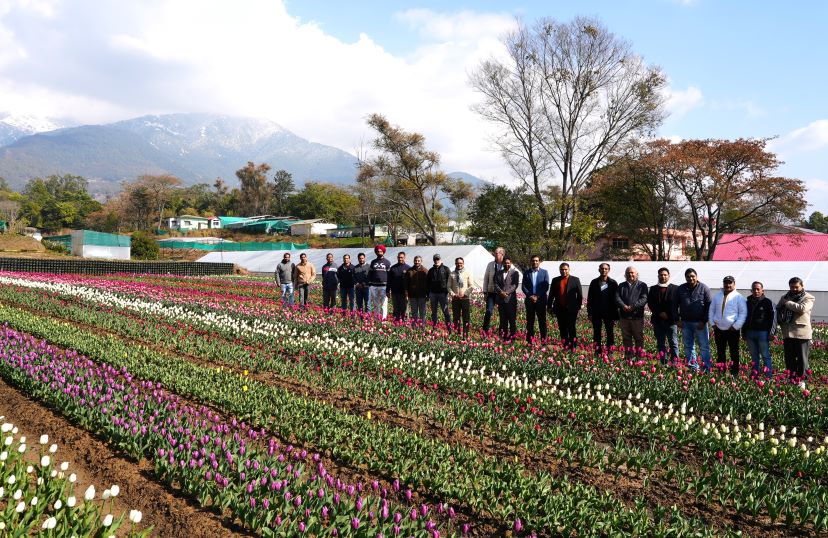
सी.एस.आई.आर.–आई.एच.बी.टी. पालमपुर द्वारा फ्लोरीकल्चर मिशन के अंतर्गत विकसित किए गए ट्यूलिप गार्डन को दिनांक 02-02-2024 को जनमानस के लिए संस्थान के निदेशक, डॉ सुदेश कुमार यादव द्वारा खोल दिया गया ।
ट्यूलिप एक कंदीय कर्तित फूल है जिसकी अंतर्राष्ट्रीय व घरेलू बाज़ार में काफी माँग है। दुनिया में कर्तित फूलों के व्यापार में यह तीसरे स्थान पर है। मिशन के अंतर्गत इसकी खेती को लोकप्रिय बनाने के लिए संस्थान दो वर्षों से इन सुंदर फूलों को अपने परिसर मे लगा रहा है। इस बार उद्यान में 6 विभिन्न रंगों की प्रजातियों के 50,000 बल्ब्स लगाए गए हैं ।इस उद्यान में, राज्य के भीतर और बाहर से, बड़ी संख्या में आगंतुकों के आने का अनुमान है । पिछले वर्ष, देश के विभिन्न क्षेत्रों से 70,000 से अधिक पर्यटक इस सुंदर ट्यूलिप गार्डन को देखने आए थे। इस वर्ष गार्डन खोले जाने के प्रथम दिन ही केंद्रीय विद्यालय, भानला (हि प्र ) के लगभग 200 विद्यार्थियों व अध्यापकों ने जिज्ञासा प्रोग्राम के अंतर्गत इसका भ्रमण किया।
सीएसआईआर-आईएचबीटी ने ट्यूलिप की व्यावसायिक खेती के लिए हिमाचल प्रदेश की लाहौल घाटी में इसके फूल और बल्ब उत्पादन पर प्रायोगिक परीक्षण शुरू किया था। शुरुआत करने के लिए सहकारी समितियों के कई किसानो को शामिल किया गया l इनमें महादेव फ्लोरीकल्चर सोसाइटी, मदाग्रां; पट्टन वैली फ्लोरीकल्चर सोसाइटी लिमिटेड; शांशा और टीनन व्हाइट माउंटेन फ्लोरीकल्चर सोसाइटी लिमिटेड, जाँगला को ट्यूलिप की खेती करने के लिए प्रशिक्षित और सशक्त बनाया गया, जो अब बल्ब और फूलों के उत्पादन के लिए ट्यूलिप की खेती कर रहे हैं।
इन फूलों की खेती से जुड़े उद्यमियों और किसानों के लिए आकर्षक आय सृजन एवं देश को आत्मनिर्भर बनाने के लिए यह एक सशक्त प्रयास है और अगले 7-8 वर्षों में देश की वार्षिक घरेलू मांग को पूरा करने के लिए ट्यूलिप बल्ब-उत्पादन करने का संस्थान का ध्धेय है।
Developed under the CSIR-Floriculture Mission, the mesmerizing Tulip garden at CSIR-IHBT has been opened for public on 02-02-2024 by Dr. Sudesh Kumar Yadav, Director, CSIR-IHBT, Palampur.
Tulip is a tuberous cut flower that has huge International and domestic demand. It ranks third in the world's top cut flower trade. Under the mission, the institute has been planting these beautiful flowers in its premises for the last two years. This year 50,000 tulip bulbs of 6 varieties of various vibrant colors have been planted in the garden. The garden, after its opening, is expected to attract a large number of visitors from within and outside the state thereby promoting scientific tourism. Last year, over 70,000 visitors from across the country visited this exquisite tulip garden. This time, far more number of visitors are anticipated. On the opening day itself, under the Jigyasa programme more than 200 students and 12 teachers from Kendriya Vidyalaya, Bhanala (HP) visited the garden. It is pertinent to mention that this garden is the first tulip garden of the state.
CSIR-IHBT started experimental trials on flower and bulb production of tulip in the Lahaul valley of Himachal Pradesh for its commercial cultivation. To begin with, several farmers from cooperative societies such as Yaani Mahadev Floriculture Society, Madagran; Pattan Valley Floriculture Society Limited, Shansha; and Tinan White Mountain Floriculture Society Limited, Jangla, were trained and empowered to cultivate tulips. They are now engaged in tulip cultivation for bulb and flower production, and are reaping benefits.
The Institute is making a significant endeavour to offer new opportunities for attractive income generation to entrepreneurs and farmers engaged in the cultivation of these flowers and to make India self-reliant in tulip bulb production to meet the domestic demand of the country. The institute aims to produce tulip bulbs to meet the annual domestic demand of the country for the next 7-8 years and make India self-reliant in this aspect.
Stakeholders Meet on Food Processing and Value Addition and Inauguration of Food Processing Facility
“ ...
Stakeholders Meet on Food Processing and Value Addition and Inauguration of Food Processing Facility
closeखाद्य प्रसंस्करण और मूल्य संवर्धन पर हितधारकों की बैठक और खाद्य प्रसंस्करण सुविधा का उद्घाटन
Stakeholders Meet on Food Processing and Value Addition and Inauguration of Food Processing Facility
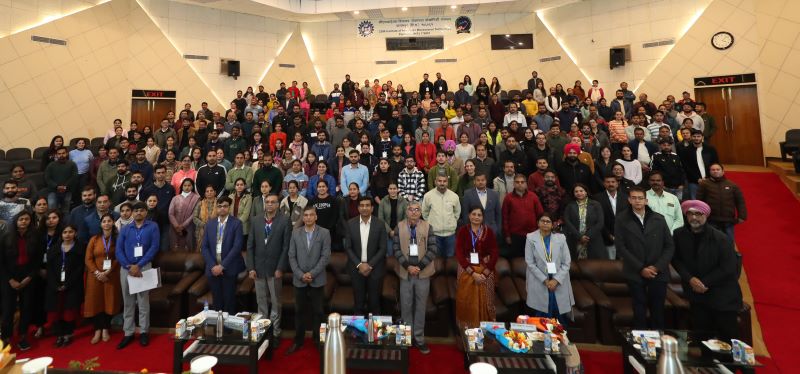
सीएसआईआर-आईएचबीटी में शुक्रवार, 29 दिसंबर, 2023 को संस्थान में खाद्य प्रसंस्करण और मूल्य संवर्धन पर एक हितधारक बैठक का आयोजन किया गया। यह आयोजन पश्चिमी हिमालय क्षेत्र के खाद्य प्रसंस्करण उद्योग के परिवर्तन के लिए एक बहु-हितधारक सहयोग है। खाद्य प्रसंस्करण उद्योग के मानकों और स्थिरता में सुधार के लिए महत्वपूर्ण आवश्यकताओं पर विचार-विमर्श करने के लिए शिक्षा, उद्योग और एफ.एस.एस.ए.आई. जैसे नियामक निकायों के विशेषज्ञों को आमंत्रित किया गया था । खाद्य प्रसंस्करण के क्षेत्र में स्टार्टअप और उभरते उद्यमियों के सामने आने वाली चुनौतियों पर प्रकाश डालने और चर्चा करने के लिए हितधारकों की बैठक के दौरान एक विशेषज्ञ पैनल चर्चा का आयोजन किया गया। इस कार्यक्र्म की अध्यक्षता सीएसआईआर-आईएचबीटी के निदेशक डॉ. सुदेश कुमार यादव ने की, इस दौरान श्री सौरभ जस्सल, आई.ए.एस., अतिरिक्त उपायुक्त, जिला. कांगड़ा इस पैनल चर्चा के लिए विशेष अतिथि भी मौजूद रहे । सीएसआईआर-आईएचबीटी में शामिल स्टार्टअप्स ने हितधारकों की बैठक के दौरान अपने उत्पादों और प्रौद्योगिकियों का भी प्रदर्शन किया। डॉ. यादव ने संस्थान में अब तक निष्पादित खाद्य प्रसंस्करण क्षेत्र से संबंधित गतिविधियों पर प्रकाश डाला और बताया कि खाद्य प्रसंस्करण क्षेत्र को बढ़ाने की दिशा में कई नए मिशन मोड और प्रौद्योगिकी परियोजनाएं शुरू की जा रही हैं। डॉ. रश्मि शर्मा (SHRI, DST) एंव डॉ. स्वीटी बहेरा (FSSAI) ने भी अपने सभाष्णों में खाद्य प्रसंस्करण और मूल्य संवर्धन के महत्व पर बल दिया ।
इस कार्यक्रम के दौरान भारत सरकार के विज्ञान और प्रौद्योगिकी विभाग के सचिव, प्रोफेसर अभय करंदीकर द्वारा संस्थान में एक नई आधुनिक खाद्य प्रसंस्करण सुविधा का उद्घाटन किया गया। जिसमे विभिन्न जैव संसाधन जैसे कि फल, सब्जियां, मशरूम, औषधीय पौधे इत्यादि के निर्जलीकरण ; फोर्टिफाइड स्नैक्स व तैयार होने वाले खाद्य पदार्थों जैसे पास्ता, नूडल्स और एनर्जी बार उत्पादन हेतु उपकरण और साथ ही 200 किलोग्राम प्रतिदिन उत्पादक क्षमता वाले मल्टीग्रेन आधारित तत्काल खाद्य पदार्थों व प्रीमिक्स उपकरण सम्मलित हैं। अपने संबोधन में प्रो. करंदीकर ने सीएसआईआर-आईएचबीटी द्वारा किए जा रहे विभिन्न अनुसंधान एवं विकास कार्यक्रमों और प्रौद्योगिकी व्यावसायीकरण गतिविधियों की सराहना की। उन्होंने खाद्य प्रसंस्करण क्षेत्र की गुणवत्ता मानकों और स्थिरता में सुधार के लिए वैज्ञानिक और तकनीकी हस्तक्षेप की आवश्यकता पर जोर दिया।
डॉ. यादव ने इस सुविधा को स्थानीय किसान उपज संगठनों (एफपीओ) और स्वयं सहायता समूहों (एसएचजी), स्टार्टअप और सूक्ष्म उद्यमों जैसे विभिन्न हितधारकों को समर्पित किया, और बताया कि कैसे यह सुविधा छोटे उद्योगों और स्थानीय खाद्य उद्योगों को बढ़ावा देगी। इस अवसर पर एक पुस्तक “ हिमाचल प्रदेश के पारंपरिक व्यंजन” का भी विमोचन किया गया। इसके अलावा संस्थान ने हिमाचल प्रदेश के मिलेट मैन नाम से मशहूर पदम श्री नेक राम शर्मा को सम्मानित किया गया जिन्होने "नौ अनाज" खेती प्रणाली को बढ़ावा देने व पारंपरिक किस्मों के पुनरुद्धार के क्षेत्र में उलेखनीय कार्य किया है ।
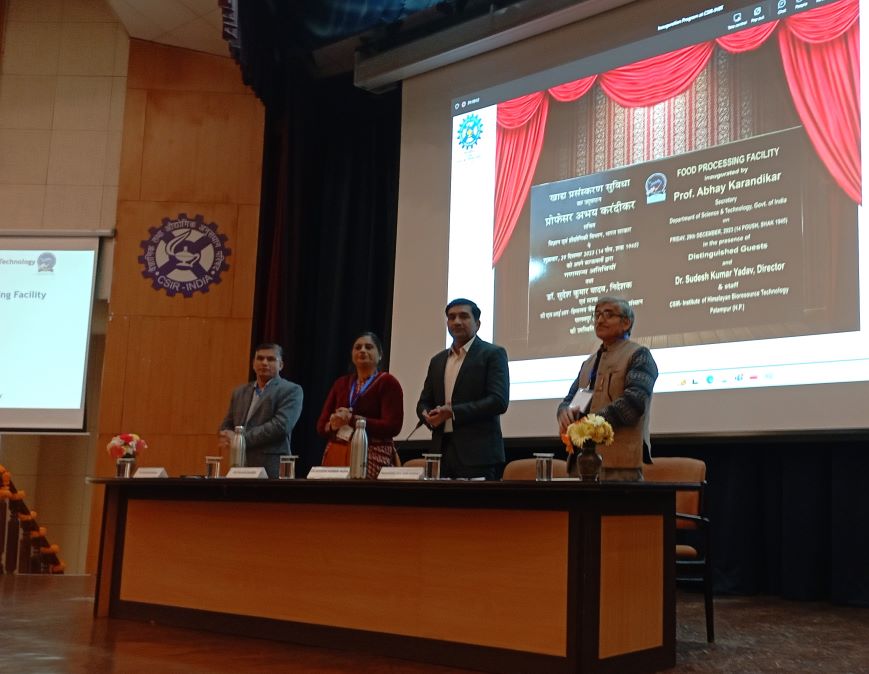
CSIR-IHBT organized a Stakeholders meet on Food Processing and Value addition on Friday, 29th of December, 2023 at the institute. The event is a multi-stakeholder collaboration for transformation of food processing industry of the Western Himalayas region. Experts from academia, industry and regulatory bodies such as FSSAI were invited to deliberate upon the important requirements for improving the standards and sustainability of the food processing industry. An expert panel discussion was held during the stakeholders meeting to highlight and discuss the challenges faced by startups and budding entrepreneurs in food processing sector. Sh. Saurabh Jassal, I.A.S., Addl. Deputy Commissioner, Distt. Kangra was special invitee for the panel discussion and the event was presided by Dr. Sudesh Kumar Yadav, Director, CSIR-IHBT. Startups incubated at CSIR-IHBT displayed their products and technologies during the stakeholders meeting. Dr. Sudesh Kumar Yadav highlighted the food processing sector related activities executed at the institute so far and informed that several new mission mode and technology projects are being taken up towards augmenting the food processing sector. Dr. Rashmi Sharma (SHRI, DST) and Dr. Sweety Behera (FSSAI) also highlighted the importance of food processing, standardization, food safety, value addition, and setting up technology business incubator centre on the campus.
As part of the program, a new Food Processing Facility was inaugurated at the institute by Prof. Abhay Karandikar, Secretary, Department of Science and Technology, Govt. of India. The state-of-the-art facility contains equipment and machinery for (i) dehydration of bioresources such as fruits, vegetables, mushroom, medicinal plants (ii) production of fortified snacks and ready to cook foods such as pasta, noodles and energy bars, and (iii) production of multigrain based instant foods and premixes with an output of 200 kg per day. In his address, Prof. Karandikar appreciated the various R&D programs and technology commercialization activities being taken up by CSIR-IHBT. He emphasized the need for scientific and technological interventions in improving the quality standards and sustainability of food processing sector.
Dr. Sudesh Kumar Yadav dedicated the facility to various stakeholders such as local farmer produce organizations (FPOs) and self-help groups (SHGs), startups and microenterprises and informed that the facility would enhance the processing capabilities of small industries and augment the local food industry ecosystem.
On the occasion a book on “Ethnic Cuisines of Himachal Pradesh” was also released.
Further the institute honoured the millet man of Himachal Pradesh Padmashri Nek Ram Sharma for his outstanding contributions in promoting “Nau-Anaj” system of cultivation and revival of traditional millet varieties.
CSIR Foundation Day Celebrations
closeसीएसआईआर-आईएचबीटी में 82वें सीएसआईआर स्थापना दिवस समारोह का आयोजन
82nd CSIR Foundation Day Celebrations

सीएसआईआर-हिमालय जैवसंपदा प्रौद्योगिकी संस्थान, पालमपुर में वैज्ञानिक तथा औद्योगिक अनुसंधान परिषद् (सी.एस.आई.आर.) का 82वां स्थापना दिवस समारोह दिनांक 6 नवम्बर 2023 को बडे़ हर्षोल्लास से मनाया गया। सन् 1942 में भारत की सबसे बड़ी परिषद, सीएसआईआर, की स्थापना हुई थी और इसे विभिन्न क्षेत्रों में अत्याधुनिक ज्ञान-विज्ञान के लिए विश्व भर में जाना जाता है। संपूर्ण भारत में अपनी 37 राष्ट्रीय प्रयोगशालाओं, 39 आउटरीच केंन्द्रो, एक नवाचार परिसर, एवं तीन यूनिट्स के माध्यम से सीएसआईआर राष्ट्र की सेवा में अपना योगदान दे रहा है।
समारोह के मुख्य अतिथि प्रो. पी. एल. गौतम, चांसलर, डा. राजेन्द्र प्रसाद केंद्रीय कृषि विश्वविद्यालय, समस्तीपुर, बिहार ने सीएसआईआर को शुभकामनाएं देते हुए संस्थान की शोध गतिविधियों एवं ग्रामीण आर्थिकी के उन्नयन में महत्वपूर्ण भूमिका एवं योगदान के लिए संस्थान की सराहना की। अपने संबोधन में उन्होंने कहा कि विज्ञान ने हमें आत्मनिर्भर बनाया है तथा इसका उपयोग मानव जाति के उत्थान के लिए होना चाहिए। विज्ञान का उदेश्य समस्याओं का हल करना है। उन्होंने संस्थान के वैज्ञानिकों से आहवान किया कि टीम भावना के माध्यम से जन समुदाय के उत्थान के लिए कार्य करें।
डॉ. अजीत कुमार शासनी, निदेशक, सीएसआईआर-राष्ट्रीय वनस्पति अनुसंधान संस्थान (एनबीआरआई) लखनऊ ने सीएसआईआर स्थापना दिवस संभाषण में विज्ञान के क्षेत्र में नित नए शोध के बारे में बताया। अपने संबोधन में उन्होंने कहा पादप संपदा में विविधता है। प्रत्येक पौधे में विविध गुण होते हैं जिनका उपयोग कई प्रकार की औषधियों तथा उत्पाद बनाने के लिए किया जाता है। इनका हमारे दैनिक जीवन में अत्याधिक महत्व है।
इससे पहले संस्थान के निदेशक डा. सुदेश कुमार यादव ने संस्थान तथा सीएसआईआर की प्रमुख वैज्ञानिक उपलब्धियों पर प्रकाश डाला। अपने संबोधन में उन्होंने बताया कि संस्थान के वैज्ञानिकों ने पुष्प एवं सगंध फसलों की कृषि तकनीक विकसित करके किसानों एवं उद्यमियों की आत्मनिर्भता की ओर कदम बढ़ाए हैं। सीएसआईआर-फ्लोरिकल्चर मिशन के अंतर्गत, पुष्प फसलों के क्षेत्र में 715 हेक्टेयर तक का विस्तार किया गया। अरोमा मिशन के अंतर्गत सगंध फसलें विशेषकर जंगली गेंदे को उगाने एवं प्रसंस्करण के लिए अलग-अलग राज्यों में आसवन इकाइयाँ स्थापित की गईं। उन्होंने आगे बताया कि विज्ञान एवं प्रौद्योगिकी से देश को बहुत अधिक उम्मीद है। अतः हमारा दायित्व है कि राष्ट्र एवं विश्व की अपेक्षाओं को पूरा करने की दिशा में प्रयासरत रहें। उन्होने जैवआर्थिकी को बढावा देने में संस्थान का सामर्थ तथा नए अवसरों के बारे में विस्तार से बताया।
इस अवसर पर सीएसआईआर-आईएचबीटी में आयोजित विभिन्न प्रतियोगिताओं के लिए पुरस्कार वितरित किए गए तथा संस्थान से सेवानिवृत्त कर्मचारियों का अभिनंदन भी किया गया। साथ ही साथ संस्थान द्वारा विकसित प्रौद्योगिकियों को उद्यमियों को हस्तांतरित करने तथा शैक्षणिक तथा शोध कार्यो के लिए चितकारा विश्वविद्यालय तथा आईजीएफआरआई, झांसी के साथ समझौता ज्ञापनों पर हस्ताक्षर भी किए गए। तीन किसान समूहों को सगंध एवं पुष्प पादपों के कंद भी बाँटे गए।
इस दिवस को जन दिवस के रूप में मनाया गया जहां किसानो, उद्यमियों एवं केंद्रीय विद्यालय, नलेटी, देहरा के 146 छात्रों एवं उनके अध्यापकों ने संस्थान की वैज्ञानिक उपलब्धियों का प्रक्षेत्र एवं प्रयोगशालाओं में अवलोकन किया।
Celebration of World Food Day
closeसीएसआईआर-हिमालय जैवसंपदा प्रौद्योगिकी संस्थान में विश्व खाद्य दिवस समारोह का आयोजन
Celebration of World Food Day
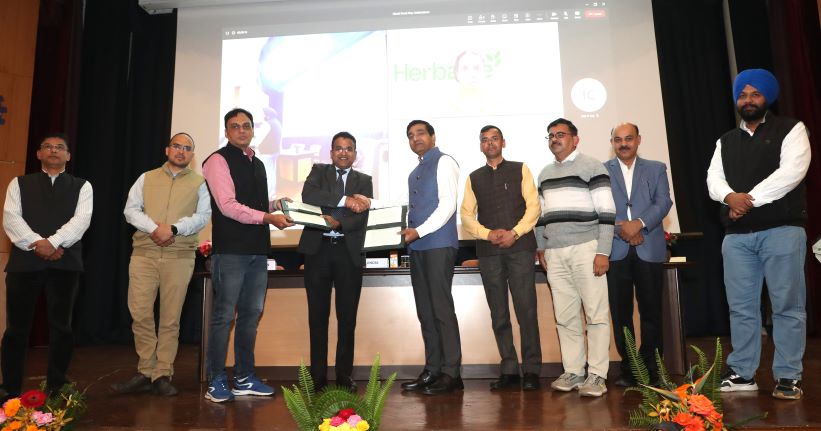
सीएसआईआर-हिमालय जैवसंपदा प्रौद्योगिकी संस्थान (सीएसआईआर-आईएचबीटी) ,पालमपुर में 16 अक्टूबर 2023 को विश्व खाद्य दिवस समारोह का आयोजन किया गया।
इस अवसर पर समारोह के मुख्य अतिथि डॉ. विजय चौधरी, प्राचार्य एवं डीन, राजीव गांधी राजकीय स्नातकोत्तर आयुर्वेदिक महाविद्यालय, पपरोला ने "स्वास्थ्य और खुशहाली में भोजन का महत्व" विषय पर अपना व्याख्यान दिया। अपने संबोधन में उन्होंने कहा कि आहार और विहार हमारे स्वास्थ्य पर विशेष प्रभाव डालते हैं, जीवनशैली में बदलाव हमारे खान पान पर भी देखा जा सकता है और इसका प्रभाव हमारे स्वास्थ्य पर पड़ रहा है। मिलेट्स और उसके गुणों पर भी डॉ. विजय चौधरी ने प्रकाश डाला।
समारोह के विशिष्ट अतिथि डॉ. निपुण जिंदल, आईएएस, उपायुक्त, कांगड़ा ने विश्व खाद्य दिवस पर अपने संबोधन में कहा कि खाद्य उपलब्धता एवं पोषण सतत विकास लक्ष्य (एसडीजी) का अभिन्न अंग है। उन्होने मिड डे मील योजना और कुछ राज्यों में शुरू की गयी नाश्ता योजना का भी जिक्र किया। शोध और पॉलिसी के बीच एक समन्वय स्थापित करने की जरूरत पर बल देते हुए उपायुक्त ने पोषण मैत्री अभियान में संस्थान से प्राप्त सहयोग की सराहना की और भविष्य में इसे बढ़ाने का भी आवाहन किया। इस मौके पर उन्होने डॉ. एम एस स्वामीनाथन, भारत में हरित क्रांति के जनक, का उल्लेख करते हुए उनके कार्यो को भी साझा किया। अंत में “कोई भूखा न सोये” कहते हुए अपने संभाषण को सम्पन्न किया।
इससे पहले संस्थान के निदेशक डा. सुदेश कुमार यादव ने अतिथियों का स्वागत करते हुए डॉ. एम एस स्वामीनाथन की जीवनी पर प्रकाश डाला और उनके योगदान की चर्चा की। उन्होने बताया कि संस्थान खाद्य एवं पोषण विशेष तौर पर पारंपरिक भोजन एवं खाने योग्य पुष्पों पर शोध कर रहा है। निदेशक महोदय ने कहा कि खाद्य पदार्थों जैसे कांगड़ी धाम, आयुर्वेदिक खिचड़ी और शीरा जैसे उत्पादों की प्रक्रिया को मानकीकृत किया गया है। रेडी टू ईट बार को स्पिरूलिना का उपयोग करके आयरन और जिंक समृद्ध करने के लिऐ मूंगफली, तिल और अनाज मिलाकर विकसित किया गया है। इसी प्रकार रेडी टू ईट फ्रूट बार और कैंडी सूक्ष्म पोषक तत्वों की कमी को दूर करते हैं। इसी श्रंखला में प्रोटीन और फाइबर समृद्ध बार बनाई गई हैं।उन्होने यह भी बताया कि मल्टीग्रेन हाई प्रोटीन मिक्स उत्पाद को प्रोटीन और एनर्जी कुपोषण को दूर करने के लिए विकसित किया गया है।
हिमालय के शीत मरुस्थल में उगने वाले बक्कवीट, जो ग्लुटिन मुक्त खाद्य पदार्थ है, से संस्थान ने पफ नूडल्स, पास्ता और रेडी टू ईट मूल्य वर्धित उत्पाद विकसित किए हैं। ऐसे उत्पाद सीलिएक रोग से पीड़ित लोगों के लिए वरदान हैं।
इस अवसर पर तीन प्रौद्योगिकी हस्तांतरण, तीन समझौता ज्ञापन और एक गैर प्रकटीकरण करार पर भी हस्ताक्षर किए गए। उपरोक्त में प्रमुख थे डेक्कन हेल्थकेर लिमिटेड, हैदराबाद; तिरुपति मेडिकेयर लिमिटेड, सिरमौर; हर्बालाइफ लिमिटेड, बैंग्लोर और जिला ग्रामीण विकास एजेंसी (डीआरडीए), कांगड़ा (हि प्र)।
एसडीएम पालमपुर, वरिष्ठ राज्य प्रशासनिक अधिकारी, संस्थान के कर्मचारियों, छात्रों के साथ-साथ पालमपुर कृषि विश्वविद्यालय के आहार विज्ञान एवं पोषण विभाग के संकाय सदस्य तथा छात्र भी इस प्रोग्राम में शामिल हुए।
Symposium on “Role of Women Scientists in S&T-based Entrepreneurship Development"
closeSymposium on “Role of Women Scientists in S&T-based Entrepreneurship Development”.
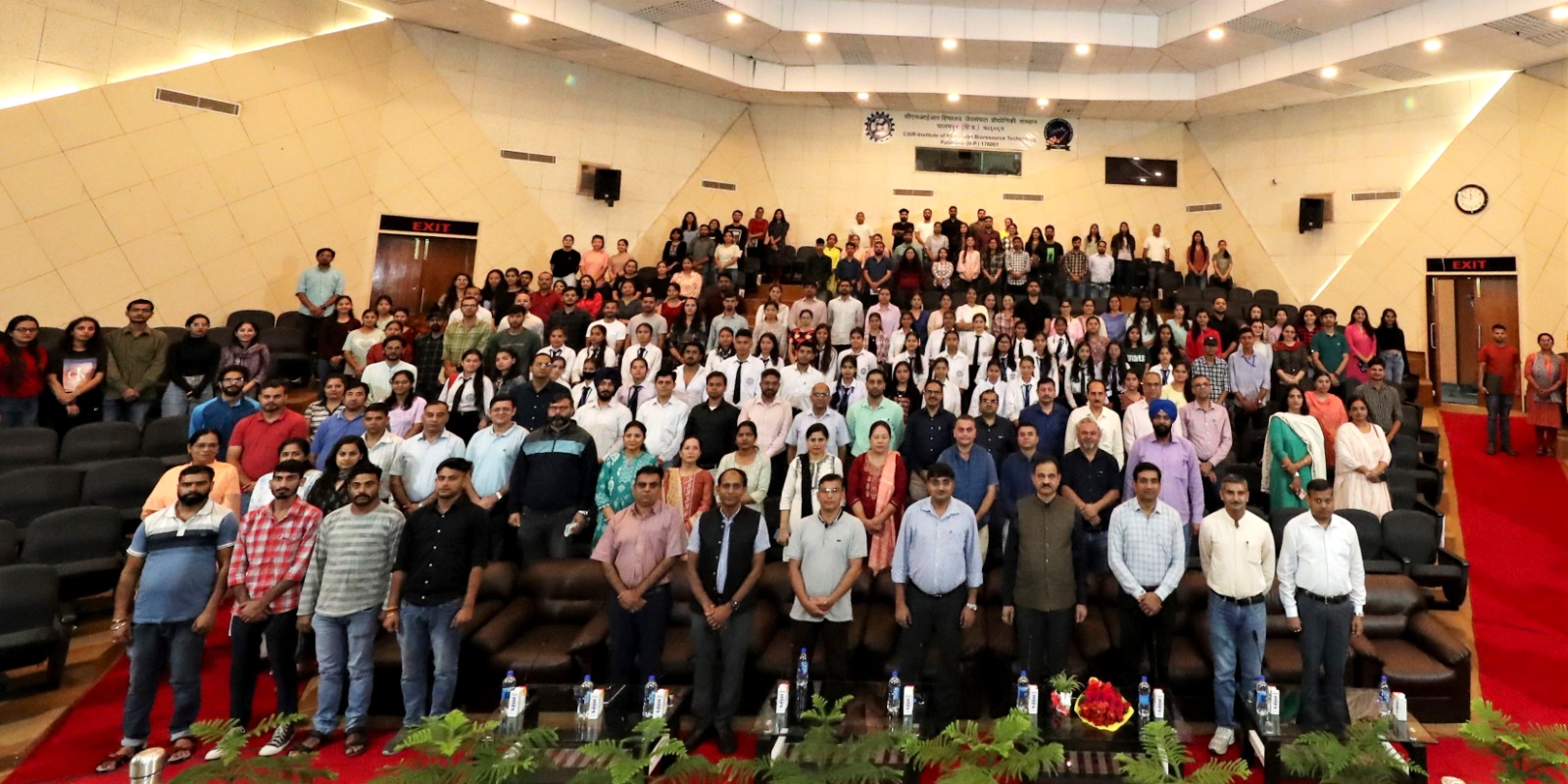
The National Academy of Sciences India (NASI) & CSIR-Institute of Himalayan Bioresource Technology (CSIR-IHBT), Palampur is jointly organizing a two day symposium (18-19 Sep 2023) on “Role of Women Scientists in S&T-based Entrepreneurship Development”.
The genesis of the program was marked by an enlightening address by Dr. Manju Sharma, Chairman, NASI New Initiatives; Former Secretary, Department of Biotechnology, GOI and the President of NASI.
Dr. Rajesh Gokhale, Secretary, Department of Biotechnology, GOI delivered the inaugural address wherein he highlighted “Women for Wonders”. Thereafter, Dr. Rajendra Dobhal, Vice-Chancellor of Swami Rama Himalayan University, Dehradun, and former Director General of UCOST, Dehradun delivered key note address. He focussed on recent policy initiatives of the Government towards nurturing and promoting women in S&T-based entrepreneurship.
Prior to that Dr. Sudesh Kumar Yadav, Director CSIR-IHBT, welcomed all the guests and expressed his heartfelt gratitude for their distinguished presence. He apprised the guests about the Institute's technologies and the role of women entrepreneurs.
MoU was also signed for collaborative research work between CSIR-IHBT and SRHU on this occasion.
CSIR-IHBT
closeसीएसआईआर-आईएचबीटी
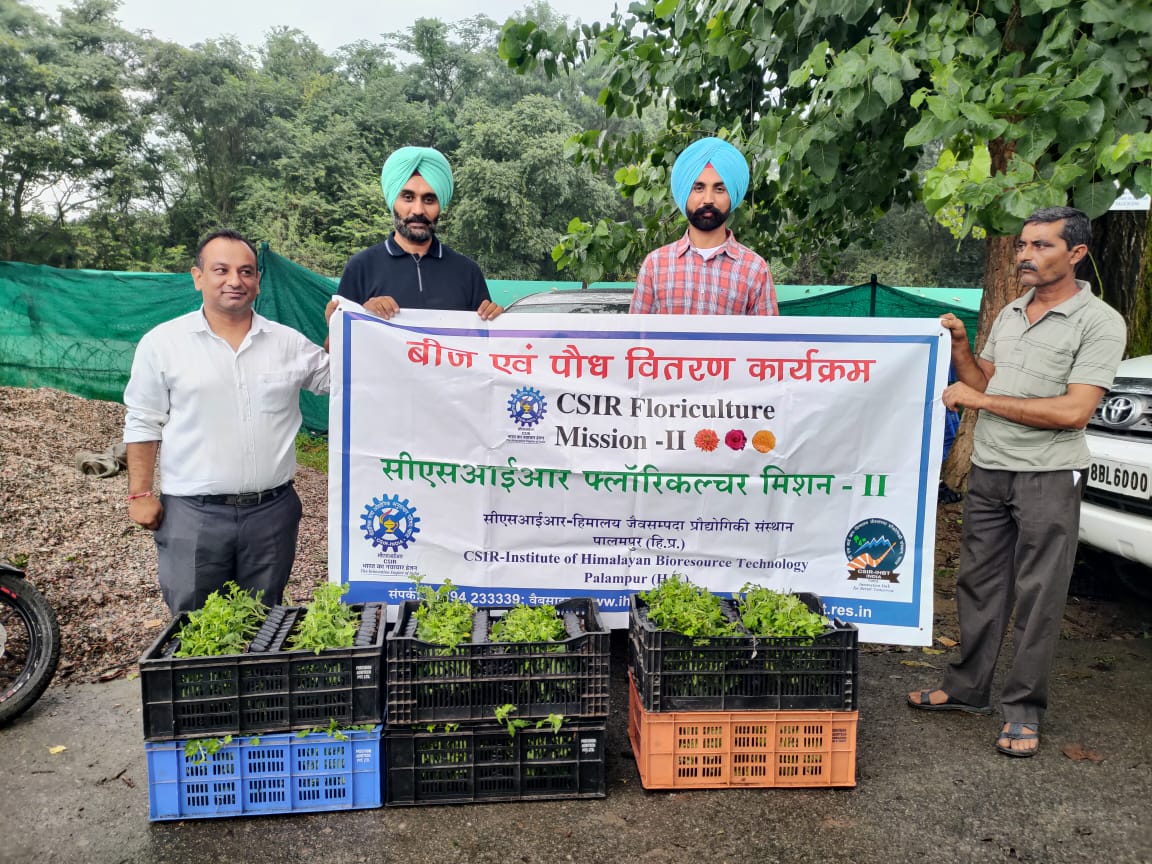
सीएसआईआर-हिमालय जैवसंपदा प्रौद्योगिकी संस्थान (सीएसआईआर-आईएचबीटी), पालमपुर ने 22 और 23 अगस्त 2023 को सीएसआईआर-फ्लोरीकल्चर मिशन-II के अंतर्गत हिमाचल प्रदेश, पंजाब और उत्तराखंड के 23 किसानों को 2.15 लाख गुलदाउदी की रोपण सामग्री वितरित की।
देश में फूलों की खेती के लिए गुणवत्ता युक्त रोपण सामग्री की अनुपलब्धता एक बड़ी बाधा है तथा इस समस्या को दूर करने के लिए सीएसआईआर-आईएचबीटी, फ्लोरीकल्चर मिशन चला रहा है जिसमे सीएसआईआर की प्रोद्योगिकियों का उपयोग कर उच्च मूल्य वाले पुष्पों की खेती को बढ़ावा दिया जा रहा है । इसके माध्यम से किसानो की आय मे भी बढ़ोतरी हो रही है।
सीएसआईआर-आईएचबीटी देश मे फूलों की खेती के व्यवसाय को बढ़ावा देने हेतु सतत प्रयास कर रहा है। साथ ही, संस्थान के पास खुले और संरक्षित वातावरण में पौधों के गुणन और फूलों की खेती के लिए मानकीकृत प्रोद्योगिकियां उपलब्ध है।
इस अवसर पर सीएसआईआर-आईएचबीटी के निदेशक डॉ. सुदेश कुमार यादव ने बताया कि मिशन के अंतर्गत दी जाने वाली रोग मुक्त गुणवत्तायुक्त रोपण सामग्री किसानों की आय बढ़ाने में सहायक सिद्ध हो रही हैं।
सीएसआईआर-आईएचबीटी के मिशन नोडल अधिकारी डॉ. भव्य भार्गव ने कहा कि इस वर्ष संस्थान पांच राज्यों में 170 हेक्टेयर क्षेत्र को कवर करने हेतु गुणवत्तापूर्ण रोपण सामग्री प्रदान करेगा। विभिन्न राज्यों के लाभान्वित किसानों ने सीएसआईआर-फ्लोरीकल्चर मिशन और सीएसआईआर-आईएचबीटी को गुणवत्तायुक्त रोपण सामग्री उपलब्ध कराने के लिए अपना आभार व्यक्त किया।
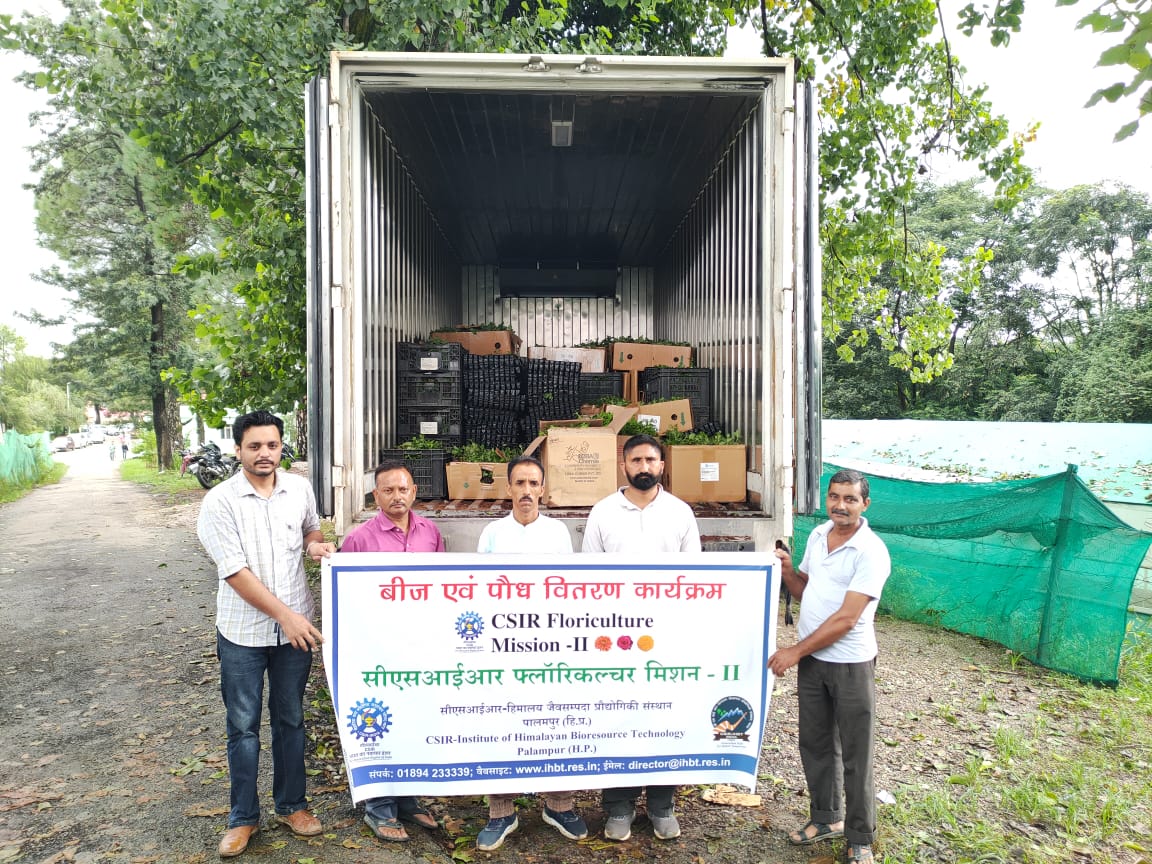
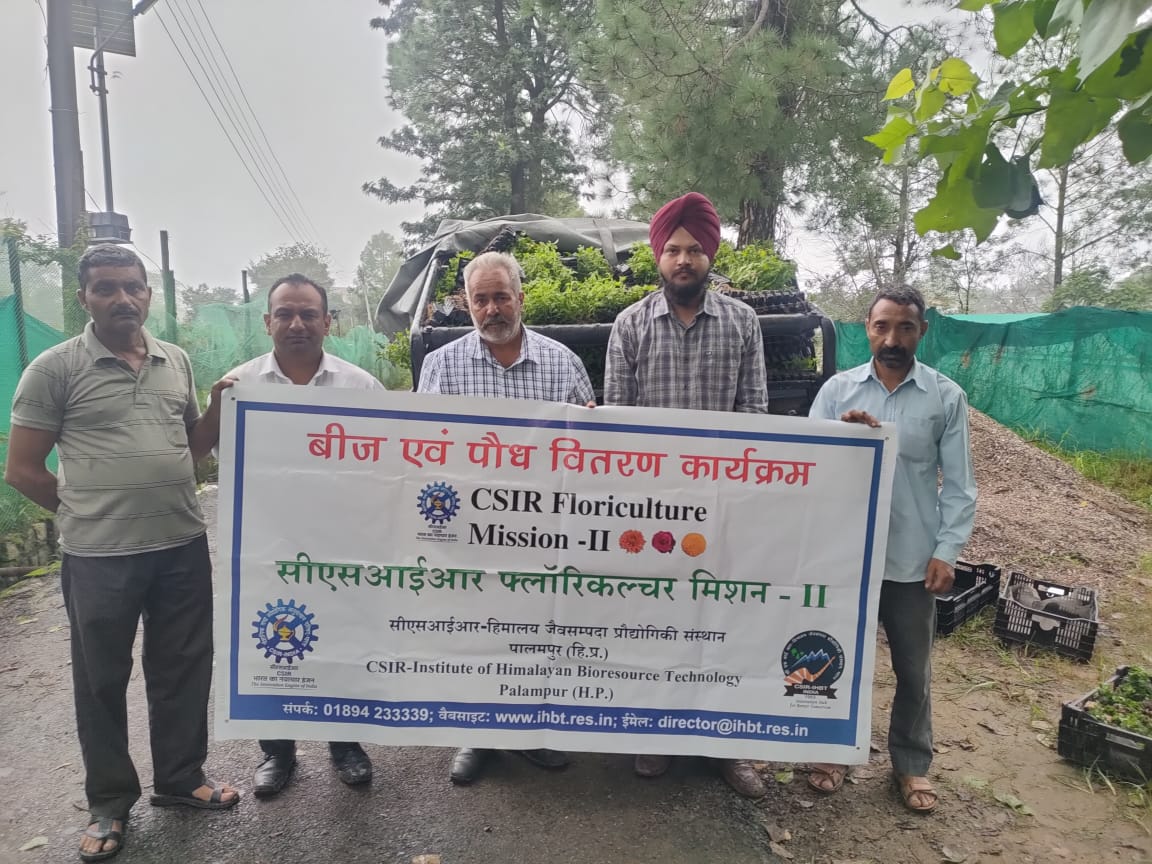
CSIR-Institute of Himalayan Bioresource Technology (CSIR-IHBT), Palampur under CSIR Floriculture Mission-II distributed 2.15 lakh Chrysanthemum rooted cuttings to 23 farmers of Himachal Pradesh, Punjab and Uttarakhand on 22nd and 23rd August 2023.In India, non-availability of the quality planting material is a major hurdle in floriculture sector.
CSIR Floriculture Mission is a nation-wide program being implemented in 22 states with an aim to enhance the income of farmers and develop entrepreneurship through high value floriculture utilizing CSIR technologies.
The CSIR-IHBT has been active in boosting the nations's floriculture business. The institute has standardized technologies for plant multiplication and cultivation of floriculture crops in open as well as protected environments.
Dr Sudesh Kumar Yadav, Director, CSIR-IHBT said that the disease free quality planting material being distributed under the mission is helping in increasing the farmers’ income.
Dr. Bhavya Bhargava, Mission Nodal, CSIR-IHBT, told that this year the institute proposes to provide quality planting material for covering an area of 170 ha in five states. The benefited farmers from different states expressed their gratitude towards CSIR-Floriculture Mission and CSIR-IHBT for providing them the quality planting material.
PUSHP KRISHI MELA
closeपुष्प कृषि मेला
PUSHP KRISHI MELA
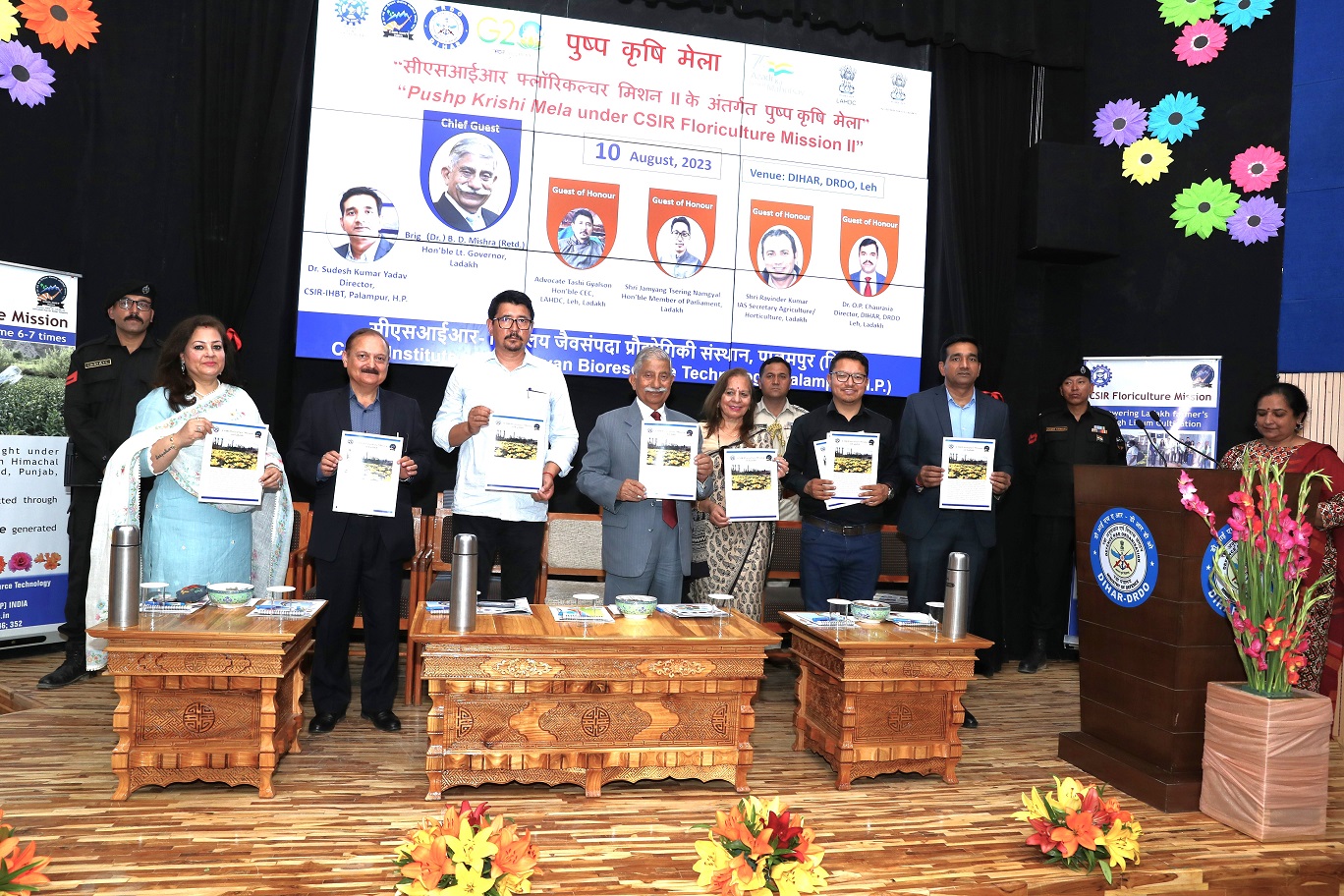
सीएसआईआर- हिमालय जैवसंपदा प्रौद्योगिकी संस्थान (सीएसआईआर-आईएचबीटी), पालमपुर ने 10 अगस्त 2023 को डीआईएचएआर, डीआरडीओ, लेह में “सीएसआईआर-फ्लोरीकल्चर मिशन II के अंतर्गत “पुष्प कृषि मेले” का आयोजन किया जिसके मुख्य अतिथि लद्दाख के माननीय उपराज्यपाल ब्रिगेडियर (डॉ.) बी.डी. मिश्रा (सेवानिवृत्त) थे। कार्यक्रम में विशिष्ट अतिथि एडोवैक्ट ताशी ग्यालसन, मुख्य कार्यकारी पार्षद (सीईसी), एलएएचडीसी, लेह, लद्दाख, श्री जामयांग त्सेरिंग नामग्याल, संसद सदस्य, लद्दाख, श्री रविंदर कुमार, आईएएस सचिव कृषि/बागवानी यूटी लद्दाख और डॉ. ओपी चौरसिया, निदेशक, डीआईएचएआर, डीआरडीओ ने भी अपनी उपस्थिति दर्ज कराई।
माननीय उपराज्यपाल ने अपने संबोधन में लद्दाख घाटी में मिशन की उपलब्धियों की सराहना की। उन्होंने यह भी उल्लेख किया कि इस क्षेत्र में फूलों के उत्पादन की असीम संभावनाएँ है तथा “फूल उगाओ फूलों का विस्तार करो” का नारा भी दिया। साथ ही साथ उन्होने “महिलाएं, लद्दाख और फूलों” को भगवान की सर्वश्रेष्ठ रचना बताया ।
इसके अलावा, उन्होंने फूलों के उत्पादन, बे-मौसमी खेती, कोल्ड स्टोरेज और बेहतर परिवहन के माध्यम से फ्लोरीकल्चर को बढ़ावा देने हेतु विभिन्न पहलुओं पर प्रकाश डाला। उन्होंने मुख्य कार्यकारी पार्षद, एलएएचडीसी, लेह से पूरे क्षेत्र में फूलों की खेती में लोगों की भागीदारी को प्रोत्साहित करने का आवाहन किया। इस अवसर पर उनके द्वारा 'लद्दाख में सीएसआईआर-फ्लोरीकल्चर मिशन' पर एक विवरणिका जारी की और किसानों को लिलियम, ग्लैडियस और ट्यूलिप की रोपण सामग्री वितरित की। उन्होंने लेह स्थित महिला स्वयं सहायता समूहों और राग्युल जैविक उत्पादक कंपनी के किसानों को प्रशंसा पत्र भी प्रदान किए।
माननीय उपराज्यपाल की उपस्थिति में, सीएसआईआर-आईएचबीटी ने लद्दाख प्रगतिशील सोसायटी, लेह और मेंडोक सहकारी सोसायटी, कारगिल के साथ एक सामग्री हस्तांतरण समझौते (एमटीए) पर हस्ताक्षर किए। एलएएचडीसी, लेह के मुख्य कार्यकारी पार्षद (सीईसी) एडवोकेट ताशी ग्यालसन ने किसानों से आत्मनिर्भर कृषि और उद्यमिता को बढ़ावा देने का आग्रह किया।
सीएसआईआर-आईएचबीटी, पालमपुर के निदेशक डॉ. सुदेश कुमार यादव ने लद्दाख में सीएसआईआर-फ्लोरीकल्चर मिशन की उपलब्धियों पर प्रकाश डाला। उन्होंने बताया कि मिशन के माध्यम से लिलियम, ग्लाडिओलस और ट्यूलिप जैसी फूलों की खेती लगभग 10 एकड़ भूमि पर की जा रही जिससे लेह और कारगिल के 80 किसानों की आर्थिक स्थिति में सुधार हुआ है।
उन्होंने लद्दाख में फूलों की खेती को बढ़ावा देने के लिए संस्थान की क्षमता और नए अवसरों के बारे में विस्तार से बताया। डॉ. यादव ने इस बात पर भी जोर दिया कि विदेशों से पुष्प आयात कम करने के लिए लद्दाख को बल्ब उत्पादन केंद्र के रूप में विकसित किया जा सकता है।
फूल उत्पादन, विपणन और फूलों की खेती से संबंधित गतिविधियों के बारे में जानने के लिए 100 से अधिक प्रदर्शक, उद्यमी और निर्माता सक्रिय रूप से इस कार्यक्रम में शामिल हुए। श्री पवन कोटवाल, उपराज्यपाल लद्दाख के सलाहकार, डॉ. महेंद्र दानोकर, मुख्य वैज्ञानिक टीएमडी, सीएसआईआर मुख्यालय, डॉ. एस.के. मेहता, वीसी यूनिवर्सिटी ऑफ लद्दाख, श्री मोसेस कुन्जांग, निदेशक, सहकारिता विभाग, श्री स्टेनजिंग चोस्फेल, कार्यकारी पार्षद कृषि, कार्यक्रम में कृषि विभाग के एसडीएओ श्री थिनलेस दावा और अन्य गणमान्य व्यक्तियों ने भी भाग लिया। इस कार्यक्रम में प्रेस और मीडिया के प्रतिनिधियों के साथ-साथ डीआरडीओ और सीएसआईआर-आईएचबीटी के कर्मचारी भी शामिल हुए।
CSIR-Institute of Himalayan Bioresource Technology (CSIR-IHBT), Palampur organised “PUSHP KRISHI MELA” under “CSIR-Floriculture Mission II” on 10th August 2023 at DIHAR, DRDO, Leh. The chief guest of the program was Hon’ble Lieutenant Governor of Ladakh, Brig. (Dr.) B.D. Mishra (Retd) along with Guests of Honour, Advocate Tashi Gyalson, Chief Executive Councillor (CEC), LAHDC, Leh, Shri Jamyang Tsering Namgyal, Member of Parliament, Ladakh, Shri Ravinder Kumar, IAS Secretary Agriculture/ Horticulture UT Ladakh and Dr. O.P Chaurasia, Director, DIHAR, DRDO.
Hon’ble Lt. Governor, in his address, appreciated the achievements of the mission in Ladakh valley. He also mentioned that flower production has a huge potential in the area and gave a slogan “Phool ugaao phoolo ka vistaar karo”. In addition, he stated: Women, Ladakh and Flowers are the best creations of the God. Furthermore, he added enhancing flower production through off season cultivation, cold storage and better transportation. He suggested Chief Executive Councillor, LAHDC, Leh to encourage People’s participation in floricultural activities throughout the region. On this event, Hon’ble Lt. Governor released a brochure on ‘CSIR-Floriculture Mission in Ladakh’ and distributed planting materials of Lilium, Gladious and Tulip to the farmers. He also presented certificates of appreciation to the farmers of the Leh-based women's self-help groups and the Ragyul organic producers company.
In the presence of Hon’ble Lt. Governor, CSIR-IHBT signed material transfer agreements (MTA) with Ladakh progressive society, Leh and Mendok Cooperative society, Kargil. Advocate Tashi Gyalson, CEC, LAHDC, Leh, urged the farmers for self-sustainable agriculture and entrepreneurship development in the region.
Dr. Sudesh Kumar Yadav, Director CSIR-IHBT, Palampur highlighted the achievements of CSIR-Floriculture Mission in Ladakh. He said that the mission has increased the area under floricultural crops like Lilium, Gladilous and Tulip to over 10 acres which has improved the socio-economic condition of 80 farmers in Leh and Kargil. Dr. Yadav elucidated about the institute’s potential and new opportunities in promoting floriculture in the UT. He also emphasized that Ladakh can be developed as a bulb production centre of the country to minimize import.
More than 100 exhibitors, entrepreneurs, and farmers actively engaged in floriculture related activities participated in the mela. Mr Pawan Kotwal, Advisor to Lt. Governor Ladakh, Dr. Mahender Danokar, Chief Scientist TMD, CSIR Headquarters, Dr S.K Mehta, VC University of Ladakh, Mr Moses Kunzang, Director, Department of Cooperatives, Shri Stenzing Chosphel, Executive councillor agriculture, Shri Thinless Dawa, SDAO department of agriculture and other dignitaries also participated in the program. Representatives from the press and media, as well as staff from the DRDO and CSIR-IHBT, attended the event.
CSIR-IHBT
closeसीएसआईआर-आईएचबीटी
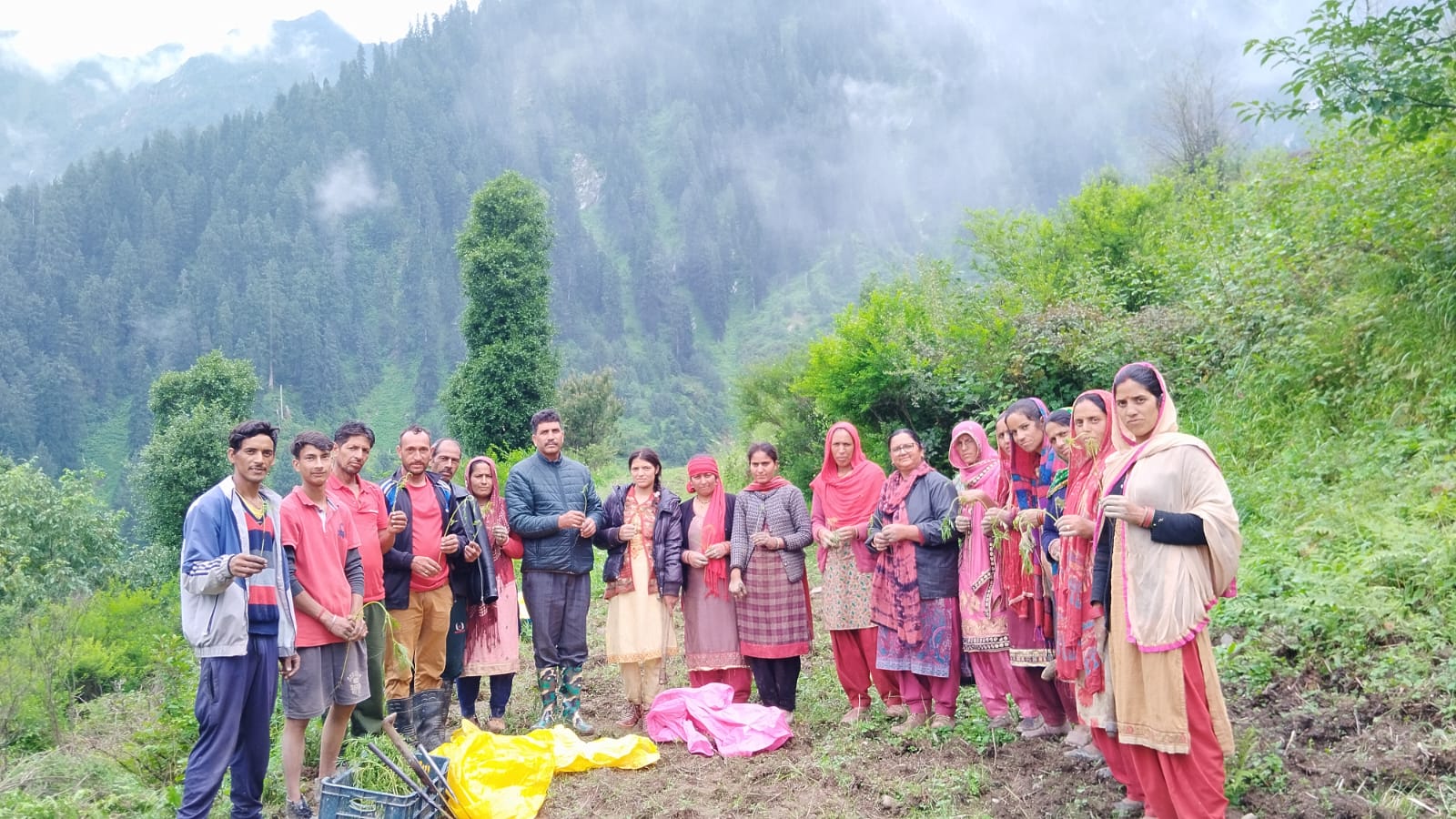
जिला चंबा, भरमौर के सामरा घाटी में कुछ समय पहले तक किसान अपनी आमदनी व आजीविका के लिए बड़ी मेहनत व लागत से आलू, जौ, मक्की , गेहूँ इत्यादि फसल उगाते थे, परंतु जंगली जानवरों जैसे की बन्दर ,लंगूर, भालू, आवारा पशुओं के अत्यधिक अतिक्रमण के कारण किसानों को काफी परेशानियों व नुकसान का सामना करना पड़ता था। इस कारण किसानों ने फसल उगाना बंद कर दिया था तथा वहाँ से उनके प्रवासन के कारण भूमि बंजर हो गई थी। अब सीएसआईआर-आइएचबीटी, पालमपुर कि सकारात्मक पहल और आधुनिक दृष्टिकोण के तहत सीएसआईआर-अरोमा मिशन तृतीय चरण के अंतर्गत किसान लगभग 750 एकड़ भूमि मे सगंधित गेंदे की खेती कर रहे हैं।
किसान राजेश राणा जो की हिमाचल पुलिस सेवा से सेवानिवृत होने के पश्चात सीएसआईआर-आइएचबीटी, पालमपुर के संपर्क में आए। इसके उपरांत उन्होने अपने पैतृक गाँव खनोग, तहसील भरमौर, जिला चंबा में खाली पड़ी जमीन को गाँव के 50 अन्य किसानों के साथ मिलकर संस्थान द्वारा उपलब्ध करवाए गए सगंधित गेंदे की खेती आरंभ की। उन्होने बताया की सामरा घाटी में काफी कृषि योग्य भूमि जंगली जानवरों के आतंक के कारण खाली पड़ी है।
ड़ा राकेश कुमार, वरिष्ठ प्रधान विज्ञानी के अनुसार इस घाटी में सगंधित गेंदे के इलावा दमस्क रोज, मुश्कबाला, रोज़मेरी, क्लेरी सेज इत्यादि सगंधित फसलों की खेती की जा सकती है। इन फसलों को जंगली जानवर नुकसान भी नहीं पहुंचाते हैं तथा इन से प्राप्त सगंधित तेलों की अन्तर्राष्ट्रीय बाजार में अच्छी मांग रहती है। उन्होने बताया की संस्थान द्वारा अरोमा मिशन तृतीय चरण के अंतर्गत किसानों को सगंधित गेंदे की उन्नत किस्म “हिम स्वर्णिमा” के बीज मुफ्त उपलब्ध करवाए गए हैं हिम स्वर्णिमा किस्म को संस्थान के विज्ञानियों द्वारा विकसित किया है जिससे 180-230 क्विंटल बायोमास प्रति हैक्टर तथा उससे 36-45 किलो प्रति हैक्टर तेल प्राप्त किया जा सकता है। सगंधित गेंदे के तेल का बाजार भाव 12000- 15000 रूपये प्रति किलोग्राम है। किसान 5-6 माह में 1.25 से 1.5 लाख रूपये प्रति हैक्टर तक शुद्ध लाभ अर्जित कर सकते हें। सगंधित गेंदा पहाड़ी किसानों की आजीविका मे सुधार ला सकता है इसलिए जंगली गेंदा की खेती को बढ़ावा दिया जा रहा है।
डॉ. सुदेश कुमार यादव, निदेशक, सीएसआईआर-आइएचबीटी, पालमपुर ने बताया की अरोमा मिशन तृतीय चरण के अंतर्गत संस्थान द्वारा सगंधित फसलों को बढ़ावा देने हेतु समय समय पर किसानों को उन्नत बीज उपलब्ध करवाए जा रहें हैं। किसानों को सगंधित फसलों की कृषि तकनीक बताई जा रही है तथा किसान समूहों के लिए प्रसंस्करण इकाइयां भी स्थापित की जा रही हैं। संस्थान द्वारा अरोमा मिशन के तहत जिला चंबा में 13 प्रसंस्करण इकाइयां स्थापित की गई हैं जिनका उपयोग कर किसान अधिक से अधिक लाभान्वित हो सकते हैं।
CSIR-IHBT organizes CSIR Azadi Ka Amrit Mahotsav - IP Campaign
closeCSIR-IHBT organizes CSIR Azadi Ka Amrit Mahotsav - IP Campaign
July 21-28, 2023
As part of the "Azadi Ka Amrit Mahotsav - Rashtriya Boudhik Sampada Mahotsav/National Intellectual Property Festival", Dr. T Pavan Kumar, Senior Scientist, CSIR-IMMT, Bhubaneswar delivered a lecture on “The IP Spectrum - An Overview” on 21st July, 2023. The program was attended by students, scholars and trainees. CSIR-IHBT scientists and technical staff attended the event online as well.
CSIR-IHBT celebrated its 41st Foundation Day
closeसीएसआईआर-आईएचबीटी ने मनाया अपना 41वां स्थापना दिवस
CSIR-IHBT celebrated its 41st Foundation Day
सीएसआईआर-हिमालय जैवसंपदा प्रौद्योगिकी संस्थान, पालमपुर ने 2 जुलाई 2023 को अपना 41वां स्थापना दिवस मनाया। समारोह के मुख्य अतिथि डा. परविन्दर कौशल, कुलपति, वीरचन्द्र सिंह गढ़वाली उत्तराखंड औद्यानिकी एवं वानिकी विश्वविद्यालय, भरसार, पौड़ी गढ़वाल, उत्तराखंड ने अपने संबोधन में सीएसआईआर-आईएचबीटी के स्थापना दिवस की शुभकामनाएं देते हुए संस्थान की उपलब्धियों की सराहना की। उन्होंने कहा कि विश्वविद्यालय तथा संस्थान मिलकर पुष्पखेती, सगंध फसलों, औषधीय एवं औद्योगिक महत्व की फसलों पर मिलकर कार्य करेंगे। इस संबन्ध में आज एक समझौता भी किया गया।
इस अवसर पर डॉ. सी. आनंदरामकृष्णन, निदेशक,सीएसआईआर-राष्ट्रीय अंतर्विषयी विज्ञान तथा प्रौद्योगिकी संस्थान, तिरुवनंतपुरम, केरल ने ‘सतत् भविष्य के लिए विज्ञान, प्रौद्योगिकी एवं नवोन्मेष“ विषय पर स्थापना दिवस संभाषण दिया। अपने संबोधन में उन्होने ऊर्जा, खाद्य एवं जल की उपयोगिता दर्शाते हुए इन क्षेत्रों में और अधिक ध्यान केंद्रित करने के लिए कहा। उन्होने, ग्रीन हाइड्रोजन उत्पादन, 2जी एथानॉल , खाद्य सुरक्षा, पोषण, एवं ग्राहक संतुष्टि का भी उल्लेख किया।
इससे पूर्व, सीएसआईआर-आईएचबीटी के निदेशक डा. सुदेश कुमार यादव ने संस्थान की वर्ष 2022-23 की उपलब्धियों पर प्रकाश डाला। उन्होंने बताया कि सीएसआईआर-अरोमा मिशन के अंतर्गत सगंध फसलों की खेती का क्षेत्र 3000 हेक्टेयर तक बढ़ा दिया गया तथा किसानों के प्रक्षेत्रों में 17 अतिरिक्त आसवन इकाइयाँ (कुल 61 इकाइयाँ) स्थापित की गईं जिसके माध्यम से कृषक समूहों को सगंध तेल के उत्पादन में सशक्त बनाया गया। सीएसआईआर-फ्लोरीकल्चर मिशन में पुष्प खेती का क्षेत्र 250 हेक्टेयर तक विस्तारित किया गया जिससे 649 किसान लाभान्वित हुए। अपने संबोधन में उन्होंने आगे बताया कि विज्ञान एवं प्रौद्योगिकी से देश को बहुतअधिक उम्मीद है। अतः हमारा दायित्व है कि राष्ट्र एवं विश्व की अपेक्षाओं को पूरा करने की दिशा में प्रयासरत रहें। उन्होने जैवआर्थिकी को बढावा देने में संस्थान का सामर्थ तथा नए अवसरों के बारे में विस्तार से बताया।
इस अवसर पर डा. परविन्दर कौशल, कुलपति ने संस्थान के वार्षिक प्रतिवेदन 2022-23 का भी विमोचन किया। समारोह के दौरान संस्थान ने नगर निगम, पालमपुर तथा दक्कन हेल्थकेयर के साथ समझौता ज्ञापनों पर भी हस्ताक्षर किए ।
इस समारोह में जिज्ञासा एवं विज्ञान ज्योति कार्यक्रम के अंतर्गत जवाहर नवोदय विद्यालय, पपरोला, केंद्रीय विद्यालय,अलहिलाल व सीनियर सैकेंडरी स्कूल, बैजनाथ के 50 छात्रों ने भाग लिया एवं प्रयोगशालाओं का भ्रमण किया।
समारोह में स्थानीय कृषि विश्वविद्यालय के पूर्व कुलपति डा. एस. के. शर्मा, नगर निगम के आयुक्त श्री अशीष शर्मा ,मेयर श्रीमती पूनम तथा पालमपुर के गणमान्य लोगों ने प्रतिभागिता की। इसमें स्थानीय स्टाफ, छात्र, पूर्व कमर्चारी, उद्यमी एवं उत्पादक, तथा मीडिया के प्रतिनिधि भी शामिल हुए।
CSIR-Institute of Himalayan Bioresource Technology (CSIR-IHBT), Palampur celebrated its 41st Foundation Day on 2 July 2023. The chief guest of the function was Dr. Parvinder Kaushal, Vice Chancellor, Veer Chandra Singh Garhwali Uttarakhand University of Horticulture and Forestry, Bharsar, Pauri Garhwal, Uttarakhand. In his address, he appreciated the achievements of the institute while giving best wishes on the foundation day. He further said that the university and the CSIR-IHBT will work together on floriculture, aromatic crops, crops of medicinal and industrial importance. An agreement was also signed in this regard today.
Dr. C. Anandharamakrishnan, Director, CSIR-National Interdisciplinary Institute of Science and Technology, Thiruvananthapuram, Kerala was the key note speaker. He delivered a lecture on the subject "Science, Technology, and Innovation Development for a Sustainable Future". He urged the audience to focus on judicious use of energy, food, and water. He also highlighted the importance of green hydrogen production, 2G ethanol, future of food & nutrition, and customer satisfaction.
Earlier, Dr. Sudesh Kumar Yadav, Director, CSIR-IHBT highlighted the achievements of the institute for the year 2022-23. He said that under the CSIR-Aroma Mission, the area under cultivation of aromatic crops has been increased to 3000 hectares and 17 additional distillation units (total 61 units) have been set up in the farmers' fields, through which farmers' groups have been empowered in the production of aromatic oil. In CSIR-Floriculture Mission, the area under floriculture was expanded to 250 hectares benefitting 649 farmers. In his address, he further emphasized that the country has a lot of hope from science and technology. Therefore, it is our responsibility to keep striving towards fulfilling the expectations of the nation and the world. He explained in detail about the institute's potential and new opportunities in promoting bioeconomy.
On this occasion Dr. Parvinder Kaushal also released the Annual Report 2022-23 of the CSIR-IHBT. The institute also signed MoUs with Municipal Corporation, Palampur, Deccan Healthcare, Veer Chandra Singh Garhwali Uttarakhand University of Horticulture and Forestry, Bharsar, Pauri Garhwal, Uttarakhand.
Additionally, 50 students of Jawahar Navodaya Vidyalaya, Paprola, Kendriya Vidyalaya, Alhalal and Senior Secondary School, Baijnath also participated and visited the laboratories under the program of Jigyaasa and Vigyaan Jyoti.
Dr. S.K. Sharma, former Vice-Chancellor of CSK Agricultural University Palampur, Mr. Ashish Sharma Municipal Corporation Commissioner, Mrs. Poonam Bali Mayor and other dignitaries of Palampur also participated in the programme. Staff, students, and former employees of the CSIR-IHBT along with entrepreneurs and representatives of the press and media attended the function.
Dr. Sudesh Kumar Yadav assumed charge of Director, CSIR-IHBT
closeडा. सुदेश कुमार यादव ने संभाला सीएसआईआर-आईएचबीटी पालमपुर के निदेशक का पद
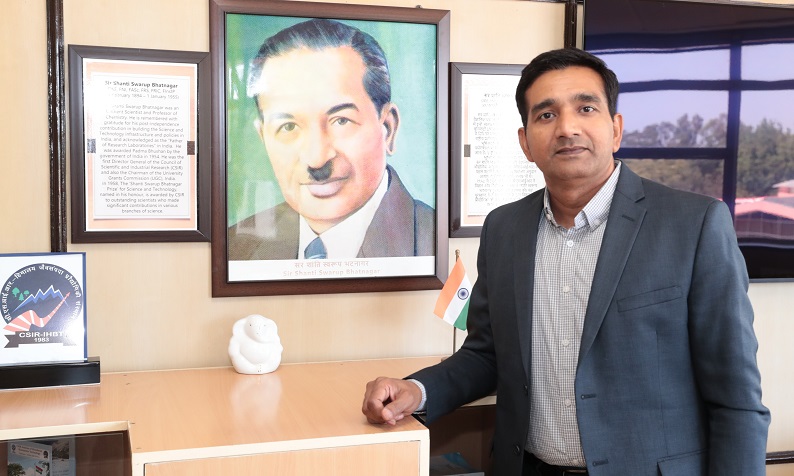
डा. सुदेश कुमार यादव ने दिनांक 9 जून 2023 को सीएसआईआर-आईएचबीटी पालमपुर के निदेशक का कार्यभार संभाल लिया। सीएसआईआर-आईएचबीटी वैज्ञानिक तथा औद्योगिक अनुसंधान परिषद का हिमाचल प्रदेश स्थित देश का एक अग्रणी अनुसंधान एवं विकास संस्थान है। डा. प्रबोध कुमार त्रिवेदी, निदेशक,सीमैप एवं अतिरिक्त प्रभार, सीएसआईआर-आईएचबीटी ने डा. सुदेश कुमार यादव को कार्यभार सौंपा।
इससे पूर्व, डा. सुदेश मोहाली स्थित जैवप्रौद्योगिकी विभाग,भारत सरकार के संस्थान ‘नवोन्मेषी एवं अनुप्रयुक्त जैव प्रसंस्करण केंद्र’ (सीआईएबी) में वैज्ञानिक-जी के पद पर कार्यरत थे तथा 2004 से 2016 तक उन्होने सीएसआईआर-आईएचबीटी पालमपुर में प्रधान वैज्ञानिक के रूप में कार्य किआ था। विज्ञान, शोध एवं सामाजिक विकास के क्षेत्र में उनका 20 वर्ष का अनुभव है। उनके 185 से अधिक शोध पत्र उच्च स्तरीय अंतर्राष्ट्रीय जर्नल में प्रकाशित हो चुके है तथा उनके नाम पर 15 पेटेंट भी दर्ज हैं। अनेक शोधार्थियों ने उनके मार्गदर्शन में पीएच.डी. एवं एम.एससी. की है। वे राष्ट्रीय विज्ञान अकादमी सहित कई संस्थायों के फेलो हैं तथा उन्हें सीएसआईआर युवा वैज्ञानिक सहित कई पुरस्कार भी मिल चुके हैं। पौधों की मेटाबोलिक इंजीनियरिंग और उच्च गुणवत्ता युक्त उत्पादों को विकसित करने सहित विज्ञान एवं प्रौद्योगिकी के क्षेत्र में उनका योगदान उल्लेखनीय है।
Inauguration of "One Week One Lab" program at CSIR-IHBT
closeसीएसआईआर-आईएचबीटी में "एक सप्ताह - एक प्रयोगशाला" कार्यक्रम का उद्घाटन
Inuaguration of "One Week One Lab" program at CSIR-IHBT
प्रदेश में पहली बार मुलहठी की व्यवसायिक खेती का शुभारंभ
Commercial cultivation of liquorice (Mulethi) began for first time in Himachal
सीएसआईआर-आईएचबीटी, पालमपुर में 20-25 फरवरी, 2023 के दौरान "एक सप्ताह - एक प्रयोगशाला" का आयोजन किया जा रहा है। इस में संस्थान अपनी विकसित प्रौद्योगिकियों को जन सामान्य के लिए प्रदर्शित करेगा। इस अभियान की शुरुआत 6 जनवरी 2023 को डॉ. जितेंद्र सिंह, केंद्रीय विज्ञान एवं प्रौद्योगिकी, पृथ्वी विज्ञान राज्यमंत्री (स्वतंत्र प्रभार) और पीएमओ, कार्मिक, लोक शिकायत, पेंशन, परमाणु ऊर्जा और अंतरिक्ष राज्यमंत्री भारत सरकार द्वारा की गई थी। इस कार्यक्रम के माध्यम से सीएसआईआर के 37 प्रमुख संस्थान भारत में अपने यहाँ विकसित प्रौद्योगिकीय उपलब्धियों एवं नवाचारों द्वारा अर्जित सफलताओं का प्रदर्शन कर रहे हैं।
कार्यक्रम का शुभारंभ श्री अशीष बुटेल, माननीय मुख्य संसदीय सचिव ने किया। अपने संबोधन में उन्होंने कहा कि राज्य सरकार चुनौतियों को स्वीकार करते हुए उद्यमियों, स्टार्टअप, किसानों एवं जन सामान्य के आर्थिकी का सुदृढ़ करने की दिशा में अग्रसर है। इस क्षेत्र में उन्होनें सीएसआईआर-आईएचबीटी द्वारा किए गए महत्वपूर्ण कार्यों की सराहना की एवं भविष्य में भी संस्थान से योगदान के लिए आग्रह किया। श्री बुटेल जी ने राज्य में निवेश करने के लिए उद्यमियों और स्टार्टअप को भरोसा दिया कि हिमाचल सरकार इस तरह की उद्योगों को प्रोत्साहित करेगी, जिससे राज्य के लोगों के लिए आजीविका सृजन हो सके। उन्होंने आगे कहा कि पालमपुर के राज्य स्तरीय होली मेले में राज्य के नए स्टार्टअप एवं उद्यमियों को अपने उत्पादों को प्रदर्शित करने के लिए एक मंच प्रदान किया जाएगा।
इससे पूर्व संस्थान के निदेशक डा. संजय कुमार ने मुख्य अतिथि एवं आए हुए प्रतिभागियों का स्वागत करते हुए "एक सप्ताह - एक प्रयोगशाला" कार्यक्रम के उदेश्य पर प्रकाश डाला। अपने संबोधन में उन्होंने बताया कि संस्थान के वैज्ञानिकों ने हींग, केसर, स्टीविया, लिलियम, दालचीनी जैसी फसलों की कृषि तकनीक विकसित करके किसानों एवं उद्यमियों की आत्मनिर्भता की ओर कदम बढ़ाए हैं। सगंध फसलें विशेषकर लेवेंडर और सुगन्धित गेंदे को उगाने एवं प्रसंस्करण के लिए अलग-अलग राज्यों में आसवन इकाइयाँ स्थापित की गईं।
इस अवसर पर विशिष्ट अतिथि डा. गिरीश साहनी, भटनागर फेलो एवं पूर्व महानिदेशक,सीएआईआर ने इकोसिस्टम में बदलाव पर बल दिया ताकि प्रयोगशाला के अनुसंधान एवं प्रौद्योगिकी को उत्पादों के माध्यम से बाजार में उपलब्ध कराया जा सके। उन्होनें बताया कि प्रौद्योगिकी पार्कों की स्थापना से इन विकसित प्रौद्योगिकियों को प्रसारित किया जा सकता है।
आयोजन के विशिष्ट अतिथि, डा. एम. पी. गुप्ता, प्रबन्ध निदेशक,डक्कन हेल्थकेयर लि. हैदराबाद ने अपने संबोधन में कहा कि चुनौतियों से निकलकर ही सफलता प्राप्त होती है। भारत में अपार संभावनाएं हैं। भारत में विनियामक कानूनों, नीतियों की स्पष्टता, सरलता एवं सुधारों की आवश्यकता है ताकि उद्यमी अपने उत्पाद को जल्द से जल्द विकसित करके इसे बाजार तक पहुंचा सके।
माननीय मुख्य संसदीय सचिव कार्यक्रम में किसानों को प्रदेश में पहली बार मुलहठी की व्यवसायिक खेती करने के लिए रोपण सामग्री वितरित की। इस के अलावा राज्य के विभिन्न क्षेत्रों से आए किसानों एवं उद्यमियों को विभिन्न फसलों के बीज एवं रोपण सामग्री भी आबंटित की गई। स्टार्टअप पर एक पुस्तिका का विमोचन भी किया गया। इस अवसर पर संस्थान की प्रौद्योगिकियों के प्रसार के लिए समझौता ज्ञापन भी किए गए। इस अवसर पर माननीय मुख्य संसदीय सचिव ने संस्थान कि पादप संवर्धन इकाई एवं पुष्प प्रदर्शनी का उद्घाटन किया।
“One Week – One Laboratory” is being organized at CSIR-IHBT, Palampur from February 20-25, 2023 to showcase its technological breakthroughs to the general public. The campaign was launched on 6 January 2023 by Dr. Jitendra Singh, Union Minister of State (Independent Charge) Science & Technology, Earth Sciences, Prime Minister’s Office, Personnel, Public Grievances, Pensions, Atomic Energy and Space, Government of India. During this programme, 37 premier institutes of CSIR are showcasing the successes achieved by their technological achievements and innovations across India.
The program was inaugurated by Shri Ashish Butail, Hon'ble Chief Parliamentary Secretary, Government of Himachal Pradesh. In his address, he said that accepting the challenges, the state government is making sincere efforts to strengthen entrepreneurs, start-ups, farmers and general public. He appreciated the important work done by CSIR-IHBT in this field and urged the institute to contribute in future also. Shri Butail ji invited the industries to invest in the state and assured them of government support to generate livelihood for the people in the state. He further said that the State Level Holi Fair at Palampur would provide a platform to new start-ups and entrepreneurs to showcase their products.
Earlier, Dr. Sanjay Kumar, Director of the institute while welcoming the chief guest and the participants, threw light on the purpose of the "One Week - One Laboratory" program. In his address, he told that the scientists of the institute have significantly contributed towards self-reliance of farmers and entrepreneurs by developing agricultural techniques of crops like asafoetida, saffron, stevia, lilium, cinnamon. Distillation units were set up in different states to grow and process aromatic crops, especially lavender and aromatic marigold.
Speaking on the occasion, Dr. Girish Sahni, Bhatnagar Fellow and former Director General, CSIR emphasized on the need to change the ecosystem so that products based on technologies developed in the lab can reach to the market. He said that these developed technologies can be disseminated by setting up technology parks. The special guest, Dr. M. P. Gupta, Managing Director, Deccan Healthcare Ltd. Hyderabad also addressed the gathering and said that success is achieved only by overcoming challenges. He believes that there is an urgent need for clarity, simplicity, and regulatory policy reforms to help entrepreneurs.
Hon'ble Chief Parliamentary Secretary distributed planting material of ‘Mulethi’ (Glycyrrhiza glabra) to the farmers for commercial cultivation in the state for the first time. Apart from this, seeds and planting material of various crops were also distributed to farmers from different parts of the state. Beside releasing a booklet on start-ups, the Hon'ble Chief Parliamentary Secretary also inaugurated the Plant Tissue Culture Unit and Flower Show at the institute. MoUs were also signed on the occasion for dissemination of technologies developed at CSIR-IHBT.
Detailed Program Report (Day Wise)
CSIR-IHBT Commemorated the 81st Foundation Day of CSIR
closeसीएसआईआर-आईएचबीटी ने मनाया सीएसआईआर का स्थापना दिवस
CSIR-IHBT Commemorated the 81st Foundation Day of CSIR
वैज्ञानिक तथा औद्योगिक अनुसंधान परिषद (सीएसआईआर)-हिमालय जैवसंपदा प्रौद्योगिकी संस्थान (आईएचबीटी) पालमपुर ने सीएसआईआर का 81वां स्थापना दिवस समारोह दिनांक 15.11.2022 को बडे़ हर्षोल्लास से मनाया।
प्रोफेसर अनुपम वर्मा, पूर्व अध्यक्ष, वर्ल्ड सोसाइटी फॉर वायरोलॉजी, पूर्व आईसीएआर नेशनल प्रोफेसर, आईएनएसए एमेरिटस साइंटिस्ट, एडवांस्ड सेंटर फॉर प्लांट वायरोलॉजी, भारतीय कृषि अनुसंधान संस्थान, नई दिल्ली इस अवसर पर मुख्य अतिथि रहे। उन्होंने अपने संबोधन में हिमालय में लोगों के जीवन में परिवर्तन लाने के लिए सीएसआईआर-आईएचबीटी के प्रयासों की सराहना की। उन्होंने मानव जीवन में पौधों के महत्व और हिमालय की जैव विविधता और इसके निवासियों को प्रभावित करने वाले जलवायु परिवर्तन जैसी प्रमुख समस्याओं पर प्रकाश डाला। प्रो. वर्मा ने पालमपुर को 'ट्यूलिप सिटी' और लेह को 'लिलियम सिटी' बनाने के लिए संस्थान को बधाई दी। उन्होंने सगंध गेंदा तेल के उत्पादन के लिए हिमाचल को भारत का नंबर एक राज्य बनाने के साथ ही केसर, दालचीनी और हींग की शुरुआत के लिए भी संस्थान की प्रशंशा की। उन्होंने कहा कि सीएसआईआर-आईएचबीटी में पारंपरिक हिमालयी भोजन के संरक्षण और व्यावसायीकरण के लिए खाद्य प्रसंस्करण हब और एंजाइम उत्पादन के लिए एंजाइम बायोप्रोसेसिंग सुविधा की स्थापना इस पहाड़ी राज्य की अर्थव्यवस्था, उद्यमिता विकास एवं रोजगार सृजन करने में मत्वपूर्ण भूमिका निभाने में सक्षम सिद्ध होगी।
इस अवसर पर, पदमश्री प्रो. सुधीर के. सोपोरी, एस.ई.आर.बी विशिष्ट फेलो एवं वरिष्ठ एमेरिटस वैज्ञानिक, इंटरनेशनल सेंटर फॉर जेनेटिक्स इंजीनियरिंग एंड बायोटेक्नोलॉजी, नई दिल्ली ने ‘पौधों में "पौधों में धारणा, संचार और अनुकूलन" ’विषय पर स्थापना दिवस संभाषण दिया। अपने व्याख्यान में प्रो. सोपोरी ने प्रकाश, तापमान, स्पर्श, ध्वनि, विद्युत संकेत, सूखा, जल आदि के लिए पौधों में होने वाली प्रतिक्रिया पर प्रकाश डाला। उन्होंने संस्थान के वैज्ञानिकों और युवा विद्वानों को इन पौधों में विभिन्न पारिस्थितिक स्थितियों के तहत हो रही घटनाओं को समझने के लिए प्रोत्साहित किया, ताकि उनका बदलते परिवेश में भी विकास हो सके।
इससे पूर्व, डॉ. संजय कुमार, निदेशक, सीएसआईआर-आईएचबीटी ने अतिथियों का स्वागत किया और संस्थान की मुख्य गतिविधियों और उपलब्धियों का संक्षिप्त विवरण प्रस्तुत किया। उन्होंने जन सामान्य के जीवन को बेहतर बनाने के लिए संस्थान द्वारा किए गए तकनीकी नवाचारों और सामाजिक योगदान के बारे में भी जानकारी दी।
इस आयोजन के दौरान संस्थान ने तीन उद्यमियों को संस्थान की प्रौद्योगिकियों को अपनाने के लिए सम्मानित किया। इसके अलावा सीएसआईआर स्थापना दिवस एवं सतर्कता जागरूकता सप्ताह के दौरान आयोजित विभिन्न प्रतियोगिताओं के विजेताओं को भी पुरस्कृत किया गया। इस अवसर पर गवर्नमेंट कॉलेज, धर्मशाला के कई छात्रों व शिक्षकों ने भी सीएसआईआर-आईएचबीटी का दौरा किया।
समारोह में क्षेत्र के गणमान्य व्यक्तियों, संस्थान के पूर्व कार्मिकों, सीएसआईआर-आईएचबीटी के स्टाफ, शोध छात्रों एवं मीडिया प्रतिनिधियों ने भाग लिया।
Council of Scientific and Industrial Research (CSIR)-Institute of Himalayan Bioresource Technology (IHBT) Palampur celebrated 81st Foundation Day of CSIR on 15th November, 2022.
Prof. Anupam Varma, Former President, the World Society for Virology, Former ICAR National Professor, INSA Emeritus Scientist, Advanced Center for Plant Virology, Indian Agriculture Research Institute, New Delhi was the Chief Guest. Prof. Varma addressed the audience and appreciated the efforts of CSIR-IHBT in transforming the life of people in the Himalayas. He highlighted the importance of plants in human life and stressed on the major problems like climate change impacting the Himalayan biodiversity and its inhabitants. Prof. Varma congratulated the institute to make Palampur as ‘Tulip City’ and Leh as ‘Lillium City’. Besides making Himachal as the number one state of India for production of aromatic marigold oil, he also applauded the institute for introduction of Saffron, Cinnamon and Asfoteida. Prof. Varma said that the establishment of Enzyme Bioprocessing Facility for enzymes production and Food Processing Hub at CSIR-IHBT for preserving and commercializing traditional Himalayan food will promote entrepreneurship, generate employment and boost the economy of this hilly state.
On this occasion, Padam Shri Prof. Sudhir K. Sopory, SERB Distinguished Fellow and Senior Emeritus Scientist at International Center for Genetics Engineering and Biotechnology New Delhi delivered the CSIR Foundation Day lecture on “Perception, Communication and Adaptation in Plants”. In his lecture, Prof. Sopory elucidated on the response of plants to different stimuli like light, temperature, touch, sound, electric signal, draught, water etc. He encouraged the scientists and young scholars of the institute to understand these plant phenomena under different ecological conditions for their adaptation in changing environment.
Earlier, Dr. Sanjay Kumar, Director, CSIR-IHBT welcomed the guests and presented a brief description of the main activities and achievements of the Institute. He also informed the gathering about the technological innovations and societal contribution made by the institute to improve the life of common man.
During this event, IHBT honoured three entrepreneurs for adopting the technologies of the institute. In this program, the winners of various competitions held to celebrate CSIR Foundation day and Vigilance Awareness Week were also awarded. Several students of Government College, Dharamshala along with teachers visited CSIR-IHBT on this day.
Program was attended by distinguish personalities of the regions, faculty and students of various regional institutes including press and media friends, former scientists and staff of the institute.
Director General, CSIR and Secretary DSIR addressed CSIR-IHBT family
closeमहानिदेशक, सीएसआईआर का सीएसआईआर-आईएचबीटी में संबोधन
Director General, CSIR and Secretary DSIR addressed CSIR-IHBT family
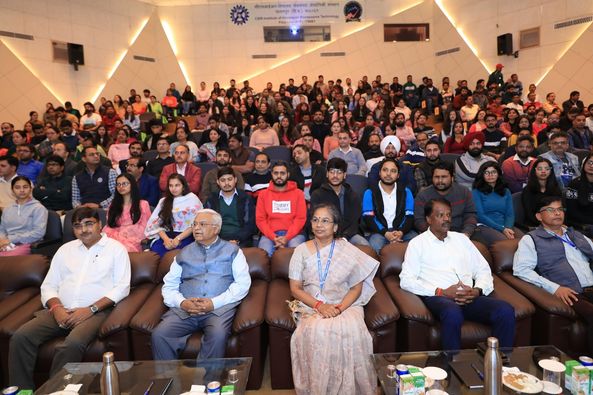
डा. एन. कलैसेल्वी, महानिदेशक, सीएसआईआर ने सीएसआईआर-आईएचबीटी के वैज्ञानिकों, कार्मिकों एवं शोधार्थियों को दिनांक 30 अक्तूबर 2022 को संबोधित किया। उल्लेखनीय है कि डा. एन. कलैसेल्वी, सीएसआईआर के निदेशकों की दो दिवसीय सम्मेलन की अध्यक्षता करने के लिए सीएसआईआर-आईएचबीटी पालमपुर के दौरे पर आयी हुई हैं।
अपने संबोधन में डा. एन. कलैसेल्वी ने संस्थान द्वारा किए जा रहे शोध एवं विकास कार्यों की उपलब्धियों के लिए उनके समर्पण, ऊर्जा एवं लगन के लिए सभी स्टाफ सदस्यों की सराहना की। विज्ञान के हर क्षेत्र में संस्थान ने सराहनीय कार्य किया है। यह सब कुशल नेतृत्व एवं टीम भावना के माध्यम से साकार हुआ है। सीएसआईआर-आईएचबीटी एक ऐसा श्रेष्ठ संस्थान है जहां विज्ञान के संपूर्ण पैकेज के साथ प्रत्येक कार्य सुव्यवस्थित हैं।
उन्होंने आगे बताया कि विज्ञान के क्षेत्र में अपार संभावनाएं हैं और हम मूल्यवर्धन के माध्यम से देश की आर्थिकी को सुदृढ़ कर वैश्विक स्तर पर भारत को अग्रणी देशों की श्रेणी में ला सकते हैं। शोधार्थयों को प्रोस्ताहित करते हुए उन्होंने कहा कि 21वीं सदी भारत की है और कुशल नेतृत्व के माध्यम से हमें अपने सच्चे प्रयासों, आइडिया, सकारात्मक ऊर्जा के साथ देश को समर्थ, सक्षम एवं खुशहाल बनाने में अपना योगदान देना होगा।
इससे पूर्व संस्थान के निदेशक डा. संजय कुमार ने डा. एन. कलैसेल्वी, महानिदेशक, सीएसआईआर का स्वागत करते हुए सीएसआईआर को अग्रणी विज्ञान संस्था बनाने के लिए टीम सीएसआईआर-आईएचबीटी के पूर्ण सहयोग की प्रतिबद्धता दोहराई।
Dr. N. Kalaiselvi, honorable Director General, CSIR and Secretary DSIR addressed the scientists, staff, and researchers of CSIR-IHBT at its campus on 30 October 2022. It is noteworthy that DG CSIR was on a visit to the two-day CSIR Directors’ Conference 2022: CSIR for Society and Industry at CSIR-IHBT Palmapur. Dr. Sanjay Kumar, Director CSIR-IHBT, warmly welcomed Dr. N. Kalaiselvi and introduced the institute.
In her address, Dr. N. Kalaiselvi appreciated all the Scientists, research scholars and staff members of the institute for their dedication and energy towards research and development work. She also mentioned that IHBT has done commendable work in the field of startup, entrepreneurship and livelihood. CSIR-IHBT is one of the best institutes “where everything is in its place and there is a place for everything”. She further said that there is immense potential in the field of science, and we can strengthen the country's economy through value addition and bring India to the ranks of leading countries at the global level. Encouraging the researchers of the institute, she further said; the 21st century belongs to India and through efficient leadership, sincere efforts, ideas and positive energy we can make our country no. 1 in the world.
Dr. Sanjay Kumar assured that team CSIR-IHBT is committed to serve the society through relevant science and technology.
76th Independence Day celebrations at CSIR-IHBT
closeसीएसआईआर-आईएचबीटी में 76वां स्वतंत्रता दिवस समारोह
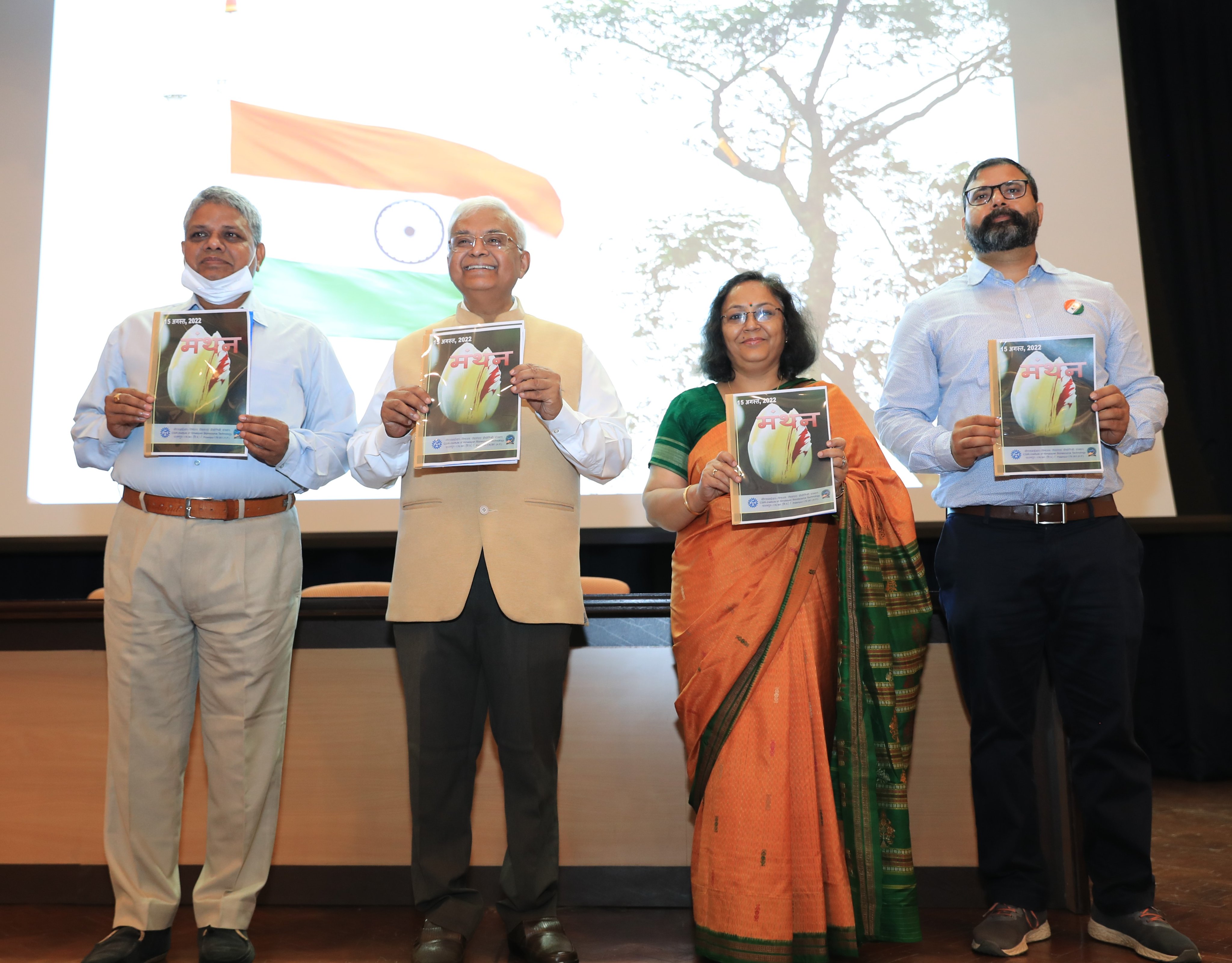
सीएसआईआर- हिमालय जैवसंपदा प्रौद्योगिकी संस्थान में 76वां स्वतंत्रता दिवस बड़े उत्साह और उल्लास के साथ मनाया गया। इस अवसर पर परिवार के सदस्यों सहित बच्चों ने भी हिस्सा लिया। संस्थान के निदेशक, डॉ संजय कुमार ने राष्ट्रीय ध्वजारोहण कर उपस्थित सभा को संबोधित किया। संस्थान के सेंटर फॉर हाई एल्टीट्यूड बायोलॉजी (सीईएचएबी), रिबलिंग (केलांग, लाहौल) में भी राष्ट्रीय ध्वज फहराया गया । सीईएचएबी में यह समारोह वैज्ञानिकों और कर्मचारियों की उपस्थिति में किया गया जिसका प्रसारण आईएचबीटी में एमएस टीम्स द्वारा किया गया । इस शुभ अवसर पर स्टाफ क्लब की “मंथन” पत्रिका के नए अंक का विमोचन भी हुआ। ततपश्चात निदेशक महोदय एवं स्टाफ सदस्यों द्वारा संस्थान परिसर में फ्लेम ट्री (ड्लोनिक्स रेजिया (हुक.) राफ.), प्लुमेरिया (प्लुमेरिया अल्बा एल.) और कपूर (सिनामोमम कपूर एल.) के 75 पौधों का पौधारोपण किया गया। चयनित पौधों की प्रजातियों का रंग, फ्लेम ट्री के लिए केसरिया, प्लुमेरिया के लिए सफेद और कपूर के लिए हरा, राष्ट्रीय ध्वज के प्रतीक के रूप में स्वतंत्रता के 75 वर्ष, "आजादी का अमृत महोत्सव को मानाने के उद्देशय से किया गया। इस अवसर पर संस्थान के निदेशक ने संस्थान में आयोजित विभिन्न खेल गतिविधियों के लिए पुरस्कार वितरित किए। इस दिन के लिए आयोजित विभिन्न मनोरंजक और खेल गतिविधियों में कर्मचारियों और बच्चों ने भाग लिया।
CSIR- Institute of Himalayan Bioresource Technology celebrated the 76th Independence Day with great enthusiasm and gaiety. Family members, including children, were present during the function. Dr Sanjay Kumar, Director of the institute, hoisted the national flag and addressed the gathering. The national flag was also hoisted at the institute’s Centre for High Altitude Biology (CeHAB) at Ribling (Keylong, Lahaul); the ceremony was held in the presence of scientists and staff at CeHAB and was witnessed at CSIR-IHBT through MS Teams. On this auspicious occasion, a new issue of "Manthan" magazine of Staff Club was released.
To commemorate 75 years of Independence, “Azadi Ka Amrit Mahotsav”, the Director and staff members planted 75 saplings of flame tree (Dlonix regia (Hook.) Raf.), plumeria (Plumeria alba L.) and camphor (Cinnamomum camphora L.) in the institute premises. The colour of selected plant species, saffron for flame tree, white for plumeria and green for camphor symbolises the tricolour of the national flag.
On this occasion, prizes were distributed for different sports activities held in the institute. The staff and the children participated in different fun and sports activities organised for this day.
CSIR-IHBT celebrated its 40th Foundation Day
closeसीएसआईआर-आईएचबीटी ने मनाया अपना 40वां स्थापना दिवस
CSIR-IHBT celebrated its 40th Foundation Day
सीएसआईआर-हिमालय जैवसंपदा प्रौद्योगिकी संस्थान, पालमपुर, हिमाचल प्रदेश ने 02 जुलाई 2022 को अपना 40वां स्थापना दिवस मनाया। कार्यक्रम की शुरुआत में संस्थान के निदेशक डॉ. संजय कुमार ने मुख्य अतिथि पद्म श्री, पद्म-विभूषण एवं शांति स्वरूप भटनागर पुरस्कार से सम्मानित डा. टी. रामास्वामी, पूर्व सचिव, विज्ञान और प्रौद्योगिकी विभाग, भारत सरकार एवं डिस्टिग्विश्ड प्रोफेसर ऑफ ऐमिनेंस, अन्ना विश्वविद्यालय, चेन्नई का अभिनन्दन एवं स्वागत करते हुये उनका संक्षिप्त परिचय दिया।
इस अवसर पर डा. टी. रामास्वामी ने ‘हिमालयी जैवमंडल के संपोषणीय जैव-आर्थिकी पथ की ओर: आईएचबीटी पथ अन्वेषक के रूप में’ विषय पर स्थापना दिवस संभाषण दिया। सीएसआईआर-आईएचबीटी संस्थान के स्थापना दिवस की शुभकामनाएं देते हुए उन्होंने इस संस्थान के नामकरण एवं उदेश्यों के बारे में बताया कि यह संस्थान समाजिक, पर्यावरणीय, औद्योगिक और अकादमिक लाभ हेतु हिमालयी जैवसंपदा से प्रक्रमों, उत्पादों और प्रौद्योगिकियों की खोज, नवोन्मेष, विकास एवं प्रसार के लक्ष्य के लिए सतत प्रयासरत है। अपने संबोधन में उन्होंने आगे बताया कि विज्ञान एवं प्रौद्योगिकी से देश को बहुत अधिक उम्मीद है अतः हमारा दायित्व है कि राष्ट्र एवं विश्व की अपेक्षाओं को पूरा करने की दिशा में प्रयास करें। जैवआर्थिकी को बढावा देने में हमारी क्या ताकत है तथा इस क्षेत्र में क्या अवसर है, के बारे में विस्तार से बताया। पिछले 40 वर्षों में समाज की सेवा में सीएसआईआर-आईएचबीटी द्वारा किए गए योगदान को उजागर करने के अलावा, माननीय डॉ रामासामी ने संस्थान के लिए भविष्य के अनुसंधान और विकास पथ को भी चिह्नित किया। उन्होंने भारतीय हिमालय जीवमंडल के नाजुक पारिस्थितिकी तंत्र में उपलब्ध जैव संसाधनों के सतत उपयोग के माध्यम से तकनीकी समाधानों के आधार पर जैव अर्थव्यवस्था को बढ़ावा देने के लिए संस्थागत जनादेश को पुनर्स्थापित करने का सुझाव दिया। उन्होंने सतत विकास के लिए तीन स्तंभों यानी सहने योग्य, न्यायसंगत और व्यवहार्य पर जोर दिया। उन्होंने विज्ञान के क्षेत्र में नवोन्मेष, तथा जैवआर्थिकी उत्थान के लिए जैव आधारित उत्पादों के मूल्यवर्धन पर बल दिया तथा संस्थान से आह्वान किया कि वे भारतीय हिमालयी क्षेत्र की चुनौतियों को स्वीकरते हुए जैवआर्थिकी की दिशा में आगे बढ़ें। डा. रामास्वामी ने संस्थान की विभिन्न शोध गतिविधियों एवं सुविधाओं का अवलोकन भी किया। उनकी यात्रा के दौरान, सीएसआईआर-आईएचबीटी में समग्र सामाजिक लाभ के लिए विकसित विभिन्न किसानों और उद्योग केंद्रित प्रौद्योगिकियों को भी प्रदर्शित किया गया।
इससे पूर्व संस्थान के निदेशक डा. संजय कुमार ने संस्थान के वर्ष 2021-22 के वार्षिक प्रतिवेदन को प्रस्तुत किया। उन्होंने बताया कि अरोमा मिशन चरण- II के अन्तर्गत संस्थान ने 1398 हेक्टेयर क्षेत्र को सगंध फसलों अंतर्गत समाहित किया और बारह राज्यों और दो केंद्र शासित प्रदेशों में इसकी खेती का विस्तार किया। वर्ष के दौरान, हिमाचल प्रदेश ने 7.3 टन तेल के उत्पादन के साथ देश में सगंध गेंदे के तेल के शीर्ष उत्पादक के रूप में अपना स्थान बनाए रखा है। कुल मिलाकर, हमारे संस्थान से जुड़े किसानों द्वारा सगंध फसलों की खेती से लगभग ₹15.66 करोड़ मूल्य के सगंध तेल का उत्पादन किया गया। सीएसआईआर-फ्लोरिकल्चर मिशन के अंतर्गत, पुष्प फसलों के क्षेत्र में 350 हेक्टेयर तक का विस्तार किया गया, जिससे 1004 किसानों लाभान्वित हुए। संस्थान में इस वर्ष ट्यूलिप गार्डन एक मुख्य आकर्षण रहा। संस्थान के प्रयासों से भारत के कई राज्यों में 448 हेक्टेयर क्षेत्र को स्टीविया की खेती के अंतर्गत लाया गया। देश में हींग की खेती के लिए 214 स्थानों पर 4 हेक्टेयर क्षेत्र को खेती के अन्तर्गत लाते हुए 33000 पौधों की आपूर्ति की गई। हिमाचल प्रदेश और उत्तराखंड के अलावा जम्मू-कश्मीर एवं लद्दाख में किसानों तक बेहतर पहुंच के लिए 519 किसानों और 53 कृषि अधिकारियों को प्रशिक्षण दिया गया। राज्य कृषि विभाग के सहयोग से प्रदेश में किसानों को 6859 किलो केसर के कंदों की आपूर्ति की गई ताकि केसर उत्पादन को बढ़ावा दिया जा सके। संस्थान द्वारा उत्तर पूर्वी राज्यों में सेब की कम-चिलिंग किस्मों का विस्तार लगभग 117.5 एकड़ क्षेत्र में किया गया। इन प्रयासों का उल्लेख भारत के माननीय प्रधान मंत्री श्री नरेंद्र मोदी द्वारा 25 जुलाई 2021 को ‘मन की बात’ कार्यक्रम में भी किया गया। एक नई पहल के अन्तर्गत, आईएचबीटी ने हिमाचल में दालचीनी की संगठित खेती की शुरुआत की। संस्थान में सीएसआईआर-टीकेडीएल प्वाइंट ऑफ प्रेजेंस की स्थापना की गई। जिसमें सोवा रिग्पा (तिब्बती चिकित्सा पद्धति) पर ध्यान केंद्रित किया गया है, जहां इसे प्रलेखित और डिजिटाइज़ किया जा रहा है। सीएसआईआर-उच्च तुंगता जीवविज्ञान केंद के प्रक्षेत्र जीनबैंक को 40 संकटग्रस्त पौधों की प्रजातियों से समृद्ध किया गया।
इस अवसर पर डा. टी. रामास्वामी ने संस्थान के वार्षिक प्रतिवेदन 2021-22 तथा ‘आईएचबीटी का इतिहास’ का विमोचन किया। इस अवसर पर कृषि, जैव,रसयान,आहारिकी एवं खाद्य तथा पर्यावरण प्रौद्यौगिकी के क्षेत्र में महत्वपूर्ण शोध उपलब्धियों के संग्रह भी विमोचित किए गए। साथ में तुलसी की खेती एवं कई अन्य प्रकाशनों का भी विमोचन किया गया। समारोह के दौरान हरियाणा केन्द्रीय विश्वविद्यालय, विज्ञान और प्रौद्योगिकी विभाग, सिक्किम सरकार के अलावा 03 अन्य औद्योगिक इकाइयों के साथ समझौता ज्ञापनों पर भी हस्ताक्षर किए गए।
समारोह में स्थानीय कृषि विश्वविद्यालय के पूर्व कुलपति डा. एस. के. शर्मा, चिन्मय तपोवन ट्रस्ट की निदेशक डा. क्षमा मैत्रे, आईवीआरआई, आईजीएफआरआई, पालमपुर विज्ञान केन्द्र, कृषि विश्वविद्यालय के वैज्ञानिकों ने प्रतिभागिता की। इस समारोह में जिज्ञासा कार्यक्रम के अंतर्गत केंद्रीय विद्यालय पालमपुर व न्यूगल पब्लिक सीनियर सैकेंडरी स्कूल बिंद्राबन (पालमपुर) के 70 छात्रों व 4 शिक्षकों नें भाग लिया एवं प्रयोगशालाओं का भ्रमण किया | सीएसआईआर-आईएचबीटी संस्थान के स्थापना दिवस में स्थानीय शैक्षणिक स्टाफ, पूर्व कर्मचारी, स्थानीय उद्यमी एवं उत्पादक एवं मीडिया के प्रतिनिधि भी शामिल हुए।
CSIR-Himalayan Institute of Bioresource Technology, Palampur, Himachal Pradesh celebrated its 40th Foundation Day on 02 July 2022. In the beginning, Dr. Sanjay Kumar, Director of the Institute, welcomed the Chief Guest Padma Shri, Padma Bhushan and Shanti Swarup Bhatnagar Awardee Dr. T. Ramasami, Former Secretary, Department of Science and Technology, Government of India and Distinguished Professor of Eminence, Technology Enabling Centre, Anna University, Chennai and gave a brief introduction about him to the audience.
On this occasion, Dr. T. Ramasami delivered a foundation day speech on “Towards Sustainable Bioeconomy Path of Himalayan Biosphere: IHBT as the Path Finder”. While greeting the staff of the Institute on the 40th foundation day, he said that CSIR-IHBT is located in a fragile ecosystem and is mandated to emerge as a global leader on technologies for boosting bioeconomy through sustainable utilization of Himalayan bioresources". Apart from highlighting the contribution made by CSIR-IHBT in the service of the society over the last 40 years, Dr. Ramasami also suggested to focus upon developing technological solutions for sustainable bioeconomy. He is of the opinion that CSIR-IHBT has to play a crucial role of serving the nation as a path finder towards sustainable economy using resources available in Himalayan biosphere. He emphasized on three pillars for sustainable development i.e. Bearable, Equitable and Viable. He stressed upon innovation in the field of science, and value addition of bio-based products for the economical upliftment and called upon the institute to accept the challenges of the fragile Indian Himalayan ecosystem. Dr. Ramasami also visited the research facilities, processing units and fields of the institute. During his visit, various farmers and industry centric technologies developed for the overall social benefit at CSIR-IHBT were also displayed.
Earlier, the director of the Institute, Dr. Sanjay Kumar presented the annual report of the Institute for the year 2021-22. He said that under Aroma Mission Phase-II, the Institute covered an area of 1398 hectares under aromatic crops and expanded its cultivation in twelve states and two union territories. During the year, Himachal Pradesh has maintained its position as the top producer of marigold oil in the country with a production of 7.3 tonnes of oil with institutional efforts. Under the Floriculture Mission, the area was expanded to 350 hectares, benefiting 1004 farmers. Tulip garden established in the Institute has been a major attraction this year. The area under stevia cultivation also extended to 448 hectares in India with concerted efforts of IHBT. For the cultivation of asafoetida in the country, 33000 saplings were supplied and brought 4 hectares under cultivation at 214 places. Apart from Himachal Pradesh and Uttarakhand, 519 farmers and 53 agriculture officers of Jammu & Kashmir and Ladakh were trained. With agriculture department, 6859 kg saffron tubers were supplied to the farmers in the state so that saffron production could be promoted. The area under low-chilling varieties of apples have been extended to about 117.5 acres in the North Eastern States. These efforts were also mentioned in the 'Mann Ki Baat' program on 25 July 2021 by Honourable Prime Minister, Shri Narendra Modi. In a new initiative, IHBT introduced organized cultivation of cinnamon in Himachal. Moreover, CSIR-TKDL Point of Presence has been established in the Institute with a focus to document and digitize Sowa Rigpa (Tibetan system of medicine). He informed that the farm gene bank at Centre of High Altitude Biology was also enriched with 40 threatened Himalayan plant species.
On this occasion, Dr. T. Ramasami released the Annual Report 2021-22 of the Institute and 'History of IHBT'. Along with cultivation manual on Tulsi, compendiums on significant research accomplishments in the fields of agriculture, biotechnology, natural plant products, dietetics & nutrition and environmental technology were also released. Besides 03 industrial units, MoUs with Haryana Central University, Department of Science and Technology, Government of Sikkim were also signed during the event.
Besides former Vice Chancellor of the Agricultural University, Dr. SK Sharma, Director of Chinmaya Tapovan Trust Dr. Kshama Maitre, scientists from IVRI, IGFRI, Palampur Science Centre, Agricultural University were also attended the program. A number of students and teachers from Kendriya Vidyalaya Palampur and Neugal Public Senior Secondary School, Bindraban (Palampur) participated under the Jigyasa program and visited laboratories. Local academic staff, ex-employees, local entrepreneurs and producers and media representatives also graced the foundation day event.
World Environment Day Celebrations at CSIR-IHBT
closeसीएसआईआर-आईएचबीटी में विश्व पर्यावरण दिवस समारोह
World Environment Day Celebrations at CSIR-IHBT
सीएसआईआर-हिमालय जैवसंपदा प्रौद्योगिकी संस्थान ने 6 जून 2022 को विश्व पर्यावरण दिवस मनाया। विश्व पर्यावरण दिवस पर्यावरण की सुरक्षा और संरक्षण हेतु पूरे विश्व में मनाया जाता है। विश्व पर्यावरण दिवस प्रत्येक वर्ष 5 जून को मनाया जाता है पहली बार 1974 मे मनाया गया था।
संस्थान के निदेशक डा. संजय कुमार ने विश्व पर्यावरण दिवस पर प्रकाश डालते हुए बताया कि संस्थान समाजिक, पर्यावरणीय, औद्योगिक और अकादमिक लाभ हेतु हिमालयी जैवसंपदा से प्रक्रमों, उत्पादों और प्रौद्योगिकियों की खोज, नवोन्मेष, विकास एवं प्रसार के लक्ष्य के लिए सतत प्रयासरत है। संस्थान ने हिमालयी पर्यावरण के लाभों का दोहन करते हुए आजीविका और उत्पाद विकसित करने के लिए विशिष्ट उच्च मूल्यवान फसलों को प्रोत्साहित करने के लिए अनूठी/अभिनव पहल की है। हमारा संस्थान अपने शोध एवं विकास गतिविधियों के माध्यम से हिमालयी क्षेत्र के पर्यावरण संरक्षण में योगदान कर रहा है। संस्थान ने खेती, जीन बैंक के माध्यम से सिनोपोडोफिलम हेक्सेंड्रम, पिक्रोराइजा कुरोआ, फ्रिटिलारिया रॉयली और ट्रिलियम गोवेनियम जैसे दुर्लभ, लुप्तप्राय और संकटग्रस्त सहित प्रति इकाई भूमि क्षेत्र में उत्पादकता और लाभप्रदता बढ़ाने और दुर्लभ, लुप्तप्राय और संकटग्रस्त पौधों की स्थिति को बदलने के लिए उनकी कृषि प्रौद्योगिकियों के साथ-साथ विविधता सुधार, औषधीय पौधों की उपलब्धता के लिए पहल की है । पिक्रोराइजा कुरोआ और फ्रिटिलारिया रॉयली के उत्कृष्ट पौधों को टिशू कल्चर तकनीक के माध्यम से बहुगुणित किया गया और संस्थान ने उनको प्राकृतिक वास में भी लगाया गया है।
डॉ. एस एस सामंत, निदेशक, हिमालय वन अनुसंधान संस्थान (एचएफआरआई), शिमला ने "भारतीय हिमालयी क्षेत्र के संदर्भ में जैव विविधता संरक्षण और प्रबंधन" विषय पर व्याख्यान दिया। अपने संबोधन में डॉ. सामंत ने भारतीय वानिकी शिक्षा एवं अनुसंधान परिषद एवं इसके संस्थानों के कार्यकलापों के बारे में जानकारी दी। उन्होंने आगे बताया कि भारतीय हिमालयी क्षेत्र जैवविविधता, वनस्पति और जीवों से समृद्ध है। हिमालयी इकोसिस्टम का विकास समग्रता से ही किया जा सकता है। हिमालय की पादपसंपदा अत्यन्त विशेष है तथा जलवायु परिवर्तन का प्रभाव अब इस क्षेत्र में भी दिख रहा है जिससे वानस्पतिक और फसल पद्धति में परिवर्तन आया है। हिमालयी जैवसंपदा आर्थिक दृष्टि से अत्यन्त महत्वपूर्ण है अत: हमें इसके संरक्षण में अपनी सक्रिय योगदान करने की आवश्यकता है। उन्होने स्थान विशिष्ट खतरे द्वारा पौधों का वर्गीकरण तथा एवं पादपों के संरक्षण एवं प्रवर्धन हेतु फील्ड सर्वेक्षण से प्राप्त डाटा पर निर्भरता पे विशिस्ट ज़ोर दिया। अपने प्रस्तुतिकरण में उन्होंने हिमालय के क्षेत्रवार विशेषताओं, विविधता, संरक्षण, सामाजिक आर्थिक पहलुओं पर तथ्यात्मक विस्तृत जानकारी प्रदान की।
इस समारोह में, संस्थान के कर्मचारियों एवं छात्रों ने बढ-चढ कर भाग लिया। कार्यक्रम का समापन सीएसआईआर-आईएचबीटी के वरिष्ठ प्रधान वैज्ञानिक डॉ अमित कुमार के धन्यवाद प्रस्ताव के साथ हुआ।
CSIR-Himalayan Institute of Bioresource Technology celebrated World Environment Day on 6 June 2022. World Environment Day is celebrated all over the world to protect the environment. It is celebrated every year on 5th June, since 1974.
Dr. Sanjay Kumar, Director, CSIR-IHBT in his welcome address said that the Institute is constantly striving towards the goal of discovering, innovating, developing and disseminating processes, products and technologies from the Himalayan Bio-resources for social, environmental, industrial and academic benefits. The Institute has taken unique/innovative initiatives to encourage specific high value crops to develop livelihoods and products, while harnessing the benefit the of Himalayan environment. CSIR-IHBT is contributing to the environmental protection of the Himalayan region through its research and development activities. The institute has developed agrotechnologies for Rare and Threatened plant species such as Sinopodophyllum hexandrum, Picrorhiza kuroa, Fritillaria royalii and Trillium govanium to increase their productivity and profitability per unit land area. Efforts are also made to change their Rare and Threatened status through augmentation of natural habitat. High-valued plants of Picrorhiza kuroa and Fritillaria royali were multiplied through the tissue culture technique and the institute has also planted them in their natural habitat.
Dr. SS Samant, Director, Himalayan Forest Research Institute (HFRI), Shimla delivered a lecture on "Biodiversity Conservation and Management in context to Indian Himalayan Region". In his address, Dr. Samant gave information about the activities of the Indian Council of Forestry Research and Education and its institutions. He further added that the Indian Himalayan region is rich in biodiversity. The flora and fauna of the Himalayas are very special and the effect of climate change is now visible in this region as well, which has led to changes in botanical and cropping patterns. Himalayan biodiversity is very important from an economic point of view, therefore, sincere efforts are required for its conservation. He laid special emphasis on the classification of plants by location-specific threats and reliance on data received from field surveys for their conservation and management. In his presentation, he provided detailed information on the region-wise features, diversity, conservation, and socio-economic aspects of the Himalayas.
In this function, the staff and students of the institute enthusiastically participated. The program was coordinated by Dr R.K. Sud, Chief Scientist concluded with a vote of thanks by Dr. Amit Kumar, Senior Principal Scientist, CSIR-IHBT.
It is pertinent to mention that the World Environment Day is celebrated every year on June 5 all across the globe as an initiative of the United Nations Environment Programme (UNEP) to spread the importance of conserving planet Earth and to pledge to give back to the mother nature in all the possible ways to preserve, conserve and flourish all biological lives on the globe. The occasion calls for transformative changes to policies to enable cleaner, greener, and sustainable living in harmony with nature. It is in the year 1972, that for the first time in the world, a conference on the environment was held in Stockholm, which is known as United Nations Conference on the Human Environment (Stockholm Conference). This initiative led to the creation of United Nations Environment Programme and World Environment Day celebration.
The theme World Environment Day 2022 is “Only One Earth” which fundamentally focuses on our role as the citizens of the Earth, to protect the environment and to encourage sustainable living each time each day.
सीएसआईआर-आईएचबीटी में राष्ट्रीय प्रौद्योगिकी दिवस समारोह
closeसीएसआईआर-आईएचबीटी में राष्ट्रीय प्रौद्योगिकी दिवस समारोह
National Technology Day Celebrations at CSIR-IHBT
सीएसआईआर-हिमालय जैवसंपदा प्रौद्योगिकी संस्थान ने 11 मई 2022 को राष्ट्रीय प्रौद्योगिकी दिवस मनाया। विज्ञान और प्रौद्योगिकी के साथ समाज और उद्योग के एकीकरण के लिए प्रौद्योगिक रचनात्मकता और वैज्ञानिक सशक्तिकरण की खोज के प्रतीक के रूप में राष्ट्र प्रत्येक वर्ष 11 मई को राष्ट्रीय प्रौद्योगिकी दिवस मनाता है। यह दिवस 1998 में पोखरण में सफलतापूर्वक किए गये परमाणु परीक्षण तथा विश्व का छठा परमाणु देश बनने पर मनाया जाता है।
संस्थान के निदेशक डा. संजय कुमार ने छात्रों, अघ्यापकों और अन्य उपस्थित जन का स्वागत करते हुए प्रौद्योगिकी दिवस की शुभकामनाएं दी। अपने संबोधन में उन्होंने बताया कि कैसे डिजीटल प्रौद्योगिकी ने हमारे जीवन में परिवर्तन लाया है। इससे ज्ञान के प्रसार को गति मिली है। संस्थान अपने मिशन मोड परियोजनओं के माध्यम से समुदायों के समाजिक-आर्थिक विकास में अपना योगदान कर रहा है। अरोमा मिशन के अन्तर्गत संस्थान किसानों को सगंध फसलों को उगाने एवं इसके प्रसंस्करण द्वारा उनकी आय बढ़ाने में सक्रिय भूमिका निभा रहा है जिससे किसान परम्परागत फसलों की अपेक्षा अधिक आय प्राप्त करके आत्मनिर्भता की ओर बढ़ रहे हैं। अपने संबोधन में उन्होंने वैज्ञानिक अभिरुचि को बढ़ाने के लिए छात्रों का मार्गदर्शन किया। उन्होंने देश की महत्वपूर्ण प्रौद्योगिक उपलब्धियों तथा विभिन्न वैज्ञानिक उपलब्घियों पर चर्चा की जिसके कारण आज देश आत्मनिर्भर बना है।
समारोह के मुख्य अतिथि प्रो. पुलोक कुमार मुखर्जी, निदेशक, जैवसंसाधन एवं स्थायी विकास संस्थान (आईबीएसडी), इंफाल, मणिपुर ने ‘एथनोफार्माकोलोजीः परम्परा से परिवर्तन के लिए एकीकृत शास्त्र और विज्ञान’ विषय पर प्रौद्योगिकी दिवस संभाषण दिया। अपने संबोधन में डा. मुखर्जी ने स्वास्थ्य के क्षेत्र में पादप आधारित दवा के विकास में योगदान पर प्रकाश डाला। लोकशास्त्र परम्परा के अनुसार परम्परागत ज्ञान को सहेजने और इसका आधुनिक दवा क्षेत्र में उपयोग और प्रसार की आवश्यकता है। संपूर्ण हिमालयी क्षेत्र औषधीय पादप संपदा का स्रोत है। आवश्यकता इसके प्रलेखन की है ताकि आने वाले समय में गुणवत्ता नियंत्रण और मूल्यांकन करेके संभावित दवाओं का निर्माण करके इस संपदा का उपयोग करके क्षेत्र की जैव आर्थिकी का उन्नयन किया जा सके। यह आत्मनिर्भर भारत की और एक सार्थक कदम होगा।
समारोह में “जिज्ञासा” कार्यक्रम के अंतर्गत प्रदेश के काँगड़ा जिले के नवोदय विद्यालय, पपरोला, राजकीय विद्यालय, सलियाना, डीएवी पालपमुर, डीएवी, आलमपुर, न्यूगल पब्लिक स्कूल, बृंदावन, परमार्थ स्कूल, बैजनाथ, ग्रीन फील्ड स्कूल, नगरोटा के लगभग 100 छात्रों व शिक्षकों नें भाग लिया तथा प्रयोगशालाओं का भ्रमण किया। इन विद्यार्थियों को संस्थान में विज्ञान के बारे में रोचक जानकारी देने के साथ यह बताया कि दैनिक जीवन में इसका क्या महत्त्व है।
इस अवसर पर, सीएसआईआर-आईएचबीटी द्वारा मैसर्स बिटबेकर रामनट्टुकरा, कोझीकोड, केरल के साथ यात्रा/पॉकेट परफ्यूम एवं वायु फ्रेशनर और मैसर्स अमलगम बायोटेक, अमलगम इंजीनियरिंग पुणे (एमएच) के साथ "कम्पोस्ट बूस्टर- रात की मिट्टी/रसोई के कचरे के स्थिरीकरण के लिए प्रौद्योगिकी हस्तांतरण समझौतों पर हस्ताक्षर किए गए। "आईबीएसडी और सीएसआईआर-आईएचबीटी के बीच अनुसंधान एवं विकास सहयोग के उद्देश्य से एक समझौता ज्ञापन पर भी हस्ताक्षर किए गए।
क्षेत्र के गणमान्य व्यक्तियों, सीएसआईआर-आईएचबीटी के वैज्ञानिकों, शोध छात्रों, कर्मियों एवं मीडिया प्रतिनिधियों ने भी समारोह की शोभा बढ़ाई।
CSIR-Institute of Himalayan Bioresource Technology (IHBT) celebrated National Technology Day on 11 May 2022. The nation celebrates National Technology Day on 11 May every year as a symbol of the pursuit of technological creativity and scientific empowerment for integration of society and industry through science and technology. This day is celebrated on the successful nuclear test conducted in Pokhran in 1998 and becoming the sixth nuclear country in the world.
Dr. Sanjay Kumar, Director of the institute address the august gathering. In his address, he told how digital technology has brought a change in our lives. This has given impetus to the spread of knowledge. The Institute is contributing to the socio-economic development of the communities through its mission mode projects. Under the Aromatic and Medicinal Plant Mission, the institute is playing an active role in increasing the income of farmers by growing aromatic crops and its processing, due to which farmers are moving towards self-reliance by getting more income than traditional crops. In his address, he guided the students to develop scientific aptitude. He discussed the important technological and scientific achievements, which help in making concerted efforts towards self-reliant India.
Chief guest of the function Prof. Pulok Kumar Mukherjee, Director, Institute of Bioresources and Sustainable Development (IBSD), Imphal, Manipur delivered the Technology Day speech on the theme 'Ethnopharmacology: Integrating Shastra and Science from Tradition to Translation'. In his address, Dr. Mukherjee highlighted the contribution in the development of plant based medicine in the field of health. According to the folklore tradition, there is a need to save the traditional knowledge and its use and dissemination in the modern medicine field. The entire Himalayan region is a source of medicinal plant wealth. There is a need for its documentation so that the bio-economy of the area can be upgraded by utilizing this wealth and manufacturing potential drugs through quality control and evaluation in the future. It will be another meaningful step towards self-reliance.
Under "JIGYASA", over 100 students and teachers of Navodaya Vidyalaya, Paprola, Government School, Saliana, DAV, Palampur, DAV, Alampur, Neugal Public School, Brindavan, Parmarth School, Baijnath, Green Field School, Nagrota participated in the Technology Day function and visited various laboratories.
On this occasion, CSIR-IHBT signed Technology Transfer Agreements with M/s Bitbaker Ramanattukara, Kozhikode, Kerala for travel/pocket perfume and air freshener and M/s Amalgam Biotech, Amalgam Engineering Pune (MH) for “Compost Booster – Stabilization of Night Soil/Kitchen Waste. A Memorandum of Understanding between IBSD and CSIR-IHBT aimed at R&D cooperation was also signed.
Dignitaries from the Palampur and faculty from adjoining institutes, scientists, research students & staff of CSIR-IHBT and media representatives also graced the function.
सीएसआईआर-आईएचबीटी में पोषण मैत्री अभियान पर कार्यक्रम
closeसीएसआईआर-आईएचबीटी में पोषण मैत्री अभियान पर कार्यक्रम
सीएसआईआर-आईएचबीटी में दिनांक 25 अप्रैल 2022 को महिला एवं बाल विकास निदेशालय, भारत सरकार के सहयोग से पोषण अभियान के अन्तर्गत सीएसआईआर-आईएचबीटी द्वारा समन्वित पोषण मैत्री कार्यक्रम की प्रगति एवं भविष्य कार्ययोजना पर समारोह किया गया।
समारोह में मुख्य अतिथि डॉ. निपुण जिंदल, उपायुक्त कांगड़ा, हिमाचल प्रदेश ने पोषण मैत्री कार्यक्रम के सफल संचालन के लिए सीएसआईआर-आईएचबीटी, बाल विकास परियोजना अधिकारियों एवं सभी उपस्थित प्रतिभागियों को बधाई दी। अपने संबोधन में उन्होंने बताया कि राष्ट्रीय परिवार और स्वास्थ्य सर्वेक्षण 2016 एवं 2020 के आंकड़े बहुत ही चिंतनीय हैं। बच्चों एवं महिलाएं सामान्य से कम वजन, स्टंटिंग या एनीमिया से कुपोषित हैं। पोषण पर नीति तर्कसंगत होनी चाहिए। संस्थान द्वारा पोषण हेतु विकसित उत्पादों के परिणाम एवं कार्यक्रम बहुत ही सकारात्मक हैं। इसे देखते हुए इस कार्यक्रम को पूरे जिला कांगड़ा में विस्तार करने पर विचार किया जाएगा। साथ ही 0 से 2 वर्ष के बच्चों को भी इस पोषण अभियान के अन्तर्गत लाने की आवश्यकता है।
इससे पूर्व डॉ. संजय कुमार, निदेशक, सीएसआईआर-आईएचबीटी ने बताया कि संस्थान ने बच्चों एवं महिलाएं के लिए पोषण हेतु आयरन, प्रोटीन और फाइबर युक्त उत्पादों को विकसित किया है। विटामिन डी से भरपूर सिटाके मशरुम केप्सूल भी तैयार किए हैं। उन्होंने आगे बताया कि सीएसआईआर-आईएचबीटी ने अनाजों और दालों, सूक्ष्म शैवाल और कम उपयोग वाले कृषि-बागवानी उत्पादों का उपयोग करके प्रोटीन एवं सूक्ष्म पोषक तत्वों के कुपोषण से निपटने के लिए विभिन्न कम लागत वाले उत्पाद विकसित किए हैं। प्रि-क्लीनिकल पशु मॉडल में इसकी जैव-प्रभावकारिता के लिए उत्पादों का मूल्यांकन किया गया है और बड़े पैमाने पर पूरक कार्यक्रमों में एकीकरण के लिए चिकित्सकीय परीक्षण भी किया गया है।
संस्थान के निदेशक डा. संजय कुमार ने माननीय राज्यपाल का स्वागत करते हुए संस्थान की प्रमुख उपलब्धियों एवं गतिविधियों का विवरण प्रस्तुत करते हुए बताया कि संस्थान द्वारा किसानों को सुगंधित फसलें विशेषकर जंगली गेंदे को उगाने एवं इसके प्रसंस्करण के लिए अलग-अलग राज्यों में आसवन इकाइयाँ स्थापित की गईं। संस्थान, ग्रामीण क्षेत्रों में जंगली गेंदे, दमस्क गुलाब, लेमन घास, सुगंधबाला आदि जैसे सुगंधित फसलों की खेती और प्रसंस्करण द्वारा किसानों की आय बढ़ाने में सक्रिय भूमिका निभा रहा है जिससे किसान परम्परागत फसलों की अपेक्षा अधिक आय प्राप्त करके आत्मनिर्भता की ओर बढ़ रहे हैं। प्रशिक्षण कार्यक्रमों के माध्यम से किसानों, बेरोजगार युवाओं, उद्यमियों में क्षमता निर्माण संस्थान का एक महत्वपूर्ण पक्ष रहा है। उन्होंने कहा कि संस्थान ने बड़ी संख्या में लोगों को फूलों की खेती और शहद उत्पादन के क्षेत्रों से जोड़ने में महत्वपूर्ण भूमिका निभाई है। दालचीनी एवं मोती उत्पादन के क्षेत्र में भी संस्थान ने कदम आगे बढ़ाए हैं। हींग और केसर की शुरूआत के अलावा, संस्थान ने दालचीनी और मोती की खेती के क्षेत्र में भी प्रगति की है। उन्होंने आगे कहा कि प्रशिक्षण कार्यक्रमों के माध्यम से किसानों, बेरोजगार युवाओं, उद्यमियों के बीच क्षमता निर्माण संस्थान का एक महत्वपूर्ण पहलू रहा है।
इस अवसर पर डॉ विद्याशंकर, सीएसआईआर-आईएचबीटी ने पोषण अभियान के अंतर्गत किए गए कार्यों पर संक्षिप्त प्रेजेंटेशन दी। श्री अश्विनी कुमार, जिला कार्यक्रम अधिकारी एवं श्रीमती रेणु शर्मा, बाल विकास परियोजना अधिकारी, पंचरूखी ने भी अपने विचार रखे।
इस कार्यक्रम में उपमडंल अधिकारी डा. अमित गुलेरिया, बाल विकास परियोजना अधिकारी बैजनाथ, पंचरूखी, भवारना, सुलह, लंबागांव, पोषण अभियान सुपरवाइजर एवं समन्वयक, आंगनबाड़ी एवं आशा कार्यकर्ता और सीएसआईआर-आईएचबीटी संस्थान के स्टाफ ने प्रतिभागिता की।
सीएसआईआर-आईएचबीटी में राष्ट्रीय विज्ञान दिवस का आयोजन
closeसीएसआईआर-आईएचबीटी में राष्ट्रीय विज्ञान दिवस का आयोजन
National Science Day celebration at CSIR-IHBT
हिमाचल को मिली अपनी मिठाई - 'रेडी टू ईट इंस्टेंट सीरा (हिमाचली स्वीट)'
Himachal gets its sweet - Ready to Eat instant Seera (Himachali Sweet)
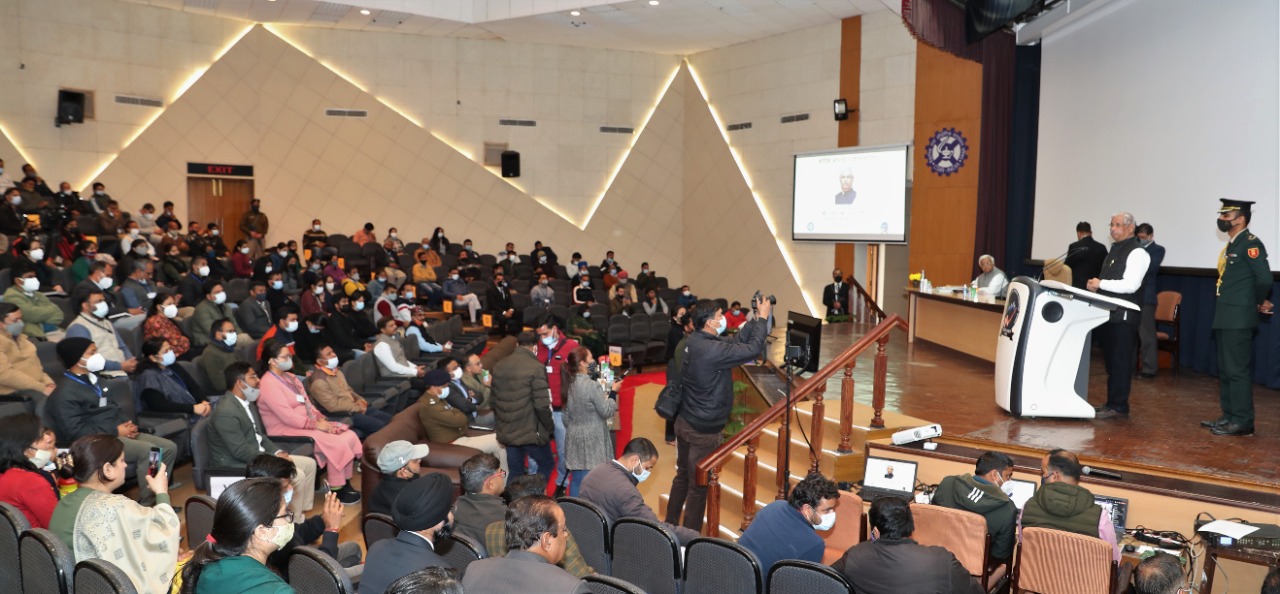
सी.एस.आई.आर.-हिमालय जैवसंपदा प्रौद्योगिकी संस्थान, पालमपुर में हर वर्ष की भांति 28 फरवरी को राष्ट्रीय विज्ञान दिवस मनाया गया। डा. चन्द्रशेखर वैंकटरमन द्वारा 28 फरवरी 1928 को ‘रमन प्रभाव’ की खोज के लिए उन्हें 1930 में भौतिकी के लिए नोबल पुरस्कार प्रदान किया गया था। इस खोज के स्मरण में प्रत्येक वर्ष इस दिन को पूरे देश में राष्ट्रीय विज्ञान दिवस के रुप में मनाया जाता है।
इस अवसर पर मुख्य अतिथि महामहिम राज्यपाल हिमाचल प्रदेश श्री राजेंद्र विश्वनाथ आर्लेकर ने राष्ट्रीय विज्ञान दिवस की शुभकामनाएं देते हुए संस्थान शोध गतिविधियों एवं उद्यमिता विकास एवं ग्रामीण आर्थिकी के उन्नयन में महत्वपूर्ण भूमिका एवं योगदान के लिए संस्थान की सराहना की।अपने संबोधन में राज्यपाल ने कहा कि विज्ञान का उपयोग मानव जाति के उत्थान के लिए होना चाहिए। माननीय राज्यपाल ने अपने संबोधन में कहा कि विज्ञान में हमारी शिक्षा अतीत में हमारे पूर्वजों से विरासत में मिली है। उन्होंने आगे कहा कि किसी भी विज्ञान प्रयास का अंतिम उद्देश्य समाज कल्याण और जीवन की सुगमता को बढ़ावा देना है। यह महत्वपूर्ण है कि वैज्ञानिक ज्ञान को तर्कसंगत तरीके से लागू किया जाए अन्यथा यह विनाश का कारण बन सकता है। उन्होंने वैज्ञानिकों को टीम भावना के माध्यम से जन समुदाय के उत्थान के लिए कार्य करने का आह्वान किया । उन्होंने इसे कविता के माध्यम से बताया ‘चलो जलाएं दीप वहां जहां अभी भी अंधेरा है।’
इस अवसर पर राज्यपाल महोदय ने ऑनलाइन माध्यम से प्रदेश के 6 दूरदराज के क्षेत्रों में तेल आसवन इकाईयों का लोकापर्ण किया तथा स्थानीय किसानों से विचार सांझा तथा संस्थान परसिर में पंहुचे प्रगतिशील किसानों को सगंध फसलों की रोपण एवं बीज सामग्री भी प्रदान की। संस्थान के ट्यूलिप गार्डन का उद्घाटन और संस्थान के विभिन्न प्रकाशनों का विमोचन भी राज्यपाल महोदय के करकमलों द्वारा किया गया। राज्यपाल महोदय ने ‘सिडार हाइड्रोसोल’ नामक स्टार्ट-अप के उत्पादों को लोकार्पित किया। राज्यपाल महोदय ने संस्थान परिसर में पौधारोपण एवं नए प्रशासनिक भवन का शिलान्यास किया। राज्यपाल की उपस्थिति में 'टी माउथवॉश' और 'रेडी टू ईट इंस्टेंट सीरा (हिमाचली स्वीट)' के लिए दो प्रौद्योगिकी हस्तांतरण समझौतों पर भी हस्ताक्षर किए गए।
संस्थान के निदेशक डा. संजय कुमार ने माननीय राज्यपाल का स्वागत करते हुए संस्थान की प्रमुख उपलब्धियों एवं गतिविधियों का विवरण प्रस्तुत करते हुए बताया कि संस्थान द्वारा किसानों को सुगंधित फसलें विशेषकर जंगली गेंदे को उगाने एवं इसके प्रसंस्करण के लिए अलग-अलग राज्यों में आसवन इकाइयाँ स्थापित की गईं। संस्थान, ग्रामीण क्षेत्रों में जंगली गेंदे, दमस्क गुलाब, लेमन घास, सुगंधबाला आदि जैसे सुगंधित फसलों की खेती और प्रसंस्करण द्वारा किसानों की आय बढ़ाने में सक्रिय भूमिका निभा रहा है जिससे किसान परम्परागत फसलों की अपेक्षा अधिक आय प्राप्त करके आत्मनिर्भता की ओर बढ़ रहे हैं। प्रशिक्षण कार्यक्रमों के माध्यम से किसानों, बेरोजगार युवाओं, उद्यमियों में क्षमता निर्माण संस्थान का एक महत्वपूर्ण पक्ष रहा है। उन्होंने कहा कि संस्थान ने बड़ी संख्या में लोगों को फूलों की खेती और शहद उत्पादन के क्षेत्रों से जोड़ने में महत्वपूर्ण भूमिका निभाई है। दालचीनी एवं मोती उत्पादन के क्षेत्र में भी संस्थान ने कदम आगे बढ़ाए हैं। हींग और केसर की शुरूआत के अलावा, संस्थान ने दालचीनी और मोती की खेती के क्षेत्र में भी प्रगति की है। उन्होंने आगे कहा कि प्रशिक्षण कार्यक्रमों के माध्यम से किसानों, बेरोजगार युवाओं, उद्यमियों के बीच क्षमता निर्माण संस्थान का एक महत्वपूर्ण पहलू रहा है।
समारोह में क्षेत्र के गणमान्य व्यक्तियों, सीएसआईआर-आईएचबीटी के वैज्ञानिकों, शोध छात्रों एवं कर्मियों और मीडिया प्रतिनिधियों ने भी समारोह की शोभा बढ़ाई।
CSIR-Himalayan Institute of Bioresource Technology, Palampur celebrated National Science Day on 28 February, 2022. National Science Day is celebrated on February 28 to commemorate the discovery of Raman Effect by Indian physicist, Sir Chandrasekhara Venkata Raman for which he was awarded Noble prize in 1930.
Chief Guest of the occasion, Hon'ble Governor Himachal Pradesh, Shri Rajendra Vishwanath Arlekar, while congratulating the audience on National Science Day, appreciated the institute for its important role and contribution in research activities, entrepreneurship development and upgradation of rural economy. In his address, the Hon'ble Governor told that our learning in Science has been inherited from our ancestors in the past. He further said that the ultimate objective of any science endeavor is societal welfare and to promote ease of living. It is important that scientific knowledge to be implemented in rational manner or else it may lead to destruction as can be seen in the ongoing wars between different nations. He called upon the scientists of the institute to work for the upliftment of the people through team spirit and cited the phrase of a poem 'Let's light the lamp where there is still darkness'.
Hon'ble Chief Guest inaugurated oil distillation units in six remote areas of the state through online medium and interacted with local farmers. He also distributed seed and planting material of aromatic crops to the progressive farmers and released different publications of the institute. He further launched a start-up program named 'Cidar Hydrosol' and inaugurated Tulip garden of the institute. The Governor also laid the foundation stone of a new administrative building in the institute campus. Two technology transfer agreements were signed in the presence of the Governor for ‘Tea Mouthwash’ and ‘Ready to Eat instant Seera (Himachali Sweet)’.
The director of the institute, Dr Sanjay Kumar while presenting the details of the major achievements and activities of the institute, said that the institute successfully installed distillation units in different states which encouraged the farmers to grow aromatic crops. The institute is playing an active role in increasing the income of farmers by cultivating and processing aromatic crops like wild marigold, damask rose, lemon grass etc., due to which farmers are moving towards self-reliance by getting more income than traditional crops. He said that institute played significant role in connecting large number of people to the areas of floriculture and honey production. Besides introduction of asafoetida and saffron, the institute has also made strides in the field of cinnamon and pearl cultivation. He further said that capacity building among farmers, unemployed youth, entrepreneurs through training programs has been an important aspect of the institute.
Dignitaries from the adjoining institutes, state department, CSIR- research students & staff and media representatives also graced the function.
सीएसआईआर-आईएचबीटी में विश्व हिंदी दिवस का आयोजन
closeसीएसआईआर-आईएचबीटी में विश्व हिंदी दिवस का आयोजन
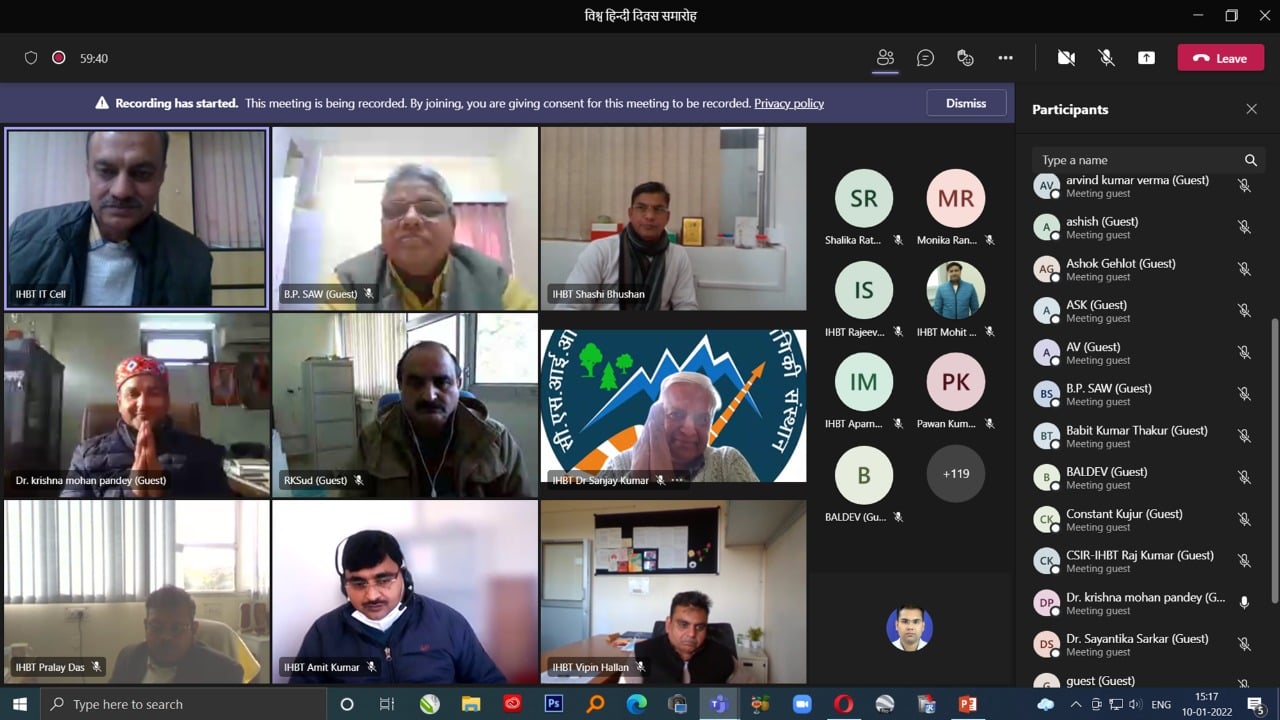
सीएसआईआर- हिमालय जैवसंपदा प्रौद्योगिकी संस्थान पालमपुर में 10 जनवरी 2022 को विश्व हिंदी दिवस का आयोजन किया गया।
इस अवसर पर डा. कृष्ण मोहन पाण्डेय, आचार्य एवं वेद विशेषज्ञ ने ‘हिंदी भाषा-व्यापकता एवं महत्व’ विषयक अपने संबोधन में राजभाषा हिंदी के राष्ट्रीय, ऐतिहासिक परिदृश्य पर महत्वपूर्ण एवं ज्ञानवर्धक व्याख्यान दिया। अपने संबोधन में डा. पाण्डेय ने भाषा के उद्भव, क्रमिक विकास, चुनौतियां और संभावनाओं पर प्रकाश डाला। उन्होंने विज्ञान को जनभाषा में प्रचारित एवं प्रसारित करने की दिशा में आत्मचिंतन के लिए प्रेरित किया।
संस्थान के निदेशक डा. संजय कुमार ने अपने अध्यक्षीय संबोधन में कहा कि अपने भावों को जितनी सहजता एवं सरलता से अपनी भाषा में अभिव्यक्त कर सकते हैं वो अन्य भाषा से नहीं कर सकते हैं। उन्होंने विज्ञान को जन-जन तक पंहुचाने की दिशा में किए जा रहे प्रयासों की जानकारी दी। उन्होंने अवगत कराया कि संस्थान द्वारा विकसित प्रौद्योगिकियों को उसके उपयोगकर्ता तक पंहुचाने के लिए सरल एवं जन भाषा का उपयोग करते हुए हम आगे बढ़ रहे हैं।
उल्लेखनीय है कि विश्व हिन्दी दिवस का उद्देश्य विश्व में हिंदी के प्रचार-प्रसार के लिये जागरूकता पैदा करना, हिंदी को अंतराष्ट्रीय भाषा के रूप में पेश करना, हिन्दी के लिए वातावरण निर्मित करना, हिन्दी के प्रति अनुराग पैदा करना है।
Immunity Modulation ‘IMMUST PRO’ Herbal Product Launched
closeप्रतिरक्षा बढ़ाने वाले 'IMMUST PRO' हर्बल उत्पाद का लॉन्च
Immunity Modulation ‘IMMUST PRO’ Herbal Product Launched
‘IMMUST PRO (इम्युनिटी मॉड्यूलेटर)’ उत्पाद, मेसर्स विगदा केयर प्राइवेट लिमिटेड, नई दिल्ली द्वारा 16 जुलाई, 2021 को लॉन्च किया गया। CSIR-IHBT ने कंपनी को प्रतिरक्षा बढ़ाने वाले उत्पाद के लिए तकनीक हस्तांतरित की है। सीएसआईआर-आईएचबीटी के निदेशक डॉ. संजय कुमार ने कंपनी के संस्थापक श्री अमित मंधार और सह-संस्थापक श्री रोहित शर्मा और सुश्री दीपिका चौधरी की उपस्थिति में उत्पाद लॉन्च किया। इस अवसर पर डॉ. के के शर्मा (सलाहकार), डॉ अरुण चंदन (क्षेत्रीय निदेशक, भारतीय चिकित्सा अनुसंधान संस्थान, राष्ट्रीय औषधीय पौधे बोर्ड), डॉ शशि भूषण (प्रधान वैज्ञानिक, सीएसआईआर-आईएचबीटी), डॉ सुखजिंदर सिंह (वरिष्ठ वैज्ञानिक सीएसआईआर-आईएचबीटी), डॉ. कुलदीप सिंह (वैज्ञानिक सीएसआईआर-आईएचबीटी) और प्रेस और मीडिया के लोग भी उपस्थित थे। डॉ. संजय कुमार ने प्रौद्योगिकी के बारे में बताया और कहा कि यह फॉर्मूलेशन आसानी से उपलब्ध जैव संसाधनों पर आधारित है और भारतीय खाद्य सुरक्षा और मानक प्राधिकरण (एफएसएसएआई) द्वारा सूचीबद्ध है। इसमें चाय, जड़ी-बूटियों और मसालों का एक अनूठा संयोजन है, जिसे प्रतिरक्षा मॉडुलन के लिए प्रीक्लिनिकल परीक्षणों के माध्यम से परखा गया है। आयोजन के दौरान, श्री अमित कुमार और टीम के अन्य सदस्यों ने उत्पाद के निर्माण और विपणन और जनता के लिए इसकी उपलब्धता के लिए किए जा रहे प्रयासों पर प्रकाश डाला। यह जानते हुए कि रोकथाम इलाज से बेहतर है, प्राकृतिक अवयवों पर आधारित प्रतिरक्षा बढ़ाने वाले खाद्य पदार्थों और पूरक आहार की आवश्यकता पर जन-सहमति बढ़ रही है। वर्तमान में, यह फॉर्मूलेशन टैबलेट प्रारूप में निर्मित है, हालांकि, निकट भविष्य में व्यापक उपभोक्ता स्वीकार्यता के लिए इसे किसी भी खाद्य मैट्रिक्स में जोड़ा जा सकता है।
IMMUST PRO (Immunity Modulator) product launched by M/s Vigada Care Private Ltd., New Delhi on July 16, 2021. CSIR-IHBT has transferred the technology for the immunity-enhancing product to the company. Dr. Sanjay Kumar, Director, CSIR-IHBT, launched the product in the presence of the company’s founder, Mr. Amit Mandahar and co-founder Mr. Rohit Sharma and Ms. Deepika Chaudhary. On this occasion, Dr. K. K. Sharma (Advisor), Dr. Arun Chandan (Regional Director, Research Institute in Indian Systems of Medicine, National Medicinal Plants Board), Dr. Shashi Bhushan (Principal Scientist, CSIR-IHBT), Dr. Sukhjinder Singh (Sr. Scientist CSIR-IHBT), Dr. Kuldeep Singh (Scientist CSIR-IHBT) and persons from press & media were also present.
Dr. Sanjay Kumar delineated about the technology and informed that this formulation is based on easily available bioresources and listed by Food Safety and Standards Authority of India (FSSAI). It has a unique combination of tea, herbs and spices, which has been tested through preclinical trials for immunity modulation.
First-plantation of Heeng plant in India
closeLahaul valley ventures to be Spice Destination of the country
हिमालय जैवसंपदा प्रौद्योगिकी संस्थान, पालमपुर ने प्रदेश में पहली बार हींग की खेती की शुरुआत करने का बीड़ा उठाया है। इसकी शुरुआत संस्थान के निदेशक डा. संजय कुमार ने प्रदेश के शीत मरुस्थल जिला लाहौल स्पीति से की है। उन्होंने बताया कि पूरे विश्व में हींग की खपत भारत में सबसे अधिक है, किन्तु भारत में इसका उत्पादन नहीं होता तथा देश हींग के लिए पूरी तरह से दूसरे देशों पर आश्रित रहता है । वर्तमान में 600 करोड़ रुपये के लगभग 1200 मेट्रिक टन कच्ची हींग अफ़ग़ानिस्तान, ईरान, उज्बेकिस्तान से आयात की जाती है। राष्ट्रीय पादप आनुवंशिकी संसाधन ब्यूरो ने इस बात की पुष्टि की है कि पिछले तीस वर्षों में हींग के बीज का आयात हमारे देश में नहीं हुआ है और यह प्रथम प्रयास है जब हिमालय जैवसंपदा प्रौद्योगिकी संस्थान, पालमपुर ने हींग के बीज का आयात किया है । अब संस्थान ने कृषि विभाग, हिमाचल प्रदेश के साथ मिलकर हींग की खेती को बढ़ावा देने के लिए हाथ मिलाया है । किसानों की आय को बढ़ाने के लिए हींग की खेती एक मील का पत्थर साबित हो सकती है तथा आयात पर होने वाले खर्च में भी कमी आएगी।
संस्थान के वैज्ञानिक डा. अशोक कुमार तथा डा. रमेश ने लाहौल स्पीति के मडग्रां, बीलिंग, केलांग तथा कवारिंग क्षेत्रों में किसानों को कृषि विभाग के अधिकारियों की उपस्थिति में हींग की खेती पर प्रशिक्षण दिया तथा हींग के बीज उत्पादन हेतु परदर्शनी क्षेत्र स्थापित किया। डा. अशोक कुमार ने बताया कि हींग एक बहुवर्षीय पौधा है तथा पाँच वर्ष के उपरांत इसकी जड़ों से ओलिओ गम रेजिन निकलता है, जिसे शुद्ध हींग कहते है । इसकी खेती के लिए यहाँ कि जलवायु उपुक्त है तथा इसकी खेती आसानी से की जा सकती है । इसकी खेती के लिए ठंड के साथ पर्याप्त धूप का होना अति आवश्यक है। डा. रमेश ने हींग की विभिन्न कृषि तकनीकों के बारे में विस्तृत जानकारी किसानों को दी ।
Farmers of the remote Lahaul valley in Himachal Pradesh are taking up cultivation of Heeng to utilize vast expanses of waste land in the cold desert conditions of the region. In their efforts, the farmers are being supported by scientists of the CSIR-Institute of Himalayan Bioresource Technology (IHBT), Palampur, who have developed agrotechnology of ‘Heeng’, which is a high value spice crop. Heeng is one of the top condiment and medicinal plant traded in India. Raw asafoetida (heeng) is extracted from the fleshy roots of Ferula assa-foetida as an oleo-gum resin. India imports about 1200 tonnes of raw asafoetida annually from Afghanistan, Iran and Uzbekistan and spends approximately 77 million USD (approx. Rs. 600 crores) per year on import of asafoetida. There is no availability of Ferula assa-foetida plants in India and availability of characterized quality planting material and identification of suitable location for its cultivation is one of the major bottlenecks in cultivation of this crop.
With the goal to promote its wide spread cultivation in India, Dr. Sanjay Kumar, Director, CSIR-IHBT, Palampur and Dr. Ashok Kumar, Senior Scientist made relentless efforts for introducing heeng in the country through proper channel and finally, introduced heeng seeds (six accessions) for the first time in the country from Iran through ICAR-NBPGR, New Delhi in October 10, 2018 vide import permit Nos. 318/2018 (July 25, 2018) & 409/2018 (September 12, 2018). The Institute raised the plants of heeng at CeHAB, Ribling, Lahaul & Spiti, H.P. under the vigil of NBPGR. Dr. Ashok Kumar, Senior Scientist and his team standardized its germination by overcoming seed dormancy and raised the seedlings in the nursery for its cultivation. The plant prefers cold and dry conditions for its growth, therefore cold desert conditions of Indian Himalayan region are suitable for cultivation of Heeng. Recognizing the efforts of the Institute, Chief Minister of Himachal Pradesh announced the introduction and cultivation of Heeng in Himachal Pradesh in his budget speech, on March 6, 2020. Consequently, MoU between CSIR-IHBT and State Department of Agriculture, Himachal Pradesh was signed on June 6, 2020 for a joint collaboration for the cultivation of heeng in the State.
Dr. Sanjay Kumar, Director, CSIR-IHBT initiated the heeng cultivation program by planting heeng seedling at village Kwaring of Lahaul valley. CSIR-IHBT scientists Dr. Ashok Kumar and Dr. Ramesh conducted the training program on Heeng cultivation and laid out heeng demonstration plot for seed production in the village in collaboration with officers of State Agriculture Department. Similar trainings were conducted and also demonstration plots for seed production were laid out at village Madgran, Beeling and Keylong of Lahaul valley of Himachal Pradesh.
Expression of Interest (EOI)
closeCSIR-IHBT invites Expression of Interest (EOI) for following technologies :
- Elicited planting material of Picrorhiza kurroa with enhanced metabolite content
- Microbial formulation for enhanced yield of commercially important crops
- Technology for High-intensity natural sweetener from Monk Fruit
- Technology for High-Purity Natural Menthol Crystal Production
- Bacterial Strain for Bioremediation of Heavy Metals
- Plant Growth Promoting Rhizobacteria
- Production of Antibacterial cream comprising of peppermint oil nanoemulsion and cellulose nanocrystals of Mentha piperita
- Process technology for production of millet based value-added food products
- Technology for Aromatic/Non-Aromatic Floral Wax
- Production of mitochondrial superoxide dismutase (mSOD) enzyme
- Kangra green tea for immunity modulation
- Fungal based lead for the management of insect and mite pests
- Rearing protocol for Zophobas morio (Superworms) as animal feed
- Technology for Multi Millet Beverage (Kodra Ki Chai)
- Commercial micropropagation protocol of Phyllostachys pubescens Mazel ex Houzeau de Lehaie (Chinese moso bamboo)
- Technology for making of flower based resin encapsulated products
- Technology for Herbal lip balm
- Development of a Portable Chlorophyll Estimation Device
- Technology for Aromatic Floral wax candles
- Commercial micropropagation protocol of Ajuga parviflora (Neelkanthi)
- Commercial micropropagation protocol of Chlorophytum comosum (Thunb.) Jacques var. comosum (Spider plant)
- Bioactive leads for therapeutic use
- A synergistic formulation against acne and a process for the preparation thereof
- A process for the stereospecific conversion of camphor into borneol
- Process technology for preparation of RTS beverage from Rhododendron arboreum flowers
- Process technology for commercial production of Millet Panjeeri
- Diagnostic Marker for True Cinnamon Identification
- Technology for Artifact making using dry flowers
- Process for Ready to Eat Instant Seera in the Convenience Package
- Botanical formulation for the control of aphids
- Production of unique autoclavable superoxide dismutase (SOD) enzyme
- Technology for Preparation of Tea Mouthwash
- Extraction and Purification Process of Aescin from Indian Horse Chestnut and Herbal Formulations to Treat Varicose Veins
- Repurposing of Ayurveda based herbal formulation for COVID19
- Herbal Formulation for Immunity Modulation
- Technology for Formulation of Herbal Incense Cones from Herbs and Flowers
- Technology for Preparation of Hand Sanitizer
- Economical Herbal Soap (Bar and Liquid)
- Technology for Preparation of Tea Vinegar
- Technologies for Production of Plant Growth Promoting Microbes
- Edible Natural Colours
- Herbal Lipstick
- Technology for Low cost indigenized bioreactor system
- Technology for Valeriana jatamansi adventitious root culture
- Technology for commercial production of Spirulina based energy bar
- Technology for commercial production of multigrain high protein beverage and instant soup mixes
- Technology for Improved Varieties of Calla lily and Gerbera Cultivars
- Technology for Mini Distillation Unit HerbostillTM
- Technology for IRISTM – An Easy Solution to RNA Isolation
- Technology for Developing L-Asparaginase with Low Glutaminase Activity for Therapeutic Applications
- Technology for 4-substituted cyclohexane-1,3-dione Synthesis
- Technology for Preparation of Ready to Serve Instant Teas
- Technology for Preparation of Tea Wine
- Evaluation of Socio-economic Impact of technologies developed by CSIR-IHBT
- Technology for Preparation of Herbal Teas
- Technology for commercial production of Value Added Buckwheat Products
- Technology for commercial production of ready-to-eat Crispy Fruits
- Technology for commercial production of ready-to-eat ethnic food especially Kangra Dham (Rajma ka Madra,Taliye Dal,Khatta Chana,Raita(Mithri) etc.
हिन्दी रूपांतर
- संवर्धित उपापचय मात्रा युक्त पिक्रोराइज़ा कुर्रूआ (Picrorhiza kurroa) की प्रेरित पौध सामग्री
- व्यावसायिक रूप से महत्वपूर्ण फसलों की बेहतर उपज के लिए सूक्ष्मजीवी सूत्रीकरण (माइक्रोबियल फॉर्मूलेशन)
- मॉन्क फ्रूट से उच्च तीव्रता वाले प्राकृतिक स्वीटनर की तकनीक
- उच्च शुद्धता वाले प्राकृतिक मेन्थॉल क्रिस्टल उत्पादन की तकनीक
- मेंथा पिपेरिटा (Mentha piperita) के पेपरमिंट ऑयल नैनोइमल्शन और सेल्यूलोज नैनोक्रिस्टल युक्त जीवाणुरोधी क्रीम का उत्पादन
- मिलेट (श्री अन्न) आधारित मूल्यवर्धित खाद्य उत्पादों के उत्पादन के लिए प्रक्रिया प्रौद्योगिकी।
- माइटोकॉन्ड्रियल सुपरऑक्साइड डिसम्यूटेस )mSOD) एंजाइम का उत्पादन
- प्रतिरक्षा मॉड्यूलेशन के लिए कांगड़ा ग्रीन टी
- मल्टी मिलेट पेय (कोदरा की चाय) प्रौद्योगिकी
- फायलोस्टैचिस प्यूबेसेंस माजेल एक्स हौजिओ डी लेहाई (चीनी मोसो बांस)
- पुष्प आधारित रेजिन एनकैप्सुलेटेड उत्पाद बनाने की तकनीक
- सुगंधित पुष्प मोमबत्तियों के लिए प्रौद्योगिकी
- अजुगा परविफ्लोरा (नीलकंठी) की वाणिज्यिक सूक्ष्मप्रवर्धन विधि/ प्रोटोकॉल
- क्लोरोफाइटम कोमोसम (थुनब.) जैक्स वर. कोमोसम (स्पाइडर प्लांट) की वाणिज्यिक सूक्ष्मप्रवर्धन विधि/ प्रोटोकॉल
- चिकित्सीय उपयोग के लिए जैवसक्रिय लीड्स
- मुँहासो के विरुद्ध एक सहक्रियात्मक लेपउत्पाद और उसकी तैयारी की प्रक्रिया
- कपूर से बोर्नियोल में स्टीरियोस्पेसिफिक रूपांतरण की एक प्रक्रिया
- बुरांश (रोडोडेंड्रोन आर्बोरियम) फूलों से आरटीएस पेय तैयार करने की प्रक्रिया प्रौद्योगिकी
- मोटे अन्न की पंजीरी के व्यावसायिक उत्पादन के लिए प्रक्रम प्रौद्योगिकी
- सच्ची दालचीनी की पहचान के लिए डायग्नोस्टिक मार्कर
- सूखे पुष्पों का उपयोग करके कलाकृति बनाने की तकनीक
- सुविधाजनक पैकेज में रेडी टू ईट सीरा प्रक्रिया
- एफिड्स नियंत्रण हेतु वानस्पतिक सूत्रीकरण
- विशिष्ट ऑटोक्लेवबल सुपरऑक्साइड डिसम्यूटेज (सॉड) एंजाइम का उत्पादन
- चाय आाधारित माउथवॉश तैयार करने की प्रौद्योगिकी
- वनखोड़ (भारतीय हॉर्स चेस्टनट) से एसिन का निष्कर्षण एवं शुद्धिकरण प्रक्रिया और वैरिकाज़ नसों के इलाज के लिए हर्बल फॉर्मूलेशन
- COVID19 के लिए आयुर्वेद आधारित हर्बल फार्मुलेशन
- जड़ी बूटियों और फूलों से हर्बल धूप कोन प्रौद्योगिकी
- हैंड सैनिटाइजर निर्माण प्रौद्योगिकी
- किफायती/सस्ता हर्बल साबुन (टिकिया और तरल)
- चाय सिरका (विनेगर) तैयार करने की तकनीक
- पादप वृद्धि में सहायक जीवाणु उत्पादन प्रौद्यागिकी
- खाद्य प्राकृतिक रंग
- हर्बल लिपिस्टिक
- कम लागत युक्त स्वदेशी बायोरिएक्टर सिस्टम
- वेलेरियाना जटामांसी अपस्थानिक जड़ संवर्धन प्रौद्योगिकी
- स्पिरूलिना आधारित एनर्जी बार के व्यवसायिक उत्पादन के लिए प्रौद्योगिकी
- बहु अन्नीय (मल्टीग्रेन) उच्च प्रोटीन पेय और तत्काल (इन्स्टेंट) सूप के व्यवसायिक उत्पादन की प्रौद्योगिकी
- कैला लिलि तथा जरबेरा की उन्नत किस्मों
- मिनी डिस्टिलेशन यूनिट हर्बोस्टिल ट्रेडमार्क
- रेडी टू सर्व चाय निर्माण प्रौद्योगिकी
- टी- वाइन बनाने के लिए प्रौद्योगिकी
- सामाजिक आर्थिक प्रभाव का मूल्यांकन
- हर्बल चाय बनाने के लिए प्रौद्योगिकी
- मूल्यवर्धित बक्कबीट के व्यवसायिक उत्पादन के लिए प्रौद्योगिकी
- रेडी टू ईट क्रिस्पी फ्रूट की व्यवसायिक उत्पादन के लिए प्रौद्योगिकी
- रेडी टू ईट परम्परागत व्यंजन के व्यवसायिक उत्पादन के लिए प्रौद्योगिकी
CSIR Integrated Skill Initiative
close
Situated among pristine environs in the lap of Dhauladhar ranges, CSIR-IHBT has a focused research mandate for sustainable development of bioresources to enhance bioeconomy in the Himalayan region. The young and dynamic team of the scientists, the technicians and research scholars works dedicatedly to discover and find solutions to new challenging problems relevant to the society. National and international collaborations further strengthen scientific interactions at a global scale. Promoting industrial growth through technological interventions is a constant endeavor and several technologies developed by the institute are transferred to industries and generated employment opportunities.
CSIR-IHBT invites application for the following Skill Development Training Programme :
- Applications are invited for the course of बायोलॉजिस्ट/बायोटेक्नोलॉजिस्ट/Biologist/Biotechnologist (पाठ्यक्रम कोड/Course Code - LFS/Q4101,NSQF Level-05) under CSIR Integrated CSIR- Integrated Skill Initiative (Phase-III) (Download Application Form)
 (आवेदन की अंतिम तिथि : 25.12.2025)
(आवेदन की अंतिम तिथि : 25.12.2025) - Applications are invited for the course of पादप ऊत्तक संवर्धन तकनीशियन/Plant Tissue Culture Technician under CSIR Integrated CSIR- Integrated Skill Initiative (Phase-III) (Download Application Form)
 (आवेदन की अंतिम तिथि : 26.12.2025)
(आवेदन की अंतिम तिथि : 26.12.2025) - Call for Application for course of Herb Grower हर्ब ग्रोवर (पाठ्यक्रम कोड – AGR-Q0903, NSQF Level-02) under CSIR Integrated Skill Initiative (Phase-III) (Download Application Form)
 (आवेदन की अंतिम तिथि : 15.12.2025)
(आवेदन की अंतिम तिथि : 15.12.2025) - Call for Application for course of उच्च-प्रदर्शन तरल क्रोमैटोग्राफी (एचपीएलसी) विश्लेषण की मूल बातें (पाठ्यक्रम कोड – LFS/N0361, NSQF Level-5.5) / Basis of High-Performance Liquid Chromatography (HPLC) Analysis (Course Code - LFS/N0361, NSQF Level-5.5) under CSIR Integrated Skill Initiative (Phase-III) (Download Application Form)
 (आवेदन की अंतिम तिथि बढ़ाई गई: 19.12.2025)
(आवेदन की अंतिम तिथि बढ़ाई गई: 19.12.2025) - Call for Application for course of पादप ऊत्तक संवर्धन तकनीशियन (पाठ्यक्रम कोड - AGR-Q8101,NSQF Level-04) / Plant Tissue Culture Technician (Course Code - AGR-Q8101, NSQF Level-04) under CSIR Integrated Skill Initiative (Phase-III) (Download Application Form) (आवेदन की अंतिम तिथि: 25.11.2025)
- Call for Application for course of मास्टर गार्डनर (पाठ्यक्रम कोड - AGR-Q0801, NSQF Level-04) / Master Gardener (Course Code- AGR-Q0801, NSQF Level-04) under CSIR Integrated Skill Initiative (Phase-III) (Download Application Form) (आवेदन की अंतिम तिथि: 24.11.2025)
- Call for Application for course of पुष्पकृषि विशेषज्ञ (पाठ्यक्रम कोड - AGR-Q0701, NSQF Level-04) / Floriculturist (Course Code - AGR-Q0701, NSQF Level-04) under CSIR Integrated Skill Initiative (Phase-III) (Download Application Form) (आवेदन की अंतिम तिथि: 24.11.2025)
- Call for Application for course of एसेंशियल आयल एक्सट्रैक्टर (पाठ्यक्रम कोड - AGR-Q0902 ,NSQF Level-03) / Essential Oil Extractor (Course Code - AGR-Q0902, NSQF Level-03) under CSIR Integrated Skill Initiative (Phase-III) (Download Application Form) (आवेदन की अंतिम तिथि: 24.11.2025)
- Call for Application for course of वर्टिकल गार्डन का डिज़ाइन और निर्माण (पाठयक्रम कोड - AGR-N0856, NSQF Level-04) / Design and construct Vertical Garden (Course Code - AGR-N0856, NSQF Level-04) under CSIR Integrated Skill Initiative (Phase-III) (Download Application Form) (आवेदन की अंतिम तिथि: 24.11.2025)
- Call for Application for course of हनी बी फामर्र (स्माल यूनिट) / Honey Bee Farmer (Small Unit) under CSIR Integrated Skill Initiative (Phase-III) (Download Application Form) (आवेदन की अंतिम तिथि: 05.09.2025)
- Call for Application for Short-term hands-on training and internship program in Food, Chemical and Bioprocess Technologies under CSIR Integrated Skill Initiative (Phase-III) (Download Application Form) (आवेदन की अंतिम तिथि: 23.08.2025)
- Call for Application for Training Program of "Bamboo Grower" under Integrated Skill Initiative (Phase-III) (Download Application Form) (आवेदन की अंतिम तिथि: 20.08.2025)
- Call for Application for Plant Tissue Culture Technician under CSIR- Integrated Skill Initiative (Phase-III) (Download Application Form) (आवेदन की अंतिम तिथि: 31.07.2025)
Institute Brochure
closeCSIR - Institute of Himalayan Bioresource Technology , Palampur. Ultimate destination for research on bioresources
Call of Proposals
closeInvitation for proposals from MSEs/Innovators for working in the CRTDH established at CSIR-IHBT, Palampur

